

Uganda Animals: 27 Amazing Safari Animals of Uganda
Looking for Uganda animals ? In this post, you’ll learn about 27 amazing animals that you can see while trekking and on safari in Uganda. They include mammals, birds, reptiles, and fish.
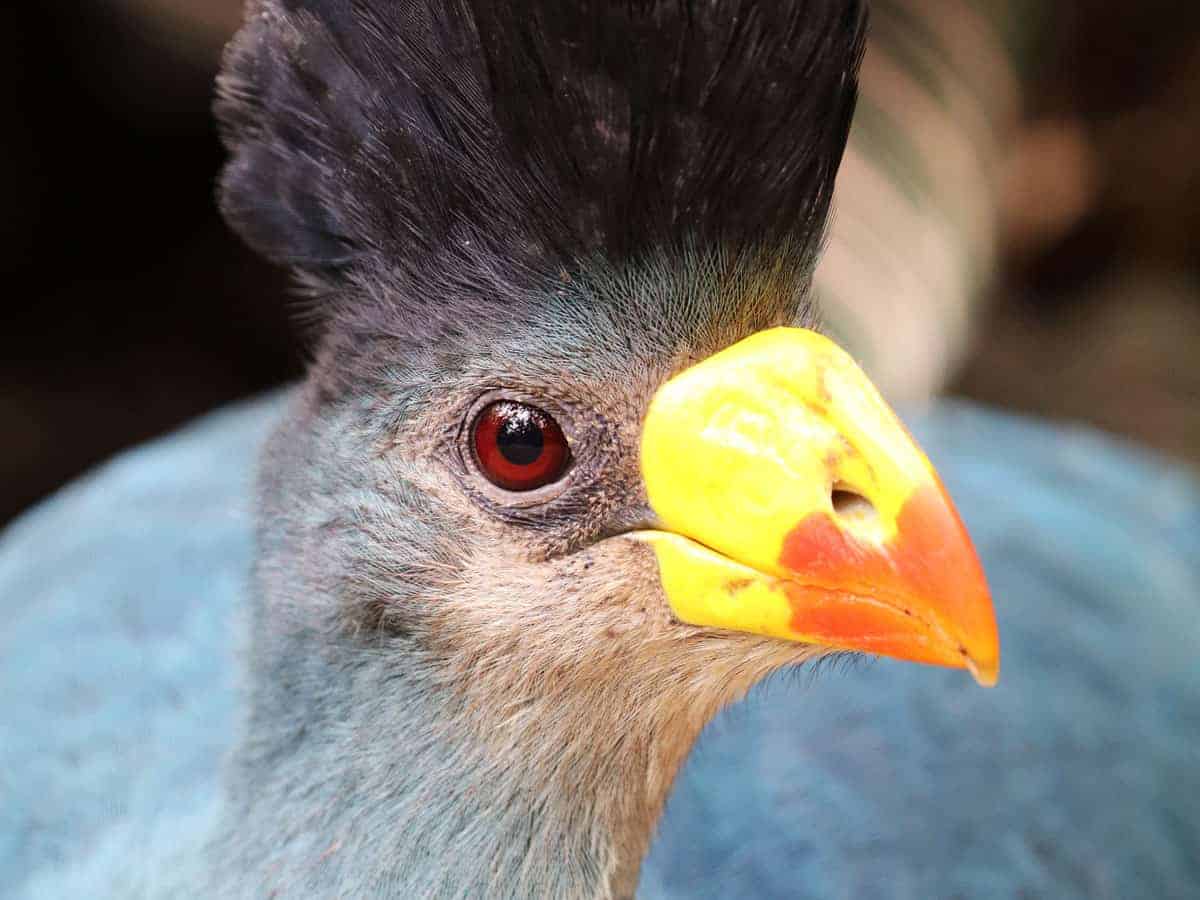
27 African Safari Animals in Uganda
Uganda is a landlocked country in eastern Africa. Along with Tanzania and Kenya, it is home to Lake Victoria , which is both the largest lake in Africa and the largest tropical lake in the world.
Many animals are native to Uganda; it boasts 1,061 bird species , making it a popular destination for birders. The entire continent of Africa, for the record, is home to 2500 bird species.
Check out our Guide to the Birds of Uganda (including the top birding sites).
1. Crested Crane: Uganda’s National Bird
The Crested Crane , which is a subspecies of the Grey Crowned Crane ( Balearica regulorum ), is the national bird of Uganda.
As such, it appears on the country’s flag; it is also on the Ugandan coat of arms opposite a Ugandan Kob. Both represent the abundant wildlife in Uganda. The Crested Crane’s crest sports the same colors as the Ugandan flag. Not surprisingly, it is very high on the typical visitor’s Uganda animal list.
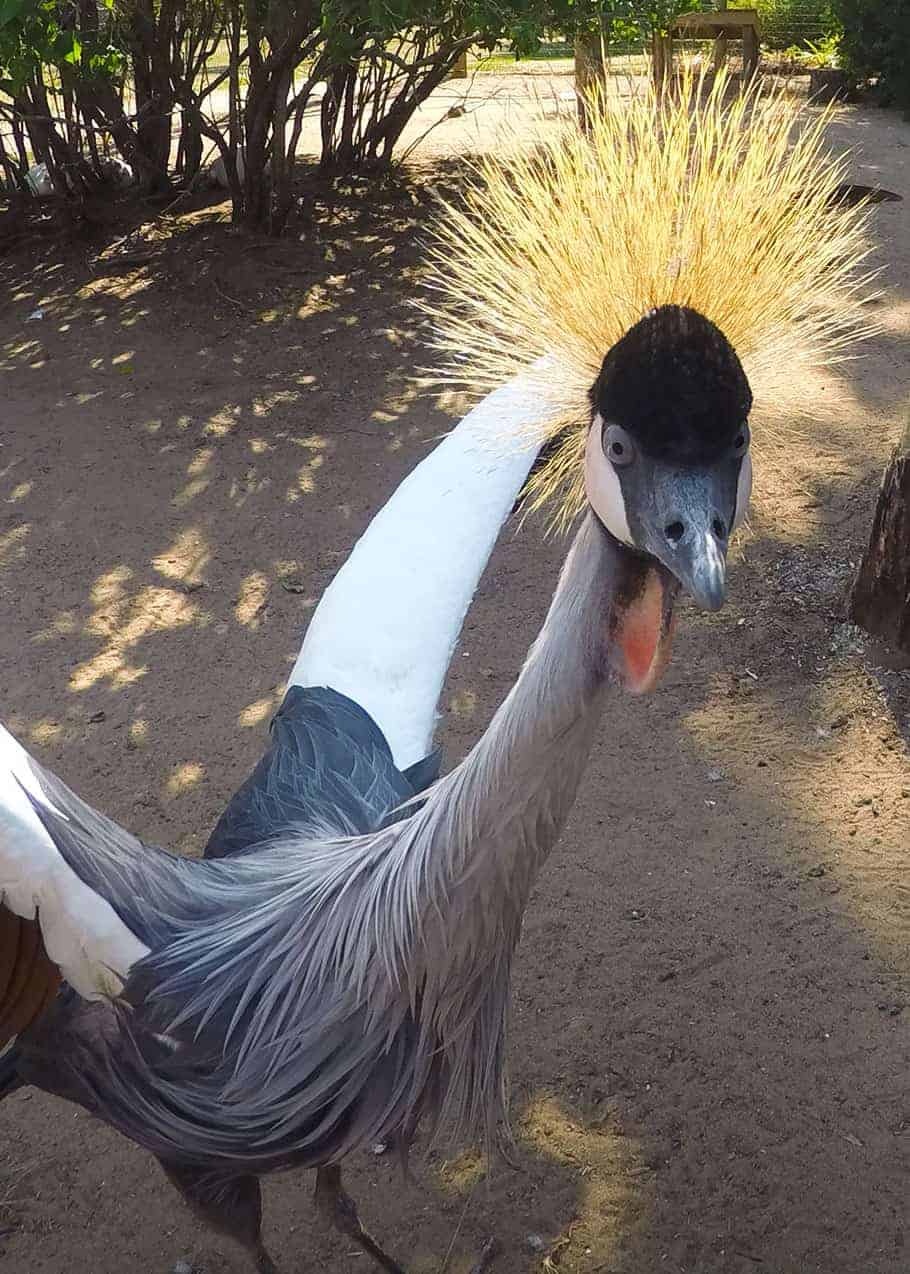
Check out our Travelers Guide to Uganda’s 10 National Parks (and 4 Wildlife Game Reserves)
2. Lake Victoria Cichlids
Lake Victoria is home to a number of fish species, some of which are endemic, which means they can’t be found anywhere else. The best known of these are arguably the cichlids from the family Cichlidae. Here are 9 facts about Lake Victoria’s cichlids .
There are over 500 species, some of which have not yet been named or described by scientists. Those species are divided into around 16 groups based on their diet: insectivores, plankton-eaters, scavengers, etc.
3. African Bush Elephant: World’s Largest Living Land Mammal
The African bush elephant or African savannah elephant ( Loxodonta africana ) is an impressive sight; a large male can stand 13 feet tall and weigh 11.5 tons, while an average-sized male stands around 10.5 feet tall and weighs 6.6 tons. Females are notably smaller.
Big game hunters counted elephants among the “Big Five,” those animals that were most dangerous to hunt on foot.
Nowadays, seeing an elephant in the wild is on every traveler’s wish list of Uganda animals to see.
For their size, elephants can move surprisingly fast. How fast can an elephant run?
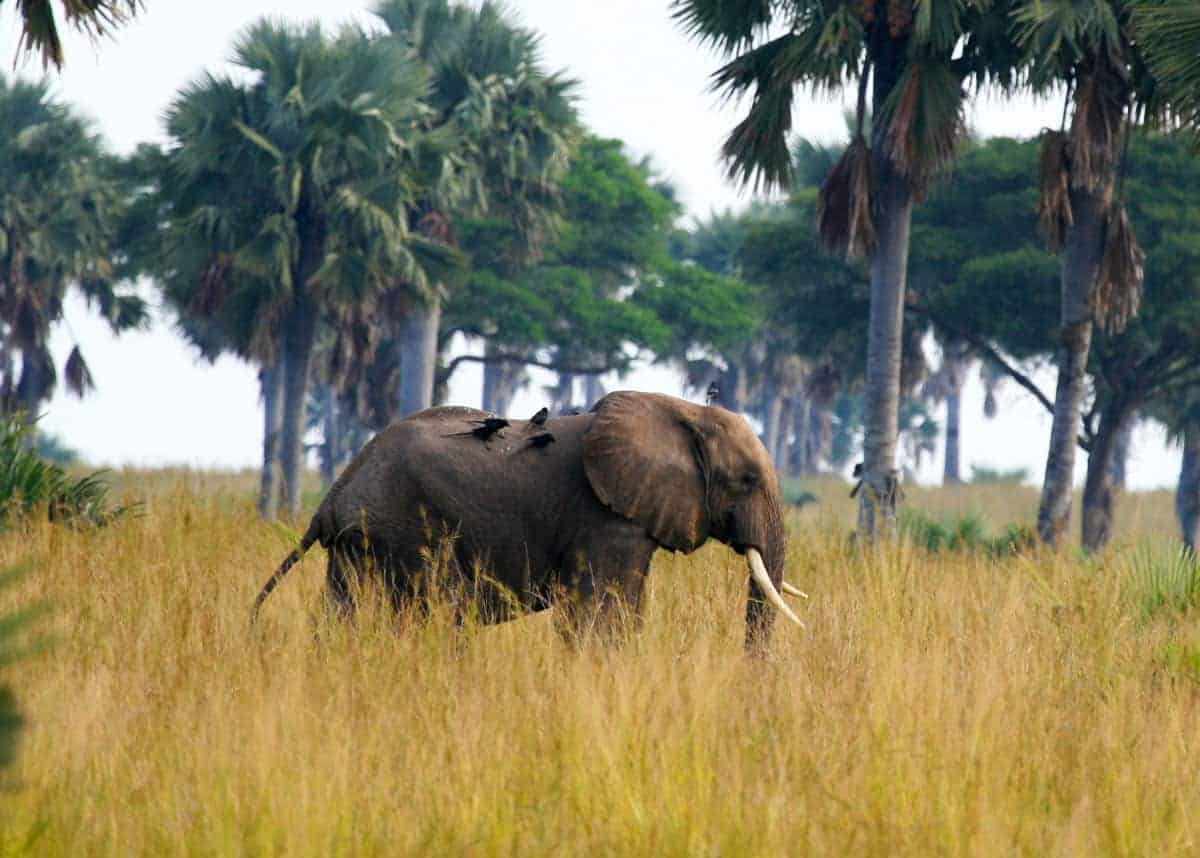
4. Uganda Kob: Uganda’s National Antelope
What animals live in Uganda? Antelopes make up a goodly portion of the Uganda wildlife; there are 29 species, including the Uganda kob ( Kobus kob thomasi ), which is a subspecies of the kob.
It is a medium-sized antelope that is depicted on Uganda’s coat of arms. Males can weigh around 200 pounds, while females are significantly smaller at 130 to 140 pounds.
Learn more about African antelopes .
5. Shoebill Stork: Most Sought-After Bird
The Shoebill ( Balaeniceps rex ), sometimes called the Shoebill Stork, is one of the most elusive birds in Uganda.
Consequently, it is one of the most sought by birders. At around five feet tall, its massive bill gives it a prehistoric look.
The Shoebill lives in swamps, where it feeds chiefly on lungfish. It will also eat frogs, other fish, snakes and even baby crocodiles. Shoebills can live for over 50 years. Learn more about the shoebill stork .
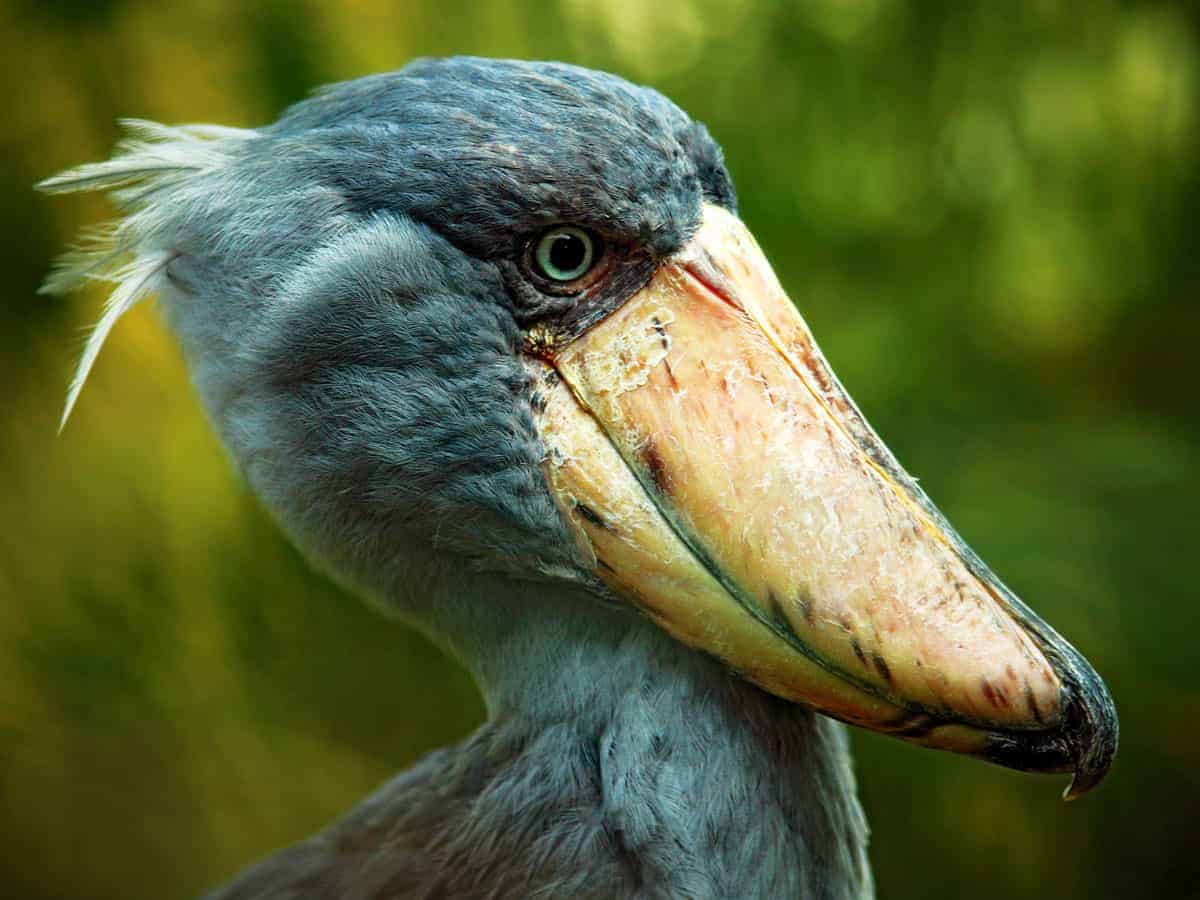
How’s your Swahili? Check out our guide to 100+ animal names in Swahili .
6. Rock Python: Africa’s Biggest Snake
The rock python ( Python sebae ) can be over 5 meters (16 feet long). It is not venomous and kills its prey by constriction. It often feeds on large rodents or small antelopes.
Their mottled skin is gold on black. Snake-lovers who want to see one ought to check out the bat cave in Queen Elizabeth National Park’s Maramagambo Forest.
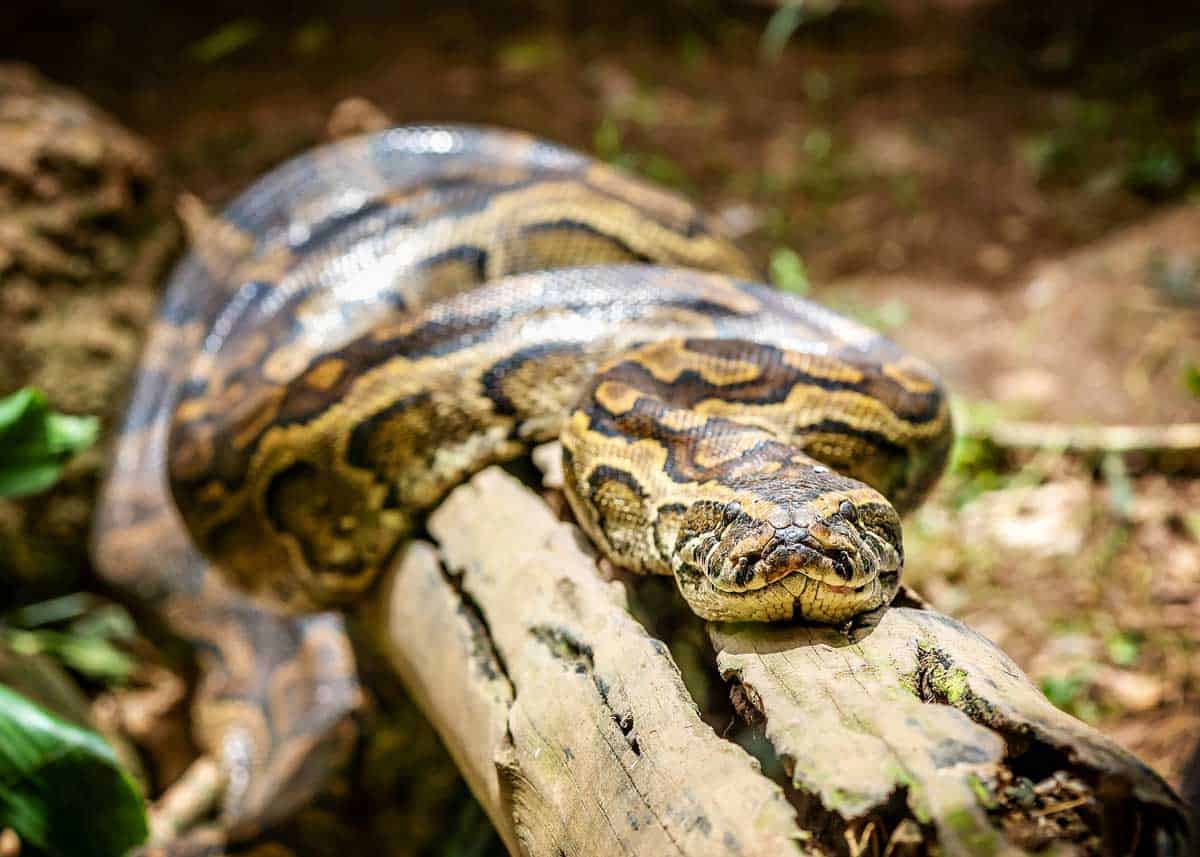
7. Mountain Gorilla: Biggest Primate
The mountain gorilla ( Gorilla beringei beringei ) is a subspecies of the eastern gorilla.
Over half of the world’s population, around 750, live in Uganda’s forests. Mountain gorillas can’t survive in captivity, so it is vital to protect their habitat.
Mountain gorillas live in family groups led by a silverback or mature male. He does indeed have silvery hair forming a large saddle-like mark on his back, and he can weigh as much as 260 pounds. Part of the silverback’s job is defending the rest of the family from threats.
Mountain gorillas are intelligent and have been observed using tools. They are also among the more popular attractions for Uganda wildlife safaris .
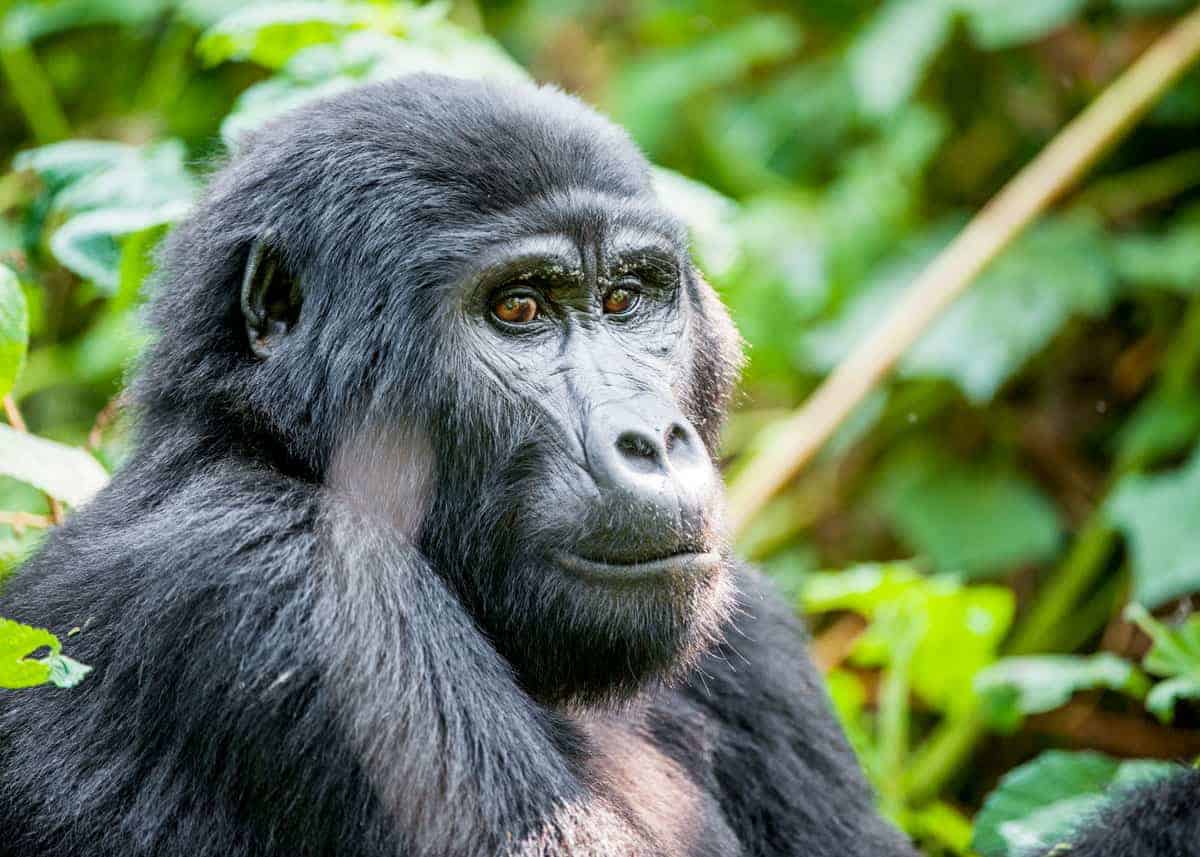
More reading: How Strong is a Gorilla?
8. African Lion: King of Beasts
The lion ( Panthera leo ) is another member of the Big Five and another animal many travelers have on their wish list of Uganda animals.
Lions are the most social of the big cats and live in family groups called prides that consist of several related females, their cubs, and one or two adult males. The cubs are generally born around the same time, and the lionesses take turns babysitting them.
The lionesses do most of the hunting, and they usually target big game like giraffes or buffalos. The male’s job is protecting the pride from enemies.
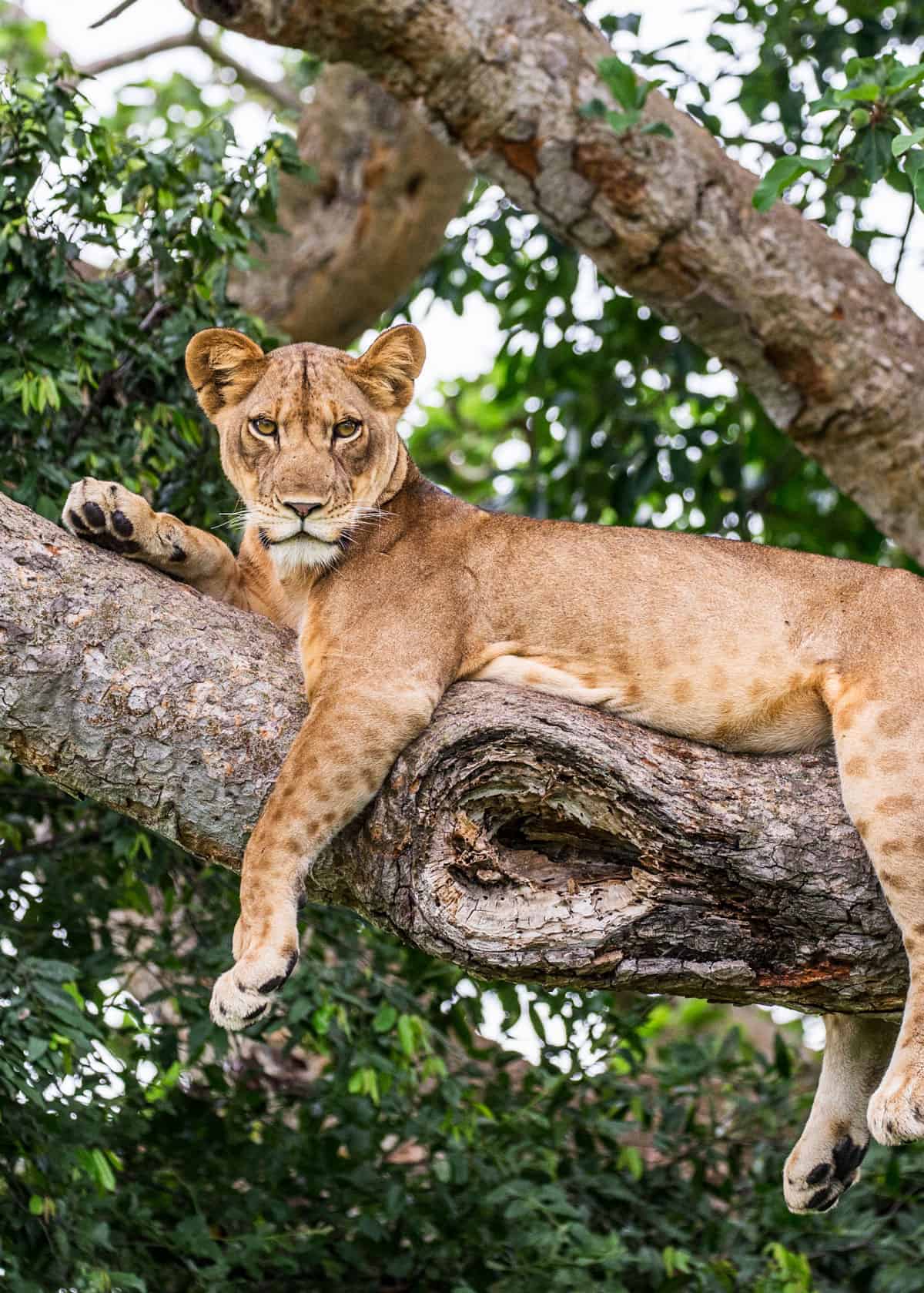
9. Shelley’s crimsonwing: Rare Bird
The Shelley’s crimsonwing ( Cryptospiza shelleyi ), a member of the finch family, is one of the rarest birds in the world.
They can only be found in the Albertine Rift that borders Uganda, the Democratic Republic of the Congo, and Rwanda. The bird is so elusive only a handful of photographs exist.
10. Chimpanzees
Chimpanzees ( Pan troglodytes ) and humans have about 98 percent of their DNA in common. A chimpanzee troop can have between 30 and 150 individuals.
They live in grasslands, woodlands and tropical rain forests. While chimpanzees are omnivores, their favorite food is fruit. Chimps reach maturity when they are between 11 and 13 years old, and they can live for up to 60 years.
11. Cape Buffalo: The Black Death
The Cape buffalo ( Syncerus caffer ), another member of the Big Five, owes the above nickname to the fact that it has killed more big game hunters than the other four animals put together.
It is a subspecies of the African buffalo, the only bovine in Africa. Both males and females have horns, and the horns on a big male can be four feet across. A large male can weigh nearly a ton and stand six feet tall at the shoulder. Despite their aggression, Cape buffalo live in herds that can contain hundreds or thousands of animals.
Learn the differences between buffalo vs bison .
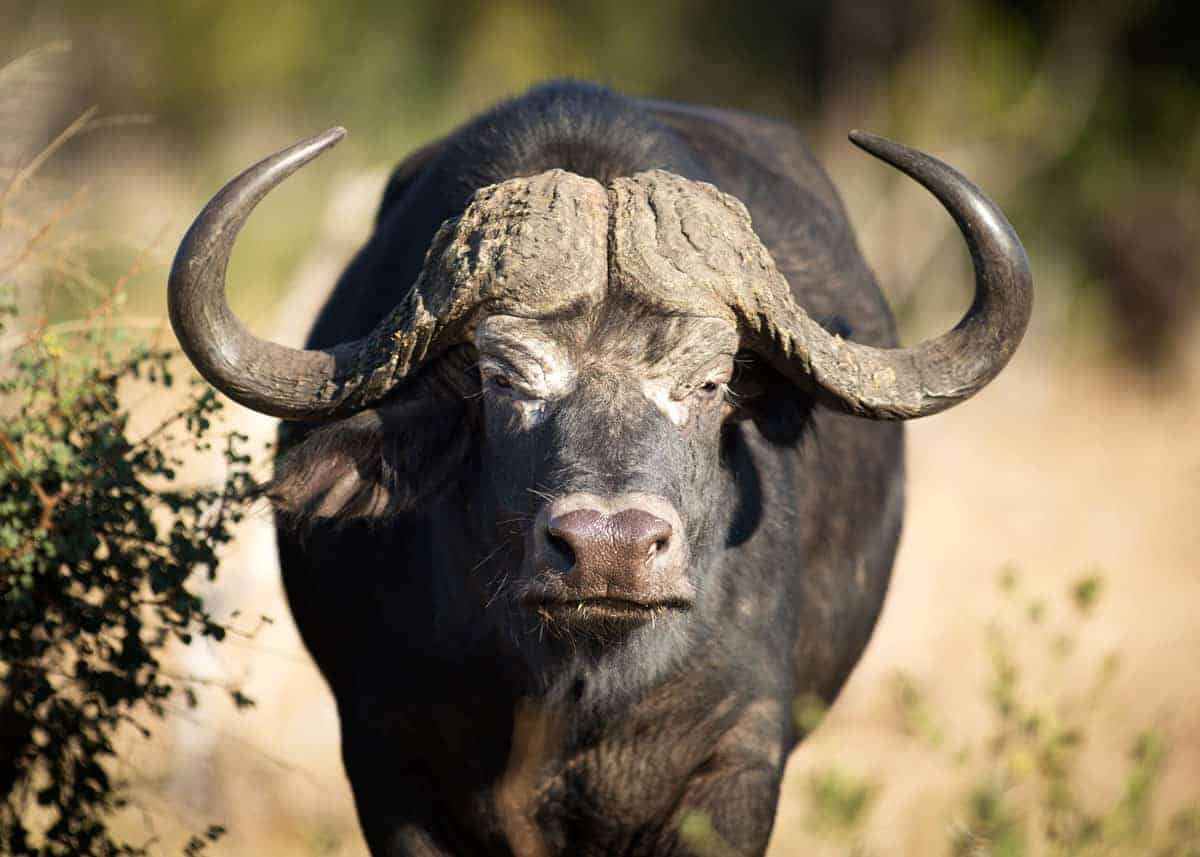
12. Great Blue Turaco
The great blue turaco ( Corythaeola cristata ) is another item on many birders’ wish lists. Fortunately, it is relatively common; the IUCN describes it as “least concern.”
It can be up to 30 inches long and weigh up to 2.7 pounds. It is largely teal and has a black crest and red and yellow beak.
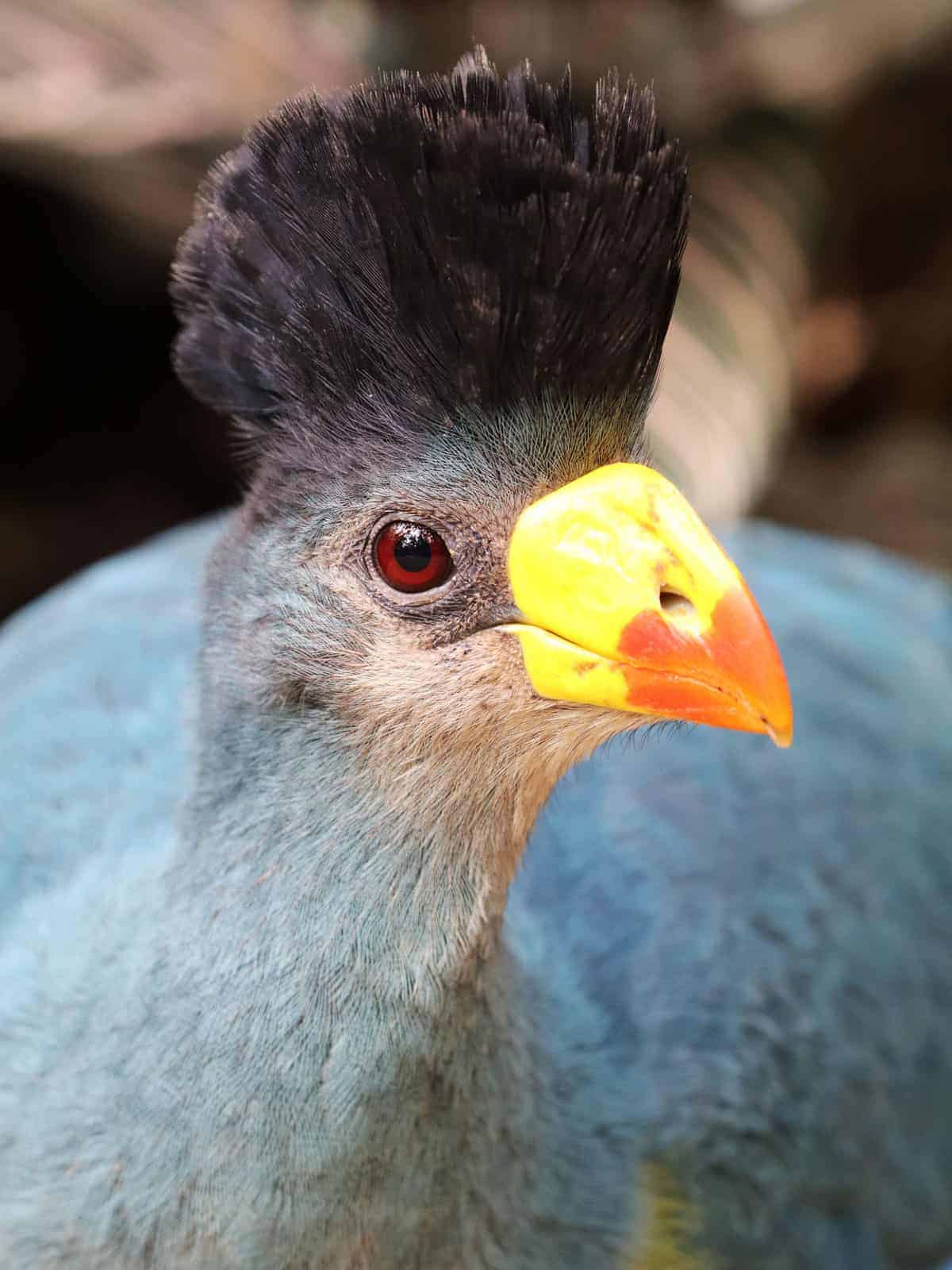
13. Golden Monkey
Uganda is home to at least a dozen primate species, including the endangered golden monkey ( Cercopithecus kandti ).
It’s a subspecies of the blue monkey that can only be found in the foothills of the volcanic Virunga mountains that extends through Uganda, Rwanda and the Democratic Republic of the Congo.
The golden monkey has golden fur on its body, tail and cheeks, but its limbs are black. It weighs between 10 and fifteen pounds.
14. African Leopard: Master of Camouflage
The African leopard ( Panthera pardus pardus ) is the most elusive member of the Big Five, for its spotted coat allows it to blend in with its surroundings.
Many people consequently have it on their most-desired Uganda animal list.
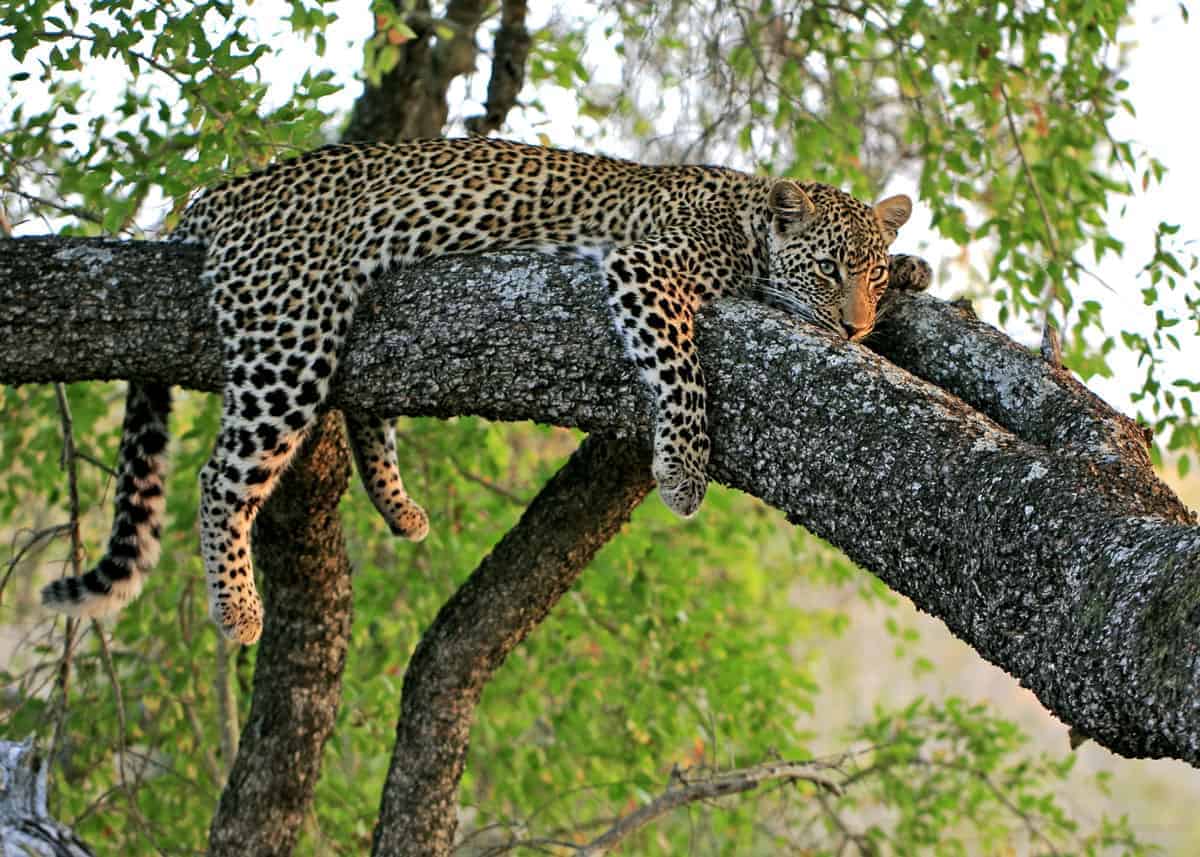
The leopard is also the most arboreal of the big cats, and it is strong enough to haul its prey up a tree, so it can leisurely eat it without being robbed by hyenas or lions. Leopards are also skilled swimmers, can jump up to ten feet in the air, and can run up to 35 miles per hour.
15. Black and White Rhinos
Both black and white rhinoceroses are native to Uganda and both were extinct in the wild by 1982.
In 2005, the Uganda Wildlife Authority worked with some other groups to establish the Ziwa Rhino Sanctuary and reintroduce the southern white rhinoceros ( Ceratotherium simum simum ). They started off with six animals, and those numbers have grown to 32. When this article was written a few years ago, the number was just 19 rhinos.
Update August 2020: According to Rhino Fund, this number has now increased to 32 individuals. Thanks to Angie Genade, Executive Director of Rhino Fund Uganda for the update.
Other Uganda wildlife have made their home in the sanctuary which is the only place in Uganda where visitors may see a rhinoceros in the wild. Rhinos are the final member of the Big Five. Learn more about the southern white rhino in Uganda.
Curious about how fast a rhinoceros can move? Here’s how fast a rhino can run .
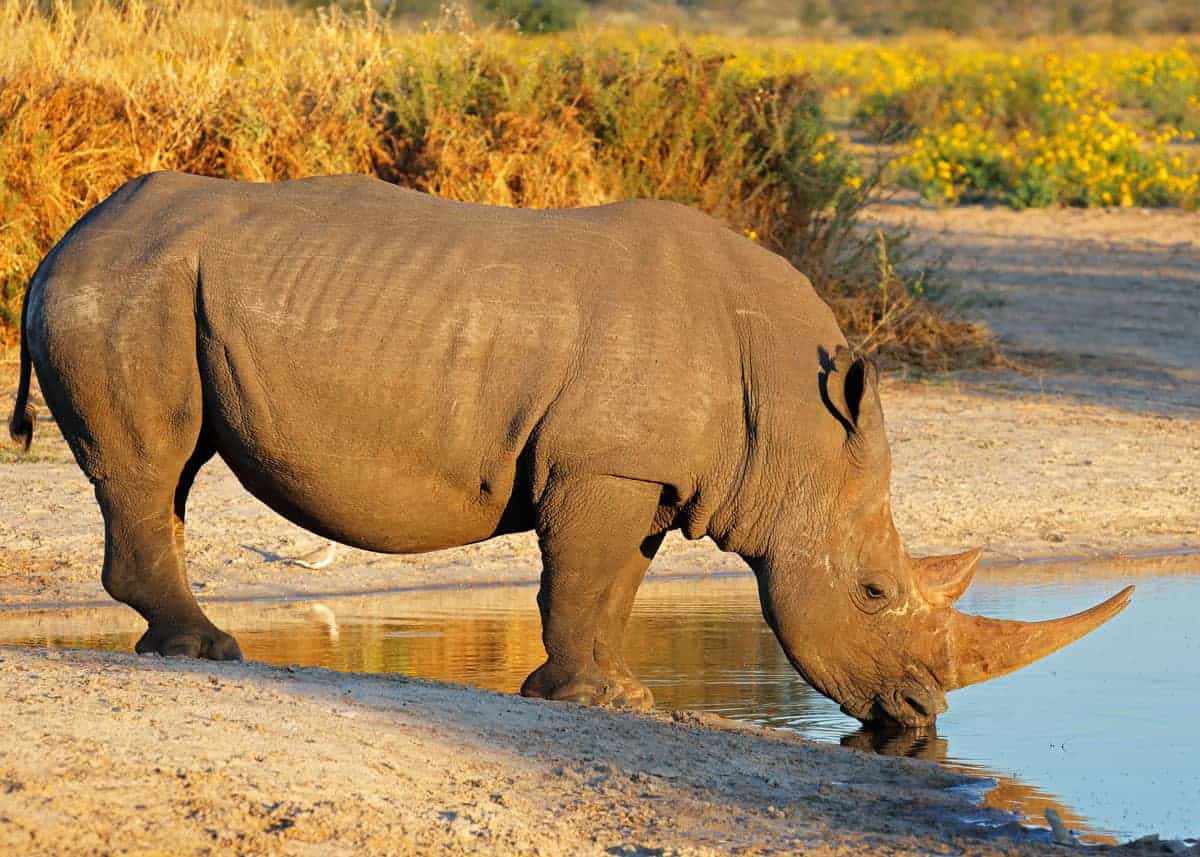
16. Nile Crocodile: Freshwater Hunter
The Nile crocodile ( Crocodylus niloticus ), is one of three crocodile species found in Africa. It is also the second largest crocodile in the world; a big male can weigh over half a ton and grow to be 20 feet long.
The Nile crocodile likes to stay near or in water, so it lives in swamps, estuaries, rivers and lakes. It feeds on both fish and large land animals.
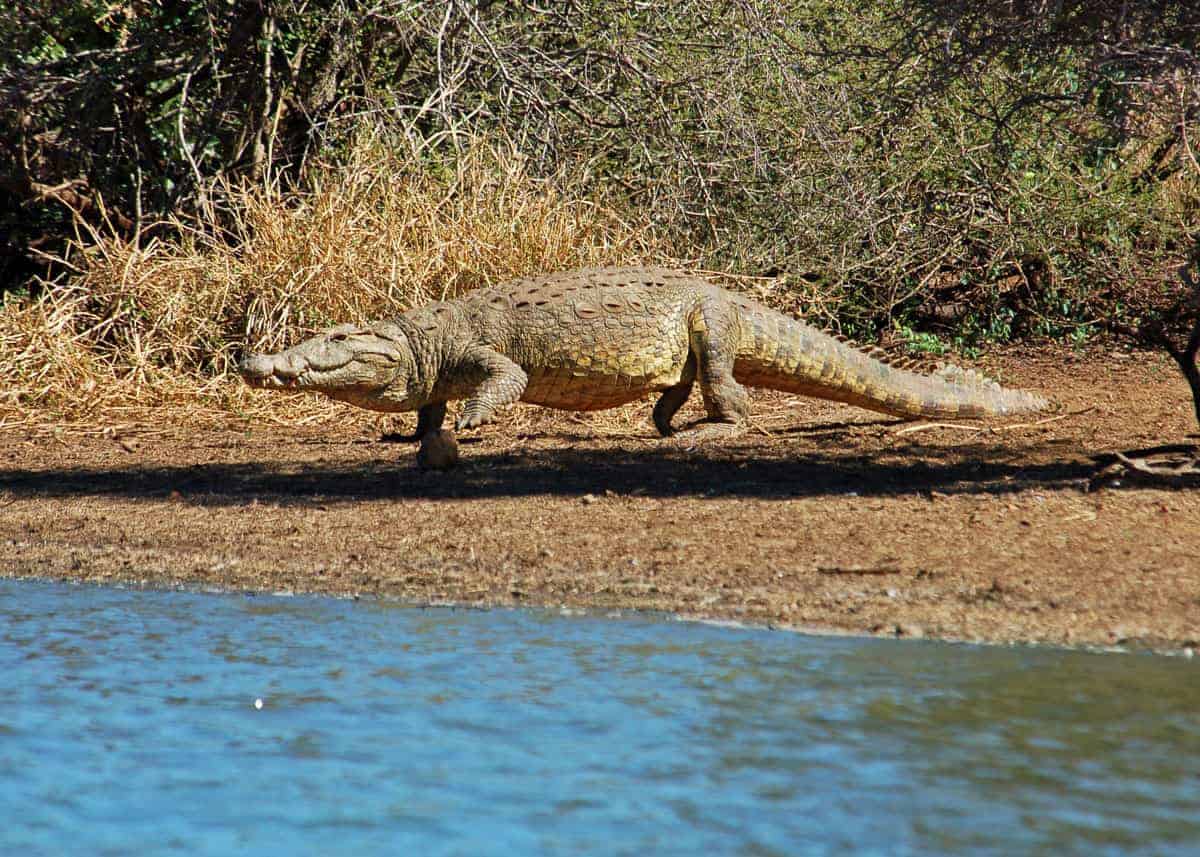
Learn more about crocodile speed compared to humans.
17. Sitatunga: Swamp Antelope
The sitatunga ( Tragelaphus spekii ) is a semi-aquatic antelope that lives in swamps. Its splayed feet help it swim.
Males are larger than females and can weigh up to 275 pounds and be as much as 63 inches long. A frightened sitatunga will retreat into deep water so that only its nostrils are visible.
Learn more about the sitatunga antelope .
18. Hippopotamus: River Horse
The word “hippopotamus” comes from the Greek for “river horse,” and it is one of the animals native to Uganda. Ironically, the hippopotamus ( Hippopotamus amphibious ) is more closely related to whales and dolphins than it is to horses.
After the elephant and the rhinoceros, it is the third largest terrestrial mammal. Hippopotami have no sweat glands, so they spend a lot of time in the water to cool off. They can remain completely submerged for six minutes before needing to come up for air.
More reading: Is Hippo Milk Really Pink?
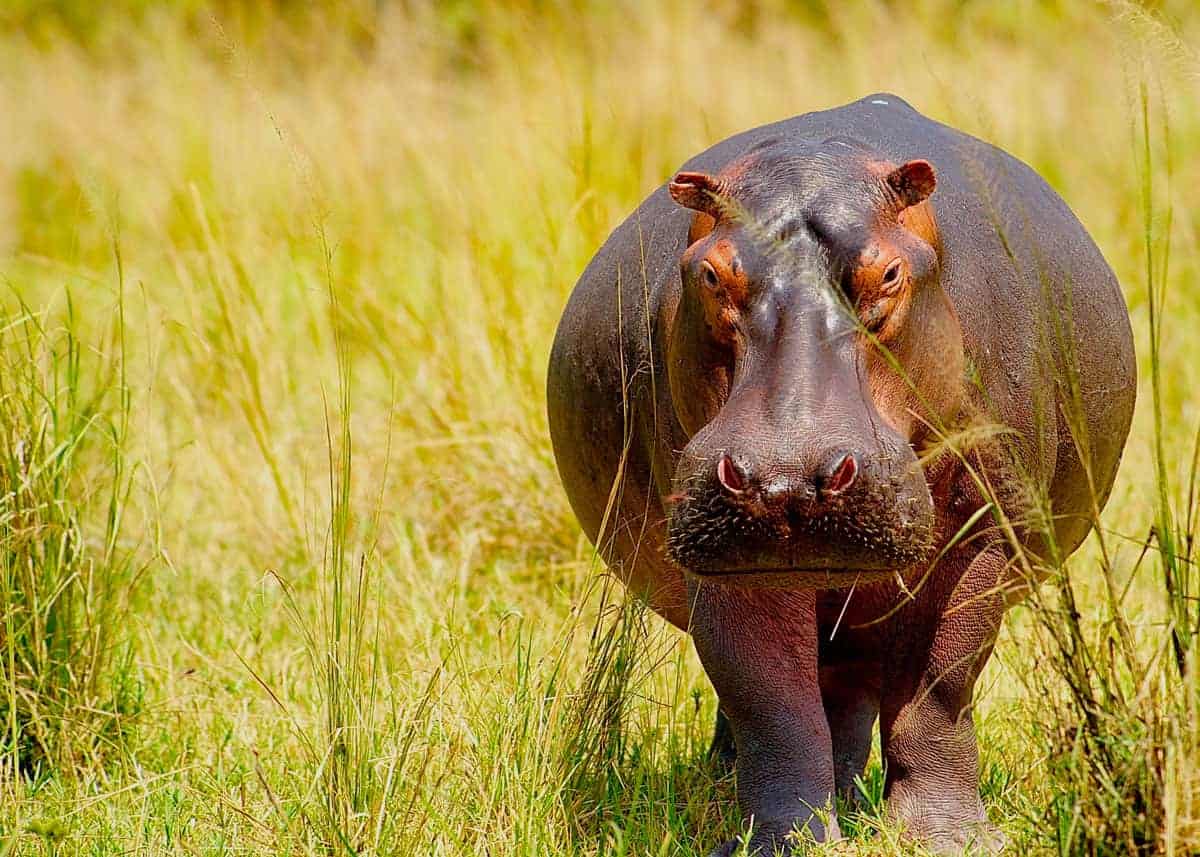
19. Marabou Stork: Undertaker Bird
The marabou stork ( Leptoptilos crumenifer ) is a wading bird that is often described as the ugliest bird in Africa. An adult can stand five feet tall and have a wing span of over ten feet.
It owes its ghastly looks to a naked pink neck with a pair of air sacs, one on the back at the base of the neck and a bigger one hanging from the front that looks like a deflated balloon. Marabou storks are scavengers that can be found anywhere from city dumps to Uganda wildlife safaris.
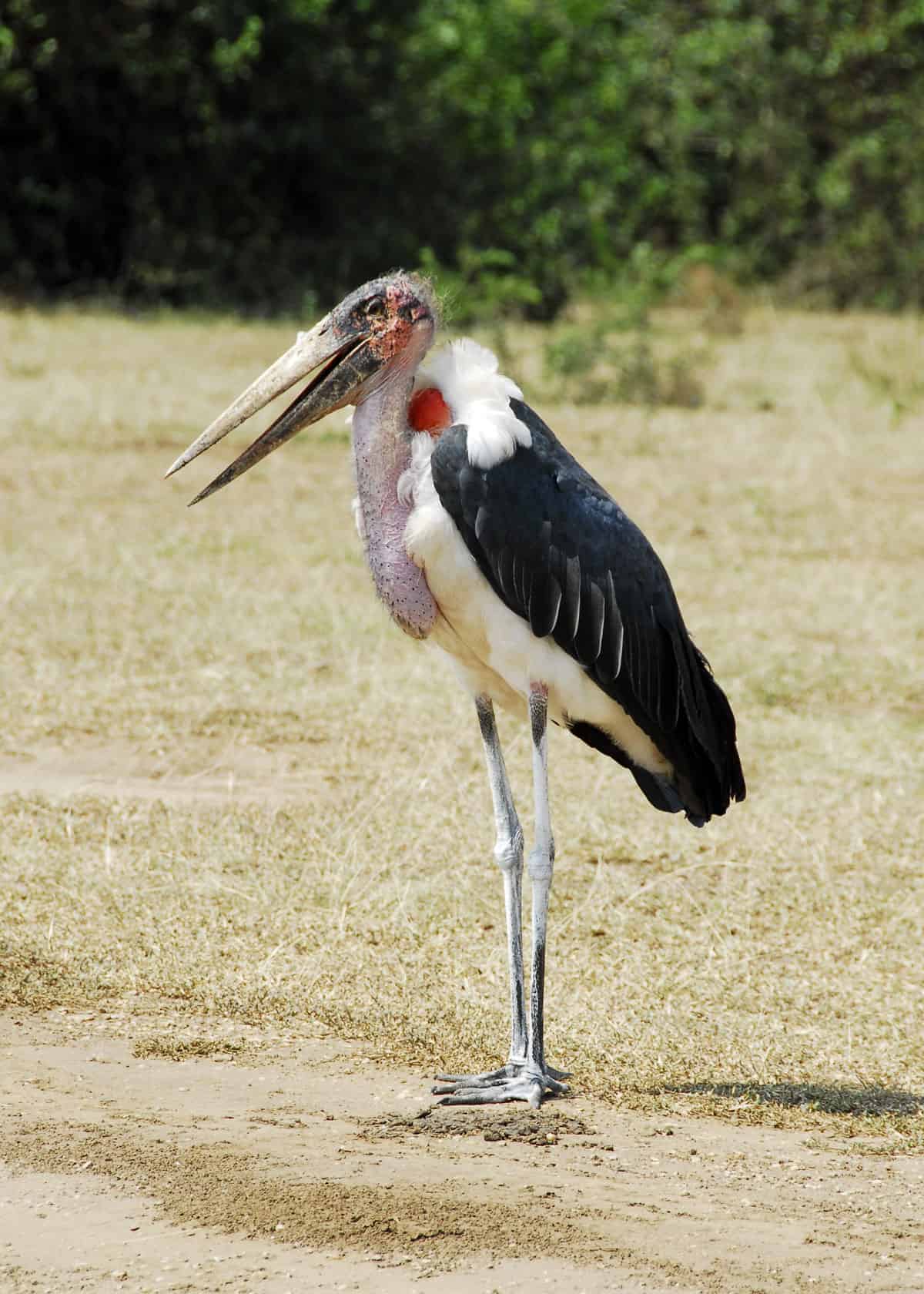
20. African Green Broadbill: Elusive and Tiny Bird
The African green broadbill ( Pseudocalyptomena graueri ) is endemic to the mountainous Albertine Rift in Uganda and the Democratic Republic of the Congo. In Uganda, it lives in the Bwindi National Park and has not been seen anywhere else.
21. Doherty’s Bushshrike: Often Heard and Seldom Seen
The Doherty’s Bushshrike ( Telophorus dohertyi ) is one of the more common birds found in Uganda. It lives in shrublands and tropical forests.
It is mostly green and had a bright red throat and forehead. It emits loud whistling calls to announce its presence and territory. It feeds mainly on grasshoppers and beetles.
22. Rothschild giraffe: Tallest Giraffe
The Rothschild’s giraffe ( Giraffa Camelopardalis rothschildi ), also known as the Uganda giraffe, is the one type of giraffe found in Uganda. It is also the tallest of the giraffes and can reach a height of 19 feet!
Even a newborn giraffe stands as tall as a man. Sadly, the Rothschild’s giraffe is endangered; only a few hundred still live in the wild.
Learn more about giraffes: Guide to Giraffe Species: How Many Types of Giraffes Are There?
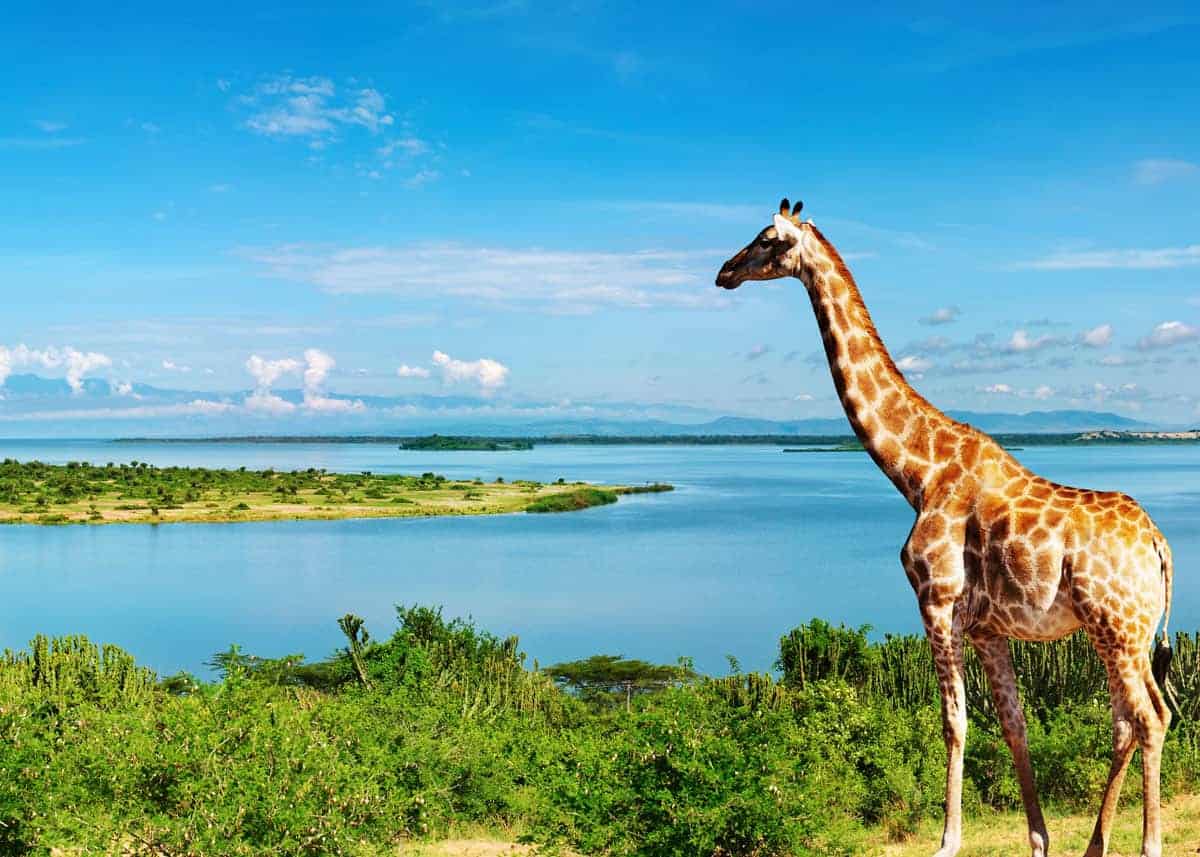
23. Saddle-billed Stork: Bird of the Pharaohs
The saddle-billed stork ( Ephippiorhynchus senegalensis ) was indeed known to the ancient Egyptians and depicted in a hieroglyph. It owes its name to the yellow shield on its black and red bill. At five feet tall, it is also one of the biggest storks and sports black and white plumage.
24. African Spoonbill
The African spoonbill ( Platalea alba ) is a member of the ibis family, and the end of its bill really is shaped like a spoon. It is large and has pure white feathers. Like other members in its family, it lives in wetlands. The African spoonbill hunts for fish, amphibians, insects and other prey in shallow water.
25. Oxpecker: Helpful Avian
There are two species of oxpecker ( Buphagus ), and they are the sole members of the family Buphagidae. They owe their name to their habit of perching on large animals like rhinos or cattle.
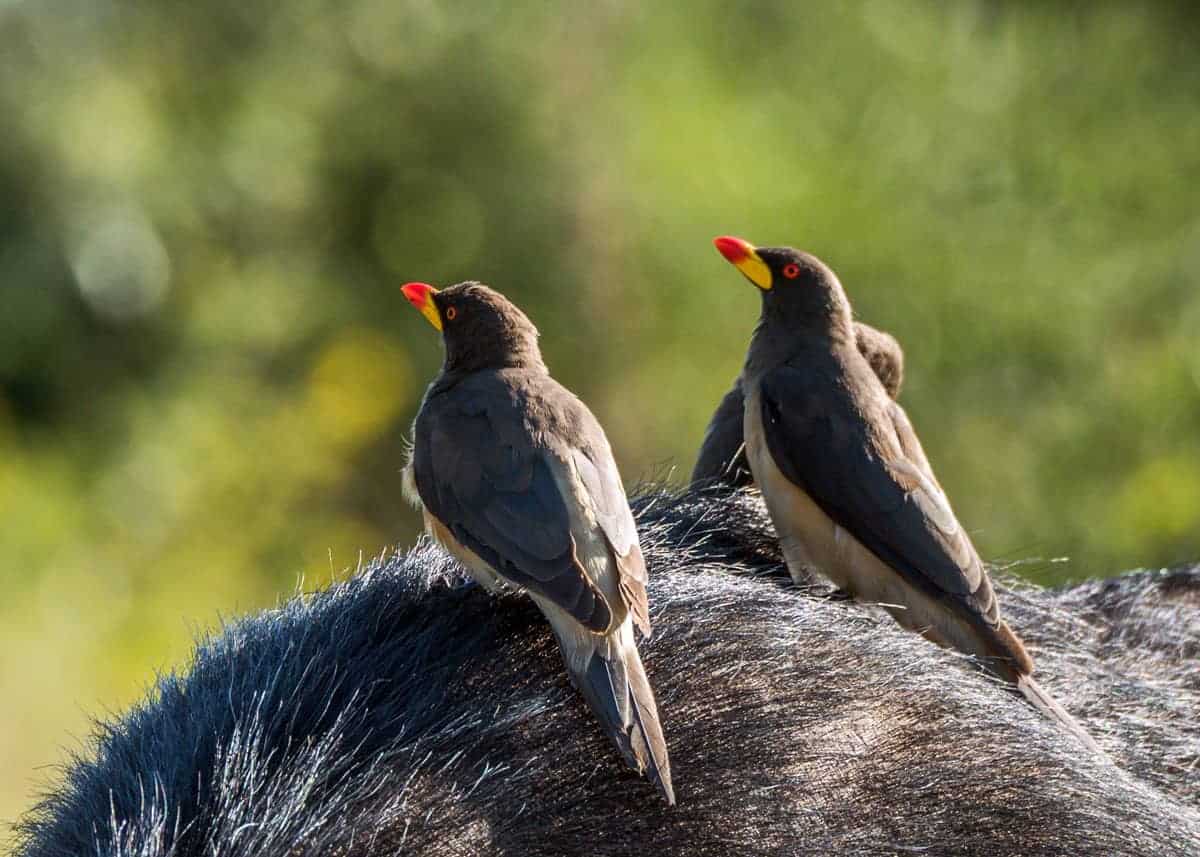
While they appear to peck at these animals, they are really eating the ticks and other parasites on their skin. While they can be found in most habitats, they do not live in rain forests or deserts.
26. Plains Zebras (Burchell Zebras)
Uganda is home to some 3,000 plains zebras. You can see them in Lake Mburo National Park and Kidepo Valley Park. Did you know that zebras have four different sounds and barks? Learn (and hear) more here .
Learn more about zebras in our huge zebra guide .
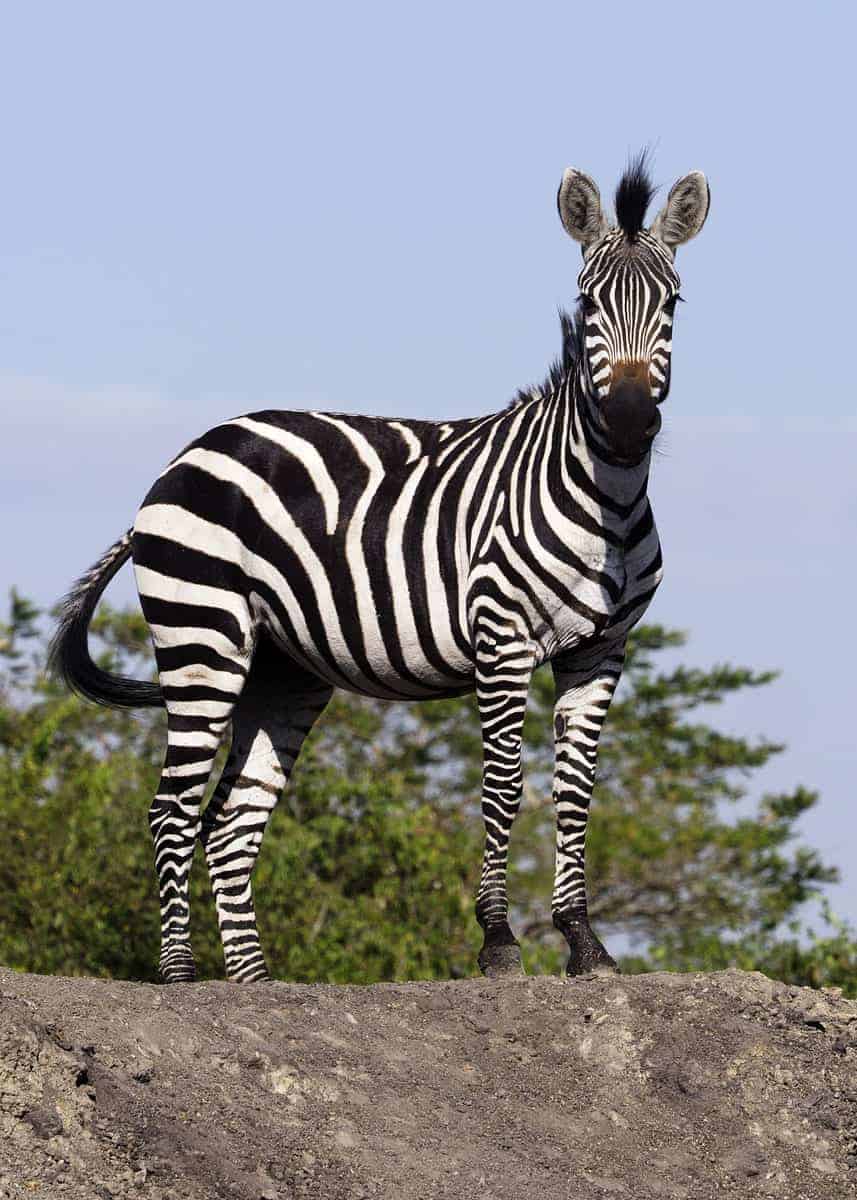
27. Spotted Hyenas
Hyenas are famous for their giggling calls and their unique body shape. Uganda is home to spotted hyenas – the largest and noisiest of four hyena species in Africa. Here’s our full guide to the spotted hyena .
Learn more about why hyenas laugh .
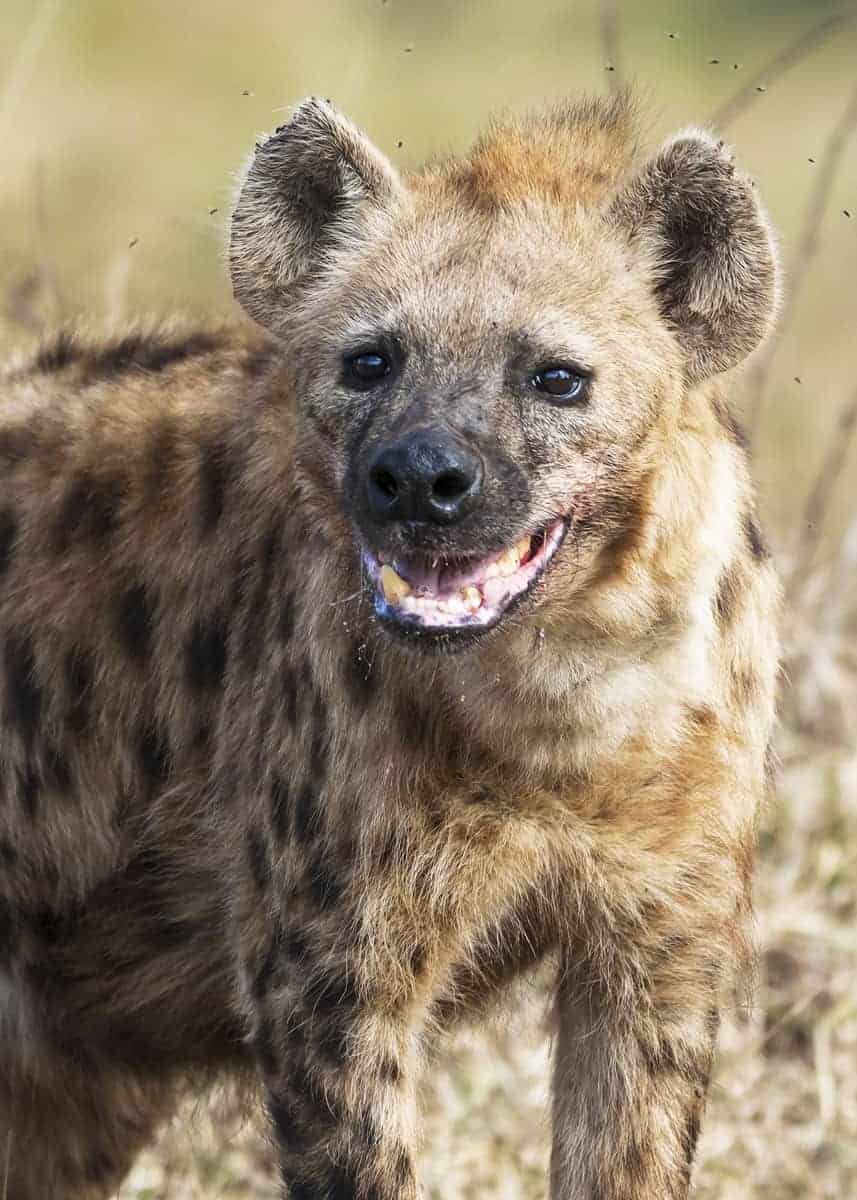
What is your favorite animal in Uganda? Which animal do you want to see most on your safari? Join us in the comments.
Hi, I'm Dena Haines . And I'm co-founder of Storyteller Travel . I love to cover food, animals, and destinations around the world.
I also blog about photography at Storyteller Tech .
Similar Posts

14 Things to Do in Kampala Uganda (Bonus: 11 Kampala Facts)
Thinking about visiting Kampala while in Uganda? In this post, you’ll learn all about Uganda’s capital city – interesting facts and many things to do in Kampala. Looking for facts about Kampala? Jump to that section now. 14 Things to Do in Kampala Uganda Here are 14 things to do in Kampala Uganda. Did we…
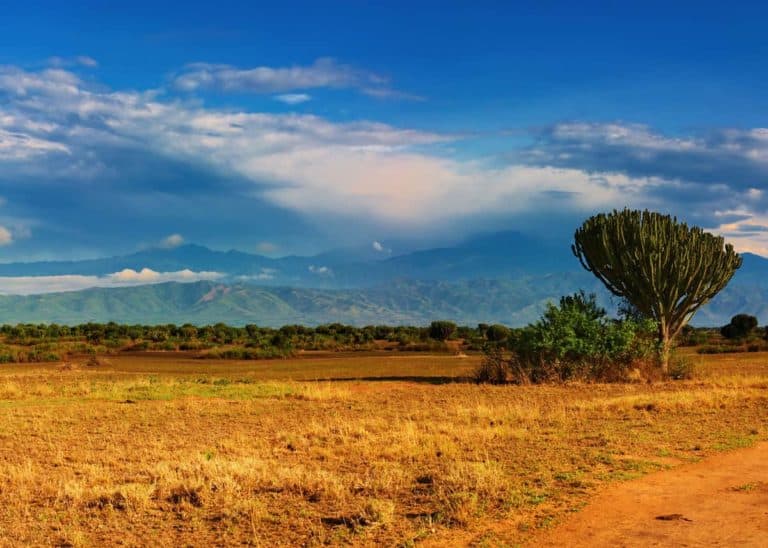
26 Beautiful Places to Visit in Uganda: Nature, Culture, Wildlife
Looking for the best places to visit in Uganda? In this huge guide, you’ll learn about 26 of the most beautiful and most interesting attractions in Uganda. Often called the “Pearl of Africa,” Uganda is a country jam-packed with breathtaking scenery, natural wonders, exotic wildlife and fascinating culture. Learn more with these 22 facts about Uganda….

Do Sharks Have Bones? Guide to Chondrichthyan Shark Cartilage
Sharks are known for their dorsal fin and teeth. But what about bones? Do sharks have bones? And how many? In this post, you’ll learn about shark skeletons, teeth, and cartilage. While they can fossilize, sharks do not have bones. Like all fish made of cartilaginous tissues (elasmobranchs), shark skeletons are made up completely of…

Do Squirrels Eat Meat? Omnivore, Carnivore, Predator
Are squirrels vegetarian, omnivores, or carnivores? Sure, squirrels eat seeds and nuts. But do squirrels eat meat? Learn their eating habits: foods they’ll eat and what they avoid. Squirrels are omnivores, which means that their diet consists of both plants and meat. Squirrels primarily eat vegetarian foods. But they will also eat bird eggs, insects,…

What’s the Largest Lake in Africa? 9 Largest Lakes Compared
Africa is home to many huge lakes. What’s the largest lake in Africa? And where are the best places to visit? In this post, you’ll learn about the 9 largest lakes in Africa. Plus lots of photos and details. Africa has so much to offer a western traveler including world-renowned lakes. Second only to the…

How to Choose a Uganda Gorilla Trek (Best Time to Go, Tour Companies, Price…)
Planning your Uganda gorilla trek? Perfect! In this post, you’ll learn what to expect, the best time to go, prices, and how to choose. I also include a list of the top 3 trekking tour companies. What should you bring on your gorilla trek? Don’t forget anything with our Complete African Safari Packing List How…
Just a correction on the number of rhinos on Ziwa Rhino Sanctuary. The number is now 32.
Thanks for the update Angela – we just updated this post and our profile post about white rhinos . Congratulations on your success!
I love this sight because it has lots of animal pictures’s and facts.
Wish to visit Uganda on February.require detail for their business/ industries/ people/ lives and religious
Leave a Reply Cancel reply
Your email address will not be published. Required fields are marked *
Let's talk holidays. We're open
- Keep in-touch with us
- 30 Amazing Wild Animals to See on Uganda Safari
- Blog Travel News Uganda & Rwanda

WILD ANIMALS FOUND IN UGANDA – 30 AMAZING WILDLIFE TO SEE ON SAFARI UGANDA
Wild Animals found in Uganda ; If you are planning an Africa Safari, here are 30 Amazing Wildlife that you should expect to see on your Uganda Safari. Uganda is a home to variety of wildlife which are impressive to travellers that visit Africa for wildlife safari holidays. Given its number of beautiful national parks and more conservation areas, Uganda is a must visit tourist destination in East Africa.
Uganda is blessed with variety of animal habitats including lush tropical rain forests, lakes, rivers and golden grasslands that all support variety of safaris and walking tour experiences.
If your dream is to have a once in lifetime safari in Africa, you should take a gorilla and wildlife safari Uganda and enjoy a safari game drive to see African big 5 animals (Elephant, Lion, Rhino, Buffalo and Leopard).
Besides game viewing safari in Uganda game parks, Chimpanzee and Mountain gorillas takes attention of most tourists visiting Uganda. This is beacuse, more than half of the World’s population of the endangered Mountain gorillas live in Uganda. Therefore Trekking through the lush forest to get face to face with mountain gorillas in Bwindi Impenetrable forest national park is a moment to treasure in life.
The best safari animals found in Uganda are categorized under primates – Gorilla, Chimpanzee, Golden monkey, Red tailed monkey, black and white colobus monkey and many others. Carnivores – Lion, Leopard, Jackel, Hyena and sarval cat. Herbivores – Elephants, buffaloes, Rhinos, Uganda Kob, Elends, Warthog, Hippopotamus, waterbuck and more. Reptiles – Crocodiles, lizard and snakes.
The Wild animals found in Uganda range in all sizes from the biggest to the smallest all living in the protected areas of Uganda. These can be viewed during the game drives, the nature walks, hiking, cruises and many more.
Where to go on Safari in Uganda?
- Murchison falls national park
- Bwindi Impenetrable national park
- Queen Elizabeth national park
- Lake Mburo national park
- Kibale Forest national park
If you love Wildlife and planning a Safari to Africa, here are the 30 amazing animals found in Uganda; The must See Uganda animals;
Mountain Gorilla

As the major highlight of every safari tour to Uganda, Mountain gorilla in Uganda are found in Bwindi Impenetrable forest jungle and Mgahinga national parks. More than half of the world’s population of mountain gorillas live here in Uganda. Gorillas spend most of their time feeding on leaves, celery, bamboo shoots, fruits and pulps. Gorillas are vegetarian. The mature silverback weighs up to 230kg and reach a height of 4-6 feet standing. Males are big than females. They live in family groups of 5 – 40 individuals with a dominant silverback heading the group. Gorillas lay nests on grounds each night or in low trees to rest. They live up to 35years old. It’s always an amazing experience to go trekking and see gorillas face to face in their natural habitat and learn more about them.

Chimpanzees are the closest relative to humans, sharing up 98% of their DNA. These chimpanzees live in tropical forests of Uganda. Chimpanzee in Uganda can be seen best in Kibale national park where the forest has over 1500 chimps living in a community. Other places to see chimpanzee while on Uganda Safari include; Kyambura gorge in Queen Elizabeth national park, Ngamba Island, Kalinzu forest, Budongo forest in Murchison falls park, and Semuliki wildlife reserve. Chimps live in troops of 15-70 members. They have long limbs, weigh up to 60 kgs and stand to a height of 4ft. Chimpanzee feed on leaves, fruits but sometimes they can change their diet and feed on ants and can hunt colobus monkeys for meat.
African Elephant

African Savanna Elephant also known as African Bush Elephants are the largest of all land mammels in the world and these can be seen in most of the savanna parks of Uganda. The African Elephants have continued to increase after facing hunting challenge of years back. For those interested in watching elephants, there are both African forest elephants and African bush elephants in Uganda. The best places to see African elephants in Uganda is Queen Elizabeth national park, Murchison falls national park, Kidepo valley national park and a few sights of Forest elephants are in Kibale and Bwindi impenetrable forest national parks. Elephants weigh between 4000kg to 6000Kgs when old, they eat up to 200kg of grass a day and drink up to 150litres of water.

A Lion is one of the safari animals that most visitors wish to see on any Safari to Uganda and Africa at large. Visitor on Uganda Safari have opportunity to encounter the tree climbing lions in Ishasha, the southern part of Queen Elizabeth national park. Lions are the largest carnivores in Africa that preys on other animals for food and feeding on meat up to 8 kg a day minimum. Lions in Uganda can be seen in Queen Elizabeth, Kidepo valley and Murchison falls national parks. Seeing lions on safari game drive while resting up in trees at Ishasha sector is an amazing experience that you will never forget.
White Rhinoceros

In Uganda there are only the Southern white rhinos which were reintroduced to Uganda after their extinction in 1983. Rhinos in Uganda national parks were hunted to extinction and currently Rhino tracking is done at Ziwa Rhino sanctuary, a Ranch in Nakasongola district. There is no national park in Uganda. Rhinos are one of the African big 5 animals and seeing them is always an amazing experience.

Leopard is one of the must see animals found in Uganda. Seeing a leopard on a Uganda safari is such an interesting experience given that they are hard to see since they are nocturnal animals. Leopards are usually seen resting up in the trees and they are very shy making it hard to spot them. Leopards can be seen in Murchison falls national park, Queen Elizabeth national park, Kidepo Valley national park and lake Mburo national park.
African Buffalo

Buffalo is one of the big five animals and can be seen in most protected areas in Uganda. In any safari to Uganda’s protected areas be assured of viewing buffalos either in water or on land. Buffalos can be spotted during boat cruise on Kazinga channel in Queen Elizabeth national park and along the Nile during boat cruise in Murchison falls national park.
Golden Monkey

Golden monkeys in Uganda are seen in Mgahinga national park only. It is one of Uganda’s 20 primate species and it is very rare and elusive. They are unique in appearance with an outstanding color almost gold hence the name golden monkeys. They are playful and quick in their movements.
Rothschild Giraffe

The Rothschild giraffe are the tallest giraffe standing up to 19.7feet and the only type found in Uganda. These can be seen in Kidepo valley national park, Lake Mburo national park and Murchison falls national park. They have long sturdy legs with the front legs longer than the back ones. They feed on leaves, flowers, seedpods and fruits.

In Uganda zebras are best seen in Lake Mburo national park and Kidepo valley national park. Zebras are herbivores and live in savanna plains. They are easy to identify by their black and white stripes and these stripes are unique with each and every zebra. There are over 3000 zebras in Uganda.
African Civet

African Civet is an native animal of sub-saharan Africa. It is a nocternal animal commonly seen in woodland and secondary forests. Civet has a dense fur which is short and greyish in color with black spots arranged in rows along the body. About a third of their tail are marked with stripes and their face is solid grey except the white muzzle and black markings around the eyes that go down the to the face. African Civet have short mane around their neck which runs to their back. Civets are omnivorous and their diet is comprised of Insects, rodents, eggs, reptiles, carrions, fruits, crabs, birds and sometimes they take prey on paultry and young lambs. African civet females become sexually active at one year old, and may have 1-2 litters in a year. Young civets are usullay born in stages relative to most carnivores, they usullay have fur which are dark. young civets always depend on mothers milk for about 6 weeks. Civets are always solitary but pairs can be seen when mating. They have variaty of visual olfactory and auditory means of communication. Individuals usually mark the territory with their ascent gland which play a major social role especially to convey information to their fellows. African civets suffer predation from Hyena, leopard, snakes and lion.
Hippopotamus

These are second largest animals in the world and also referred to as Hippos. In Uganda Hippos are common and their sights are guaranteed in the national parks. They can be seen in Queen Elizabeth national park, Lake Mburo national park, Murchison falls national park and visiting one of these parks it’s a must to see these hippos. Hippos spend most of their time in water and come out at night to graze.
Nile Crocodile

The Nile crocodiles are the most species of crocodiles seen in Uganda especially in Queen Elizabeth, Murchison falls national parks and along lakes and rivers like Albert and Victoria. These can measure up to 6meters long and can weigh up to 700kg. They feed on predators especially fish.

Sitatunga is a semi aquatic antelope that lives permanently in swamps. They usually come out to feed on the shoreline but they are very shy and they feed on swamp vegetation and woody vegetation. The females are light brown with white spots and long spiral horns. In Uganda they are usually seen in lake Mburo national park.
Vervet Monkey

These stay in woodlands, grasslands near lakes, rivers and swamps. Vervet monkeys feed on leaves, fruits, and small animals like lizards. They stand on hind legs once they spot danger and make alarm calls to warn the rest and usually they climb up from the ground for safety.

Impalas are graceful antelopes with long necks and slender legs. Females are hornless and males have S-shaped wide set horns. They feed on grass and shrubs and they are most active during the day.
Warthog (Pumba)

Common Warthogs are wild pigs found in the savanna parks in Uganda. They are gray, black or reddish after wallowing in mud and can survive in areas without water for months. They usually kneel on their knees while feeding which is a funny strange behavior. They are herbivores feeding on grass, roots, fruits, barks and plants. They hide from their predators by entering abandoned burrows in a reverse direction ready to jump out in case of danger.
Red tailed monkey

These are social primates that live in groups of up to 30 individuals. They are active in the mornings and evenings feeding on ground but rest up in the trees. They are omnivorous feeding on fruits. Leaves, flowers and insects. They have tails with red color increasing from base to tip, have white nose and cheeks with black or dark grey body fur.
Black and White Colobus monkey

These are the most common and wide spread in Uganda. They are beautiful primates with white face and long tail, black body with white side stripe. They feed on leaves, flowers, twigs and fruits. Black and White colobus monkeys live in forests, wooded grasslands and riverine forests. These can be seen in Kibale national park, Ssemuliki, Bwindi Impenetrable forest and Queen Elizabeth national parks in Uganda among others.

Bush bucks are shy antelopes that lives in dense thickets and riverine forests. They feed mostly at night, early mornings or late afternoon on branches, fruits, flowers and grass. Only males have horns which are spiral and fairly straight parallel to one another. They have white spots and stripes.

Eland is the largest of the antelopes and they are herbivorous feeding on grass, fruits, herbs and leaves. The Elands live in savanna plains, grasslands, woodlands but avoid dense forests. In Uganda Elands can be seen in Kidepo valley national park, Lake mburo national park and Pian Upe wildlife reserve. They are in two types the common eland and Giant eland which is the largest antelope.

The Uganda Kob is one of amazing animals found in Uganda that you may frequently see on a game drive. Uganda Kob has a reddish brown fur coat with white patches around the neck and underneath the belly. There is also a white ring around each eye and a black strip that runs down the front of each foreleg. Males only have horns that are shorter, thicker shaped in S-profile and ringed almost to the tip. They have medium length horns and large ears. They live in moist savanna, flood plains and woodlands of Uganda especially in Murchison falls national park and Queen Elizabeth national park.
L’Hoest Monkey

These prefer to live in mountainous areas with forests and savanna woodlands along the slopes. They have a black face with white bibs on both cheeks. They majorly feed on leaves, roots, fruits and other variety of food like small birds and reptiles. In Uganda they can be seen in Kibale forest national park and Bwindi impenetrable national park.

Cheetahs are the fastest animal in Africa on land and in Uganda cheatahs can be seen only in Kidepo Valley national park which is located in northeastern part of the country. They live in open grassland, Savanna plains and Rocky Mountains. Cheetahs have a gold coat with black spots and a black tear mark that runs down the eye to the corner of the mouth. They are rarely seen in Uganda but the best luck is got on several game drive safari in Kidepo national park.
Grey Cheeked Mangabey

They are found in Kibale national park and Semuliki national park in Uganda. They feed on fruit, shoots, flowers and insects. They live in groups of up to 30 individuals and spend most of their time up in the canopy and they leap through the forest with help of strong tail that hooks on branches. They are small with thick brown fur with little golden mane around the neck.

Baboons are one of the animals found in Uganda, frequently encountered along the road sides, in fringes of forest reserves and in many parts of the country. In Uganda, there only olive Baboons which are the sociable primates living in groups of up to 50 individuals spending most of their time grooming each other and playing. Baboons are omnivorous and usually aggressive where there is food. The Baboons feed as they move during early morning, afternoon with babies carried at the back or on the chest when still very young. They spend the rest of day time grooming each other.
Klipspringer

Klipspringers stay in rocky habitats like rocky hills, koppies and gorges with rocky sides. In Uganda they can be seen on Lake Mburo national park and Kidepo valley national park. They feed on herbs, flowers, fruits, grass, shrubs, barks, leaves and green shoots. They have cylindrical hooves pointing downwards giving them a tip top walk on rocks.

Jackal Side stripped Jackal and Black backed Jackal; Side stripped jackal is a native to central and southern Africa, dwelling in woodland and scrub areas of most savannas. Side stripped jackels are nocternal animals, dog like carnivore. The side stripped jackal are rarely seen and appear more larger than the more common blck backed jackal. Their body color is grey buff, with a darker back. the sides are marked with white stripe having black lower margins. The tail is dark tail is tipped with white while the ears are dark buff in color. Jackal is omnivorus and their diet is comprised of wide varieties of food, they changes diet in response to environment conditions which include, small mammals, fruits maize, reptiles eggs, birds and carrions. they are less preditory compared to the black backed jackal. They mate throughout the year but most of mating occur in june and july. Females give birth to four to six pups after a gestation period of 57-64 days especially in August to november. during breeding, a pair remains in close proximity, jackels are territorial animals of which each terrotory is held by monogamous pair and their recent off springs. Jackals can be seen on safari to Bwindi and Mgahinga, Murchison falls national park, Kidepo valley national park

Topi are one of the most common and widespread antelopes in Africa. They live in grassland and woodlands. They prefer to stay in areas with green grass of medium height that goes up to dry seasons. They have dark musk on their faces, dark purple patches on their upper legs and elongated heads with a hump on the base of the neck. Topis are usually a lot in an area or absent
Spotted Hyena

Spotted hyena is one of the amazing animals found in Uganda. A Spotted Hyena has a variable color from pale buff to dull grey, with the whole body marked with irregular spots which turns to fainter with age. A hyena is large powerful built animal with dark tipped, bushy short tail. These hyenas live in clan of related females and unrelated males centered on a den. Hyenas are frequently seen in most of Uganda savanna parks such as Queen Elizabeth national park, Murchison falls national park and in Lake Mburo national park. Female hyena appear larger than males, producing up to 4 cubs which are born black in color. Hyenas are well known for scavenging, following lions to share the kill. Despite of this behavior, they are also good hunters, kills Uganda Kobs, calves, Topi and other small antelopes
Share this:
- Click to share on Twitter (Opens in new window)
- Click to share on Facebook (Opens in new window)
Related Tours

Ndere Cultural Centre Uganda

Top Things to Do in Akagera National Park Rwanda

Zip Lining in Uganda

Kasubi Tombs, Kampala Uganda
Leave a reply cancel reply.
Your email address will not be published. Required fields are marked *
Save my name, email, and website in this browser for the next time I comment.
Notify me of follow-up comments by email.
Notify me of new posts by email.
This site uses Akismet to reduce spam. Learn how your comment data is processed .

- South Africa
- Philippines
- Faroe Islands
- Netherlands
- United States
- French Polynesia
- New Zealand
The Wildlife of Uganda – 15 must-see Animals
Uganda is a landlocked country in East Africa whose diverse landscape encompasses the snow-capped Rwenzori Mountains and immense Lake Victoria. Its wildlife is noteworthy for its diversity and abundance. Uganda is one of the world’s foremost safari destinations, hosting more than half of the world’s remaining mountain gorillas.
So if you are looking for a fantastic safari experience, Uganda should definitely be on your list!
Here are 15 must-see animals that call Uganda home:
1. gorillas.
As mentioned, Uganda is one of the world’s foremost destinations for seeing mountain gorillas in their natural habitat. Known for their gentle nature, these amazing animals are a sight to behold and an experience you will never forget. Several habituated gorilla groups can be visited in Uganda’s Bwindi Impenetrable Forest and Mgahinga Gorilla National Parks.
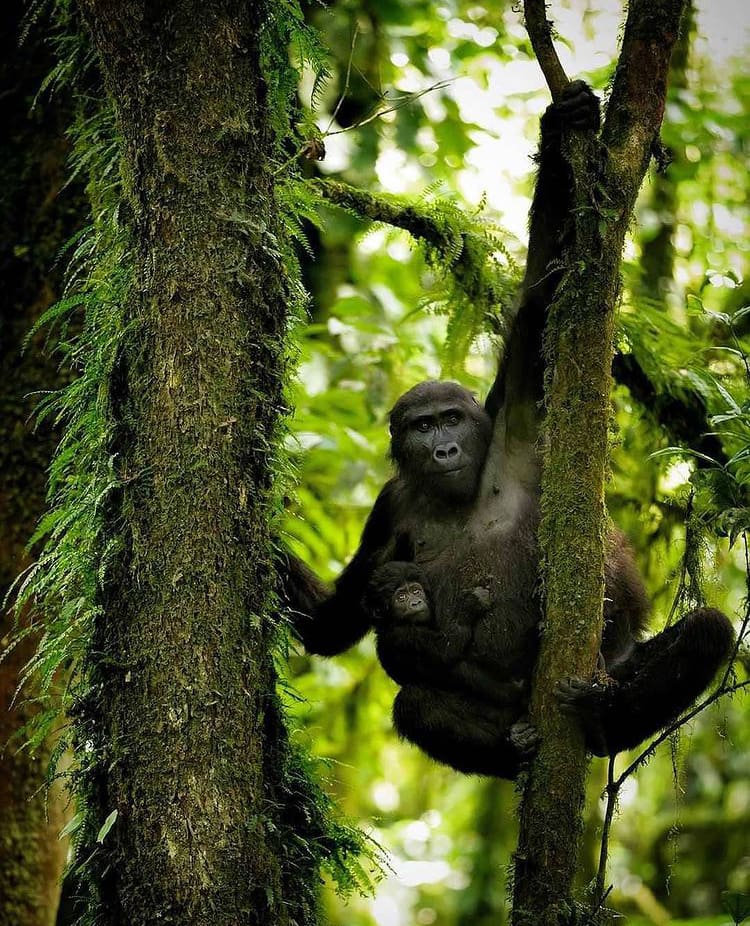
The Bwindi Impenetrable National Park and Mgahinga Gorilla National Park are both home to several gorilla families that visitors can track. Gorilla trekking is an unforgettable experience and a must-do when in Uganda! Seeing the gorillas may be a bit of a hike, but it is well worth the effort when you finally come face-to-face with these gentle giants. All you need to do is purchase a permit in advance – which can be done through your tour company or directly with the Ugandan Wildlife Authority.
2. Tree-climbing lions
One of the unique things about Ugandan wildlife is that there are lions that live in trees! These big cats are found in the Ishasha sector of Queen Elizabeth National Park and are most active during the day when they can be seen lounging in the branches or taking a nap. As with gorilla trekking, you must purchase a permit in advance – which can be done through your tour company or directly with the Ugandan Wildlife Authority.
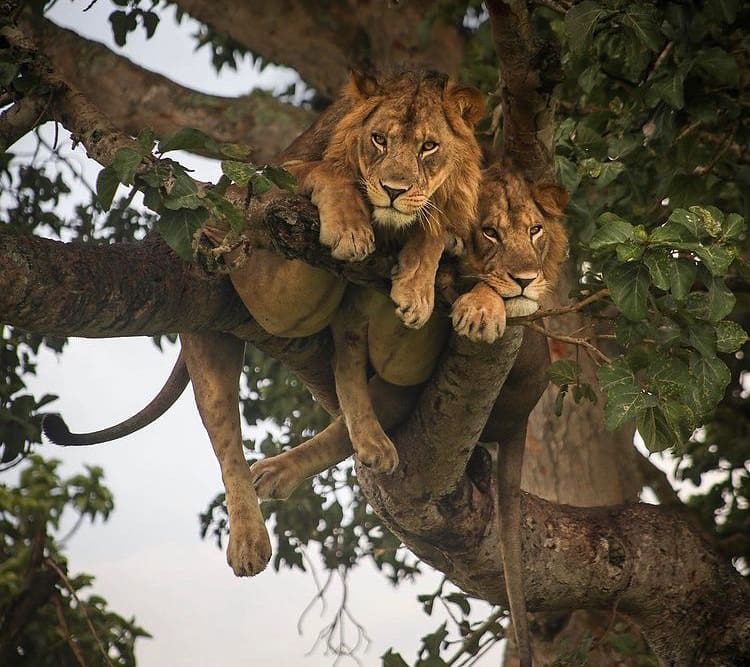
Lions in Uganda climb trees because of the many tsetse flies in the area – the branches provide a reprieve from these pesky insects. This is also an excellent spot to see elephants, antelope, and other wildlife roaming below the trees. These animals serve as their prey.
While tree-climbing lions are relatively easy to spot, don’t forget that there are also plenty of lions on the ground in Uganda’s national parks. While tree-climbing lions are a must-see, they can be elusive, so it’s essential to have realistic expectations. But if you’re lucky enough to see one, it will be a highlight of your safari!
The leopard is one of the “ big five ” animals every safari-goer wants to see. While they are notoriously elusive, if you put in the time and effort, your chances of seeing a leopard are pretty good in Uganda. The best place to see leopards is in Queen Elizabeth National Park, where they can often be seen lounging in trees or stalking their prey. The best time to see a leopard is at dawn or dusk when they are most active.
Seeing a leopard in the wild is truly a once-in-a-lifetime experience. These powerful and beautiful animals are definitely worth the effort to see!
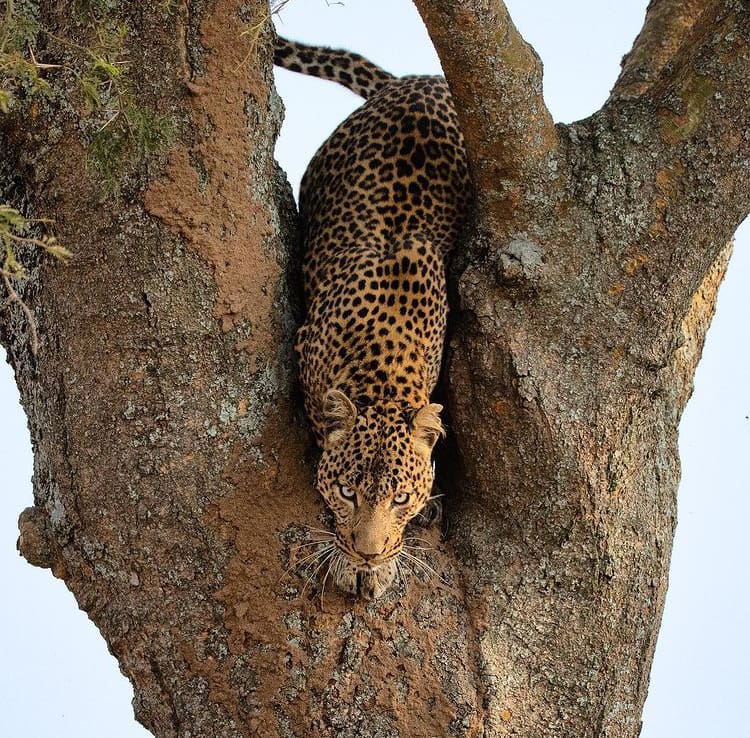
4. Shoebill stork
The shoebill stork is a large bird easily recognizable by its massive bill. These unique birds can be found in swampy areas near lakes and rivers. The best place to see shoebill storks is in the Murchison Falls National Park, where they can often be seen wading in the water or perched on a tree branch. These birds are relatively easy to spot, but getting a good photo can be challenging – so make sure you have your camera ready!
While they may not be as exciting as some other animals on this list, the shoebill stork is a must-see in Uganda!
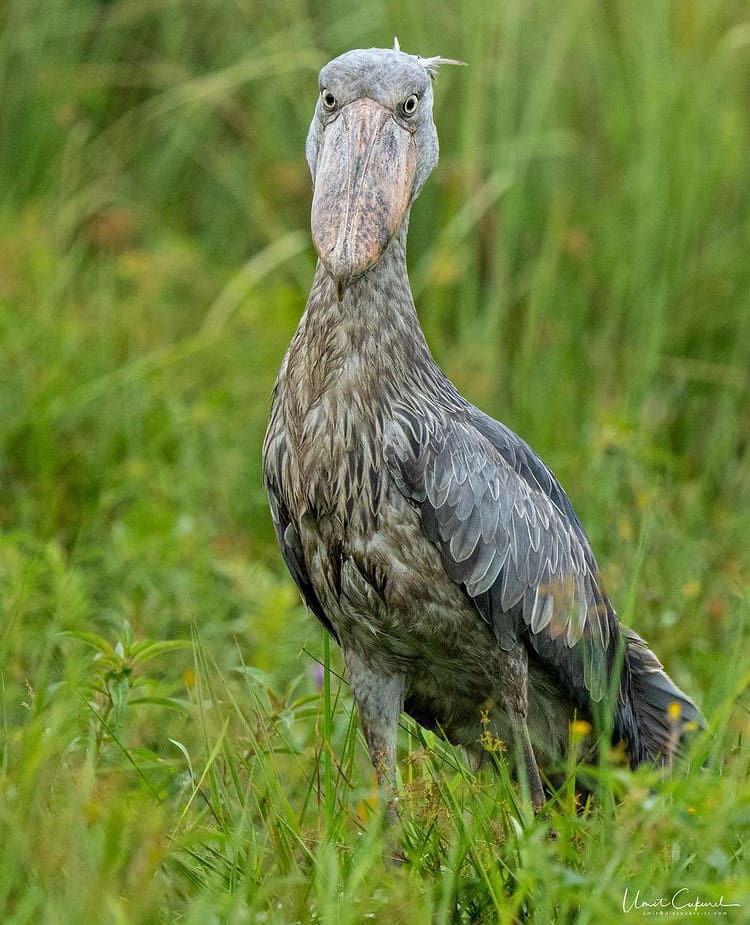
5. Chimpanzee
Uganda is home to more than half of the world’s remaining mountain gorillas, but it’s also an excellent place to see chimpanzees. Chimpanzees are found in several national parks, including Kibale Forest National Park, Kyambura Gorge, and Queen Elizabeth National Park. Kibale Forest National Park is one of the best places in the world to see chimpanzees. It has the highest density of chimpanzees anywhere!
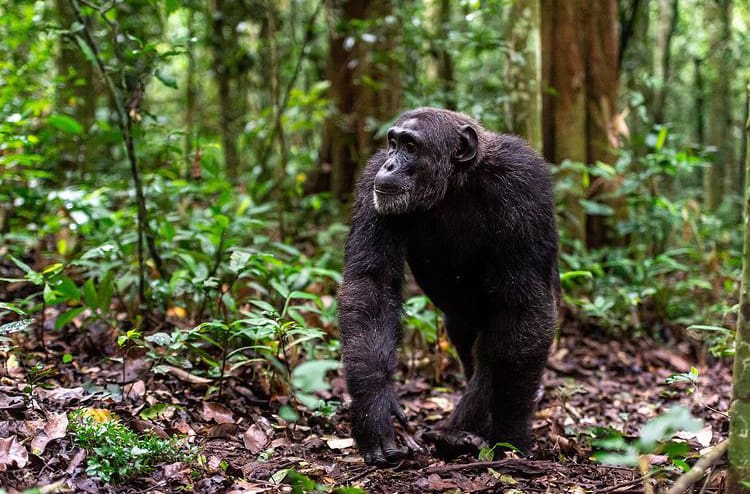
A chimpanzee trek is a bit different than a gorilla trek – instead of hiking through the forest, you will be walking on a network of raised wooden walkways. This allows you to get close to the chimpanzees without disturbing their natural habitat.
Chimpanzee trekking is a fantastic experience – you will be able to see these creatures up close and learn more about their fascinating behavior. It’s a must-do when in Uganda!
6. African Fish Eagle
The African fish eagle is the national bird of Uganda and can be found in several different habitats across the country. These breathtaking birds are most often seen near bodies of water where they hunt for fish. If you want to see an African fish eagle up close, your best bet is to visit one of Uganda’s many lakes, such as Lake Mburo or Lake Victoria.
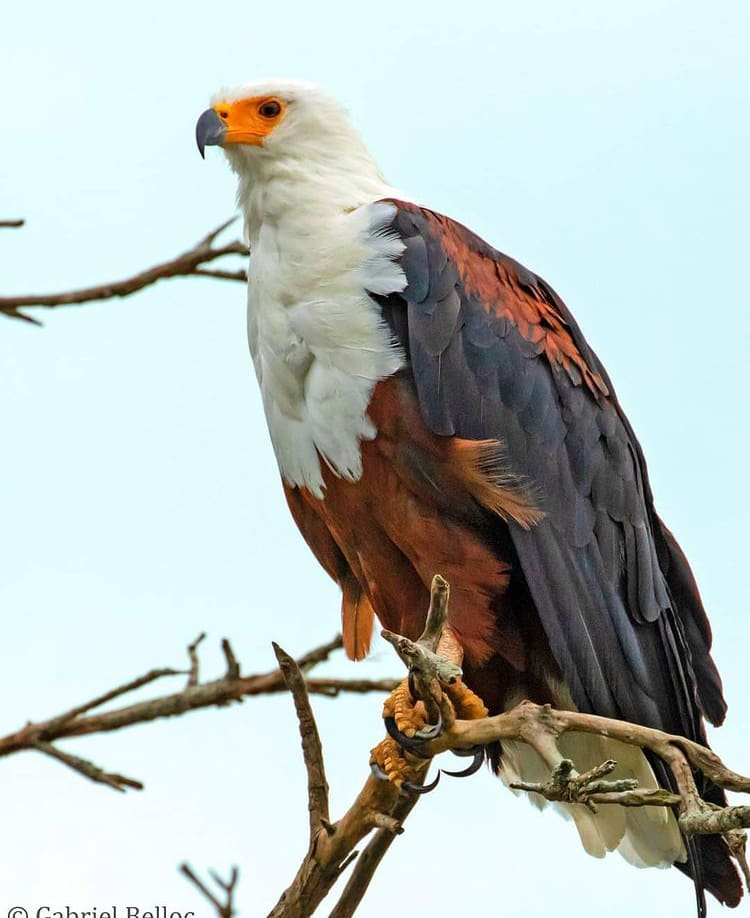
While the African fish eagle is a relatively common bird, it is still an impressive sight. Be sure to keep your eyes peeled for these magnificent creatures while out and about in Uganda. But if you see an African fish eagle, remember to respect their space and not approach them. Do not try to feed them; be sure to dispose of any rubbish properly to prevent them from getting hurt. Having these things in mind will help you preserve their beauty.
Uganda is home to both black and white rhinos. While the black rhino is more common, the white rhino is the one most people want to see. These massive creatures can weigh up to two tons and are an impressive sight! There are only a few hundred white rhinos left in the world, so seeing one in the wild is truly a once-in-a-lifetime experience.
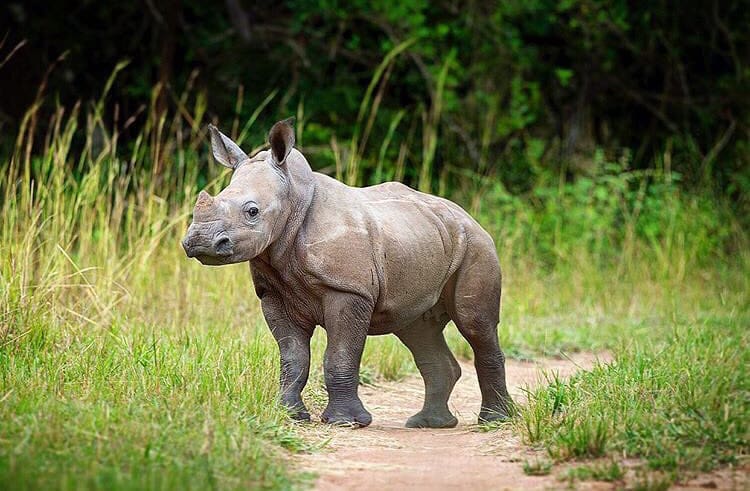
The best place to see a white rhino is in Ziwa Rhino Sanctuary, located just outside Kampala. This protected area is home to over two dozen rhinos and is the only place in Uganda where you can see these fantastic creatures.
While rhinos are a must-see animal, it’s important to remember that they are endangered. Be sure to respect their space and do not try to approach or feed them. Following these guidelines can help ensure that rhinos will be around for future generations to enjoy.
Buffalos are another common animal that can be found in Uganda. These massive creatures are often seen in herds and can weigh up to a ton! While they may seem docile, buffalos can be dangerous if they feel threatened. It’s important to respect their space and never approach or try to feed them.
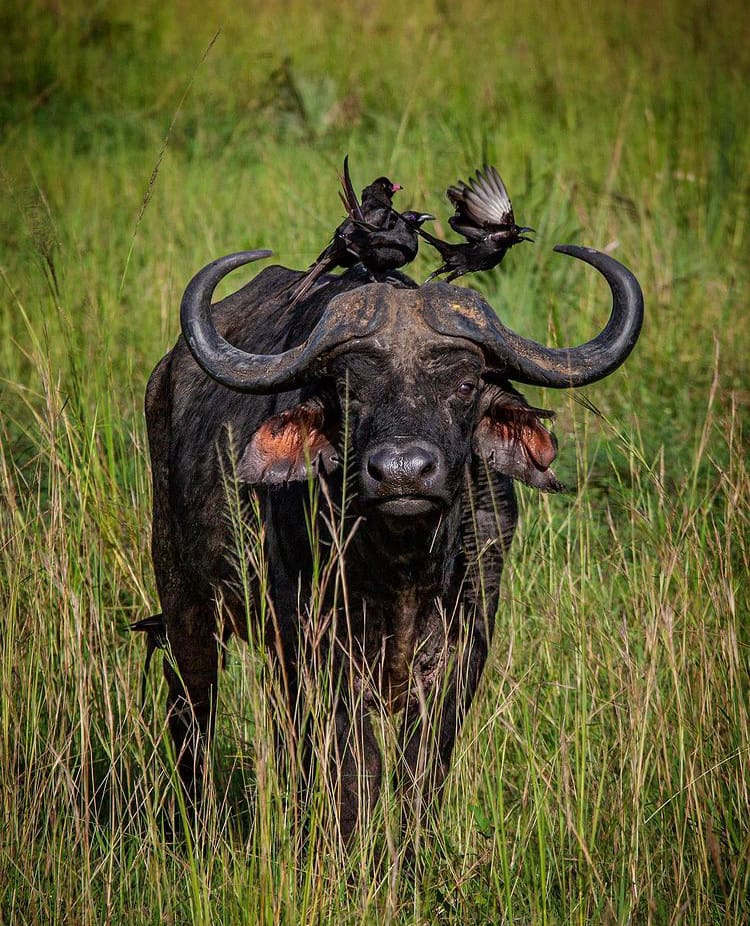
Queen Elizabeth National Park is the most fantastic place to view a buffalo. This park has many buffaloes, and it’s simple to notice if you keep your eyes open.
While seeing a buffalo in the wild is a fantastic experience, it’s important to remember that they are wild animals and should be respected. Be sure to follow the guidelines your tour guide and a park ranger set to ensure a safe and enjoyable experience for everyone involved.
9. Golden Monkeys
Golden monkeys are an endangered species of monkeys that can be found in Uganda. These beautiful creatures are often seen in the wild and are a sight to behold! While they may be small, they are a must-see animal when visiting Uganda. They live in troops and are very social creatures.
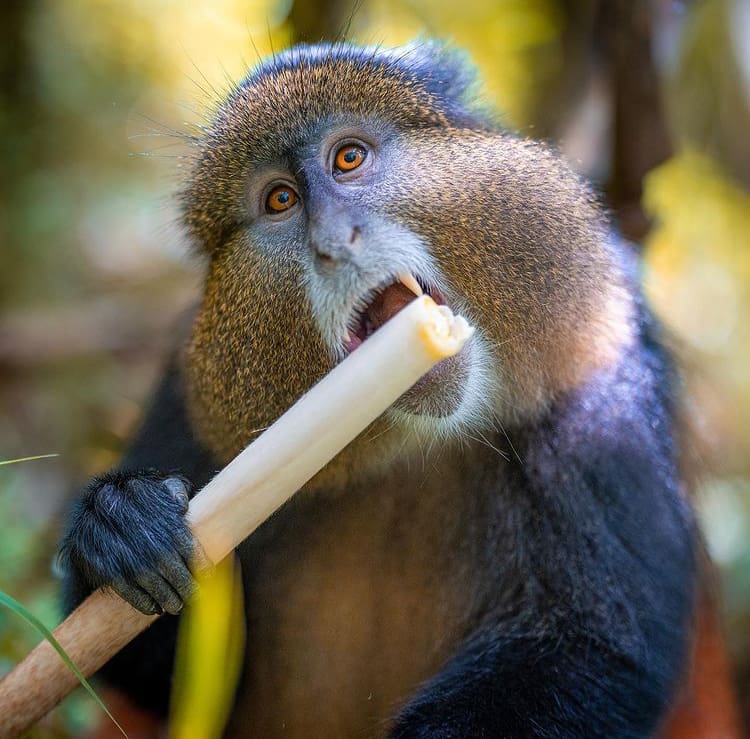
The best place to see golden monkeys is in Bwindi Impenetrable National Park. This park is home to many golden monkeys and is the perfect place to get up close and personal with these fantastic creatures.
Golden monkeys are endangered, so seeing them in the wild is astounding. It’s crucial to remember that they’re threatened when you see them in the wild. Keep a safe distance from them and don’t try to approach or feed them. Following these guidelines may help ensure that golden monkeys survive for future generations.
Hippos are one of the most dangerous animals in Uganda and should be treated with caution. However, they are also fascinating animals to watch. These massive creatures can often be lounging in rivers or napping on the shore. While they may look lazy, they are very aggressive and should be respected as such.
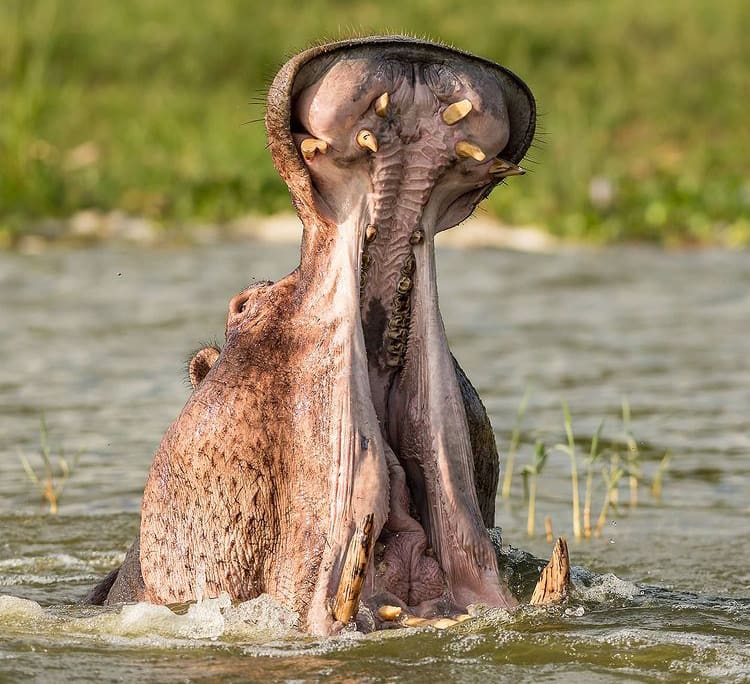
The best place to see a hippo is in Queen Elizabeth National Park. This park is home to many hippos and offers visitors the opportunity to get up close and personal with these creatures. While it’s a fantastic experience, it’s important to remember that hippos are dangerous animals. Be sure to follow the guidelines your tour guide and a park ranger set to ensure a safe and enjoyable experience for everyone involved.
11. Elephants
Elephants are another common animal that can be found in Uganda. These massive creatures are often seen in herds and can weigh up to six tons! They are very gentle giants and are a joy to watch. While they may seem docile, elephants can be dangerous if they feel threatened. It’s important to respect their space and never approach or try to feed them.
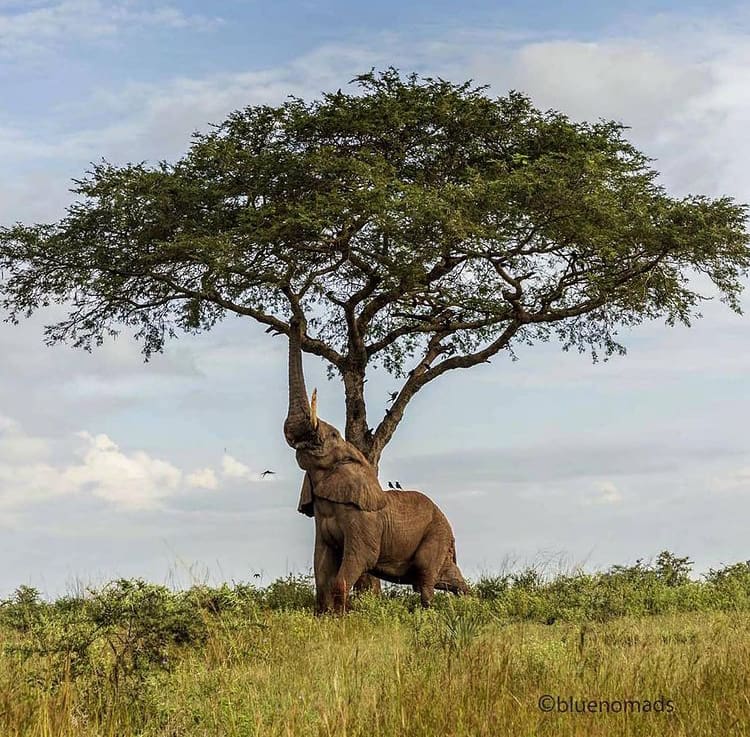
If you are planning to see these creatures in the wild, the best place to go is Queen Elizabeth National Park. This park has many elephants, and it’s simple to notice if you keep your eyes open.
12. Crocodiles
Crocodiles are one of the most dangerous animals in Uganda and should be treated with caution. These massive reptiles can often be seen basking in the sun or lurking in the water, waiting for their next meal. While they may seem docile, crocodiles are very aggressive and should be respected.
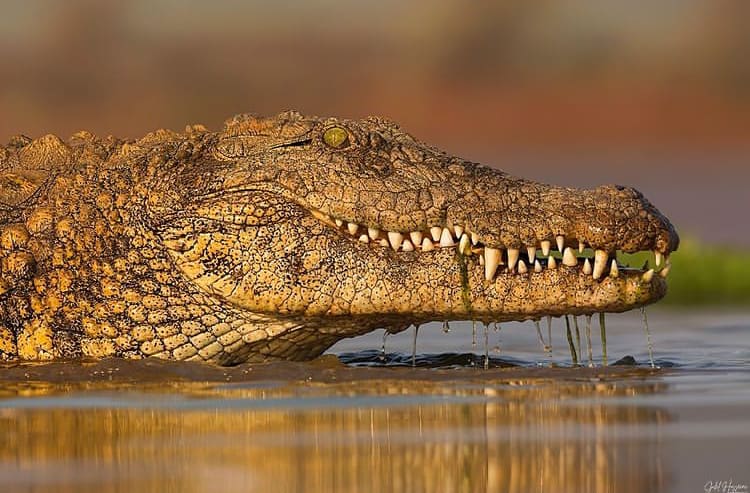
The best place to see a crocodile is in Queen Elizabeth National Park. This park is home to many crocodiles and offers visitors the opportunity to get up close and personal with these creatures. While it’s a fantastic experience, it’s important to remember that crocodiles are dangerous animals.
13. Gray-crowned crane
The gray-crowned crane is the national bird of Uganda and is a must-see for any bird lover. These beautiful creatures can be found in wetlands and grasslands throughout the country. They are very social birds and often travel in pairs or small groups. These birds are best seen in Murchison Falls National Park.
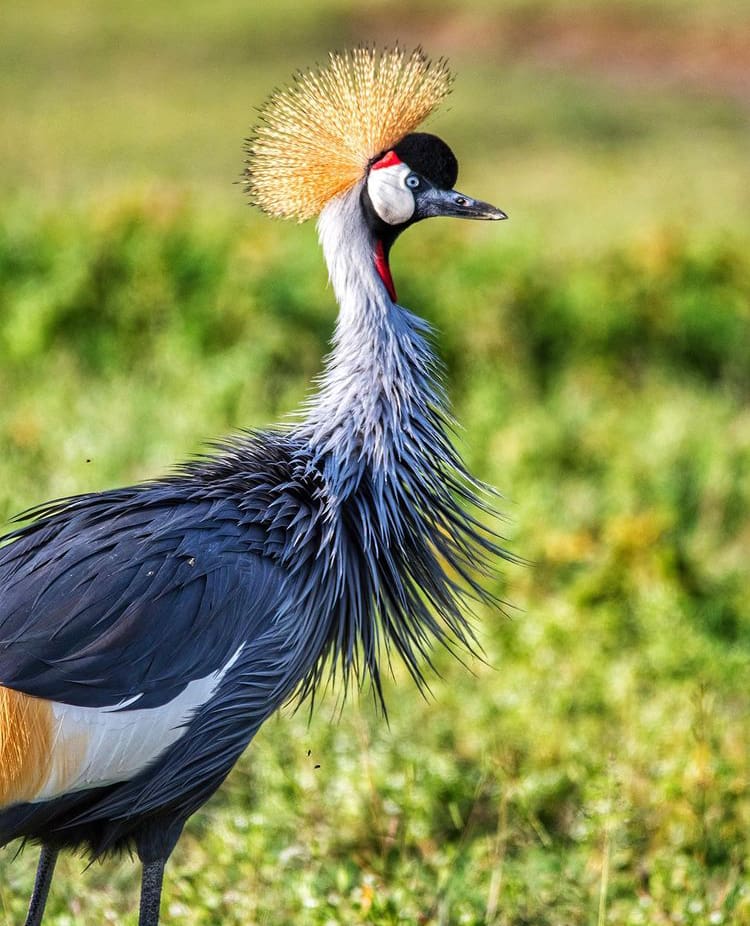
Murchison Falls National Park is home to a large number of gray-crowned cranes. This park is perfect for seeing these birds in their natural habitat. While they may be shy, they are worth seeking out!
14. Giraffe
Giraffes are among the most iconic African animals and can be found in several different national parks across Uganda. These gentle giants are a sight to behold and make for a fantastic safari experience. While they are usually timid, giraffes can be approached if they don’t feel threatened. Having an up-close and personal encounter with a giraffe is an experience you won’t soon forget!
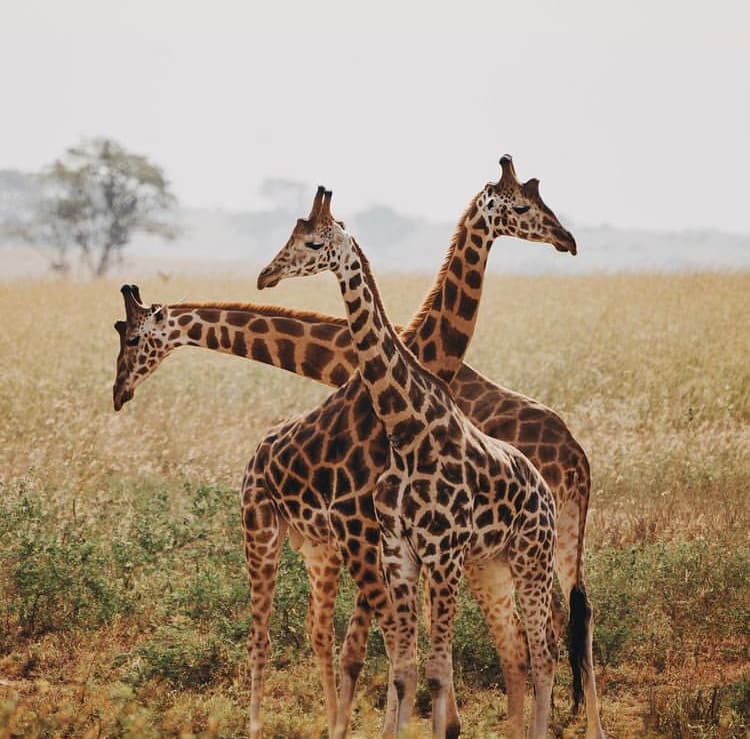
The best place to see a giraffe is in Murchison Falls National Park. This park is home to many giraffes and offers visitors the opportunity to get up close and personal with these creatures. While it’s a fantastic experience, it’s important to remember that giraffes are wild animals. Be sure to follow the guidelines your tour guide and a park ranger set to ensure a safe and enjoyable experience for everyone involved.
Hyenas are often considered dangerous animals but are pretty shy and elusive. However, if you’re patient, you may be rewarded with a glimpse of one of these fantastic creatures. While they may not be the most glamorous animal on this list, they are a fascinating species to watch.
Hyenas are found in several different national parks across Uganda. The best place to see a hyena is in Murchison Falls National Park. Hyenas here are often seen scavenging for food or hunting at night. While they may be shy, they are worth seeking out!
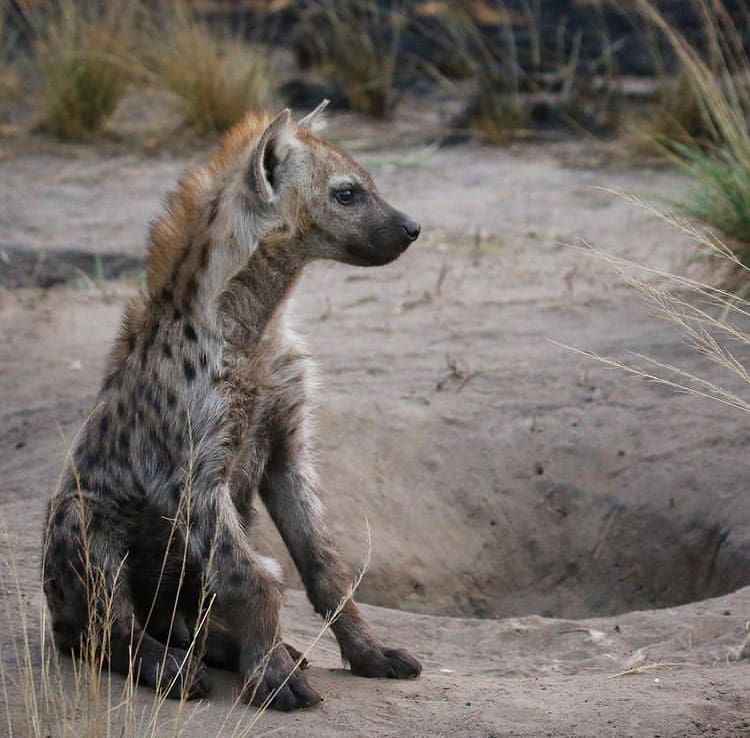
Uganda is a landlocked country located in East Africa. It is home to abundant wildlife, including elephants, crocodiles, and giraffes. If you’re looking for a fantastic safari experience, Uganda should be at the top of your list! There’s something for everyone with so many different parks and reserves to choose from. So what are you waiting for? Start planning your trip today!
STAY UPDATED
Join our community of keen travellers, wildlife enthusiasts and adventure seekers..
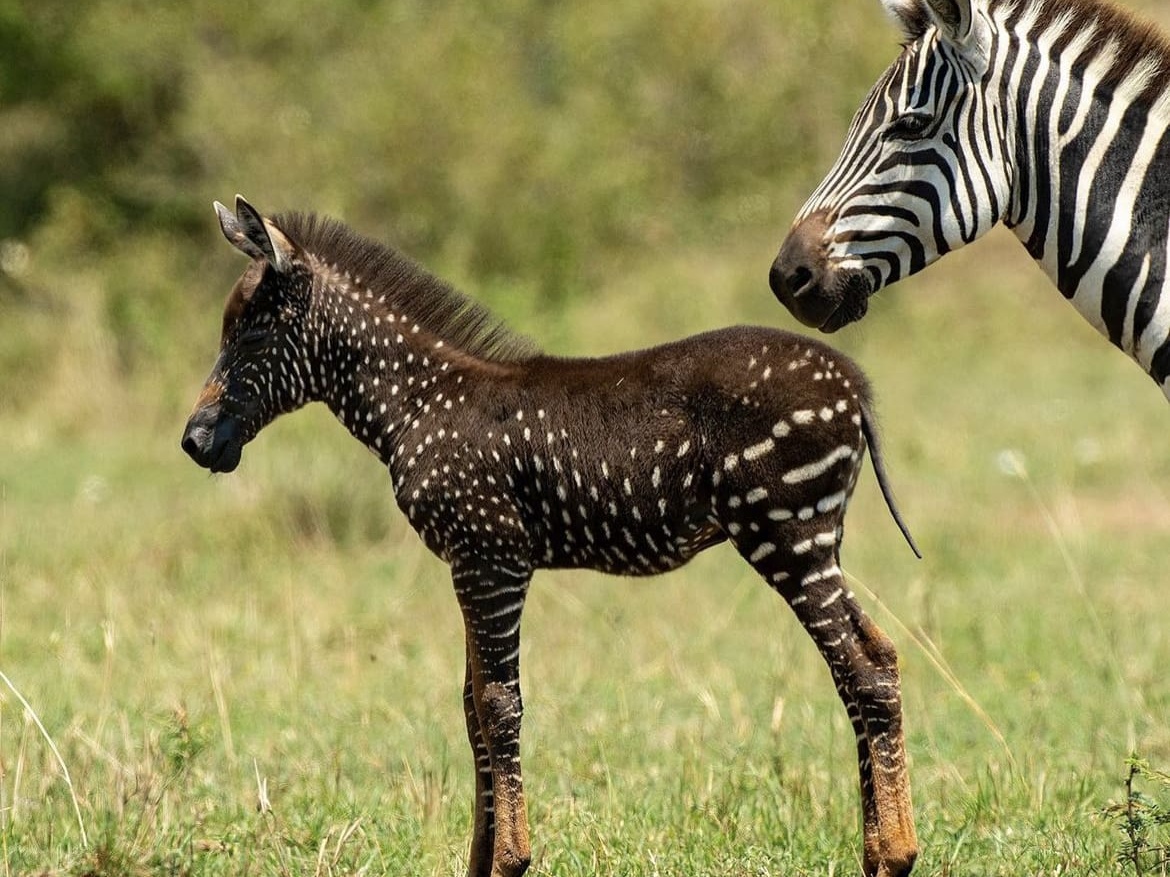
Meet Tira – the Polka-dotted Zebra
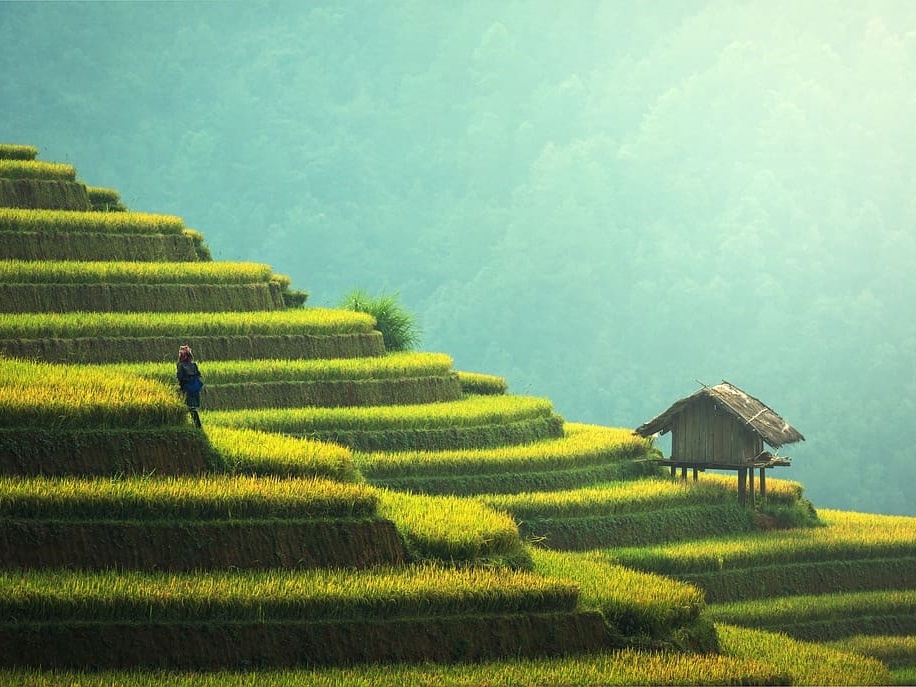
What Is The Time In Malaysia?
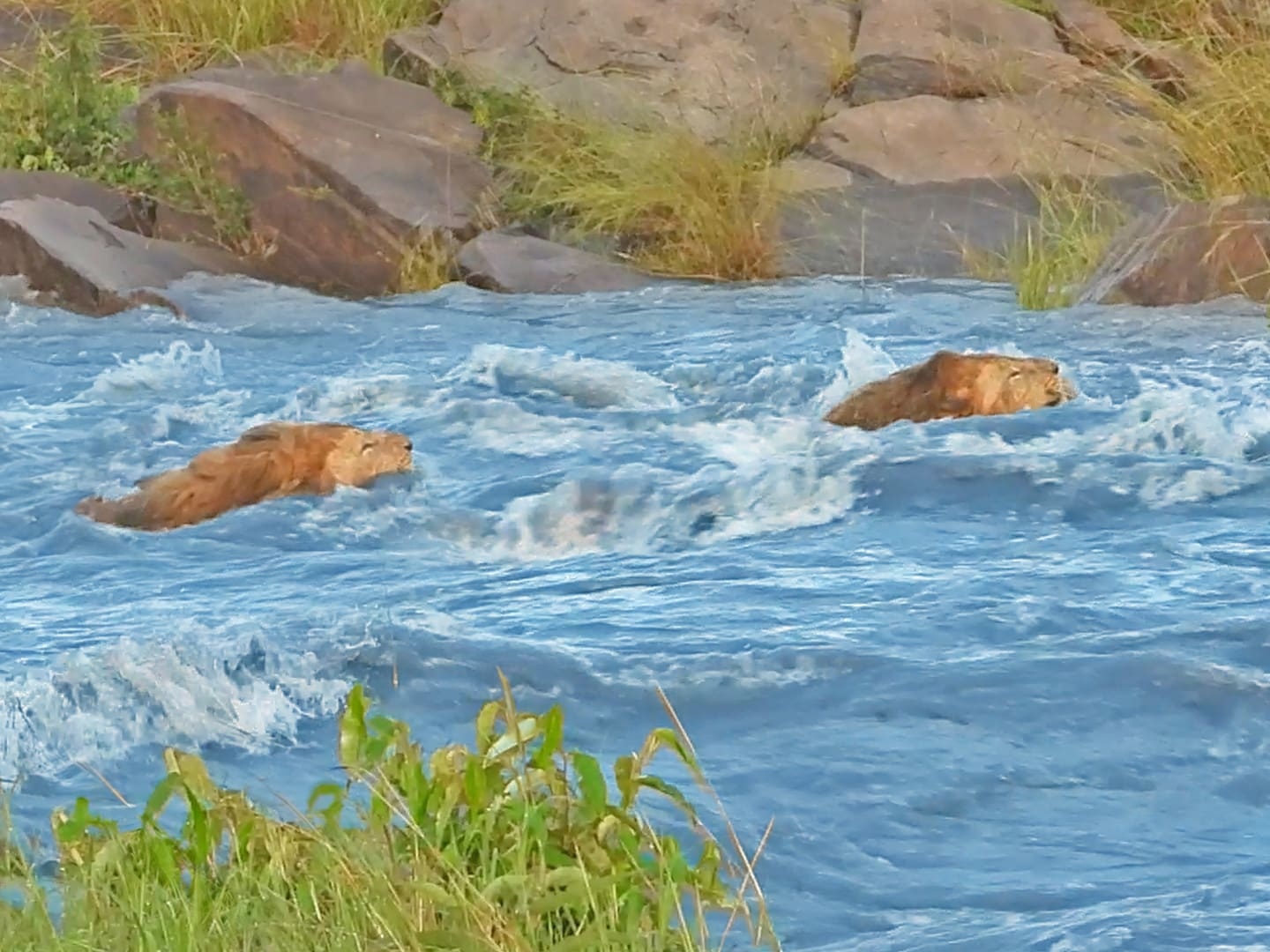
WATCH: Male Lions Washed Away By A Raging River

Can Shipping Containers Help Resolve Ghana’s Housing Crisis?
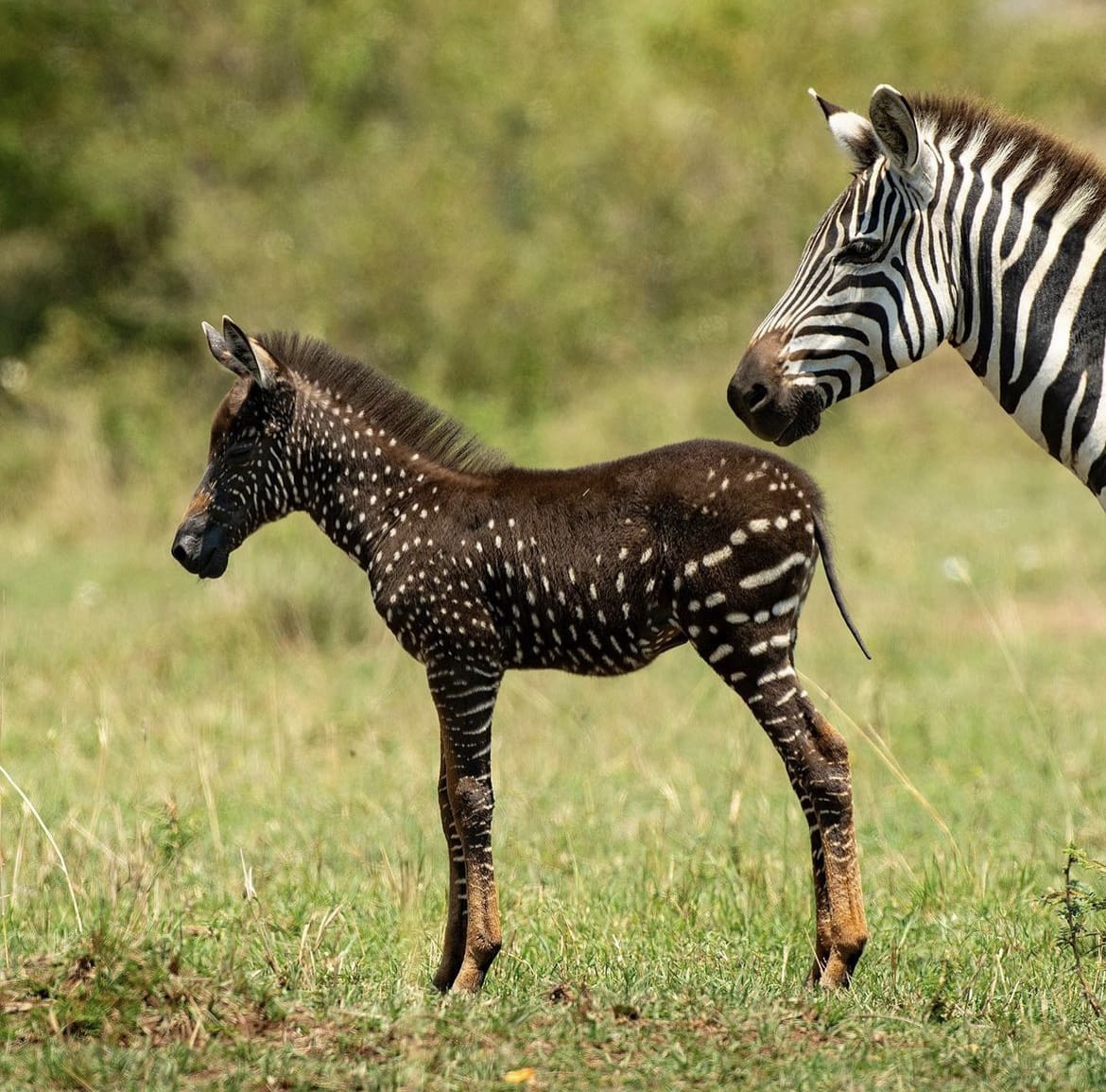
May 30, 2024
The Rare, Spotted Zebra Took The World By Storm
Ever heard of a zebra with polka dots? No, this isn’t some wild Photoshop trickery or a new filter on social media. Meet Tira, the zebra that’s rewriting the rules of nature with its one-of-a-kind polka-dotted pattern. Spotted – quite literally – in the Maasai Mara, Kenya’s crown jewel of wildlife havens, Tira isn’t just any zebra; it’s a living, breathing enigma that’s got everyone talking.
The Maasai Mara is no stranger to extraordinary wildlife spectacles. From the thunderous great migration to the raw power plays of the big cats, this place is the epitome of wild. But even in a landscape teeming with life, Tira manages to steal the spotlight. Imagine the surprise of seasoned safari-goers and researchers alike when they first laid eyes on this rare, spotty wonder.
In a world where every zebra looks like a barcode on legs, Tira’s polka-dots are a refreshing twist. This isn’t just a quirky quirk; it’s a fascinating anomaly that has the potential to reveal new insights about zebra genetics and wildlife diversity. So, buckle up as we dive into the story of Tira, explore the science behind those dots, and dish out some insider tips on how you can catch a glimpse of this remarkable creature in the wild.
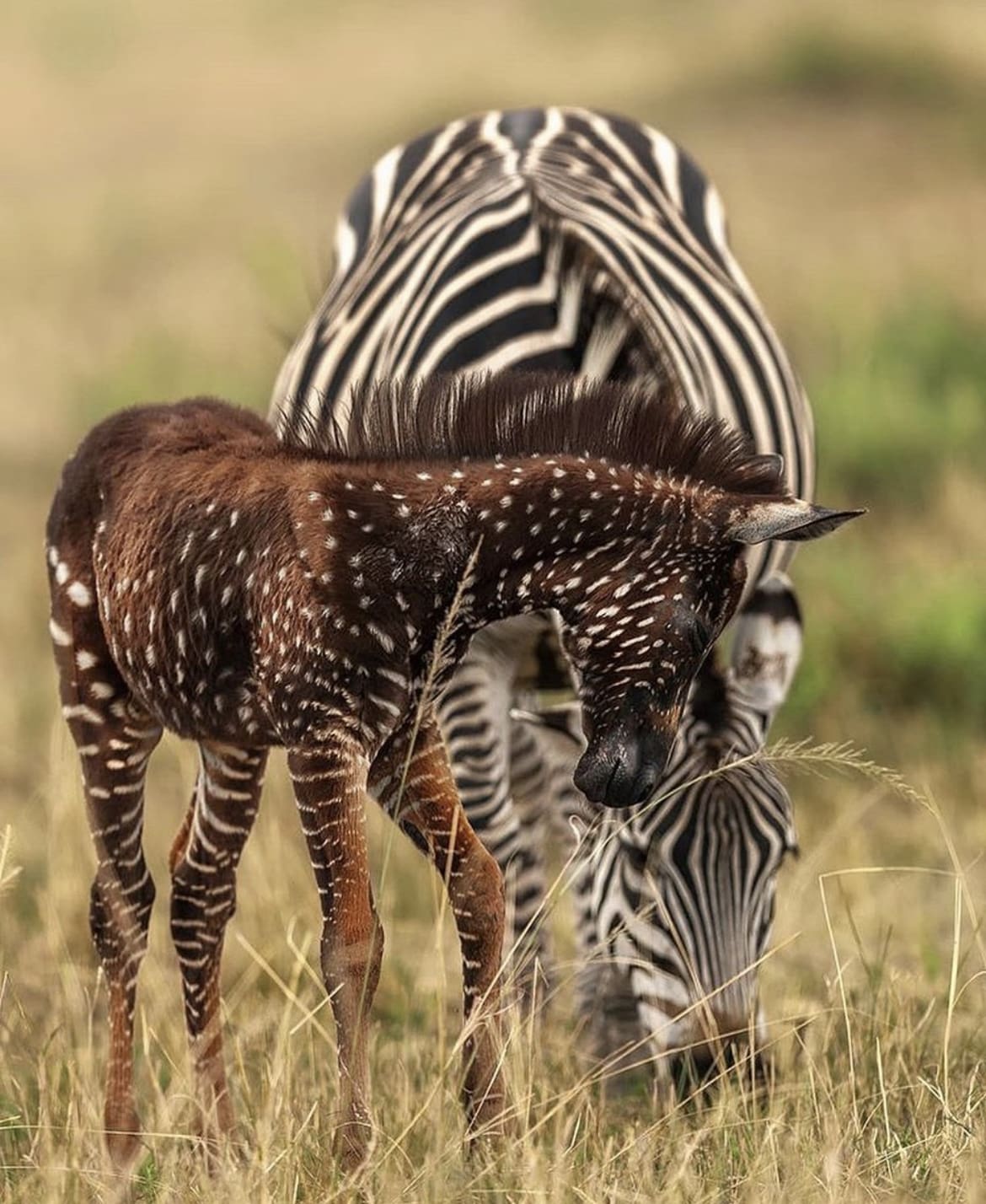
Who is Tira?
Tira isn't your everyday zebra; Tira is a trendsetter in the animal kingdom. Spotted - quite literally - on the sprawling plains of the Maasai Mara, Tira's unique polka-dotted coat has made it a celebrity among wildlife enthusiasts. But who exactly is Tira, and how did this speckled superstar come to be?
Tira was first discovered by a Maasai tour guide, who named the zebra after his surname. When word got out about a polka-dotted zebra, it spread faster than a wildfire in the savannah. Tourists, researchers, and photographers flocked to the Mara, hoping to catch a glimpse of this extraordinary animal.
Unlike the typical zebra’s black-and-white stripe pattern, Tira sports a series of irregular, polka-dot-like spots. This pattern isn’t just unusual – it’s incredibly rare. Zebras, as we know, are defined by their stripes, each pattern as unique as a human fingerprint. But Tira’s spots? They’re in a league of their own, making this zebra an instant icon.
So, what’s the story behind those spots? It all comes down to genetics. Zebras have complex stripe patterns influenced by a variety of genetic factors. Tira’s polka-dots are likely the result of a genetic mutation, something that makes this zebra even more special. This kind of mutation is a natural reminder of the incredible diversity of life on our planet.
Tira’s unique appearance isn’t just a visual delight; it’s a gateway to understanding more about zebra genetics and how these beautiful creatures adapt to their environments. It sparks curiosity and wonder, encouraging us to delve deeper into the mysteries of nature.
The Science Behind the Spots
Zebras are typically known for their striking black-and-white stripes, a pattern that serves as both camouflage and a social signal among the herd. Each zebra’s stripe pattern is unique, much like human fingerprints, providing individual identity in the vast savannah. However, Tira’s polka-dotted pattern is a fascinating departure from the norm.
Tira’s spots are the result of a genetic mutation, a naturally occurring phenomenon that can sometimes lead to unique and unexpected traits. This specific mutation likely affects the way melanin, the pigment responsible for coloration in animals, is distributed during Tira’s development. Instead of forming the usual striped pattern, Tira’s melanin cells clumped together in spots, creating a look that’s more akin to polka dots than stripes.
This genetic anomaly is known as pseudomelanism, a condition where the typical stripe pattern of a zebra is altered, resulting in a variety of unique markings. While pseudomelanism is rare, it’s not entirely unheard of in zebras. However, Tira’s pattern is particularly distinctive and has captivated the attention of both scientists and the public alike.
Comparing Tira’s dots to the traditional stripes of zebras reveals just how unique this pattern is. Stripes serve several purposes for zebras: they help with camouflage by breaking up the outline of the body, confuse predators, and even play a role in social interactions within the herd. Tira’s spots, on the other hand, challenge our understanding of these functions. Scientists are keen to study whether Tira’s unique pattern offers any distinct advantages or disadvantages in the wild.
The curiosity sparked by Tira’s appearance goes beyond just visual appeal. It opens up questions about how such mutations occur and their implications for the species. Could Tira’s spots be a one-off anomaly, or do they hint at a broader spectrum of genetic diversity within zebra populations? These questions make Tira not just a marvel to look at but also a valuable subject for scientific research.
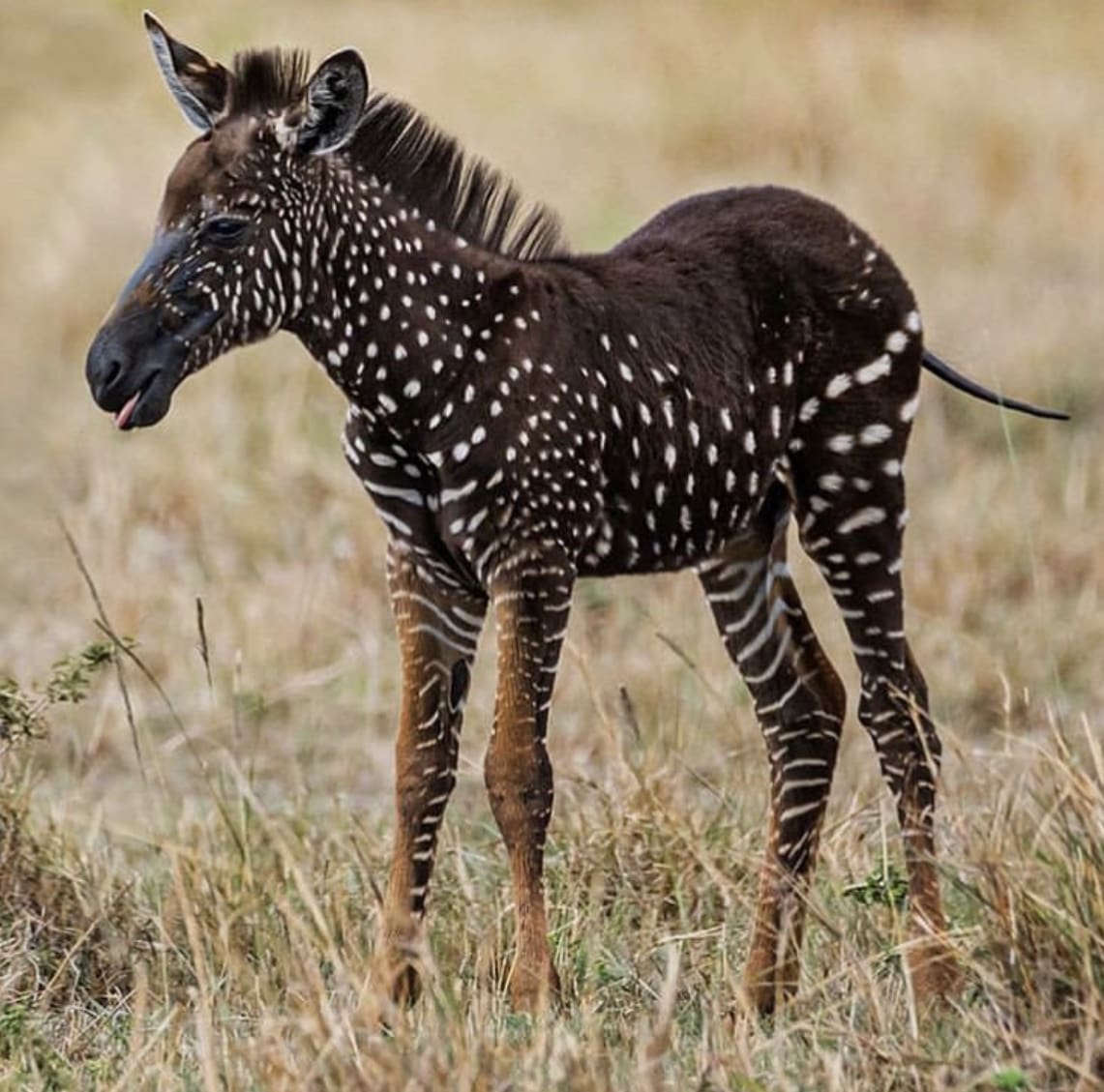
The Maasai Mara – Tira’s Home
If you’re planning to catch a glimpse of Tira and her fellow zebras, there’s no better place to start than this stunning African landscape.
The Maasai Mara , located in southwestern Kenya , is a vast expanse of rolling grasslands, acacia trees, and riverine forests. It’s a haven for wildlife, boasting one of the highest concentrations of large mammals in the world. From the thunderous migration of wildebeests to the stealthy prowls of big cats, the Mara is a living, breathing tapestry of life that offers something new and exciting at every turn.
Tira has made a splash in this vibrant ecosystem, but the Maasai Mara itself is worth the trip. This reserve is part of the larger Serengeti-Mara ecosystem, which spans across the Kenya-Tanzania border. It’s renowned for the Great Migration, where millions of wildebeests, zebras, and other herbivores journey in a circular route in search of fresh grazing. This spectacle, often referred to as “The World Cup of Wildlife,” is one of nature’s most dramatic events.
But beyond the migration, the Maasai Mara is home to a diverse range of wildlife. Lions , cheetahs , elephants , and giraffes roam the plains, while hippos and crocodiles lurk in the Mara River. Bird enthusiasts will be thrilled by the sight of over 450 bird species, from colorful lilac-breasted rollers to majestic raptors.
Travel Tips for Visiting the Maasai Mara:
- Best Times to Visit : While the Maasai Mara is a year-round destination, the best time to visit is during the dry season, from June to October. This period coincides with the Great Migration, offering spectacular wildlife viewing opportunities.
- Getting There : The Maasai Mara is accessible via several airstrips serviced by local airlines, with flights departing from Nairobi. Alternatively, you can embark on a road trip from Nairobi, which takes about 5-6 hours, giving you a chance to soak in the scenic Kenyan countryside.
- Where to Stay : Accommodations in the Maasai Mara range from luxury lodges to tented camps. Whether you prefer a plush safari lodge or an authentic tented camp experience, there’s something to suit every taste and budget.
- What to Pack : Bring lightweight clothing, a good pair of binoculars, a camera with a zoom lens, and plenty of sunscreen. Don’t forget your sense of adventure!
One of the magical aspects of the Maasai Mara is its ability to surprise and delight. You might set out on a game drive with the goal of seeing Tira, only to find yourself captivated by a lioness and her cubs, a towering giraffe nibbling on acacia leaves, or a herd of elephants making their way to the river. Each moment in the Mara is a reminder of the rich and intricate web of life that thrives in this extraordinary landscape.
For those eager to spot Tira, the best strategy is to join a guided safari tour. Experienced guides know the terrain intimately and can increase your chances of encountering not only Tira but also other remarkable wildlife. And remember, the joy of a safari lies in the unexpected – sometimes the most memorable encounters are the ones you least anticipate.
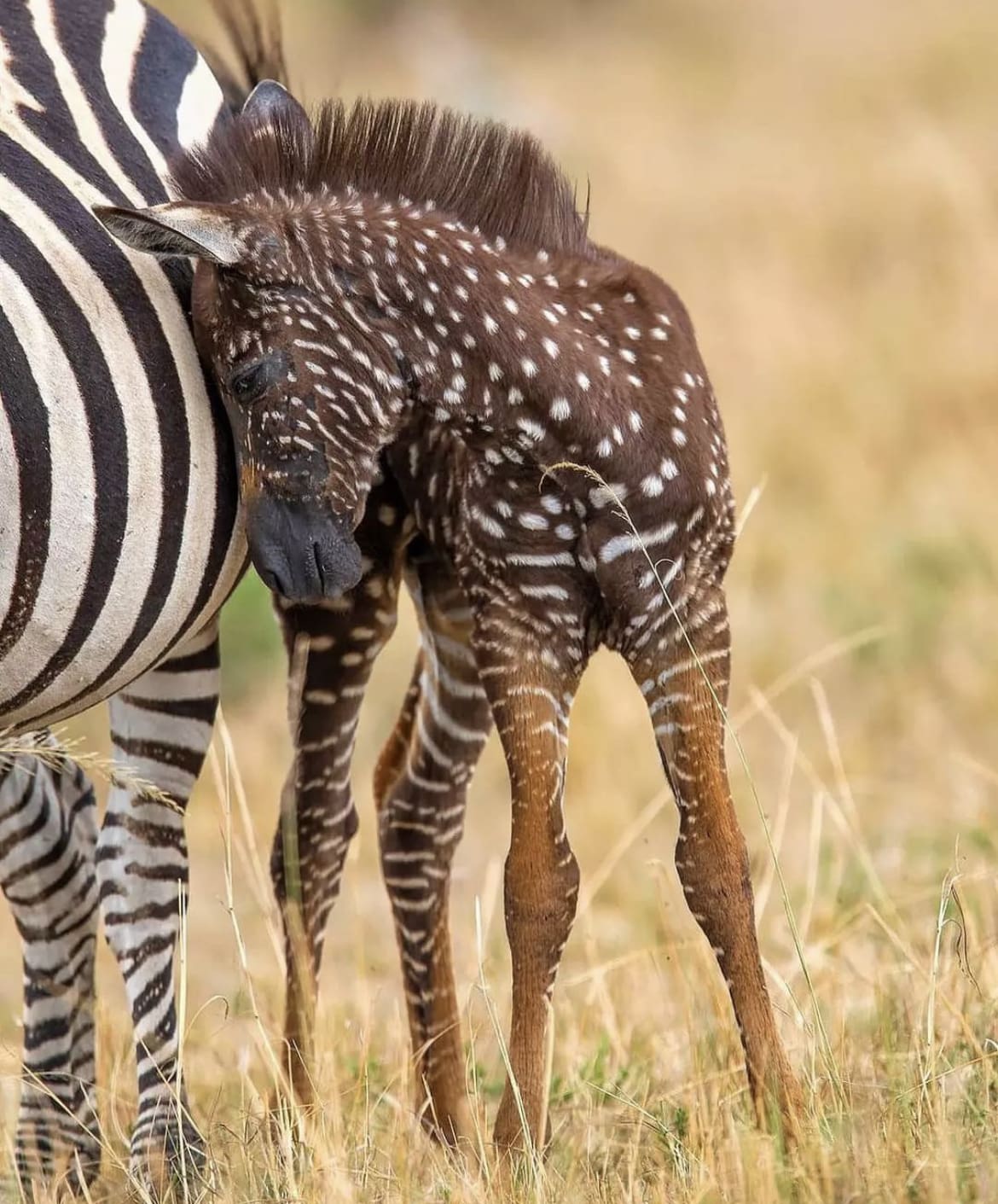
Conservation Efforts
The magic of the Maasai Mara and the wonder of seeing a polka-dotted zebra like Tira come with a crucial responsibility: conservation. Protecting the incredible diversity of wildlife in Kenya is essential, not just for preserving the unique spectacle of Tira but for maintaining the entire ecosystem's health and balance.
The Maasai Mara is more than just a playground for safari-goers; it's a vital sanctuary for countless species. The delicate balance of this ecosystem hinges on careful conservation efforts. From the sprawling savannahs to the meandering rivers, every part of the Mara plays a role in sustaining the wildlife that calls it home.
Tira’s unusual appearance has done more than just capture the attention of tourists and wildlife enthusiasts; it has shone a spotlight on the importance of genetic diversity and conservation. Animals like Tira help raise awareness about the need to protect wildlife habitats and the species that depend on them.
Wildlife conservation in the Maasai Mara faces numerous challenges, from habitat loss due to agricultural expansion to human-wildlife conflict and the threat of poaching. To combat these issues, various organizations and local communities are working tirelessly to ensure that the Mara remains a safe haven for its inhabitants.
Key Conservation Efforts in the Maasai Mara :
- Anti-Poaching Initiatives : Poaching remains a significant threat to wildlife in Kenya. Anti-poaching units, often working in collaboration with local communities and international organizations, patrol the reserve to protect animals from illegal hunting. These efforts are crucial in safeguarding species like elephants, rhinos, and even zebras.
- Community-Based Conservation : Local communities play a vital role in conservation. Many conservation programs involve the Maasai people, who have lived in harmony with the wildlife for generations. By integrating traditional knowledge and practices with modern conservation techniques, these programs promote sustainable coexistence.
- Habitat Restoration : Protecting and restoring habitats is essential for maintaining biodiversity. Efforts to reforest areas, protect water sources, and manage grasslands help ensure that wildlife has the resources it needs to thrive.
- Research and Monitoring : Continuous research and monitoring are vital for understanding the dynamics of the ecosystem and the needs of its inhabitants. Studies on animal behavior, genetics, and environmental changes provide valuable data that informs conservation strategies.
- Eco-Tourism : Sustainable tourism practices are key to conservation. By promoting eco-tourism, the Maasai Mara generates revenue that supports conservation efforts while minimizing the environmental impact. Responsible tourism ensures that future generations can enjoy the wonders of the Mara.
Tira’s unique appearance has brought a renewed focus on the importance of protecting genetic diversity. Genetic variations, like Tira’s polka-dots, are essential for the resilience and adaptability of species. They help populations survive changes in their environment and can even lead to the emergence of new traits that may offer survival advantages.
Seeing Tira in the wild is a powerful reminder of the beauty and fragility of our natural world. It underscores the need for continued conservation efforts to protect not only the iconic animals of the Maasai Mara but also the entire ecosystem they depend on.
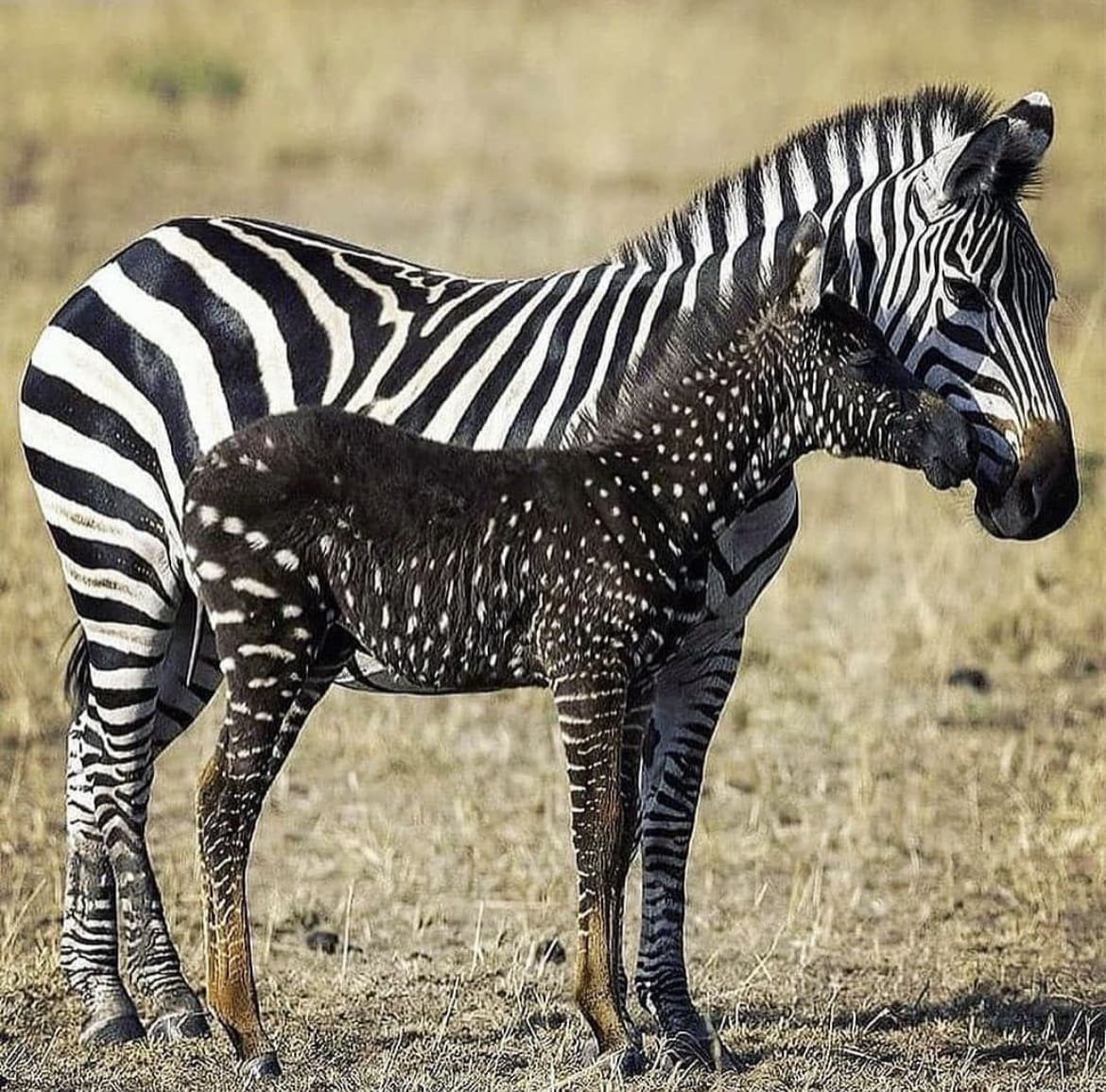
Practical Tips for Safari Goers
So, you’re pumped and ready to see Tira, the polka-dotted zebra, in the wild. But before you jet off on this once-in-a-lifetime adventure, let’s arm you with some practical tips to make your safari experience as epic as possible.
Safari Tips for Spotting Tira and Other Wildlife :
- Join a Guided Safari Tour : Your best bet for seeing Tira and other wildlife is to go with a knowledgeable guide. Local guides have the inside scoop on the best spots and times to catch a glimpse of the animals. They know the terrain like the back of their hand and can increase your chances of a successful sighting.
- Optimal Viewing Times : Wildlife is most active during the early morning and late afternoon. These cooler parts of the day are prime times for game drives. Plus, the lighting is perfect for those Instagram-worthy shots!
- Be Patient and Observant : The beauty of a safari lies in the unexpected. Keep your eyes peeled, and be patient. Sometimes, the most extraordinary moments happen when you least expect them.
- Stay Silent and Respectful : Animals are more likely to approach if they don’t feel threatened. Keep noise to a minimum and respect the wildlife by maintaining a safe distance.
Packing Essentials for Your Safari :
- Clothing : Light, breathable clothing is key. Opt for neutral colors like khaki, beige, and olive to blend in with the environment. Don’t forget a wide-brimmed hat and sunglasses to protect yourself from the sun.
- Footwear : Comfortable, sturdy shoes are a must. You’ll be doing a fair bit of walking, so make sure your footwear is up to the task.
- Binoculars : A good pair of binoculars can make all the difference. Spotting wildlife at a distance is much easier with a quality pair.
- Camera Gear : Bring a camera with a zoom lens to capture those stunning close-ups. Extra memory cards and batteries are also essential – you don’t want to miss a single shot.
- Sun Protection : Sunscreen, lip balm, and insect repellent are crucial. The African sun can be harsh, and bugs are plentiful.
- Hydration and Snacks : Staying hydrated is vital, especially in the heat. Pack a reusable water bottle and some snacks to keep your energy up.
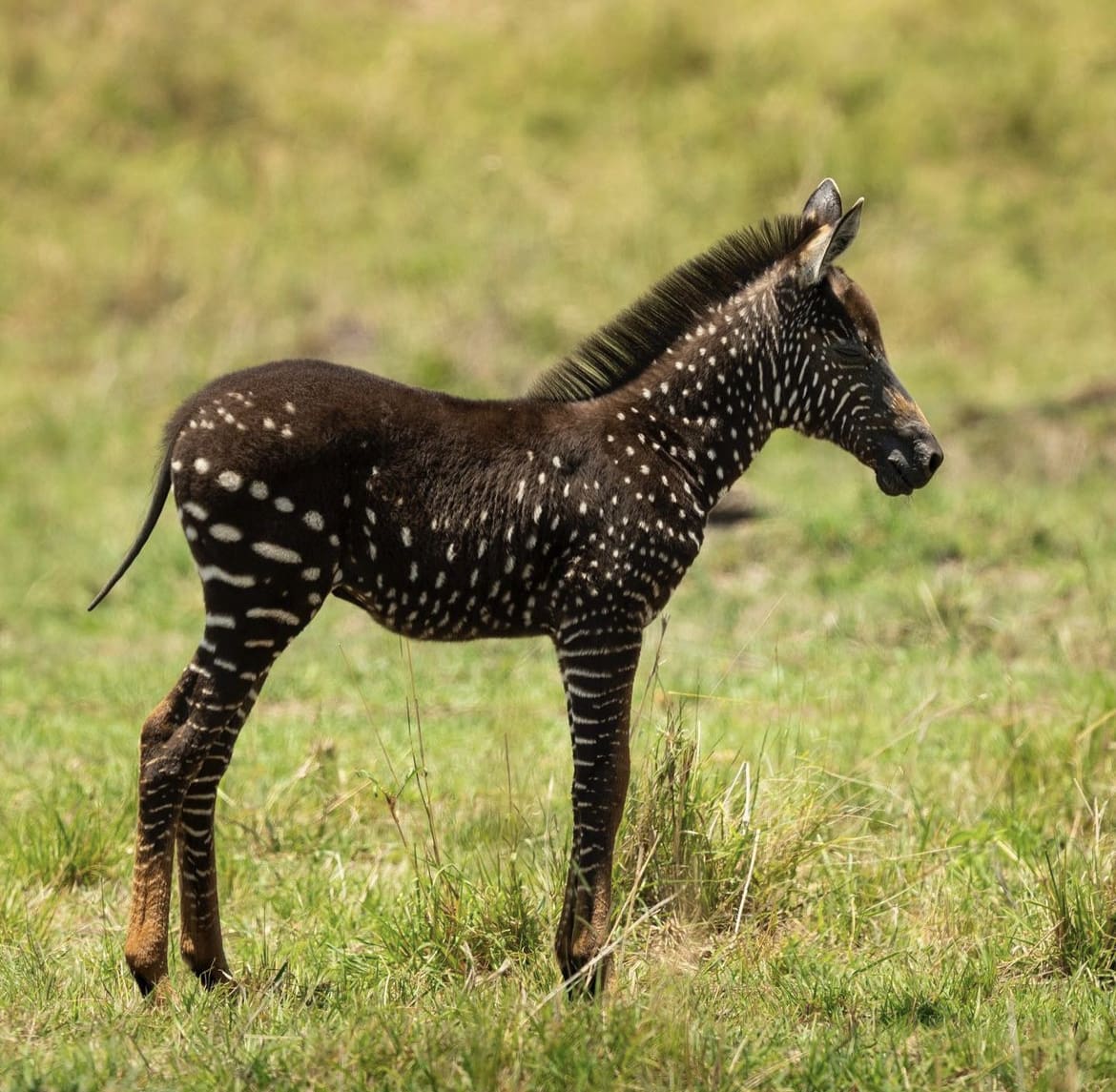
As your journey through the captivating world of the Maasai Mara comes to a close, it’s time to reflect on the unique charm of Tira and the broader significance of such encounters. Zebras are often seen as the quintessential symbols of the African plains, but Tira’s polka-dots add a whole new layer of wonder to these iconic creatures. Beyond the visual spectacle, Tira’s story is a reminder of the diversity and adaptability of wildlife – traits that are worth celebrating and protecting.
The first time you see Tira, it’s impossible not to be struck by the beauty of nature’s randomness. There’s something incredibly special about witnessing a creature that defies expectations. Tira’s spots aren’t just a genetic fluke; they’re a testament to the endless variations that nature can produce. It’s this unpredictability that makes wildlife watching so thrilling.
One of the most memorable moments on safari might be seeing Tira grazing peacefully, seemingly unaware of the stir caused by those unique spots. It’s a humbling experience, reminding us of the importance of protecting these natural wonders.
The Maasai Mara is teeming with life, and there’s no shortage of unique animals and experiences to discover. Here are a few recommendations to enhance your safari adventure:
- The Big Five : While Tira is a standout, don’t miss the opportunity to see the Big Five – lions, leopards, rhinoceroses, elephants, and Cape buffaloes. Each encounter with these majestic animals offers its own dose of excitement and awe.
- The Great Migration : If your timing aligns, witnessing the Great Migration is an experience like no other. The sheer volume of animals moving across the plains is a sight to behold and a highlight of any safari.
- Balloon Safari : For a different perspective, consider a hot air balloon safari. Floating over the Mara at dawn, you’ll get a bird’s-eye view of the landscape and its inhabitants, providing a unique and serene experience.
- Cultural Encounters : Engage with the local Maasai communities. Their rich culture and traditions add depth to your understanding of the region. Many lodges offer visits to Maasai villages where you can learn about their way of life and how they coexist with wildlife.
- Night Safaris : Experience the Mara after dark on a night safari. This is your chance to see nocturnal animals in action, adding another layer of excitement to your adventure.

May 29, 2024
Bravery and the Beast: Lions Battling the Raging Rongai
Ever wondered what happens when the king of the jungle faces the untamed fury of nature? Picture this: the mighty lions , symbols of strength and dominance, brought to their knees—or rather, their paws—by the relentless force of a river. This is no ordinary tale but a dramatic encounter set in the wild heart of Africa, in the breathtaking Masai Mara National Reserve.
On an unusually stormy day, the skies opened up and the Rongai River swelled, transforming into a furious torrent. Three male lions from the Sonkai Tribe found themselves staring down this liquid monster. Normally, these apex predators command respect and fear, but today, they were merely anxious beings, pacing the riverbank with trepidation.
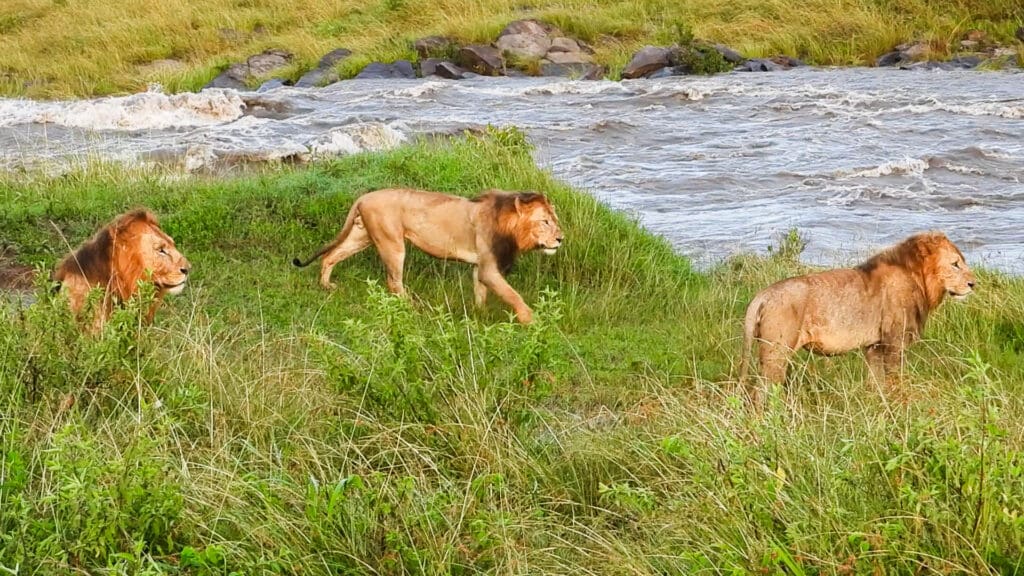
Richard Mututua, a seasoned game ranger, stood nearby with a group of tourists. Cameras ready, hearts pounding, they witnessed a scene straight out of a wildlife documentary. The lions needed to cross, but the river, typically a docile stream, had turned into a roaring beast, daring them to test its power.
With a mix of hesitation and resolve, the lions decided to face the challenge head-on. The first lion plunged into the frothy chaos, muscles rippling as he fought against the current. For a moment, it looked like he might make it, but the river had other plans. It seized him, dragging him downstream like a ragdoll. The second lion followed, perhaps thinking he could fare better. He was wrong.
African lions are not natural swimmers. Unlike tigers, who take to water with ease, lions avoid it whenever possible. Their powerful bodies are built for land—stalking, pouncing, and conquering the savannah. In water, they are out of their element, their strength turned into a desperate struggle for survival.
The third lion hesitated, a smart move as it turned out. Watching his companions get swept away, he clung to the safety of the shore. The tourists and Mututua could only watch, breath held, as the drama unfolded. The first lion, a true testament to resilience, managed to find a rock midstream. Clawing his way to safety, he hauled himself up, a wet and weary survivor on the far bank.
Then came a collective gasp of relief. Further downstream, the second lion emerged from the current, bedraggled but alive. He had been pushed much farther than his brother, yet he too had survived the river’s wrath. They looked back, offering a silent message to their hesitant brother: stay put.
The Rongai River, like many rivers in the region, can be deceptive. During the dry season, it’s a lifeline, providing water to the ecosystem. But in the rainy season, it becomes a force of destruction, reshaping the landscape and reminding every creature, big or small, of nature’s unpredictable power.
As the sun began to set, painting the sky in hues of orange and pink, the lions reunited on safer ground. Wet, tired, but alive, they embodied the spirit of resilience. Their encounter with the river was a stark reminder that even the mightiest can be humbled by nature. For the tourists, it was a tale they would carry home, a story of bravery, survival, and the raw, untamed beauty of the African wilderness.
Watch the full video here:
Watch More:
WATCH: A Lioness Is Reunited With Her Lost Cubs
Watch: crocodile takes on 5 different elephants in the zambezi.
- WATCH: Mother Leopard Teaches Her Cubs How To Hunt
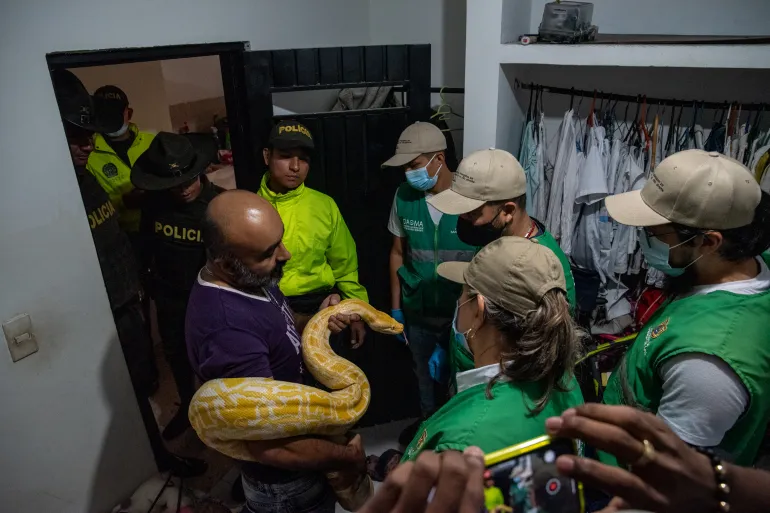
Meet The People Hunting Wildlife Traffickers Like Drug Smugglers
Conservation
Between Narcos and Nature: Colombia’s Battle Against Wildlife Trafficking
In the shadow of drug cartels and the violent images often associated with Colombia, a quieter yet equally sinister trade thrives—wildlife trafficking. The story often untold, emerges from the lush landscapes and biodiversity of Colombia, painting a picture not of narcotics but of natural treasures being plundered at alarming rates.
On a brisk morning in January 2023, the tranquil city of Cali became the frontline of this battle. A specialized task force, distinct from drug interdiction units, orchestrated a raid on a nondescript house. Their mission was to recover illicit treasures, not of gold or drugs, but living jewels—a massive yellow-spotted python and two vulnerable taricaya turtles, hidden away as part of a booming black market.
The operation highlighted the workings of a unique police unit, one that diverges from the typical narratives of Colombia's law enforcement. Created four years ago, this unit is an emblem of a shifting focus within Colombian policy, from the war against drugs to a battle for biodiversity.
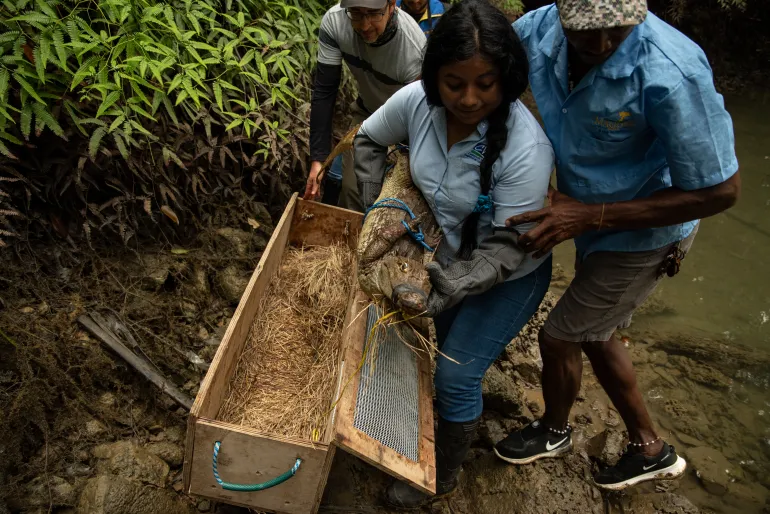
The War on Nature's Plunderers
Colombia's biological wealth is staggering; it is one of the most biodiverse countries globally. However, this richness also marks it as a hotspot for wildlife trafficking, a lucrative criminal enterprise generating an estimated $23 billion annually. Silvia Vejarano, a biologist with the World Wildlife Fund, notes the dire consequences: "Removing even a few individuals of an endemic species could drive it to extinction, and even non-endemic species play crucial roles in maintaining ecological balances."
In response, Colombia has trained around 100 officers specializing in wildlife crimes. These officers navigate the complex web of illicit trade that, much like drug trafficking, utilizes sophisticated networks and often overlaps with the routes and methods of narcotic smugglers. Despite the commonalities, wildlife traffickers typically attract less attention, exploiting the shadow cast by drug wars to move their goods from remote areas to urban centers, often ending up in international markets.
Online Markets and Undercover Operations
The digital age has transformed wildlife trafficking. Once an overt activity along roadsides and local markets, it has now receded into the depths of the internet. Traffickers use social media platforms like Facebook, WhatsApp, and Instagram to reach a global clientele. Catalina Ocampo-Carvajal, a biologist and advocate, illustrates this shift, explaining how exotic animals are now just a mouse click away from being sold. The allure of these animals often stems from their status symbol, adding a layer of social prestige for their owners.
To combat this, law enforcement officials have adopted undercover tactics similar to those used in narcotics stings. By posing as potential buyers, they infiltrate trafficking networks, a strategy that led to the significant raid in January.
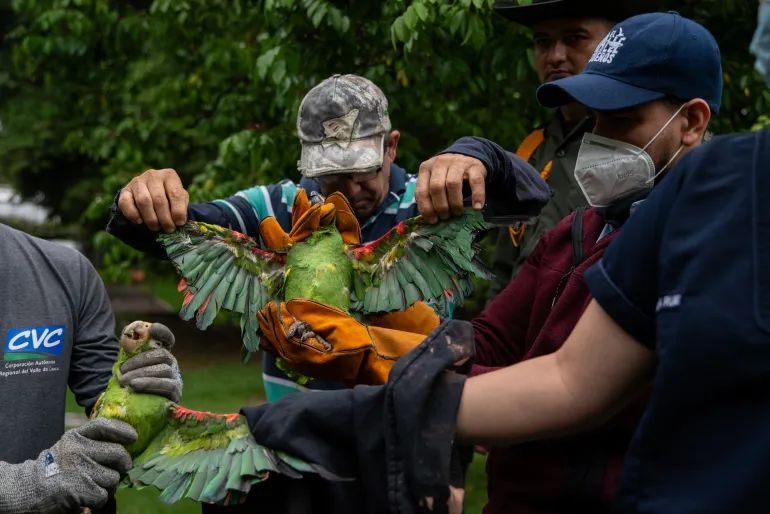
In 2021, Colombian legislation set stern penalties for wildlife trafficking, ranging from five to over eleven years in prison. Yet, enforcement and judicial outcomes often tell a different story, with many suspects released pending trial and few facing substantial sentences. Meanwhile, the animals suffer immensely, with an estimated 50 to 80 percent perishing during transit due to harsh conditions.
Despite the grim statistics, there are glimmers of hope. The python and turtles rescued in Cali represent small victories. The python now resides in a zoo, likely destined to spend its life in captivity—a bittersweet outcome, but a life spared. The turtles, however, were returned to their natural habitat, a significant win for conservation efforts.

As Cristian Mesa, head of the environmental crimes unit, puts it, "Every animal has a role in nature." This sentiment drives their mission, reflecting a broader commitment to not just enforcing the law but fostering a deeper respect and understanding of Colombia's natural heritage.
Colombia's pivot to prioritizing biodiversity over mere drug enforcement is a notable shift in a country plagued by environmental challenges. It is a testament to a growing recognition that preserving ecological wealth is as crucial as curbing narcotics trafficking, not just for Colombia but for the world. The stakes are high, and the outcomes of this battle are uncertain, but the dedication of Colombia’s wildlife investigators offers a hopeful glimpse into a future where natural treasures are valued and protected.
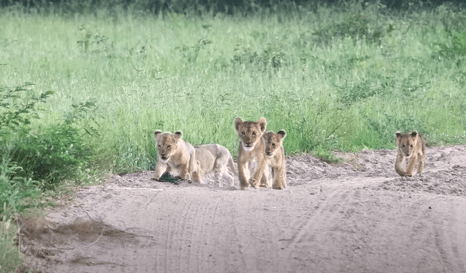
May 17, 2024
Tender Moments in the Wild: The Lioness's Reunion with Her Cubs in MalaMala
In the serene expanses of the African wilderness, every day unfolds like a page from an epic saga, where the drama of life and survival plays out beneath the vast, unending skies.
But sometimes, the narrative shifts from the harsh struggles for survival to moments of profound tenderness and familial bonding. Such was the scene recently in the Kambula region of MalaMala Game Reserve, where a lioness's reunion with her six cubs became a poignant spectacle for a group of lucky safari-goers.
The journey into this intimate glimpse of wild family life began with a subtle yet unmistakable sign: the suckle marks on a lioness's belly. These marks, evident to the trained eyes of the rangers and guides at MalaMala, revealed that she was not just any lioness but a mother, intensely devoted to the newest additions to her pride.
The anticipation built among the wildlife enthusiasts, each hoping to catch a rare glimpse of the young cubs, usually kept hidden from the dangers of the wild and the prying eyes of tourists.
Their patience was rewarded one crisp morning when the lioness was spotted traversing the landscape. Her belly was full, and her movements were purposeful; but interestingly, her focus was not on the hunt.
Read Next: What do Lions Eat?
The journey to reunion.
Ignoring the potential meal provided by a nearby herd of wildebeest, the lioness began emitting low-frequency contact calls. This behavior drew the immediate attention of the safari group. Their experienced guide surmised that if they followed her, they might witness something truly extraordinary.
With the lioness leading, they ventured from the open plains into the denser bush, where visibility was compromised by thick foliage. Her pace quickened, a hint of nervousness in her demeanor perhaps due to the proximity of larger game near her hidden offspring. As anticipation turned to anxiety among the onlookers, the guide’s trained eye caught a flicker of movement in the tall grass.
Suddenly, the first of the cubs emerged, barely discernible amidst the grass. Then, one by one, more little figures appeared until six adorable cubs were in sight. These tiny lions, brimming with youthful energy, bounded towards their mother, their actions seemingly shouting, "Here we are, Mom!"
Settling beside the road, the lioness waited patiently as her cubs, overflowing with excitement, leaped and frolicked around her, eager for the nourishment and affection only she could provide. As they reached her, they clamored for milk, their actions reminiscent of playful kittens, complete with purrs and wagging tails.
This tender moment, unfazed by the onlookers, encapsulated the essence of the wild - a mother's unconditional love for her offspring, a scene as moving as it is mesmerizing.
- WATCH: The Miracle Of Giraffe Birth In Kruger National Park
Reflections on the Wild
This encounter is not just a heartwarming story but also a powerful reminder of the resilience and beauty of life in the wilderness. It highlights the delicate balance of survival and the deep bonds that form within animal families, often mirroring the familial ties that humans cherish.
For those fortunate enough to witness such moments, they serve as a profound reminder of the interconnectedness of all living beings and the pure, unspoken love that crosses the boundaries of species.
In a world where the wild is often associated with ferocity and survival of the fittest, instances like these illuminate the other side of the coin—the gentle, nurturing nature that is equally a part of the animal kingdom.
It's a narrative that deserves to be told, retold, and remembered, not just for its rarity and beauty but for the light it shines on the often unseen aspects of the natural world.
Watch The Full Video Here:
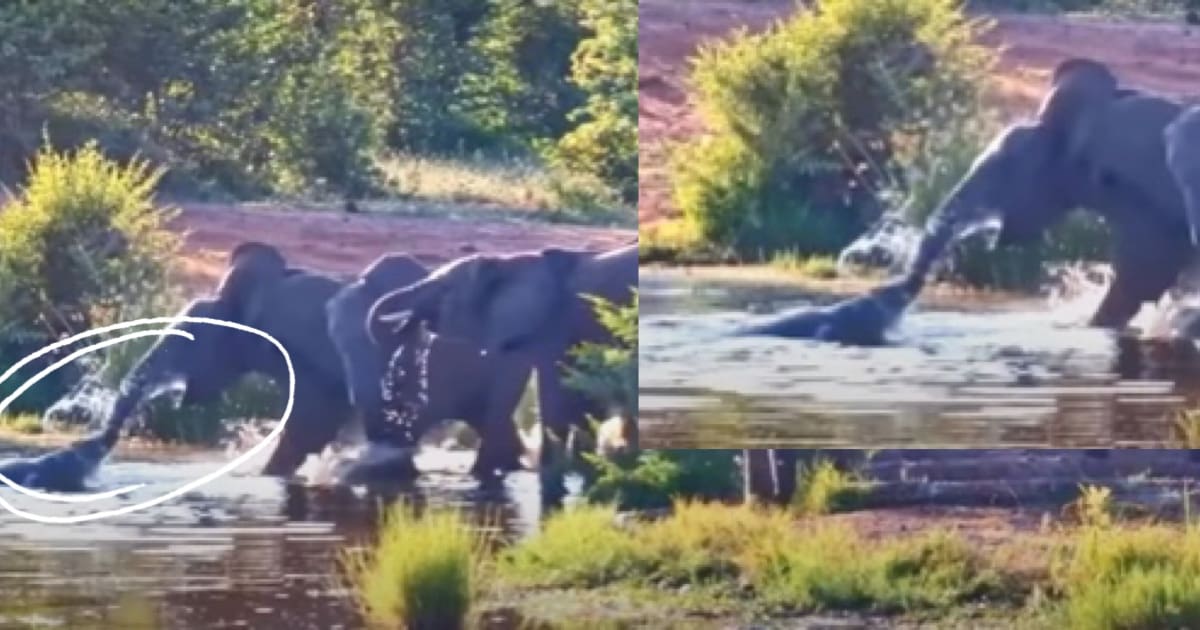
May 15, 2024
David vs Goliath In Africa: A Crocodile’s Bold Confrontation with Elephants at Victoria Falls
In an unusual wildlife spectacle near Victoria Falls Safari Lodge, a crocodile made headlines by audaciously challenging a herd of five elephants at a popular watering hole.
This incident, captured through Latest Sightings Africam's live footage at a dam overlooking the Zambezi National Park , presents a striking case of nature’s unpredictability and the survival instincts of its inhabitants.
Elephants, often referred to as "gentle giants," typically consume up to 200 liters of water daily, a necessity that brings them frequently to the dam. Here, they encountered a resident crocodile, setting the stage for an extraordinary clash of species.
The crocodile, significantly smaller than any of the elephants, repeatedly approached the herd. This recurrent bravado sparks curiosity: What drives a crocodile to engage opponents so vastly superior in size?
Read Next: Get To Know The Nile Crocodile
The dramatic interaction reached its climax one morning when the crocodile, adopting full stealth mode, targeted an elephant drinking nearby. As the elephant lowered its trunk for another sip, the crocodile struck, clamping its jaws onto the elephant’s trunk.
The elephant’s immediate, pain-filled trumpet alerted the herd, yet the crocodile maintained its grip, only releasing after being violently shaken off. This encounter not only highlights the crocodile’s boldness but also underscores the elephants' communal responses to threats.
Analyzing the crocodile’s behavior, it seems a mix of territorial instinct and perhaps desperation influenced by the elephants' heavy water consumption, which could threaten the crocodile’s habitat.
Dr. Angela Mwenda, a wildlife biologist, suggests that:
"such interactions are rare but showcase the intense competition for resources that can occur in wildlife habitats, particularly around water sources which are vital for survival."
This event raises several questions about the dynamics at water holes, where multiple species converge and compete. Such incidents provide valuable insights into animal behavior, particularly how different species assert dominance and access to resources. The footage from this event is not just a rare glimpse into the harsh realities of nature but also a reminder of the precarious balance of ecosystems.
Further analysis could explore how frequently such interactions occur and what specific conditions prompt them. Conservationists might investigate whether changes in the environment, such as reductions in water levels, are leading to more frequent and severe interactions between species.
- WATCH: Lions Attack Crocodile In South Africa
Privacy Preference Center
Privacy preferences.

Uganda Safari Animals: In the Realm of the Big Game

by Editorial Friendly Gorillas
Aug 4, 2023, comments (0).
Deep into the heart of the awe-inspiring African savannah lies a wonderland of untamed beauty and biodiversity, a place where nature’s spectacle uniquely unfolds with each sunrise – Uganda, a wildlife haven like no other.
Trekking deep into this wonderland’s untamed savannah, you are immersed in a vibrant tapestry of colours and sounds of the wild. Encounter the majestic Big Five which include Lions, leopards, elephants, Buffaloes and Rhinoceros as they traverse the vast landscapes.
While towering giraffes swiftly reach out for the highest leaves on the acacia trees with their skin tone glowing in the morning light as they guide their families in search for water and pasture.
And at the water’s edge, the atmosphere is concentrated with the grunts and roars of hippos as they laze in the calm cooling waters, as well as the Nile crocodiles lazily lurk on the lakeshores, simply waiting for an opportune moment so as to strike.
Encounter different bird species as they draw an epic picture while they take to the air in a harmonised ballet of wings. Beyond the vast savannah landscapes, the Pearl of Africa’s wilderness extends to the lush rainforests and mist-covered mountains as well.
Where, endangered primate species such as the chimpanzees swing swiftly from branch to branch with their loud calls echoing through the towering forest canopies.
Encounter the Silverback gorillas as they reign over their families while showcasing both strength and gentleness in their interactions.
What are the Big Five Animals?
The term “ Big Five ” is attributed to the hunters of old whereby they used this term to describe what they determined were the most dangerous animals to hunt in Africa. And all these animals are “ formidable foes ” (meaning opponents who are very powerful, capable, and difficult to defeat) indeed when being hunted by man.
Lions also known as “ King of the Jungle ” are so unique with exceptional hunting and tree – climbing skills which is rare in the lion population all over the world. Destinations to witness the tree-climbing lions in Africa include Queen Elizabeth in Uganda.
These apex predators are known for their powerful jaws which they use to suffocate prey and their skin texture that help them blend in the lush savanna grasslands making them difficult to easily notice by prey and opponents.
Leopards are good tree-climbing mammals which they use as a strategy to easily sight their prey and also run from potential threats and danger. These apex predators also use their tree-climbing skills to hide their kills from scavengers like the hyenas.
Buffaloes, also known as Cape buffaloes, scientifically referred to as “Syncerus caffer”, are iconic and robust bovine mammals found across sub-Saharan Africa. African buffaloes are one of the largest and powerful animals, with mature bulls weighing up to 900 kg while around 1.7 meters tall.
Buffaloes are naturally social animals and form herds of various sizes, from a few individuals to numerous hundreds. African buffaloes are famously known for their unpredictable and aggressive nature, most especially when threatened.
They have a reputation as responsible for most deaths of people in Africa and they have reportedly been known to ambush and attack humans.
The African bush elephant and African forest elephant are the largest land animals in the whole world with males reaching heights of over 13 feet while weighing over 14,000 pounds.
These mammals exhibit remarkable social behaviour by forming complex family units led by a female elephant known as a “matriarch”.
African elephants are typically herbivores and they feed on lush vegetation, including grass, leaves, bark, and fruits.
Rhinos are normally solitary mammals, with a poor eyesight but excellent senses of smell and hearing.
African rhinos are generally herbivores feeding on grasses, leaves, and fruits. While in the wild, rhinos can live up to 50 years, while some individuals in captivity have lived for over 60 years.
Rhinos are significant cultural symbols in Africa, representing strength, resilience, and natural heritage.
What are the Endangered Primate Species?
Mountain gorillas.
The estimated total population of Mountain Gorillas is over 1,000 individuals are left in the whole world, making them one of the most critically endangered species on the planet.
Gorillas live in cohesive and close-knit groups refered to as troops or families whereby each troop is led by a dominant male, called a silverback which is named after its silver-gray hair that develops on back as they mature.
Mountain Gorillas are herbivorous, and their diet consists of leaves, stems, fruits, and shoots. They are well known for their peaceful and gentle nature, whereby they rarely show aggression unless threatened or provoked.
Gorillas communicate through various vocalizations, such as body gestures, and facial expressions.
Chimpanzees
A chimpanzee is a black-coated ape and is considered to be very intelligent. Chimps are closely related to humans and surprisingly sharing a 98.8% of their DNA.
They have been habituated in Budongo, Kibale Forest National, and the Kyambura Gorge in Queen Elizabeth National Park. You can track chimps all year long.
Vervet monkeys
Vervet monkeys have a black face with very distinctive blue male genitals. These are found in many regions all over Uganda.
Black-and-white colobus monkeys
Black-and-white colobus monkeys are black with a white face, whitetail, long white hair running from the shoulders to rump, and white tufts at their long tails’ ends. Infants are born pure white.
Baboons are large with a dog-like face and are found on roadsides, countryside, parks, they also inhabit the montane regions of Mgahinga Gorillas Park , Rwenzori Mountains , and Mount Elgon.
L’hoest’s monkey
L’hoest’s monkey has a black face with backward projecting white whiskers partially covering its ears and carries its tail in an upright position.
They are very hard to see because it prefers very dense forests. It is found in the Maramagambo forest, Kibale forest, Bwindi Forest, and Queen Elizabeth National Park.
The red-tailed monkey
The red-tailed monkey has a brownish colour, white whiskers, and a coppery tail with a heart-shaped patch on the nose. They are found in Kibale forest, Bwindi Forest, Mpanga, and Budongo forest reserves, and Semliki and Queen Elizabeth national parks.
Red colobus Monkeys
Red colobus has a slightly tufted crown. You can see it in Kibale Forest National Park , especially around Bigodi Wetland sanctuary and a few of them in Semliki National Park.
Patas monkey
Patas monkey has a lankier build, a light reddish-brown coat, and a black stripe above the eyes but could easily be confused with Vervet monkey. They are found in the dry savannah in Kidepo and Murchison Falls National Parks.
Bushbabies, also known as gala/ goes. They have sparkling large eyes and have a distinctive piercing cry that can be heard, especially at night.
They are found in all of Uganda’s Savannah reserves. Lesser bushbaby found include the eastern needled-clawed bushbaby, Thomas bushbaby, Dwarf bushbaby.
Golden monkey
The golden monkey is a sub-species of the blue monkey and is found in the Virunga Volcanoes’ bamboo forests. They are found in Rwanda, Uganda, and DRC.
They have a golden body, cheeks, tails with black limbs, crowns on their heads and tail end, and 10 to 25 pounds.
Other Uganda Safari Animals.
African civets.
African civets are not easily spotted since they are nocturnal. They are bulky, longhaired with a cat-like face.
Spotted hyena
Spotted hyenas have a sloping back, dark brown spots, and with mighty jaws that can crack through tough bones and skin. They are usually found in the savannah and have hunting skills, capable of killing an animal as large as a buffalo.
Mongooses are regularly seen around the Mweya peninsular in Queen Elizabeth National Park. The species include; Egyptian mongoose, Marsh mongoose, slender mongoose, white-tailed mongoose, and banded mongoose.
Otters are aquatic predators found in most wetlands and can be seen in Lake Mburo National Park. The species include; the darker spotted-necked otter, the Cape clawless otter, and the Congo clawless otter is regarded to be the largest African otters.
Jackals are inhabiting savannah habitats while hunting various birds and mammals and sometimes eat a variety of fruits and bulbs. There is the side-striped jackal and the Black-backed found in Bwindi, Mgahinga, Murchison Falls, and Kidepo National Park.
Giraffe, specifically Rothschild’s giraffe, is the world’s tallest land mammal and can only be found in Murchison Falls, Lake Mburo, and Kidepo Valley national parks.
Hippopotamus
The hippopotamus is a large aquatic animal, with webbed feet, and is the third-largest land mammal after the elephant and the rhinoceros.
They don’t have sweat glands and spend most of their time submerged in water so as to cool. They appear on almost all water bodies such as Murchison falls, Queen Elizabeth, and Lake Mburo National Parks.
Burchell’s zebras have awe-inspiring black and white stripes on their bodies and can be spotted in existing only in Lake Mburo and Kidepo Valley National Parks.
Hartebeest commonly seen is the Jackson’s hartebeest. This is an unusual, flat-faced creature living in lightly wooded and open Savannah habitats, frequently seen in the Ishasha sector of the Queen Elizabeth National Park, Murchison Falls National Park, Lake Mburo, and Kidepo valley.
Defassa waterbuck
Defassa waterbuck has a grey-brown coat, white rump, and large curved horns and grazes near water. They are found in most savannah national parks.
Sitatunga is a large semi-aquatic mammal with a shaggier coat, both sexes having stripes, and has distinctively splayed hooves adapted to its favoured habitat of papyrus and other swamps.
Impala is slender with a chestnut colouring, sleek appearance, and distinctive lyre horns for males. They have broad-jump skills. They are only found in Lake Mburo.
Reedbuck has small crescent-shaped horns and a Grey-brown in colour. The Bohor reedbuck is found in all the four Savannah national parks of Uganda.
Uganda Kob is related to the waterbuck and reedbuck but reddish-brown in colour and bulkier in appearance. They are commonly found in Queen Elizabeth, Murchison falls , Kidepo National Park.
Warthog is grey with tusks on both sides of its mouth. They are commonly spotted in all Savannah national parks.
Nile crocodile
Nile crocodile is the largest living reptile that can grow up to the length of 6m. They feed on fish, mammals and at times humans. They are seen in Lake Mburo, Murchison Falls, and Kazinga Channel in Queen Elizabeth National Park.
In conclusion, Uganda is a natural wonderland teeming with abundant wildlife. Explore Uganda with Nata Adventures today.
About the Author

Editorial Friendly Gorillas
Related posts.

Uganda Family Safaris: Encounter the Magical Family Experience
Sep 1, 2023
Uganda Family Safaris: Encounter the Magical Family Experience Nestled deep into the heart of Africa, this natural...

Uganda Safaris: A Wonderland of Untamed Beauty
Aug 18, 2023
Uganda Safaris: A Wonderland of Untamed Beauty Deep into the heart of the awe-inspiring African savannah lies a...

Uganda Group Safaris: Uncover the Magical Experience Together
Aug 11, 2023
Uganda Group Safaris: Uncover the Magical Experience Together Nestled deep into the heart of Africa, this natural...
Submit a Comment Cancel reply
Your email address will not be published. Required fields are marked *
Save my name, email, and website in this browser for the next time I comment.
Submit Comment

Uganda Animals | Animals in Uganda | Wild Animals of Uganda, 342 Mammal Species In Uganda
Uganda animals /342 Wild Animals of Uganda/Animals in Uganda. Are you looking for a list of animals in Uganda? What animals live in Uganda? What is the most common animal in Uganda? What animal is Uganda famous for? What is Uganda’s national animal? What is the most dangerous animal in Uganda? What animals do Ugandan people eat? and much more? we have put together a piece of perfect information about the major wildlife in Uganda for you.
Uganda safari tours/ Uganda wildlife safaris offer some of the best animal encounters in the world. Some of the iconic African safari wildlife or animals of Uganda include Mountain gorillas, Chimpanzees, African bush elephants, African lions, African buffalos, African Leopards, Cheetahs, Sothern white rhinoceros, Rothschild’s giraffes, Plains Zebras, Hippotamus, Nile Crocodiles, Shoebills, and much more. Furthermore, Uganda is home to over:
- 342 mammal species amongst which are 20 primate species
- 1076 bird species /51% of Africa’s total bird species
- 142 species of reptiles
- 86 amphibian species
- 350 fish species
- 1,242 species of butterflies
Therefore, one of the many reasons to visit Uganda is to see these amazing and unique animals up close while on safari. Below are the Uganda animals in their categories:
P rimate Animals In Uganda – Primates in Uganda:
Primates are among the most amazing Uganda animals to see on a Uganda safari tour . Uganda is often referred to as the primate capital of the world, with over 20 species of primate.
Uganda primates include 2 species of great apes (Gorillas and Chimpanzees) and 18 species of monkeys . All the monkeys in Uganda are members of Old World Monkey, known taxonomically as the Cercopithecidae. Uganda monkeys range from arboreal forms, such as the colobus monkeys, to fully terrestrial forms, such as Patas Monkeys.
Below Is A List Of Primate Species In Uganda :
- Mountain Gorilla
- Golden Monkey
Olive Baboon
- Eastern Black-and-white Colobus Or Mantled Guereza
Blue Monkey
Patas monkey, l’hoest’s monkey, red-tailed monkey, ruwenzori colobus, uganda red colobus.
- Central African Red Colobus
Vervet Monkey
De brazza’s monkey, uganda mangabey.
- Grey-cheeked Mangabey
Dent’s Mona Monkey
- Bushbabies Or Galagos
Mountain Gorillas In Uganda

- Size: Standing height: 4 to 6 feet
- Weight: 100 – 220 kilogram
- Estimated wild mountain gorilla population: 1063 individuals
- Conservation status: Endangered, population increasing
Humankind’s close relative, the gorilla is the world’s largest and most impressive primate . Uganda is home to more than half of the world’s mountain gorilla population. This thick-furred ape is a high-altitude subspecies of the Eastern gorilla Gorilla beringei , one of Africa’s 2 gorilla species . Mountain gorillas only live in Uganda, Rwanda, and DR Congo, and nowhere else on the planet. They inhabit forested mountains at elevations of between 8,000 and 13,000 feet.
Males are larger than females, with a larger, more domed head and, in mature individuals, a saddle of silver-grey fur across the back. A dominant male, or Silverback, presides over a family of 5 – 30 females and young, defending them from threats and rivals, and directing their daily movements. Much more terrestrial than chimps, these endangered giants are also more strictly herbivorous, using powerful jaws to munch through a diet of wild celery, and other plants.
To see Mountain gorillas, you need to visit a habituated family on gorilla trekking in Uganda . Uganda boasts the highest number of habituated gorilla families that can be trekked in the wild, with 19 habituated in Bwindi Impenetrable National Park – the best Uganda gorilla safari destination and 1 family in Mgahinga National Park.
Where Else Can You See Mountain Gorillas In Africa?
There are just about 1063 mountain gorillas in Africa and the world at large on the Earth today and more than half of them live in Uganda. In fact, mountain gorillas live in only two localities in the world:-
- Virunga Mountains shared between Uganda , Rwanda , and Democratic Republic of Congo and
- Uganda’s Bwindi Impenetrable National Park which is home to over 459 of these gentle giants
Where Else Can You Go Gorilla Trekking In Africa?
- You can go gorilla trekking in Rwanda – Volcanoes National Park
- You can also go gorilla trekking in Congo – Virunga National Park
CLICK HERE TO READ MORE
Common chimpanzee .
- Scientific name: Pan troglodytes
- Size: Standing height 4 to 5.5 feet
- Weight: 28 – 70 kilogram
- Estimated wild Chimpanzee population: 300,000 individuals
- Conservation status: Endangered, population decreasing
Chimpanzees (Locally known as Ezike in Luganda a local dialect in Uganda) are black-coated, powerful great apes, with hairless hands, feet and faces. They’re our closest animal cousins, sharing 98.7% of our DNA. And just like us; chimps live in complex societies, solve complicated problems, make and use tools, engage in elaborate interactions, and communicate through a variety of sounds.
Many people cannot easily tell a gorilla from a chimp, but chimps are smaller than gorillas. Also, they don’t live in families, but instead form communities of up to 200 individuals who room the forest in small, socially mobile subgroups.
Predominantly herbivores, eating fruit and other plant matter, chimps will co-operate to collect other food – sometimes hunting monkeys. There are around 300,000 chimps left in tropical forests across central, east, and western Africa. Uganda is home to about 5700 wild chimps – one of the highest populations in Africa.
Your best opportunity to see these Uganda animals comes with chimpanzee trekking in Kibale National Park which is the best destination for Chimpanzee trekking in Uganda , with a population of about 1500 chimpanzees making it the best place in the world to see Chimpanzees.
Other places to see chimps on Uganda safaris & tours include Budongo Forest, Kalinzu Forest, and Kyambura Gorge in Queen Elizabeth National Park. .
Where Else Can You See Chimpanzees In East Africa?
- Rwanda – Nyungwe Forest National Park
- Tanzania – Mahale Mountains National Park & Gombe Stream National Park
Golden Monkeys
- Scientific name: Cercopithecus kandti
- Weight: 15 kilogram
- Estimated golden monkey population: 2000 and 4000 individuals
- Conservation status: Endangered
Golden monkeys are found only in the Virunga Mountains and nowhere else in the world. These amazing animals of Uganda are very pretty, with shiny reddish-gold backs that blend in perfectly with the golden bamboo. They live in groups of up to 100 individuals and love to eat bamboo.
Your best opportunity to observe them up close comes with golden monkey tracking in Mgahinga Gorilla National Park .
- Scientific name: Papio Anubis
- Size: Head and body: 20 to 34 inches; tail: 16 to 23 inches
- Weight: 17-37 kilogram
- Conservation status: Least concern
Olive Baboons are some of the world’s largest monkeys. They’re sometimes referred to as Anubis baboons , a name that comes from the Egyptian god Anubis, who was often represented by a dog head resembling their dog-like muzzle. The name olive baboon comes from the color of their coat which at a distance is a shade of green-grey.
Baboons live troops of up to 150 members and generally look frightening because of their long scary teeth. Since they’re not afraid of humans, having a big baboon troop surrounding your vehicle on a Uganda wildlife safari can be pretty intimidating!
Your best opportunity to see Olive baboons are on a safari in Uganda trip to Kibale National Park , Bwindi Impenetrable National park, and Murchison Falls National Parks .
Eastern Black-and-white Colobus
- Scientific name: Colobus Guereza
- Size: Head and body: 7 to 24.2 inches, tail: 20-32 inches.
- Weight: 8-14 kilogram
- Conservation status: Least Concern
Also known as the Mantled Guereza, the Eastern black-and-white colobus monkey is a black-and-white colobus monkey species, a type of Old World monkey. It is among those beautiful Uganda animals you should look for on your Uganda safaris.
They are jet black monkeys with bold white facial markings and a beard, a long tail, and white sides and shoulders. Almost exclusively arboreal, it is capable of jumping up to 30m, a spectacular site with fluffy white tail streaming behind.
Your best chance to see Black-and-white colobus is on Uganda wildlife safaris and tours to Kibale, Bwindi, and Semuliki National Park .
- Scientific name: Cercopithecus mitis
- Size: Head and body: 20 to 26 inches, tail: 20 to 26 inches
- Weight: 4-8 kilogram
Blue monkeys do not have a vivid blue appearance. They’re mainly olive or grey aside from their faces. The faces are dark with a pale or yellowish patch on the forehead – the “diadem” from which the species derives one its alternative name. The social system of Blue monkeys is mainly female because the males leave once they are mature. These rare animals of Uganda live in a group of 4 to 12 primates and eat mainly fruits and leaves.
Your best opportunity to see blue monkeys during wildlife safariS in Uganda is on a nature walk/primate walk in Kibale Forest National Park or Bwindi Impenetrable National Park
- Scientific name: Erythrocebus patas
- Size: Head and body: 24 to 87 inches, tail: 30 inches
- Weight: 7-12 kilogram
- Conservation status: Near Threatened
The Patas monkey is the fastest runner among primates, which can sprint from 0 to 55km per hour in just 3 seconds. They’re a slender species colored red-brown dorsally and grey-white ventrally.
The face can be recognized by a black brow ridge and nose as well as by the white area around the mouth. These ground-dwelling monkeys avoid dense forests and live in open savannah grasslands. They move into multi-female groups of up to 60 monkeys, with just one adult male for most of the year. During the breeding season, there are multi-male influxes into the group.
Your best opportunity to see the Patas Monkey is on Uganda safari game drives in Murchison Falls National Park , Kidepo Valley National Park , and Pian Upe Wildlife Reserve.
CLICK HERE TO READ MORE :
- Scientific name: Allochrocebus lhoesti
- Size: Head and body: 5 to 27 inches, tail: 19-to-39-inches
- Weight: 4-6 kilogram
- Conservation status: Vulnerable
L’Hoest’s monkey is one of the rare monkeys you can see during your Uganda wildlife safaris. This handsome Albertine Rift Endemic is often more difficult to see than most of its relatives largely because of the terrestrial habits and a preference for the dense secondary forest. It has a black face and backward-projecting white whiskers that partially cover its ears. It is the only guenon that habitually carries its tail in an upright position.
Your best opportunity to see the rare L’Hoest’s Monkeys in Uganda is on nature walks or primate walks in Bwindi Impenetrable Forest and Kibale Forest.
- Scientific name: Cercopithecus Ascanius
- Size: Head and body: 12-24 inches, tail: 35 inches
- Weight: 3-5 kilogram
Redtail monkeys are common forest guenon, brownish in appearance with white cheek whiskers, a coppery red tail, and a distinctive heart-shaped white patch on their nose giving rise to the descriptive alternative name White-nosed monkey. They’re usually seen singly, in pairs, or in small family groups. But also associated with other monkey species and has been known to accumulate in groups of up to 200 animals.
Your best opportunity to see the Red-tailed monkeys in Uganda is on nature walks to Kibale Forest, Bigodi Wetland, Budongo Forest, Bwindi , and Semuliki National Park .
- Scientific name: Colobus angolensis
- Adult size: Head and body: 20-28 inches, tail: 30 inches
- Adult weight: 7- 14 kilogram
Ruwenzori colobus is closely related and similar in appearance to Mantled Guereza. It inhabits the montane forests in the Albertine Rift. It is black with white hair on the shoulders between 23 and 33 cm long. Its tail is also black and greyish-white at the end. It has white bushy tufts on the cheeks. The white hair on the forehead forms a crest.
- Scientific name: Piliocolobus tephrosceles
- Weight: 7-11 kilogram
Until 2001, Uganda’s red colobus was recognized as a species of western red colobus. However, the Uganda red colobus is a relatively large grey monkey. It has few distinguishing features other than a rust-red cap with a dark grey to black face. Your best chance to see the Uganda red colobus is on a nature walk in Kibale Forest, Semuliki National Park, and Bigodi Wetland Sanctuary.
- Scientific name: Chiorocebus pygerythrus
- Size: Head and body: 11-24 inches
- Weight: 7-6 kilogram
Vervet monkeys are light grey and easily identified by their black face and males’ distinctive blue genitals. Associated with a wide variety of habitats, it is the only guenon you are likely to see outside forests and it is thought to be the most numerous monkey species in the world. Vervet monkeys are widespread in Uganda, even outside of Uganda national parks .
- Scientific name: Cercopithecus neglectus
- Weight: 4-7 kilogram
De Brazza’s Monkey offers travelers on Uganda tours one of the rarest sights. This spectacular thicket guenon has a relatively short tail, hairy face, and red-brown patch around eyes, a white band around its brow and a distinctive white mustache, and a beard.
Due to this distinctive appearance, the monkey is sometimes referred to as the “Ayatollah Monkey” after the similarly-bearded Grand Ayatollah Ruhollah Khomeini of Iran. You can see De Brazza’s Monkey on a hike on Semuliki National Park or Mount Elgon National Park .
- Scientific name: Lophocebus Ugandae
- Weight: 6 to 11 kilogram
Uganda Mangabey was previously thought to just be a population of the Grey-cheeked Mangabey; however, the Uganda Mangabey is rather smaller.
Endemic to Uganda, it has few distinguishing features, but it can be distinguished from other forest monkeys by its baboon-like behaviors, shaggier appearance, light grey cheeks, and slight mane. It mainly resides in lowland forests and mid-altitude forests.
Your best opportunity to see the Uganda Mangabey is during the Mangabey tracking adventure in Mabira Forest or on a nature walk in Kibale National Park.
- Scientific name: Cercopithecus Denti
- Weight: 4-5 kilogram
The Dent’s Mona monkeys a small monkeys with a long tail of 67 to 90 cm. Individuals are colorful. The dorsal fur is red-brown to brown-agouti. The ventral surface and buttocks are white. You can only see the Dent’s Mona Monkey in Uganda in Semuliki National Park.
Bushbaby Or Galago
- Weight: 100g to 1.3 kilogram
- Average life span: Up to 17 years
- Active: Nocturnal
With their big saucepan eyes, the small Bushbabies/Galagos are one of the most endearing Uganda animals or primates of the night. Although reasonably common throughout Uganda forests where they spend most of their time in trees, they are not easily seen due to their predominately nocturnal movements and shy demeanor.
In addition to their big eyes, which help them see in low light, Galagos are adapted to nocturnal living with their large ears that rotate like radar dishes to zero in on prey in the dark. The animals are wonderful jumpers, using powerful legs and extremely long tails to spring great distances.
About 20 bushbaby species are known, though some experts believe many are yet to be discovered. Many species look so similar, it’s difficult to tell them apart by sight alone. Instead, scientists often use their distinct calls which sound like a crying newborn baby, the likely source of their name to differentiate between closely related species. Uganda is home to 6 species of Galagos including:
- Greater-galago or Thick-tailed bushbaby
- Lesser Galago or Lesser Bushbaby
- Prince Demidoff’s bushbaby
- Dusky bushbaby
- Thomas’s bushbaby
- Needle-clawed galago
Where And How Can You See A Bushbaby In Uganda?
To see a bushbaby in Uganda, you track its piercing cry on a night walk in Kibale Forest and then shine a torch into it. You’ll easily pick out its large round eyes. You can also see the large and catlike silvery greater galago on a night game drive in Lake Mburo National Park and Lake Victoria .
- Weight: 600g to 1.6kg
The Potto is also a tiny nocturnal primate/ animal of Uganda. It is sometimes called Bosman’s potto and in some English-speaking parts of Africa; they are called “softly-softly”. Their close, woolly fur is grey-brown. Pottos have a moist nose, long, slender bodies, large eyes, and round ears. To see pottos on your Uganda safari tours , go on a night walk in Kibale National Park.
Carnivores Animals Of Uganda:
Uganda is home to over 38 different kinds of small and large carnivores or meat-eaters. Large carnivores form part of the culture of any community on earth. They’re great attractions to any travelers during safaris in Uganda Africa , and draw large numbers of visitors to Uganda to witness these majestic Uganda animals in natural habitats.
Below Are The Major Carnivore Animals In Uganda:

Spotted Hyena
Black-backed jackal, side striped jackal, bat-eared fox, banded mongoose.
- Egyptian mongoose
- Marsh mongoose
- Slender mongoose
- White-tailed mongoose
- Banded mongoose
African Civet
African honey badger, african golden cat.
- African Wild Cat
Nile crocodile
- Scientific name: Panthera leo
- Size: Head and body, 4.5 to 6.5 feet; tail, 26.25 to 39.5 inches
- Weight: 120 – 225 kilogram
- Conservation status: Vulnerable, the population is decreasing
It’s incredibly exciting to see Lions on a Uganda wildlife safari . The first thing you’ll realize when seeing this member of the Big 5 in Uganda , is its startling size.
Lions are Africa’s largest cats. They are also essential players in Africa’s wild spaces, ruthlessly executing the role of an apex predator. Their muscular barrel-chested bodies, jutting chins, and booming roars are spine-tingling reminders that they are the King of the African bush.
These iconic predators live in prides of usually 10 to 30 individuals. Working together, a pride may down prey big animals like zebra, buffalo, giraffe, hippo, and even young elephants. Though often seen by day at dawn or dusk, lions are more active at night.
Lions can be found in several Uganda parks but are best-seen hunting antelope in Murchison Falls , lazing on rocky outcrops in Kidepo, or relaxing in fig trees in the southern Ishasha sector of Queer Elizabeth Park.
- Scientific name: Panthera pardus
- Size: Head and body: 4.25 to 6.25 feet; tail: 3.5 to 4.5 feet
- Adult weight: 30 – 90kg
Shy and solitary, spotting a Leopard on a wildlife safari in Uganda will transform your Uganda safari game drive into a lifelong memory.
The leopard’s mastery of camouflage and stealth makes it extremely elusive, thus being such a sought-after sighting. This predator’s regal beauty is mesmerizing; its magnificent coat has captivated humans for millennia. The leopard has a long tail that is usually curled at the white tip, and beautiful rosette patterning (unlike a cheetah’s solid spots). They radiate a muscular feline grace and move like liquid gold.
Leopards are mostly nocturnal and best seen on night game drives in Queen Elizabeth , Murchison Falls, and Kidepo Valley. Lake Mburo National Park has the highest concentration of Leopards in Uganda. By day, you may spy one in a tree.
- Scientific name: Acinonyx jubatus
- Size: Head and body: 3.7 to 4.6 feet; tail: 2 to 2.7 feet
- Weight: 50 –70kg, Height: 86 cm
The Cheetah is the fastest land animal, relying only on speed as a hunting strategy. Long-legged and deep-chested, the cheetah is capable of exceeding 100 km/h in a short burst.
Seeing a cheetah on the hunt is one of the dream sights of any African safari. And yet, the evolutionary sacrifices that cheetahs have made in their quest for speed and agility have placed them at a disadvantage when it comes to defending their food against other predators. Lions, leopards, and hyenas frequently rob cheetahs of their hard-earned meals.
The cheetah is roughly the same size as a leopard but differs in its slimmer build, smaller head, and round, solid spots. It also has a distinctive black ‘tear’ line beneath each eye. It prefers open savannah habitats, where it can more easily spot and pursue its prey.
Kidepo National Park’s relatively flat terrain is a perfect hunting ground for cheetahs.
- Scientific name: Crocuta crocuta
- Size: Head and body: 34 to 59 inches; tail: 10 to 14 inches
- Weight: 40–80 Kilograms
The Spotted hyena is one of the most misunderstood animals in the world. They are hated as cowardly, thieving, dirty, ugly, lazy…the list goes on. These impressions are embedded in human history and public consciousness then reinforced by mainstream media and films.
Fortunately, though, more and more people are coming to appreciate hyenas for the fascinating creatures they are. These Uganda animals play a vital role in the ecosystem by consuming carrion – they’re Mother Nature’s recyclers! Behavioral ecologists who have studied spotted hyenas believe that hyenas rank among some of the most intelligent animal species on earth. Their notorious (and often feared) laugh-like vocalization is just one of the many sophisticated ways in which they communicate.
Spotted hyenas are fairly easily observed in most major National Parks of Uganda such as Kidepo, Queen Elizabeth, Murchison Falls, and Lake Mburo .
- Scientific name: Canis Mesomelas
- Size: Head and body: 27 to 33 inches; tail: 10 inches
- Weight: 8-10 kilogram
The fascinating Jackals seldom get the attention they deserve on a big game safari in Uganda. The Black-backed jackal is a dog-like Uganda animal and named for the dark, white-flecked ‘saddle’ on its back. It’s among the 3 jackal species in Africa. It has long legs and curved canine teeth suitable for hunting small prey.
Black-backed jackals are highly vocal and best known for their high wailing calls – often given in the early evening, when one individual answers another until an unearthly chorus builds up. Your best opportunity to see a black-backed jackal on a wildlife tour in Uganda is on a game drive in the remote Kidepo National Park or Pian Upe Wildlife Reserve .
- Scientific name: Canis Adustus
- Size: Head and body: 27 to 32 inches; tail: 12 to 16 inches
The Side-striped jackal appears more or less uniform grey from a distance. At close quarters a light-colored stripe, or band, liberally fringed with black, is seen along each flank hence its name. Their call has been likened to an owl-like hoot or a series of short yaps, quite unlike that of the black-backed jackal.
Your best opportunity to see a side-striped jackal in Uganda on a wildlife safari in Murchison Falls, Kidepo Valley National Park , Lake Mburo National Park , and Queen Elizabeth National Park
- Scientific name: Otocyon megalotis
- Size: Head and body: 18 to 26 inches; tail: 9 to 13 inches
- Weight: 5-9 kilogram
The Bat-eared fox is unmistakable with its huge dish-like ears and beautiful grey-black patterns. Their ears are impressively large at 13cm in height, and they can pick up the movements of insects underground. These animals of Uganda live in family groups with their pups, having a litter of three to six puppies once a year.
Bat-eared foxes are mostly found in arid and semi-arid environments. It is commonly seen during the early hours of the day on game drives in Kidepo National Park .
- Scientific name: Mungos mungo
- Size: Head and body: 7 to 25 inches; tail: 6 to 21 inches
- Weight: 5 kilogram
Banded Mongooses are tough and agile small carnivores with a large head, small ears, short, muscular limbs, and a long tail. Their rough fur is grayish brown and black, and there are several dark brown to black horizontal bars across the back. The nose color of banded mongoose varies from gray-brown to orange-red.
These Uganda animals live in burrows and are social creatures living in communities of up to 40 individuals. They are very common in Queen Elizabeth National Park where habituated families can be tracked on wildlife safaris to Uganda .
- Scientific name: Civettictis Civetta
- Size: Head and body: 26-33 in inches; tail: 13 to 19 inches
- Weight: 7 to 20 kilogram
African civets have been recorded in most Uganda safari parks/ Uganda National Parks but they are rarely seen. They have coarse and wiry fur that varies in colour from white to creamy yellow to reddish on the back.
Their muzzle is pointed, ears small and rounded. A black band stretches across its small eyes, and two black bands are around its short broad neck. They gravitate to water sources where they are most likely to be seen on night games drive in Uganda on their nocturnal routine. African civets are hunted for their musk, which is a common component in many perfumes.
- Size: Head and body: 16-24 in inches; tail: 15 to 22 inches
- Weight: 1 to 3 kilogram
Genets look like African civets and are often mistaken due to slight variations in appearance.
However, the genet is slender with beautiful spotted coats and extraordinarily long tails, large ears, a pointed muzzle, and partly retractile claws. They are very secretive creatures in the wild. Genet species that are widespread in Uganda include
- Large-spotted genet
- Servaline genet
- Small-spotted genet.
- Scientific name: Mustelidae
- Size: 2 to 6 feet long
- Weight: 5 to 34 kilogram
Otters are small aquatic carnivore animals of Uganda . They have long, slim bodies and relatively short limbs. Their most striking anatomical features are the powerful webbed feet used to swim, and their seal-like abilities to hold breath underwater. The species of otters that occur in Uganda include;
- Spotted-necked otter, common in Lake Bunyonyi Uganda
- Western clawless otter and the Cape clawless otter in Lake Mburo
- Scientific name: Mellivora capensis
- Size: 9 to 11 inches high at the shoulder
- Weight: 6 to 14 kilograms
African honey badger , also known as Ratel, is revered as a fearless predator despite its cuddly appearance. It is a creature who snacks on honey from the notorious African ‘killer bee’ hives and thinks nothing of eating a deadly cobra, taking on lions, and quilled porcupines.
Honey badgers are easily identified by their striking coloration: jet black with a grey mantle, and a white stripe running from the head down to the base of the tail. The mantle and the stripe may vary in color and thickness from one individual to the next. They have short, sturdy legs, with five toes on each foot, armed with powerful claws of up to 40mm in length!
Their low-slung frame and short legs make them Uganda animals of stamina, not speed, and their distinctive jog-trot allows them to relentlessly pursue their prey until it has collapsed with exhaustion.
- Scientific name: Caracal caracal
- Size: 2 to 3.5 feet long
- Weight: 10 to 15 kilograms
Caracals are brilliant hunters, able to launch themselves up to 16 feet into the air on the hunt for flying prey. The coat of these Uganda animals is typically a tawny or reddish gold with a white chin, throat, and underside.
All cats are regal, of course, but the caracal actually seems to have a crown: Its large, pointy ears, tipped with black and tufted, are a trademark of the species. They can be found in dry savannah. You can see them on a night game drive in Kidepo National Park.
- Scientific name: Leptailurus serval
- Size: 26-39 inches long, Shoulder height:21-24 inches
- Weight: 8-18 kilograms
The Serval is a medium-sized cat that looks somewhat like a cross between a small cheetah and a large house cat.
In reality, they belong to the “caracal lineage” of the Felidae family, along with Caracals and African golden cats , though their peculiar shapes, spotted coloration, and missing ear tufts set them apart from the other two species.
Servals have the longest legs in proportion to their bodies of any of the cat species (hence the model comparison) and a tawny-gold coat dotted with a mixture of spots and stripes. Like caracals, their tails are relatively short in comparison to other cat species.
Solitary and silent, these Uganda animals are seldom seen. They are thought to be one of the rarest African animals of Uganda – making them almost impossible to spot on tours in Uganda . The best time to see a serval is at sunrise or dusk.
- Scientific name: Caracal aurata
- Size: Body length: 61 to 101 cm
- Weight: 6 to 64 kilograms
The nocturnal African golden cats are widespread in western Uganda, where they have been recorded in every forested Uganda safari park except Semliki. The cats have fur color ranging from chestnut or reddish-brown, grayish brown to dark slaty.
Some are spotted, with the spots ranging from faded tan to black. In others, the spotting pattern is limited to the belly and inner legs. These Uganda animals are about twice the size of a domestic cat. Overall, it resembles the caracal but has shorter untufted round ears.
Herbivores Animals In Uganda:
Uganda is home to many impressive large, medium-sized, and small herbivores. A herbivore is an animal anatomically and physiologically adapted to eating plant material .
Here Are Major Herbivore Animals Of Uganda To Look For On Your Uganda Wildlife Safaris:
African bush elephant.
- African Forest Elephant
Southern White Rhino
Hippopotamus, cape buffalo or african buffalo, rothschild’s giraffe, plains zebra, common warthog.
- Giant Forest Hogs
- Zenker’s flying mice
- Lord Derby’s scaly-tailed squirrel
- Ruwenzori sun squirrel
- African savanna hare
- Scientific name: Loxodonta africana
- Size: shoulder height 13 feet, Body length 24 feet.
- Weight: 2,500–7 000kg
By far the biggest of the so-called Big Five – indeed, the largest land animal on the planet – the African bush elephants shape the very landscape it inhabits and is a defining presence on any safari in Uganda .
These enormous Uganda animals are extraordinary in every respect. Their tusks, enlarged front teeth, serve for feeding and fighting; their trunk, an elongated nose, can tear down a branch or pick up a bean; and their huge ears are cooling vanes that circulate the body’s blood supply. Elephants are habituated to vehicles generally allow a close approach. However, always be alert to signs of agitation, such as a raised trunk or flapping ears.
Elephants are abundant throughout the savannah game parks in Uganda (except Lake Mburo). They are more commonly seen in the savannah grasslands of Murchison Falls, Kidepo, and Queen Elizabeth National Parks.
- Scientific name: Ceratotherium simum simum
- Size: Body length: 11-13 feet, Shoulder height: 5-6 feet
- Weight: 1,700-2,300kg (3,600kg max)
The iconic Southern White Rhino is one of Africa’s two rhinoceros species, the other being the black rhino. It also is the world’s largest land animal after the elephants and, on average, nearly twice the weight of the black rhino.
Confusingly both species are actually grey – ‘White’ does not describe its color, but may derive from the Dutch word wijd and refer to its ‘wide’ mouth – an adaptation for grazing.
But since the beginning of the 20 th century, these pre-historic-looking heavyweights have been pushed to the brink of extinction. Sadly, the same cannot be said for humans because the rhino horn has a perceived value of over $60,000 per kilogram.
And Uganda was once home to thousands of rhinos but poaching in the 1970s and ‘80s took its toll and in 1982, the last rhino living in the wild was poached. In 2005, 6 white rhinos were reintroduced to the Ugandan wild at Ziwa Rhino Sanctuary . Today, visitors can join trained rangers to track 32 white rhinos on foot.
- Scientific name: Hippopotamus amphibius
- Size: Head and body: 9.5 to 14 feet; tail: 13.75 to 19.75 inches
- Weight: 1,300–2,600kg
- Conservation status: Vulnerable, population decreasing
With its name derived from the ancient Greek for ‘river horse’, it’s not a surprise that you’re most likely to see huge pods of these animals in Uganda’s rivers, lakes, and swamps.
Despite the hippo ‘s physical resemblance to a pig, its closest living relatives are cetaceans (whales, dolphins, porpoises, etc.). Due to its highly aggressive and unpredictable nature, the hippo is one of the most dangerous animals in the world – especially when they emerge from the water to graze at dusk. A hippo’s huge incisors and canines serve not for feeding but for threat displays and fighting; rival bulls contest violent territorial skirmishes.
If you’re staying at any of Uganda safari lodges or camps that are situated near a river or lake, you’ll be entertained by the daily, chortling soap opera of territorial males.
Your best opportunity to see many hippos in Uganda on the Kazinga Channel boat cruise in Queen Elizabeth National Park and Nile launch cruise in Murchison Falls National Park .
- Local name: Embogo in Luganda language
- Scientific name: Syncerus caffer
- Size: 4 to 5 feet tall
- Weight: 500–1000kg, Shoulder height: 4 to 5 feet
- Conservation status: Near-threatened
The African buffalo is one of the celebrated members of the so-called Big Five. It is also one of the most dangerous African safari animals in Uganda due to its enormous strength and extremely bad and unpredictable temper. This is why buffalo have never been domesticated like cows.
With a notoriously staggering power, the buffalo has very few natural predators, aside from lions and big Crocodiles. Males are imposing beasts: larger than females, their curved horns meet at the base in a bony shield, called a boss. Their social structures are matriarchal, and herds may coalesce in huge gatherings of more than 1,000.
Large herds of Cape buffalo herds are ever-present Kidepo, Queen Elizabeth, Murchison Falls, and Lake Mburo National Parks.
https://www.primeugandasafaris.com/blog/about-the-african-buffalo
- Scientific name: Giraffa camelopardalis rothschildi
- Size: 14 to 19 feet
- Weight: 800–1,200kg, Height 19.3 feet
Another one of the Uganda animals you’ll see, Rothschild’s giraffes are often a very popular sighting for most Africa safaris & tours travelers. Watching these world’s tallest land animals awkwardly maneuver into a wide-legged stance to drink water is an absolute treat!
Giraffes prefer the open savannah grasslands where they can be seen feeding on acacia plants and leaves from other trees. The best place to see these calm giants is in Kidepo Valley and Murchison Falls National Park .
In 2015, 15 Rothschild giraffes were introduced in Lake Mburo National Park from Murchison Falls to add to the park’s diversity.
- Scientific name: Equus quagga
- Size: Height at the shoulder: 3.5 to 5 feet
- Weight: 155–322kg
Plains Zebras are quintessential African animals, one of the most photogenic Uganda animals on Uganda wildlife safaris . With their eye-catching stripes, they really do look great in photos! Their pattern has long puzzled scientists: it may function as camouflage, as an insect deterrent or to dazzle pursuing predators such as lions; perhaps all three.
There are three species of zebra – plains, Grevy’s, and mountain – but Plains zebra in Uganda is much the most common. They are social animals and they move around the park in search of food. Their similarity to horses is evident in appearance and anatomy.
You can see many zebras in Lake Mburo National Park. They can also be encountered in Kidepo Valley National Park.
- Scientific name: Phacochoerus Africanus
- Size: Body length: 2 feet to 4 feet
- Weight: 45 to 150kg
If you’ve seen the Lion King you’ll probably remember the character of Pumbaa – he’s a Warthog . Warthogs are related to pigs, and as their name suggests they are medium-sized, pig-like animals with level back and comparatively long limbs. A large head with a flat face; prominent tusks, and “warts” (thickened skin and gristle) below eyes, and a mane of long hair. Gray skin, dark mane, and tail tuft; white cheek whiskers, shaped like tusks.
Warthogs are commonly seen in Queen Elizabeth, Murchison Falls, and Lake Mburo NP.
- Scientific name: Heterohyrax brucei
- Size: Body length: 20 inches
- Weight: 2 to 4kg
Despite its looks, the tiny Rock hyrax is closer related to the elephant than any other animal! It features a prominent pair of long, pointed tusk-like upper incisors, which are reminiscent of the elephant. Its thick fur is grey-brown. The rock hyrax also has a pointed head, short neck, rounded ears, and long, black whisker on its muzzle.
It feeds on grass, roots, and insects, and can often be found in small colonies in rocky areas. You can see Rock Hyrax on your Rwenzori Mountains trekking adventure or a volcano hike in Mount Elgon National Park
Antelopes Animals Of Uganda:
Uganda is home to 29 antelope species. ‘Antelope’ is a term used for even-toed ungulate (bovid) species with bony horns confined to Africa and Eurasia. They are known for their long, slender legs which give them great speed. Their unbranched horns do not shed like deer. Most Uganda antelopes occur in savannahs, but you can also find them in forests, mountains, and swamps.
Below Are The Major Antelopes In Uganda To Look For On Your Uganda Wildlife Tour:
Defassa Waterbuck
Common eland, jackson’s hartebeest, bohor reedbuck, mountain reedbuck, greater kudu, lesser kudu, klipspringer, guenther’s dik-dik.
- Ruwenzori Duiker
- Grey Duiker
- Black-Fronted Duiker
- Yellow-Backed Duiker
- Blue Duiker
- Peter’s Duiker
- White-bellied duikers,
- Bates’s Pygmy Antelope
- Water Chevrotain
- Scientific name: Kobus kob thomasi
- Size: Shoulder height: 2-3 feet
- Adult weight: 60 to 100kg
The medium-sized Uganda Kob is the National Antelope of Uganda. It appears on the coat of arms
of Uganda, along with a Grey-crowned crane . At first glance, the Ugandan kob may be mistaken for the impala, but it is more heavily built. They also have ringed horns that curve backward and their short reddish coat. Only the males have horns.
Large herds of Uganda kobs can be seen Queen Elizabeth and Murchison Falls National Parks.
- Scientific name: Aepyceros melampus
- Size: Shoulder height 75-92cm, Body length: 130cm
- Adult weight: 40 -76kg,
Impalas are beautiful, slender antelope with a smooth coat that seems to shimmer in the sunlight. The upper parts are a rich reddish-brown, the lower flanks are light-tan brown and the belly is white. There are distinctive black stripes on the back of each thigh and down the center of the upper side of the tail that form three vertical lines when seen from behind.
Impalas are also known for their long, spiraled horns which males use to challenge each other in tests of strength. They’re a key prey for lions and hyenas, so they practice safety in numbers and congregate in herds hundreds strong. Running impalas simply jump over anything in their path.
Impalas in Uganda are found only in Lake Mburo National Park.
- Scientific name: Kobus ellipsiprymnus
- Size: Body length: 177–235 cm
- Adult weight: 161 -262 kilogram
Another of the Uganda antelopes you can see on your Uganda wildlife safari is the Defassa waterbuck . Its name comes from the fact that when threatened it will often run and hide in water, sometimes submerging almost completely until the threat has gone away.
This large, robust antelope is recognizable by its long, shaggy hair and a brown-gray coat that emits an oily secretion from its sweat glands, which acts as a water repellent. It features large, rounded ears and white patches above the eyes, around the nose and mouth, and throat.
Waterbucks are common in Queen Elizabeth, Murchison Falls , and Lake Mburo NP
- Scientific name: Tragelaphus scriptus
- Adult weight: 25 to 80 kilogram
The beautiful Bushbuck is the smallest of Uganda’s spiral-horned antelopes. It has geometrically shaped white patches or spots on the most mobile parts of its body – the ears, chin, tail, legs, and neck. Male bushbucks have horns, which are up to 20 inches long and grow straight back. At 10 months, young males sprout strongly twisted horns that form the first loop of a spiral at maturity.
You can see bushbucks in Queen Elizabeth, Murchison Falls, Kidepo Valley, and Lake Mburo National Park.
- Scientific name: Taurotragus oryx
- Size: Shoulder height 49-72 inches, Body Length: 79-146 inches, Tail: 20-35 inches
- Weight: 340-940 kilogram
The Common Elands are Africa’s biggest antelope. They loom large in the continent’s culture, from prehistoric rock art to modern game farms. Though widespread, they are shy and sightings are rare. These massive, tan-colored, common antelopes are related to kudus and other spiral-horned antelope species.
Both sexes have a signature square profile – accentuated in the bull by a large dewlap – and straight horns that are longer and narrower in the female. The ox-like males are twice the weight of females, sometimes reaching buffalo size.
You can see elands in Uganda in Lake Mburo and Kidepo Valley National Parks.
- Scientific name: Alcelaphus buselaphus
- Size: Shoulder height 100cm
- Adult weight: 100-200 kilogram
The unusual Jackson’s hartebeest is a large antelope, recognized by its elongated forehead and curiously shaped horns that curve backward and can exceed a length of 40cm.
Hartebeests are sociable Uganda animals and typically form herds of 30-200 individuals. They are a cross between 2 subspecies of hartebeest: the Lelwel and Coke’s hartebeest. Despite their large stature, the Jackson hartebeest is not very aggressive.
You can see Jackson hartebeests in Murchison Falls and Kidepo National Parks on wildlife safari game drives.
- Scientific name: Damaliscus lunatus topi
- Size: Shoulder height: 125 cm
- Adult weight: 110-140kg,
The Topi resembles the hartebeest, but it is darker and has more shiny skin. It has dark spots on its legs, shoulders, and head, it lives on open grassland, and you can often spot them in herds where a male is looking out for predators.
You can see topis in the southern sector of Queen Elizabeth National Park (Ishasha) – the home of tree-climbing lions and Lake Mburo National Park .
- Scientific name: Tragelaphus spekeii
- Size: Body length 41-70 inches, Shoulder height: 28-46 inches, tail: 5.5–14.6 inches
- Adult weight: 24–119kg
The Sitatunga is the most aquatic of the antelopes in Uganda and is specially adapted to its swampy habitats. Though widespread across the country, only a handful of places offer reliable sightings. The size of a large goat, males are dark brown with twisted horns, and females and young are rufous, patterned with white spots and stripes. Their long fur is water-resistant, and their exceptionally long, splayed hooves help them negotiate boggy terrain.
A reclusive species, Sitatunga feed in small family parties largely at dawn and dusk, resting up in hidden clearings during the middle of the day. Good photographic opportunities on Uganda safaris are rare.
Your encounter may just be a splash or a brief glimpse of a retreating shaggy rump. You can see
Sitatunga in Bigodi Wetland near Kibale National Park .
- Scientific name: Redunca redunca
- Weight: 35–65kg, Shoulder height: 50-75cm
- Habitat: Swampy areas
Bohor reedbuck is a small and medium-sized antelope. The overall body color is yellowish to pale red-brown, and the upper parts are white. Only males carry the short stout, ringed, and forward hooked horns.
Your opportunity to see the Bohor reedbuck is on a wildlife game viewing tour of Lake Mburo National Park and Murchison Falls National Park.
- Scientific name: Redunca fulvorufula
- Size: Shoulder height: 75cm
- Weight: 30 kg
The Mountain Reedbuck is a medium-sized, graceful and shy antelope.
The fur is predominantly grey, but the head and shoulders are reddish-brown. It has a fluffy white tail
and striking white underparts. Forward curved horns are only found in males. This species has long narrow ears. They occur in small herds of 3 to 8 individuals.
You can see mountain reedbucks on a Uganda wildlife safari in Kidepo Valley National Park.
- Scientific name: Tragelaphus strepsiceros
- Size: Body length: 185–245 cm
- Weight: 120-315 kilograms
The majestic Greater kudu is among the largest antelopes. The spectacular spiral horns of this handsome antelope – the longest of any antelope – have long made it a favorite among safari-goers and trophy hunters alike. They belong to the Tragelaphus genus, alongside the likes of bushbuck and nyala.
You can see greater Kudu in Kidepo Valley National Park – in the thicket bush around Kanangorok Hotsprings.
- Scientific name : Tragelaphus imberbis
- Size: Shoulder height: 90-105cm, Body length: 110–140cm
- Weight: 56-108 kilograms
Like its close cousin -greater kudu, the lesser kudu, have stripes and spots on the body, and a chevron of white hair between the eyes. Males have long, spiral horns. By contrast, lesser kudus are even smaller. They also have smaller horns than their larger cousins and have conspicuous white patches on the upper and lower parts of the neck.
Although both species are bluish-gray, grayish-brown, or rust color, the lesser kudus have five to six more lateral white stripes, for a total of 11 to 15. Both species have a crest of long hair along the spine.
You can also see Lesser Kudu in Kidepo Valley National Park.
- Scientific name: Ourebia ourebi
- Size: Body length: 92-110cm
- Weight: 12-22 kilograms
Oribi is the largest of the small antelope. Its coat is a reddish-brown color with pure white fur underneath. This charming little antelope has a relatively long neck, medium-sized ears, and short tail; with a distinguishing black tip.
Only the male has horns and these are short, erect, and partly ridged. They usually occur in pairs or
small parties consisting of one mal, which is vigorously territorial, and up to four females.
You can see Oribi on day game drives in Lake Mburo, Kidepo, and Murchison Falls NP.
- Scientific name : Oreotragus oreotragus
- Size: Shoulder height: 50–67cm, Body length: 92-110cm
- Weight: 8 to 18 kilograms
Klipspringer is a goat-like antelope normally seen in pairs and easily identified by its dark, bristly grey-yellow coat, slightly speckled appearance, and unique habitat preference.
Klipspringer means “rockjumper” in Afrikaans, an apt name for an antelope that occur exclusively in a mountainous area and rock outcrops.
You can see Klipspringers in Kidepo Valley, Murchison Falls, and Lake Mburo NP.
- Scientific name : Madoqua guentheri
Guenther’s Dik-dik is a very small antelope with pointed, mobile snouts, large ears, round eyes, long hind legs, and short undeveloped tails. It has a yellowish-gray to reddish-brown coat, black hooves, small heads with long necks, and large ears with white insides. Belly, chin, breast, throat, and inner thighs are cream or white. Only male dik-dik have tiny, sharp horns.
Although the dik-dik is one of the most beautiful Uganda animals , it is very difficult to spot one. They dart in and out of bushes really fast!
You may see a dik-dik in Lake Mburo, Kidepo Valley, and Murchison Falls National Park.
Reptiles Animals In Uganda:
About 142 species of reptiles have been recorded in Uganda including snakes, crocodiles, lizards, chameleons, turtles, and terrapins.
Here Are The Major Uganda Reptiles You Can Look For On Your Wildlife Safaris In Uganda;
African Rock Python
Nile monitor lizard.
- Three-horned chameleon
- Scientific name : Crocodylus niloticus
- Size: Length: 16 feet
- Weight: 750–1,089 kilograms
The Nile crocodile is widely distributed throughout Uganda, living mostly in aquatic environments like lakes, rivers, swamps, and marshlands. It is Africa’s biggest freshwater predator, capable of taking down almost any animal within its range. They are generalists, eating mostly fish, reptiles, birds, and mammals.
Crocodiles are cold-blooded safari animals of Uganda and spend many hours keeping warm by resting in the sunshine on the bank of a lake or river. While they may look sleepy and slow, they can spring into action in a split second should any unsuspecting prey come too close.
The best way to spot many Nile crocodiles in Uganda is to take a boat trip on the Nile River in Murchison Falls National Park or Kazinga Channel in Queen Elizabeth National Park.
- Scientific name : Python sebae
- Size: Length: 9 to 19 feet
- Weight: 32–90 kilograms
The African rock python is the largest African snake and one of the 6 largest snake species in the world. The snake is found in different habitats, from forests to near deserts, usually near sources of
water. It kills its prey by constriction. It often eats animals up to the size of antelope, sometimes even crocodiles.
You can the rock python in Queen Elizabeth Park’s Maramagambo Forest in the Bat Cave.
- Scientific name : Varanus niloticus
- Size: Length: 120 to 180cm
- Weight: 5-15 kilograms
The Nile monitor lizards are native to Africa and are distributed throughout the entire central and southern regions of the continent, mostly around rivers.
They have muscular bodies, strong legs, and powerful jaws. They have forked tongues, with highly developed olfactory properties. Nile monitors feed on fish, snails, frogs, crocodile eggs and young, snakes, birds, small mammals, insects, and carrion.
Your best opportunity to see the Nile Monitor Lizard is on the Kazinga Channel boat cruise in Queen
Elizabeth National Park.
Because of its pleasant tropical climate, Uganda is an excellent destination for viewing wild animals all year. It may not have as many wild animals as Kenya or Tanzania , but it certainly competes when it comes to wildlife safaris in Africa . There are greater opportunities to witness a range of animals, such as rare primates in tropical rainforests and a variety of savannah animals.
If you’re interested in seeing these Uganda animals, get in touch with one of our Uganda safari experts to help tailor-make a wildlife safari in Uganda that’s right for you.
More posts for you

New Gorilla Families in Bwindi Impenetrable National Park Opened For Tracking 2024

Rwanda COVID-19 Requirements For Arriving And Departing Travellers
Uganda suspends mandatory covid-19 testing at entebbe airport – february 2022, rwanda uganda land border reopened 2022 (rwanda opens its border at katuna), uganda still ranks among the top 100 countries managing the covid-19 pandemic better globally, mount nyiragongo volcano eruption 2021.

Talk to our safari experts for top-notch safari advice, information and guidance...
If you're looking for exceptional safari recommendations or require professional assistance , don't hesitate to reach out to us.
- Bwindi Impenetrable National Park
- Lake Mburo National Park
- Kibale Forest National Park
- Kidepo Valley National Park
- Mgahinga Gorilla National Park
- Mount Elgon National Park
- Murchison Falls National Park
- Queen Elizabeth National Park
- Rwenzori Mountains National Park
- Semuliki National Park
- Budongo Forest
- Busingiro Ecotourism Site
- Mabira Forest
- Mpanga Forest
- Rabongo & Kaniyo Pabidi Forests
- Busitema Forest Reserve
- Bugoma Forest Reserve
- Kasyoha-Kitomi Forest Reserve
- Maramagambo Forest
- Mount Otzi Forest Reserve
- Zika Forest
- Ajai Wildlife Reserve
- Bokora Corridor Wildlife Reserve
- Bugungu Wildlife Reserve
- Kabwoya Wildlife Reserve
- Karuma Wildlife Reserve
- Matheniko Wildlife Reserve
- Pian Upe Wildlife Reserve
- African (Cape) Buffalo
- African Elephant
- Banded Mongoose
- Black and White Colobus
- Common Hippopotamus
- Jackson’s Hartebeest
- Chimpanzee Tracking
- Family Safaris
- Launch Trips
- Mountain Climbing
- UNESCO Heritage Sites
- About Uganda
- Respect Wildlife
- Road Trip Planning
- Uganda Safari Packing List
- What to Wear
- When to Visit
Uganda Wildlife
Are you planning to go on a wildlife safari in Uganda? There is a lot of wildlife to see in Uganda. From the big five animals that travelers seek for on African safaris to the rare and endangered mountain gorillas, there is an impressive array of animals to see on a Uganda safari through the wilderness parks. Here are the top 10 animals that tourists seek for from Uganda.
Listings of Uganda’s Wildlife
When it comes to wildlife, Uganda is the richest country on the African continent and probably within the whole world. From hosting the rare and endangered mountain gorillas in the impenetrable national park, to easy sightings of rare birds such as the shoebill stork, there are lots of amazing wildlife in this East African country.
Uganda is a country gifted with a variety of wildlife including birds and animals. Uganda is a rewarding destination to those looking to go birding on the African continent. The country has more than 1065 bird species located within the park.
You should not forget that the country hosts nearly half of the total remaining population of the mountain gorillas. These great apes are protected in two gazetted national parks in South Western Uganda; Bwindi Impenetrable National Park and Mgahinga National Park . Many travelers take gorilla safaris in Uganda ; trips aimed at meeting the endangered mountain gorillas in the wild. Remember, there are just about 880 mountain gorillas left in the world and are left only in Uganda, Rwanda and the Democratic Republic of Congo.
Here you can learn about all your favorite animals, and even some you may have never heard of! Follow the links below to learn about some of the wildlife found in Uganda. I have tried to include interesting facts and behavioral information with the hopes that people planning safaris will realize that the cats are not the ONLY interesting animals out there!
You will be richly rewarded if you spend some time watching herds of antelopes to try to determine dominance hierarchies, watching mixed groupings of animals to see the ways that they interact cross-species, and even watching a grouping (called a “tower”) of giraffes to see if you can determine genders just by observing where they are feeding in the acacia trees.
In many of the animal accounts, the basic information is at the beginning presented in an informal way. For those wanting to go a bit deeper into the behaviors, read down in the “Detailed Information” section, which has a lot of information from The Behavior Guide to African Mammals and a few other sources, all referenced in the text.
- Black-and-White Colobus Monkey
- Cape Buffalo
- Hippopotamus
- Rothschild’s Giraffe
- Spotted Hyaena
- Vervet Monkey
Bats in Uganda
- Rüppell’s horseshoe bat
- African sheath-tailed bat
- Hildebrandt’s horseshoe bat
- Lander’s horseshoe bat
- Little collared fruit bat
- Persian trident bat
- Bini free-tailed bat
- Large-eared free-tailed bat
- Long-haired rousette
- Pel’s pouched bat
- Aba roundleaf bat
- Light-winged lesser house bat
- Sundevall’s roundleaf bat
- Dark-winged lesser house bat
- Cyclops roundleaf bat
- African yellow bat
- Heart-nosed bat
- Sooty roundleaf bat
- White-bellied yellow bat
- Noack’s roundleaf bat
- Nut-colored yellow bat
- Tiny pipistrelle
- Woermann’s bat
- Rüppel’s pipistrelle
- Straw-coloured fruit bat
- Peter’s dwarf epauletted fruit bat,
- Egyptian free-tailed bat
- Ethiopian epauletted fruit bat
- Moloney’s flat-headed bat
- Hammer-headed fruit bat
- Hamilton’s tomb bat
- East african epauletted fruit bat
- Lesser long-fingered bat
- Mauritian tomb bat
- Wahlberg’s epauletted fruit bat
- Greater long-fingered bat
- Egyptian tomb bat
- Franquet’s epauletted fruit bat
- Angolan free-tailed bat
- Welwitch’s bat
- Medje free-tailed bat
- Mongalla free-tailed bat
- Damara woolly bat
- Midas free-tailed bat
- Spurrell’s woolly bat
- Bate’s slit-faced bat
- Duke of abruzzi’s free-tailed bat
- Dwarf free-tailed bat
- Gland-tailed free-tailed bat
- Hairy slit-faced bat
- Spotted free-tailed bat
- Trevor’s free-tailed bat
- Large-eared slit-faced bat
- Chapin’s free-tailed bat
- Yellow-winged bat
- Halcyon horseshoe bat
- Dwarf slit-faced bat
- Lappet-eared free-tailed bat
- Geoffroy’s horseshoe bat
- Egyptian slit-faced bat
- Nigerian free-tailed bat
- Eloquent horseshoe bat
- Little free-tailed bat
Hyraxes in Uganda include Rock dassie, Bush hyrax, Western tree dassie, Hares, pikas, and rabbits in Uganda, Cape hare, Bunyoro rabbit
Elephant-shrews in Uganda, Checkered elephant shrew, Short-snouted elephant shrew, Dusky-footed elephant shrew, Rufous elephant-shrew,
Pangolins in Uganda include Giant ground pangolin, Cape pangolin, Black-bellied pangolin, Three-cusped pangolin,
Primates in Uganda
- Angolan black-and-white colobus
- Gray-cheeked mangabey
- Eastern black-and-white colobus
- Garnett’s greater galago
- Potto gibbon
- Black-cheeked white-nosed monkey
- Owl-faced guenon
- L’hoest’s guenon
- Blue monkey
- Patas monkey
- De brazza’s monkey
- Eastern needle-clawed bushbaby
- Lesser bush baby
Much of the technical information about the animals came from an incredible resource written by Richard Estes. This book is a must if you want to dive more deeply into the behaviors of African wildlife: Estes, R. (1991). The Behavior Guide to African Mammals . Berkeley, CA: The University of California Press.
It’s unfortunate that the above mentioned wildlife experiences poaching in one way or another and among the reasons includes the following;
- Animals like elephants, buffaloes and Rhinos are poached for their tusks which are highly demand for manufacturing expensive rings, buttons, and necklaces among others.
- Primates like Gorillas, chimps, monkeys and so on are poached for meat. Other animals like Antelopes, Buffaloes, Hippos among others are also hunted for meat.
- Some animals are killed due to political reason- rebels can kill wildlife to freeze the tourism sector of their rival government hence affecting the country’s economy.
- Hunting is some times done for cultural purposes – some tribes like the Iteso, Baganda among others – hunting is their tradition.
- Some people consider hunting as one of their games- the Baganda, Batwa, Basoga among others.
- Thick vegetation in some parts of the country has also counted to poaching- areas like Bwindi Impenetrable Forest, Budongo Forest, Kibale Forest, Mabira Forest among others are difficult to be patrolled by the official of the Uganda wildlife Authority hence prevailing poaching.
- High demand for scales and tusks from elephants, Rhinos among others has also led to poaching.
- Presence of eatable animals like antelopes, Hippos, buffaloes, Gorillas, Monkeys among others has also led to poaching.
- Limited patrolling through the national parks and game reserves – this is due to few Uganda wildlife officials.
- Weak and unimplemented laws – poachers are lightly punished thus not learn a lesson.
- Low financing in tourism sector by the Uganda Government.
- +256-773-736-338
- +256-392-177-904
- [email protected]
- Online Payments
- Agents Corner

Uganda Safari Animals
Uganda Safari Animals; Uganda boosts with diversity of wild animals that attracts many travelers to flock into this tiny East African country, once referred to as the Pearl of Africa. It was named the Pearl of Africa because it’s rich green nature, various tree species, plant life, scenic landscapes and diverse wildlife including the great primates ‘’chimpanzee and Mountain Gorilla’’ as well as the Big5. More fact, Uganda is the best destination to go for safari adventure because it stuns with perfect weather for your enjoyment on your wildlife Safari Holidays throughout the year. Well, the country offers tropical climate which is ideal for wildlife viewing and accessibility to national park is possible.

However, it is traveler’s choice to visit Uganda and be able to enjoy the once in a lifetime magical of the Africa Safari big five wild animals; Lion, Leopard, Elephant, Giraffe and Rhinoceros.
Well, the big five are not only the animals found in Uganda to adventure at! Fact, Uganda hosts over 350 species of mammals of all sizes. Uganda’s animal species range from large such as gorillas, rhinos, buffalos, lions and elephants ‘’ to small ones like ‘’ bats, bush babies and shrews.
Uganda animals can be grouped into the categories;
Primates – mountain gorillas, chimpanzees, red-tailed monkeys, golden monkeys, grey-cheeked mangabey among others.
Carnivores -Lion, Leopards, African wildcats, Cheetahs, Hyena many more.
Herbivores -Buffaloes, Elephants, Giraffes, Hippos, Rhino, Zebra, Antelope, Uganda Kob among others.
Reptiles – Crocodiles, Pythons, Snakes, Monitor lizards, Chameleons.
Birds – African eagle, Vultures, Turacos among others.
Carnivorous Animals Found in Uganda;
There are more than 38 carnivore’s species in Uganda
Cheetah – is very rarely seen species and is heavily watched with a greyhound -like build and distinctive black tear -marks. They are among the large predators.
They are easily spotted in grassland and savannah habitats such as the Kidepo Valley National Park.
Lions – these are known are the pride of the jungle, weigh 680kg and rises a height of 165cm. They usually prey on antelopes and buffaloes. Female lions are known as the hunters.
They are best adventured in Queen Elizabeth National Park, Murchison Falls, and Kidepo Valley National Park. Uganda also has famous tree climbing lions which are found in Ishasha plains part of Queen Elizabeth National Park.
Leopard – This specie is quite similar to the cheetah but can be differentiated from their rosette-shaped spots and are more powerfully built.
They are inhabitant of woods or rocky and are found in most national parks in Uganda but regularly seen along Kazinga channel drive in Queen Elizabeth National Park.
African Civets – They are nocturnal specie and are commonly seen in most parks.
They are bulky, longhaired with a cat like face.
Spotted hyena – They are bulky with a sloping back, dark brown spots and have mighty jaws that can crack through tough bones and skin.
Spotted hyena is usually found in the savannah and have exceptional hunting skills, capable of killing an animal as large as a wildebeest species. However, absent in Kidepo National Park.
Mongooses – These species are commonly sighted around the Mweya Peninsular in Queen Elizabeth National Park. Here are different types of Mongoose types including; Egyptian mongoose, slender mongoose, Marsh Mongoose, White- tailed mongoose and banded mongoose.
Genets ; They are nocturnal species that resembles cats though are related to civets. The species includes large- spotted genes, servaline genes, small-spotted genes best seen on night drives in Semliki Wildlife Reserve. Amazingly they are attracted to human waste.
Otters – Are aquatic predators associated with most wetlands and found in some areas like Lake Mburo National Park. Species includes; darker spotted -necked otter, smaller in size and the Congo clawless otter ranks as the largest African otters.
Bat -eared fox – They are small in size with a striking silver- Grey Color, Huge ears and Black eye-mask often seen moving in pairs during the cooler hours of the days. They are found in Kidepo Valley National Park
Jackals -They are savannah habitats and like feeding on a variety of fruits and bulbs.
Jackal are comprised of side-striped jackal and the Black-backed, can be seen in Bwindi, Mgahinga, Murchison Falls and Kidepo National Park.
Caracal – They are medium sized with a reddish -brown coat, tufted ears and prefer living in open habitat of Kidepo National Park.
The African golden cat caracal is widely seen in western Uganda and seen in every forested national park except Semliki.
African wild cat – They can be seen in most savannah habitats in Uganda.
Serval – It’s a similar species to a pale coat, widely spread in Uganda and loves to live in varied habitats from woodland to forests.
Herbivores;
Along an all- inclusive Uganda Safari, you can’t miss catching sight of Herbivorous animals in Uganda’s plains. Herbivores are the most spotted wild animals to see in Uganda. Below are herbivores species to see on your Uganda Safari Vacation;
Rhinoceros – Black rhino is extinct; however, the white rhino were reintroduced in Ziwa Rhino Sanctuary in 2005.

Giraffe – Uganda specifically have Rothschild giraffe ‘’world’s tallest land mammal ‘’.
They only found in Murchison Falls, Lake Mburo and Kidepo National Park.
Buffalo – One of the big five mammal and is known to be one of the Uganda’s most dangerous animals due to its unpredictable and defensive nature.
They live in large herds in the savannah and smaller herds in the forests and can be sight seen in all national parks.
Hippopotamus – Hippo is known as a large aquatic animal, has webbed feet and is the third -largest land mammal after the elephant and the rhinoceros weighing about 1,500 – 1800 kg.
They have no sweat glands and spend most of their days submerged in water to keep cool.
They are best seen in water bodies of Murchison Falls, Queen Elizabeth and Lake Mburo national park.
Burchell’s zebra – They are found only in Murchison Falls, Lake Mburo and Kidepo Valley National Park.
African elephant – They are known as the world’s largest land animals, weighs around 6,000kgs. They are found most of Uganda’s parks except in Lake Mburo.
Antelopes – They are best seen in Lake Mburo National Park.
The larger antelopes are;
Eland – its is the largest antelopes with fawn-brown with large dewlap and short-spiraled horns and appears with light white stripes on its sides. They are seen around Lake Mburo National Park, Kidepo Valley and other surrounding areas.
Greater kudu – They are handsome with a Grey-brown coat with long, elegant spiral horns and white side stripes.
H artebeest – Commonly seen species is Jackson’s hartebeest. They are habitat to lightly wooded and open savannah grassland, frequently spotted in the Ishasha sector of the Queen Elizabeth National Park, Murchison Falls National Park, Lake Mburo and Kidepo Valley.
Oryx – They are easily spotted in Kidepo Valley National Park.
Defassa waterbuck- They have a grey- brown coat, white rump and large curved horns and grazes near water.
They live in most savannah national parks.
The medium sized antelope include the following;
Sitatunga – They are semi- aquatic and has distinctively splayed hooves adapted to its preferred habitat of papyrus and other swamps. Found in all six national parks.
Impala – They are handsome and have broad-jump skills. Found in Lake Mburo.
Lesser Kudu – They are smaller in size and less striped, found in Kidepo National Park.
Grant’s gazelle – They are lightly built tan in color
Reedbuck – The Bohor reedbuck has small crescent -shaped horn and a grey-brown in color. Commonly seen in Kidepo National Park.
Uganda Kob – They are characterized by their small size and their love for thicky forested inhabitant. They belong to the Duiker family.
They can be found in Queen Elizabeth, Murchison Falls, Semliki, Kidepo National Park and Katonga Wildlife Reserves.
Forest duike r – relatively large with a striking yellow back and heavier than a bushbuck.
Harvey’s red duiker – They are found around the forested parts of Queen Elizabeth, Murchison falls, Kibale and Bwindi National Park.
Peter’s duiker – They are found in Kibale, Bwindi and Queen Elizabeth National Park
Black -fronted duiker – They are found in Mgahinga and Bwindi Forest.
Grey duiker – They are commonly seen in all four of the savannah national parks and Mount Elgon.
Oribi – It has a red =brown back white underparts and diagnostic black scent gland under its ears. Found in the tall grasslands and are seen in all the savannah national parks.
Klipspringer – Commonly seen in Kidepo and Lake Mburo national park.
Guenther’s dik -dik – Found in the dry savannah around Kidepo Valley.
Bates’ pygmy antelope – found in Semliki National Park and the forest bordering Queen Elizabeth National Park’s southern half.
Swine – Found in Uganda’s savannah.
Warthog – They are common in all Savannah national parks
Bushpig – They are nocturnal species and prefer staying in thicket and dense woodland.
Giant forest hog – they are nocturnal and unique species.
They are found in most parks in the west.
Primates Found in Uganda;
Uganda has got variety of primate species commonly related to the lemur, monkeys and apes. Most visitors visit Uganda safaris to encounter our closest related cousins whom we share 98% DNA of human genes -the great mountain gorillas in Bwindi Impenetrable National Park and the Virunga Mountains of Mgahinga Valley National Park and the Chimpanzee found in Kibale Forest, Budongo and Kaniyo Pabidi Forests.
Other small primates to see on Uganda safaris includes; Vervet monkey, De Brazza’s monkey, blue monkeys, Baboons, Black – and white colobus monkeys, Patas monkey, red colobus, red-tailed monkey, L’hoest monkey, Potto, Bushbabies, Lesser bushbaby, Golden monkey among others.
Reptiles in Uganda;
Well, Uganda is a paradise for many cold-blooded reptiles. The largest of these is Nile crocodile viewed along the banks of rivers and lakes, basking open-mouthed in the heat as blackbird plovers pick tasty morsels from between their teeth.
They are once threatened with extinction as a result of being hunted for its high -quality leather.
Nile Crocodile – They are seen in Lake mburo, Murchison Falls and Kazinga Channel in Queen Elizabeth National Park.
Python – They are giant snakes that squeeze, crash and swallow their prey Best spotted in Maramagambo forest
Snake – There are many species such as Putt adder, black cobra, green snake many more. They are commonly seen in the savannah and forest area around Uganda.
What is the best time for wildlife viewing in Uganda?
Uganda safaris can be conducted throughout the year though the best time for viewing animals found in Uganda is during dry season which start from June to August and December to February. Dry season is the best time to see animals congregate near river and water points.
Yet rainy season leads to roads to become impassable, hiking trails become slippery and challenging and overall experience might disappoint.
Is Uganda safe to travel on safari?
Absolutely yes! Uganda is safe to travel to any time to visit its wildlife reserve and national parks, this is because Uganda safari places are typically safe and well -regulated and have security measures in order to ensure tourists safety. However, it is important to follow local guidelines and take necessary precautions to have a safe and enjoy remarkable experience while traveling to any destination. Visitors can enjoy Uganda’s natural beauty, wildlife and cultural heritage and getting amazed how Ugandan people are hospitable, friendly and welcoming and safe. It’s capital city ‘’Kampala’’ is very safe with street and road cameras for the safety of people in the country.
Get Started Now?

Short Rwanda Gorilla Safaris
4 days Gorilla Trekking and Lake Mburo Safari
4 Days Gorilla Safari And Kampala City Tour
5 Days Gorilla Safari and Water Rafting
5 Days Gorilla Trekking And Wildlife Safari
6 Days Gorilla & Chimpanzee Safari in Rwanda
7 Days Gorilla Trek Safari Tour Primates & Wildlife Safari
8 Days Gorilla Safari Tour
8 Days Uganda Rhino Wildlife Primates & Gorilla Tour
10 Days Gorilla Safari Tour
12 Days Gorilla Safari Tour
15 days Bird watching Gorilla and chimpanzee trekking safari
15 Days Gorilla Tracking & wildlife safari tour
Best Uganda Birding Safaris
2 Days Birding Tour in Mabamba
3 Days Lake Mburo Birding Safari
4 Days Bird Watching in Murchison Falls National Park
5 Days Uganda Birding Safari
7 Days Bird Murchison Falls National Park
12 Days Albertine Rift Endemics Birding Safari
14 Days best Birding and gorilla trip
15 Days Rwanda Uganda Birding trip
18 Days Uganda Birding Safari
22 Days Uganda Rwanda Birding Safari

All Wild Animals On A Ugandan Safari
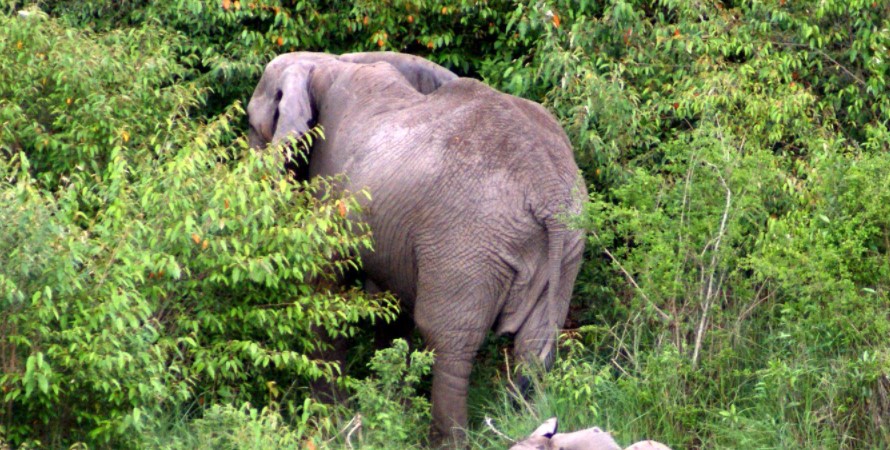
All wild animals to spot on a Uganda safari- Uganda has been blessed with various species notably plant life, tree species, plenty of wildlife, the home of the great apes of chimpanzees and gorillas, stunning landscapes, and the big five animals on the African wildness. Uganda features wonderful weather conditions favorable for wildlife safaris throughout the year which is so interesting.
It’s every traveler’s dream to visit Uganda the pearl of Africa and be able to have a once-in-a-lifetime sight of the Africa safari big five wild animals- lions, elephants, leopards, rhinoceros, and elephants. These big five animals are found in the major national parks of Uganda and cannot be missed on a wildlife safari. The rhinos can only be found in Ziwa rhino sanctuary while others are found in parks like Queen Elizabeth national park, Kidepo valley national park, and Murchison falls national park which are the most visited national parks in Uganda.
Well, the big five are not the only wild animals found in Uganda’s national parks. Uganda has more than 350 species of mammals of all sizes, 20 primate species, and 1066 bird species
The animals found in Uganda can be grouped into the following categories:
Primates – mountain gorillas, chimpanzees, golden monkeys, black and white colobus, grey checked mangabey, blue monkeys, l’hoest’s monkeys, olive baboons, bushbaby, potto, vervet monkeys, Uganda mangabey, and many others.
Herbivores – antelope, African elephant, Uganda kob, common eland, giraffe, sitatunga, hartebeest, African buffalo, rhinos, hippos, warthogs, and zebras to mention but a few.
Carnivores – lions, leopards, cheetah, the caracal, African golden cat, jackal, bat-eared fox, spotted hyena, civet, otters, mongooses, and many others.
Birds – turaco, bee-eater, grey crowned crane, trogon, standard-winged nightjar, honeyguide, African jacana, black-breasted barbet, and hamerkop among others.
Reptiles – Nile crocodile, monitor lizards, snakes, and chameleons.
Carnivorous animals found in Uganda
Uganda has over 38 carnivore species
Lions . Also known as the king of the jungle they can weigh up to 680kgs and grow up to a height of 165m. lions eat a wide variety of prey, from impala, zebras, antelopes, buffaloes, antelopes, giraffes, wild hogs, and sometimes eat hippos. They also feed on small animals such as hares, reptiles, and birds. lions are mainly seen in Uganda’s three largest savannah parks which are Kidepo valley national park, Murchison falls national park, and Queen Elizabeth national park which also has tree-climbing lions.
Leopards . They are quite similar to the cheetahs but what differs them is the rosette-shaped spots which are more powerfully built. Leopards are seen in most of the parks in Uganda such as lake Mburo national park, Queen Elizabeth national park, Murchison falls national park, Semiliki national park, and Kidepo valley national park but they are very rare so if you get an opportunity of seeing them on a Ugandan safari you should count yourself lucky.
Cheetah . Are one of the rare wild animals that can hardly be seen in national parks but in Uganda they are seen in the most remote national park located in the northeastern part of the country (Kidepo valley national park). Cheetahs belong to a cat family of carnivores’ species and are heavily spotted with a greyhound-like build black tear-masks. A few years ago, there was a lot of fear that cheetahs might have been extinct from Kidepo valley national park but reports say there are about 20 cheetahs in Kidepo valley national park and the government is working hard to protect them and their habitat.
Spotted hyenas . These are huge with a sloping back, dark brown spots, and mighty jaws that can crash hard bones and skins. They are found in most of the savannah parks like Murchison falls national park, Lake Mburo national park, queen Elizabeth national park as well as Mgahinga national park but the highest population is found in queen Elizabeth national park. Spotted hyenas are not found anywhere in Kidepo valley national park. They are mainly found in savannah, woodland, and desert though they are mainly active at night with exceptional hunting skills, capable of killing large animals such as antelopes, zebra, impalas, and wildebeests among others.
African civets . Are not easily seen during daytime reason being they are nocturnal but are widely spread and common in most wooded habitats and have been seen in most of Uganda’s national parks.
Mongooses . These are tough and agile creatures with long tails as long as their whole body. There are about 10 different mongooses recorded in Uganda i.e. slender mongoose, banded mongoose, marsh mongoose, Jackson’s mongoose, white-tailed mongoose, Egyptian mongoose, common dwarf mongoose, among others but the commonest species being banded mongooses and they are commonly seen around Mweya peninsular in queen Elizabeth national park.
Otters . Otters are familiar aquatic predators living in areas of Lake Mburo national park, Lake Bunyeni, and rare in Lake Victoria. In Uganda, we have African clawless otters, dark spotted-necked otters, and Congo clawless otters.
The bat-eared fox . These are quite common in Kidepo valley national park because they are associated with dry open places. They are small in size with giant ears, striking silver-grey color, and black eye-mask regularly spotted moving in pairs or small groups. These foxes are commonly seen during the night hours or in the morning during the hotter days.
Genets . These are nocturnal animals resembling cats but are related to civets. Genet species include large spotted genes, small-spotted genes, and servaline genes. The genets are widespread in Uganda and they have been recorded in Semiliki wildlife reserve, Maramagambo forest of queen Elizabeth national park.
Smaller cats in Uganda include.
Caracals . These can be seen in Kidepo valley national park and every forest national park except Semiliki. African wild cat is seen in most savannah national parks in Uganda. Lastly, servals are widely spread in Uganda and live-in varied habitats from woodland and forests.
Jackals . These are related to dogs, foxes, coyotes, and wolves with small faces, delicate legs, and fluffy tails with long alert eyes. They are associated with most savanna habitats and in Uganda, they are seen in Lake Mburo national park, Kidepo valley national park, Murchison falls national park, Queen Elizabeth national park, Pian Upe wildlife reserve, and Bwindi impenetrable forest national park. Uganda, we have golden jackal, black-backed jackal, and side-stripped jackal
Herbivores
On all Uganda wildlife safaris, you cannot miss catching sight of herbivores animals in Uganda’s national parks. herbivores animals are the most widespread wild animals found in almost every Uganda park and wildlife reserve. The following are some of the herbivores you expect to see on your Uganda safari.
Buffaloes . These are among the big five mammals and they are one of Uganda’s most dangerous. Buffaloes in Uganda rea divided into larger savannah buffaloes and smaller forest buffaloes. They live in large herds of savannah and smaller herds in the forests and they can be sighted on a game drive in places like Kidepo valley national park, Queen Elizabeth national park, Murchison falls national park, and Lake Mburo national parks of Uganda.
Giraffes . Giraffes are the world’s tallest land mammas and Uganda is one of the few countries in the whole world blessed with this species of mammals. In Uganda, we have the Rothschild type of giraffe and it is found in only three national parks namely Kidepo valley national park, Lake Mburo national park, and Murchison falls national park.
Rhinoceros . In Uganda, we only have one type of rhinos and they are only found in the Ziwa rhino sanctuary located in Nakasongola district. There are over 35 rhinos currently living at Ziwa.
The hippos . These are the largest aquatic animals and third largest land mammals after rhinos and elephants with webbed feet. Hippos have no sweat glands and spend most of their days submerged in water to keep cool. They stay in most of the national parks but are commonly seen in queen Elizabeth national park, Lake Mburo national park and Murchison falls national park.
African elephants . These are the world’s largest land mammals weighing over 6,000kgs. They are divided into two species one beings the bush elephant and the other being the forest and Uganda is lucky to be hosting both of them. They are found in most of the national parks in Uganda such as Kibale national park, Queen Elizabeth national park, Kidepo valley national park, Murchison falls national park. A few populations of elephants can be seen in Bwindi impenetrable forest national park, toro Semiliki game reserve, Rwenzori mountains national park, Budongo forest reserve, Katonga wildlife reserve, and Karenga community wildlife area but cannot be found in Lake Mburo national park.
Zebras . These have beautiful striped black and white colors on their bodies living with the highest population living in lake Mburo national park. Other zebras are found in the remote Kidepo valley national park in the northeast of Uganda, Pian Upe wildlife reserve near mountain Elgon, and Katonga wildlife reserve near Kibale forest
There are about 29 antelope species that have been so far recorded in different parks and game reserves of Uganda. Of these species 5 are large antelopes, 8 are medium-sized antelopes and the rest are small antelopes. Among the 29 antelope species we have greater kudu, eland, Jackson’s hartebeest, waterbuck, grant’s gazelle, sitatunga, Uganda kob, and topi to mention but a few.
The larger antelopes are
Greater kudu . These are woodland antelopes with a grey-brown coat with long, elegant spiral horns and white side stripes. There is a small population of greater kudu in Kidepo valley national park.
The eland . This is the biggest antelope species with a fawn-brown large dewlap and short spiraled horns and sometimes has light white stripes on its sides. Elands occur in open habitats throughout the eastern and southern parts of the country and they are commonly seen in Lake Mburo national park, Kidepo valley national park, and Pian Upe wildlife reserve.
Hartebeest . The common hartebeest seen in Uganda is Jackson’s hartebeest and these are unusual flat-faced tan-colored creatures. They are usually seen in lightly woodland and open savannah land places of queen Elizabeth national park, Murchison falls national park, Kidepo valley national park, and Lake Mburo national park.
Defassa waterbuck . This species of antelope has a grey-brown coat, white rump, and large curved horns. They live around water places and they are found in most savannah national parks such as Murchison falls national park and Queen Elizabeth national park.
Oryx . This is an ash-grey antelope with distinctively large, and scimitar-shaped horns. They live in semi-desert and dry acacia woodland of Kidepo valley national park.
The medium-sized antelope include
Impala . This is a handsome, slender antelope species with a chestnut coloring, sleek appearance, and distinctive lyre horns for the males. They can only be found in Lake Mburo national park.
Grant’s gazelle . These antelopes are lightly built with a tan color. They can be found in Pian Upe wildlife reserve, Matheniko and Bokora wildlife reserve, Kidepo valley national park, and Murchison Falls national park.
Sitatunga . This is a large semi-aquatic antelope with a shaggier coat and sexes having stripes. They have distinctively splayed hooves enabling live in swamps and papyrus. They can be found in most of the national parks in Uganda such as Kibale forest national park, Murchison falls National Park, and Queen Elizabeth national park among others.
The lesser kudu . This is species of antelope has the whitest stripes running down its backsides standing out on a reddish-brown coat on females and a grayish brown coat on males. What differs them from the greater kudu is that these are smaller in size. They can be found in Pian Upe wildlife reserve and Kidepo valley national park.
Uganda kob . Its reddish-brown in color and larger in appearance they are somehow related to waterbuck and reedbuck. They are found in queen Elizabeth national park, Kidepo valley national park, Murchison falls national park, Semiliki national park, and Katonga wildlife reserve.
Reedbuck. This one has a small crescent-shaped horn and is grey-brown in color. The mountain reedbuck is only found in Kidepo valley national park while the bohor reedbuck is found in Murchison falls national park, Pian Upe game reserve, Queen Elizabeth national park, Lake Mburo national park, and Kidepo valley national park.
The small-sized antelopes include
Bushpig . This is nocturnal and prefers staying in thick and dense woodland. They are found in all national parks of Uganda apart from the Rwenzori mountains national park.
Warthog . This is grey in color with tusks on all sides of the mouth seen in family groups. They are found in most savanna national parks and open habitats since they are herbivores animals.
The Giant Forest hogs . This is the largest African pig species. They are nocturnal creatures and rarely seen. They are commonly seen on a boat cruise on the Kazinga channel and other national parks in the western part of Uganda such as Kibale forest national park, Bwindi impenetrable forest national park, and Lake Mburo national park.
Oribi . It has a red-brown back, white underparts, and a diagnostic black scent gland under the ears. They stay in tall grasslands and have been seen in parks like Murchison falls national park, Queen Elizabeth national park, Lake Mburo national park, and Kidepo valley national park.
Guenther’s dik-dik . This is a small antelope with a dark red-brown coat, distinctive white eye markings. They are found in the dry places of Kidepo valley national park.
Bate’s pygmy antelope . this is a small antelope living in parks like Semiliki national park, and the forests near queen Elizabeth national park.
Klipspringer . This one has a goat-like habit with a dark grey coat and speckled living in pairs. They are found in lake Mburo national park and Kidepo valley national park.
Forest duiker. This is a notably small medium-sized antelope with a striking yellow back commonly seen on Uganda safaris. They are shy creatures and prefer staying in the dense forest cover. Types of forest duikers include.
The Harvey’s red duiker . This is a tiny antelope with a chestnut-brown color and can be found around forested areas of Kibale forest national park and Queen Elizabeth national park.
Peter’s duiker . This is a small antelope found in Kibale forest national park, Bwindi impenetrable forest national park, and Queen Elizabeth national park.
Grey duiker . This antelope species is speckled with a grey-brown coat and they live in woodland and savannah habitats. They can be seen in Mount Elgon national park, Murchison falls national park, Lake Mburo national park, Queen Elizabeth national park, and Kidepo valley national park.
The black fronted duiker . These can be only found in Mgahinga forest national park and Bwindi impenetrable forest in southwestern Uganda.
Blue duiker . This is tiny with a grey-blue coat and it’s found in Murchison falls national park, Queen Elizabeth national park, Kibale forest national park, and Bwindi impenetrable forest national park.
Primates found in Uganda
Primates are among the most popular animals found in Uganda’s parks. Visitors who come to Uganda mostly see animals like the mountain gorillas in Bwindi impenetrable forest national park and Mgahinga gorilla park both located in southwestern Uganda. Uganda also has chimpanzees which share almost 98% human DNA and they are found in Kibale forest national park, Budongo forest, Kyambura gorge, and Kaniyo Pabidi forests.
Mountain gorillas . These are the largest primates living at a high elevation of tropical and sub-tropical forests. Gorillas are divided into eastern gorillas and western gorillas. the eastern gorillas are further subdivided into mountain gorillas and eastern lowland gorillas while western gorillas are sub-divided into western lowland gorillas and cross river gorillas. in Uganda, we have only mountain gorillas in Bwindi impenetrable forest national park and Mgahinga gorilla park and these can be trekked at any time of the year.
Chimpanzees . These are black-coated apes with about 98% human DNA and can use tools such as sticks to dig out termites. Chimpanzees in Uganda can be trekked in Kibale forest national park which has over 1500 chimpanzees, Kyambura gorge of queen Elizabeth national park with over 600 chimpanzees, Budongo forests in Murchison falls national park, and Kaniyo Pabidi forests. The trekking of chimpanzees in Uganda can be done throughout the year.
Golden monkeys . These are subspecies of blue monkeys with golden-orange bodies, cheeks, tails with black limbs, and crowns on their head. They are only found in Mgahinga national park in the southwestern part of Uganda which is part of the Virunga mountains. Other countries you can trek golden monkeys in Uganda are DR Congo and Rwanda.
De brazza’s monkeys. These have a hairy face, white band across its brow, a reddish-brown patch around its eyes, a white mustache, and a beard. De brazza’s monkeys are found in mount Elgon and Semiliki national parks.
Black and white colobus monkeys . These are black in color with a white face and a white long tail covered with white long hair running from shoulders to rump and white tuffs at their long tail’s ends. The newborn babies are pure white. In Uganda, you can find these monkeys in Kibale forest national park, Queen Elizabeth national park, and Semiliki national park.
Vervet monkeys . These are black-faced primates with very distinctive blue male genitals. They are found in every forest national park of Uganda and they are absent from forest interiors and afro-alpine habitats.
Baboons . In Uganda, we have olive baboons which are larger with a dog-like face and are found in roadsides, parks, countrysides, but they are not found in Mgahinga national park, mountain Rwenzori national park, and Rwenzori mountains national park.
L’hoest’s monkeys . These species of primates have their face black with backward projecting white whiskers partly covering their ears and carry their tail in an upright position. They are hard to see because they prefer staying in densely forested places. In Uganda, you can find them in Kibale forest national park, Maramagambo forest, queen Elizabeth national park, and Bwindi impenetrable forest national park.
Blue monkeys . These are dark blue-grey in color with a white throat, thick fur, and backward projecting hair on their forehead. Blue monkeys cannot be seen in Murchison falls national park and Lake Mburo national park but can be seen in Kibale forest national park, Mgahinga gorilla park, Bwindi impenetrable forest national park, Semiliki national park, and others.
Red colobus . These have a slightly tufted crown. They are restricted in Kibale forest national park, where they are most common in the Bigodi swamp sanctuary, and others occur in small numbers in Semiliki national park.
Red-tailed monkeys . These are brownish in color with white whiskers and a coppery tail with a heart-shaped patch on their nose. In Uganda, they are found in Kibale forest national park, Mpanga forest, Bwindi impenetrable forest national park, Semiliki national park, Queen Elizabeth national park, and Budongo forest.
Patas monkeys . These have a lankier build, a light reddish-brown coat, and a black stripe above the eyes but could easily be confused with vervet monkeys. They are found in dry savannah places of Kidepo valley national park and Murchison falls national park.
Bushbabies . These have sparkling large eyes and a distinctive piercing cry that can be hard most especially at night. They live in most of the savannah parks and reserves in Uganda such as Kibale impenetrable forest national park, Bwindi impenetrable forest national park, Lake Mburo national park, and Queen Elizabeth national park.
Pottos . These are medium-sized sloth-like creatures that spend most of the night looking for food upside down from tree branches. They are nocturnal animals and they are found in Kibale forest national park, Bwindi impenetrable forest national park, and Queen Elizabeth national park.
Gray-cheeked mangabeys . These are greyish, and black primates with a shaggy appearance. They live in low and moderate-altitude rainforests of Semiliki national park, Mabira forest, and Kibale forest national park.
Reptiles in Uganda
Among the wild animals found in Uganda include the cold-blooded reptiles favored by the hot equatorial climate.
Nile crocodile. These are the largest living reptiles commonly seen along the banks of rivers and lakes sunbathing. Nile crocodiles feed on fish, and animals that come to drink water. When it gets prey, it first drowns it and keeps it under the sun until it is decomposed for better eating. In Uganda, they are clearly seen in the waters of Lake Victoria, Lake Mburo, Murchison Falls, and Kazinga channel inside Queen Elizabeth national park.
Snakes . Uganda has so many types of snakes such as black cobra, puffadder, green snake, black mamba, African rock python, boomslang, egg-eating snake, cape cobra, gaboon viper, green mamba, and puff adder among others.
When is the best time for wildlife viewing and primate trekking?
Uganda can be visited at any time of the year. But there are some months that are better than the rest for game viewing and primate trekking and these are the drier months of June, July, August, September, December, January, and February. It’s the dry season that most of the park animals are seen on the shores of water bodies, the roads leading to the park are passable and there is little or no rainfall to make the trails and tracks slippery. During the rainy season, the lodges give discounts but the roads can be impassable, the hiking trails and park trucks become slippery and the overall experience might be unsatisfactory.

Witu Forest Reserve in Kenya
Why were mountain gorillas going extinct.

RELATED POSTS

Nature walks in Ziwa Rhino Sanctuary

Where to see rhinos in Uganda

Bird species of Ziwa Rhino Sanctuary
Please be respectful of copyright. Unauthorized use is prohibited! Send us an email and the link of this page on [email protected] to get this information!
- Adventure in the Jungles of Africa
- +256 414-253597
- +256 773 064487
- [email protected]
- A complete guide for Wildlife Safaris in Uganda
A complete guide for Wildlife Safaris in Uganda – Guide for planning a wildlife safaris in 2024 – 2024
Uganda is listed among the top 10 places to travel by National Geography Society. Uganda is also one of the best places to visit for wildlife safaris in Africa. Although Uganda may not boast as large numbers as her neighbors like Kenya and Tanzania, Uganda hosts all the top wildlife species on the African continent. From the elusive cats in the vast savannahs to the magnificent primates in the tropical rainforests, Uganda has all kind of wildlife that will keep you excited during your tour. If you are planning to visit Uganda in 2024 or 2025, this complete guide for Wildlife Safaris in Uganda will enlighten everything about Uganda Safaris to see wildlife. This Guide for planning a wildlife safaris in 2024 – 2024 will provides all the necessary details about Uganda Safaris .
What we will cover in this guide – complete guide for Wildlife Safaris in Uganda
- Wildlife in Uganda
Primates in Uganda
- Best wildlife viewing destinations
Game drives & Game viewing in Safaris Parks
Boat safaris to see wildlife in uganda.
- Best time for wildlife Safaris in Uganda
What to pack for a wildlife Safari in Uganda
- Uganda Safari Prices – How Much is a safari in Uganda
Wildlife in Uganda – complete guide for Wildlife Safaris in Uganda
Uganda is one of the most naturally endowed countries in Africa. Uganda boasts several wildlife species from the famous African Big Five animals to the elusive primates in Bwindi. There are about 345 species of mammals that have been recorded in Uganda, along with 1,070 species of bird (Nearly half of the total number found in Africa). Uganda is also home to 142 species of reptile, 86 species of amphibian, 501 species of fish and 1,242 species of butterfly. Uganda is truly the pearl of Africa. If you are looking for a destination to visit for a lifetime adventure, then Uganda should be on top of your list.
When we talk about wildlife in Uganda, it is unfair not to mention the endangered mountain gorillas – a major draw of tourists to Uganda. Uganda is one of the three countries that inhabit the endangered mountain gorillas . Nearly half of the remaining mountain gorilla population is found in Uganda’s Bwindi and Mgahinga Gorilla National Park .
Top wildlife Species to see on Uganda wildlife safari tours – What wildlife will I see in Uganda?
Mountain Gorillas: Uganda is one of the few places in the world where you can encounter the endangered mountain gorillas. The Bwindi Impenetrable National Park and Mgahinga Gorilla National Park are home to over half of the world’s mountain gorilla population. One of the major highlights of Uganda safaris is gorilla trekking .
Chimpanzees
Uganda is also famous for its abundant chimpanzee population with over 5000 chimpanzees. Kibale National Park is the primary destination for chimpanzee trekking safaris in Uganda although there are other chimp trekking spots in the country. Kibale is renowned not only for its habituated chimpanzee communities, but also other pimate species like vervet monkeys, black and white colobus, Ret-tailed monkeys, L’Hoest Monkeys, plive Baboons, Blue monkeys, Grey Cheeked Mangabeys among others. This park is dubbed the primate capital of the world.
Uganda is home to the Big Five animals, including lions, elephants, leopards, rhinos, and buffaloes. The Murchison Falls National Park, Queen Elizabeth National Park , and Kidepo Valley National Park are popular destinations for witnessing these majestic creatures in their natural habitats. Rhinos can only be seen in Ziwa Rhino sanctuary which is located in Nakasongola, on the same route to Murchison Falls National Park .
Although once extinct in Uganda, rhinos have been successfully reintroduced. Ziwa Rhino Sanctuary is the only place in the country where you can find white rhinos. The sanctuary aims to restore the rhino population and engage in conservation efforts.
Uganda also has populations of zebras, primarily found in Lake Mburo National Park . These strikingly patterned animals provide an additional flavor to the country’s wildlife diversity.
While not native to Uganda, giraffes have been successfully reintroduced in Murchison Falls National Park . The park now boasts both Rothschild’s and Nubian giraffes, making it one of the few places in Uganda where you can witness these elegant creatures.
Hippos and Crocodiles
Uganda’s extensive network of rivers and lakes, including the Nile, is home to numerous hippos and crocodiles. Queen Elizabeth National Park , along with Murchison Falls National Park, offer excellent opportunities to see these impressive water-dwelling creatures.
Cats and predators
There are about 38 predator species found within the country’s protected wilderness. All these predator species prey on the abundant herbivore population in different National Parks and game reserves. While on a Uganda wildlife safari, apex predators such as lions, leopards, and cheetah, are challenging to spot however, a game drive with a local guide or ranger will guarantee there sighting during your Uganda wildlife tour .
There are also other small predator species like the serval, caracal, lynx, and civet, which are rarely seen on safaris. Among the predators in Uganda, there are five canids or dog-like species; wild dogs, wolves, foxes, and other extant species. Among the predators in Uganda, seven are feline species including; wild cat species such as the cheetah, leopard, lion, lynx, and the golden cat.
Uganda is also home to a wide range of other animals, including various antelope species, monkeys, baboons, warthogs, hyenas, and numerous bird species. The country’s wildlife is beautifully preserved and protected within its well-managed national parks, wildlife reserves and Sanctuaries, offering visitors incredible opportunities for wildlife safaris and eco-tourism experiences .
Primates are a group of mammals that include monkeys, apes, and lemurs. Uganda is home to several primate species, each with their own unique characteristics and habitats.
One of the most iconic primate species in Uganda is the mountain gorilla ( Gorilla beringei beringei ). These gorillas inhabit the dense forests of Bwindi Impenetrable National Park and Mgahinga Gorilla National Park in southwestern Uganda. Mountain gorillas are the largest living primates and are critically endangered. They are known for their distinctive black fur and the dominant male’s silverback, which serves as a display of power and maturity.
Another primate species found in Uganda is the chimpanzee ( Pan troglodytes ), which is closely related to humans. These intelligent primates reside in several locations across the country, including Kibale Forest National Park , Budongo Forest Reserve, and Kyambura Gorge. Chimpanzees live in large social groups and are known for their advanced tool-making abilities and complex social behaviors.
Uganda is also home to a variety of monkeys.
The vervet monkey ( Chlorocebus pygerythrus ) is widespread and can be found in various habitats, including savannahs, woodlands, and urban areas. The black-and-white colobus monkey ( Colobus guereza ) is known for its striking black and white coat and its ability to leap through the trees. They are found in many national parks, including Kibale Forest, Queen Elizabeth, and Murchison Falls.
Other monkey species found in Uganda include the red-tailed monkey ( Cercopithecus ascanius ), blue monkey ( Cercopithecus mitis ), grey-cheeked mangabey ( Lophocebus albigena ), and golden monkey ( Cercopithecus kandti ). Each of these species has its own habitat preferences and unique characteristics.
Some of the best safari activities in Uganda include primate tracking. Observing these primates in their natural habitats is a life-changing adventure activity. Primate tracking or trekking in Uganda requires permits. There are also strict guidelines to ensure the safety of both primates and visitors during the trekking safaris. Acacia Safaris limited is a leading tour operator in Uganda that will help you plan and organize you primate adventures in Uganda. Be golden monkey tracking, gorilla trekking or Chimpanzee trekking , we can help you to craft the best safari itinerary.
Best wildlife viewing destinations in Uganda – complete guide for Wildlife Safaris in Uganda
Murchison falls national park:.
The park is renowned for its diverse wildlife. It is home to the four of the “big five” – elephants, lions, leopards, and buffalos. Other species found in Murchison Falls National Park include giraffes, crocodiles, hippos, waterbucks, warthogs, Uganda kob, and numerous bird species. The park is also known for its Nile River cruises , where visitors can spot abundant wildlife along the riverbanks. Wildlife safaris to Murchison Falls National Park are rewarding with great wildlife sightings be it on boat cruise or game drives.
Kidepo Valley National Park – complete guide for Wildlife Safaris in Uganda
Kidepo Valley National Park is home to a wide range of wildlife that includes over 86 mammal species and nearly 500 bird species. Common sightings in the park include elephants, zebras, giraffes, lions, hyenas, cheetahs, oryx, and various antelope species such as hartebeests and elands. The park’s unique landscape, which combines sweeping savannahs, rugged hills, and vast plains, enhances its appeal for wildlife enthusiasts and photographers. Wildlife safaris to Kidepo Valley National Park will guarantee top wildlife sighting during your Uganda Safaris tour .
Queen Elizabeth National Park:
Queen Elizabeth National Park has a diverse ecosystem, including savannah grasslands, forests, swamps, and lakes. This Park is home to an array of wildlife, making it one of the most popular national parks in Uganda . Wildlife in Queen Elizabeth National Park includes elephants, buffalos, leopards, lions, hippos, crocodiles, hyenas, and various antelope species such as Uganda kob. The park is also famous for its boat cruises along the Kazinga Channel, where visitors can see numerous bird species and hippos in close proximity.
Bwindi Impenetrable National Park:
Bwindi is home to about half of the world’s remaining mountain gorillas , making it a paradise for those interested in watching these primates in their natural habitats. While in Bwindi, you can participate in guided gorilla trekking through the thick forest to observe these magnificent creatures in their natural habitat. Apart from gorillas, the park is also home to over 120 mammal species, including elephants, buffalos, and various monkey species.
Mgahinga Gorilla National Park – complete guide for Wildlife Safaris in Uganda
Mgahinga Gorilla National Park offers gorilla trekking experiences, allowing visitors to observe the rare and magnificent mountain gorillas up close. In addition to gorillas, the park is known for its diverse birdlife, with over 180 bird species recorded. Mgahinga is also the only place where both gorillas and golden monkey can be seen, and hence referred to as the place where silver meets gold.
Kibale National Park:
Kibale National Park is home to about 1,450 chimpanzees with several habituated chimpanzee communities that can be trekked during safaris. Besides chimpanzees, Kibale is also home to other primate species such as red colobus monkeys, L’Hoest’s monkeys, and olive baboons.
For bird lovers, Kibale National Park boasts a diverse range of bird species, with over 375 different species making it a paradise for birdwatchers. Nature walks, forest hikes, and cultural visits to nearby communities are also other popular safari activities done in Kibale.
Game drives or Game viewing safaris are the best way to unfold the untamed wilderness of Uganda’s National Parks . To better experience Uganda’s wildlife, you need to book a game drive safari. Uganda is home to a diverse range of wildlife, including elephants, lions, leopards, buffaloes, giraffes, zebras, and a variety of antelopes.
During a game drives of game viewing safaris, you will explore and drive through Uganda’s national parks or wildlife reserves in specially-designed vehicles on paved trails. Game drives in Uganda are commonly conducted on open-top 4x4s, allowing for uninterrupted views of the wildlife and nature around.
Game drive safaris to see wildlife can be done either early in the morning or late in the afternoon when wildlife is most active. The game drives are conducted by experienced driver guides, that will provide valuable information about the animals, their behavior, and the surrounding ecosystems. There are several spots to conduct game drives in Uganda such as Queen Elizabeth National Park , Murchison Falls National Park, Kidepo Valley National Park , and Lake Mburo National Park.
Boat Safaris to see wildlife in Uganda offer a unique and immersive way to observe wildlife in their natural habitat. One of the most popular destinations for boat safaris in Uganda is the Murchison Falls National Park. Murchison Falls National Park is divided by the Nile River, which provides a stunning backdrop for wildlife viewing, with the opportunity to see animals such as hippos, crocodiles, elephants, and various bird species along the riverbanks.
The other popular destination for boat safaris to see wildlife is the Kazinga Channel in Queen Elizabeth National Park . During the boat cruise in Queen Elizabeth National Park , you will spot several wildlife species including buffalo, waterbuck, and numerous bird species. The calm waters of the channel offer a tranquil experience as well as fantastic photographic opportunities for phographers.
Best time for wildlife Safaris in Uganda – complete guide for Wildlife Safaris in Uganda
The best time for wildlife safaris in Uganda is generally during the two dry seasons, from December to February and from June to October. During this time, wildlife viewing is much easier and guaranteed since most animals congregate near the water holes. The dry weather allows for better accessibility to remote areas within national parks, enhancing the overall safari experience.
Conversely, the wet seasons, between March to May and from late October to November, present a different but equally captivating experience. While the lush landscapes and vibrant flora during the wet season can make for stunning scenery, the dense foliage might make wildlife sightings more challenging. However, this time of year provides unique opportunities to witness animal behaviors such as mating rituals and birthing, as well as the chance to see migratory bird species that visit Uganda during these periods.
When preparing for a wildlife safari in Uganda , it’s essential to pack thoughtfully to ensure a comfortable and enjoyable experience.Some of the must carry when planning a Uganda Wildlife safari include;
Clothing: Lightweight, neutral-colored clothing are highly recommended to blend in with the natural environment and for comfort in warm weather. Long-sleeved shirts and pants provide protection from insects and the sun. A lightweight waterproof jacket or poncho is useful for unexpected rain showers. When packing your clothing for Uganda Safari , ensure to include all these.
Footwear: Sturdy, comfortable walking shoes or hiking boots are essential, especially for activities such as nature walks and gorilla tracking. Closed-toe shoes also offer protection from potential hazards on the ground.
Headgear : A wide-brimmed hat or cap for sun protection, as well as a bandana or scarf to shield your neck, are recommended.
Protective Gear: Sunscreen with a high SPF, insect repellent containing DEET, and sunglasses are crucial for safeguarding against the sun’s rays and insect bites.
Gadgets: If you plan on capturing wildlife and nature scenes, don’t forget to pack a quality camera or smartphone, along with extra memory cards and batteries. Binoculars are also valuable for observing distant wildlife.
Travel Documents: Carry your passport, visa, and any necessary permits.
How much does a safari in Uganda cost? – What are the prices for safari in Uganda?
Travelers often inquire about the cost of safaris in Uganda , expecting a fixed price. Unfortunately, it’s not realistic to give a general cost because different service providers in Uganda charge differently for their tours and services. Several factors at play determine the cost of a particular tour, such as the type of accommodation, duration of the tour, mode of transportation, and the number of people in the group. As a result, the final cost of a trip is usually different for each traveler.
It’s also important to note that most tour operators in the country don’t include air tickets, visas, travel insurance costs, and personal expenses when sharing their itinerary.
To get a better understanding of the cost of a safari in Uganda , consult, Acacia Safaris Limited and get detailed information about the different costs involved. We also offer valuable advice on how to plan your trip and ensure that you have an unforgettable experience while staying within your budget
What are the prices for safari in Uganda ? If you are looking for a low-budget camping private safari, you can expect to pay around $300 per person per day. Alternatively, if you choose a group camping tour, the cost can be reduced to $250 per person per day. For those on a tight budget, budget accommodation in Uganda starts at around $275 per person per night and $225 per person per night when sharing. However, if you are looking for a more luxurious experience, you can expect to pay from $600 per person per day and there is no limit to what you can spend. Regardless of your budget, Uganda has something for everyone when it comes to safari experiences.
Uganda Wildlife Safaris Related Searches
- Uganda Safaris Tour
- Uganda Gorilla Safari Packages
- Uganda Wildlife Safari Packages
- Uganda Birding Safari Packages
- Chimpanzee Trekking Safari Packages
- Long Uganda Gorilla Safaris
- Long Uganda Wildlife Tours
- Short Uganda Gorilla Safari Tours
- Short Uganda Wildlife Tours
- 5 Days Best Gorilla Trekking Safaris Uganda
- 5 Days Best Uganda Wildlife Safari Tour
- 6 Days Best Uganda Adventure Tour
- 7 Days Best Uganda Gorilla Trekking Safari
- 7 Days Uganda Primate Tour
- 8 Days Best Uganda Safari Itinerary
- 9 Days Best Uganda Tour Itinerary
- Africa Adventure Tours
- East Africa Safaris
- Uganda Safari
Uganda Gorilla Trekking Tours Related Searches
- Long Uganda Gorilla Safari Tours
- 9 Days Classic Uganda Wildlife Safari
- 12 Days Affordable Uganda Adventure Tour
- 13 Days Classic Uganda Adventure Tour
- 14 Days Ultimate Uganda Wildlife Safari
- 15 Days Wildlife Safari Africa
- 16 Days Best Uganda Birding Safari
- 18 Days Best Uganda Adventure Safaris of a Lifetime Tour
Popular Packages
- 3 Days Uganda Savannah Wildlife Tour
- 4 Days Savannah Wildlife Safari to Uganda
- 4 Days Uganda Wildlife Safari
- 4 Days Ultimate Primates Safari & Wildlife Tour Uganda
- 6 Days Uganda Wildlife Safari Tour
- 9 Days Uganda Primates Tour
- 9 Days Uganda Adventure Safari
- 12 Days Uganda Adventure Safaris Tour
- 19 Days Uganda Classic Safari Experience
- 5 Days Uganda Rwanda Safari
- 7 Days Uganda Gorilla Tour Rwanda Wildlife Safari
- 10 Days Uganda Rwanda Wildlife Safari
- 12 Days Kenya Uganda Safari
- 12 Days Tanzania Uganda Safari
- 13 Days Rwanda and Uganda Safari
- 13 Days Tanzania Uganda Tour
- 17 Days Uganda Kenya Tanzania Safari
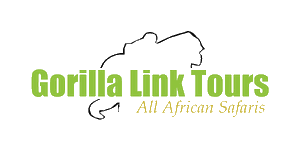
- 19 Days Bird watching Uganda safari and exclusive photography tour
- 18 Days Uganda wildlife safari with gorilla tracking – Budget Safari
- 14 Days best of Uganda wildlife safari
- 13 Days Uganda wildlife safari
12 Days Midrange Pearl of Africa Tour
- 12 Days great Apes of Uganda & Rwanda
- 11 Days Uganda safari, Pian Upe wildlife and cultural tour | North-East waterfalls adventure
- 11 Days Uganda gorilla and wildlife safari
- 10 Days Uganda wildlife safari – Gorillas, Chimps and Lions
- 10 Days Uganda Exclusive luxury safari
- 9 Day Uganda Family safari – Mid range
- 9 Day Rwenzori Margherita Peak Trek
- 8 Day Exclusive wildlife safari Uganda
- 8 Day Uganda wildlife Budget safari
- 8 Days Mountain Elgon Hike in Uganda
- 7 Days Uganda Gorillas, chimps and shoebill stork safari
- 5 Days Sipi trail hike on Mountain Elgon in eastern Uganda
- 5 Days Uganda wildlife road trip to Kidepo Valley national park
- 5 Days Uganda Wildlife Safari to Queen Elizabeth and Semuliki National parks
- 6 Day Mgahinga Gorilla Park and ‘Islands in the sky’ hike Via Kigali
- 6 Day Uganda Gorillas and wildlife safari
- 6 Days Gorillas and Murchison Falls National Park safari
- 5 Days Rwenzori mountains trekking and climbing safari in Uganda
- 4 Days Lions wildlife Safari in Queen Elizabeth National park
- 4 Days Mgahinga Gorillas and Golden Monkeys Safari
- 4 Days Lake Bunyonyi with gorilla tracking safari
- 4 Days Kidepo Wildlife Safari
- 4 Days Kibale Chimpanzee tracking and Queen Elizabeth National park safari
- 4 Days Sipi Falls and Pian Upe wildlife safari
- 4 Days hiking on sasa trail
- 3 Days Chimpanzee habituation tour Kibale Forest National Park
- 3 Days Chimpanzee tracking tour Kibale Forest National Park
- 3 Days Gorilla tracking safari in Uganda
- 3 Days Kibale forest chimpanzee tracking tour
- 3 Days Murchison falls wildlife safari
- 3 Days Queen Elizabeth National Park safari, Mid range Uganda wildlife tour
- 3 Days Semliki National park safari
- 4 Days fishing and the Big five safari to Murchison Falls National Park
- 4 Days gorilla tracking Bwindi from Kigali Rwanda
- 3 Days Budget Gorilla Tracking safari in Bwindi Forest
- 9 Day Uganda Exclusive Fly in safari
- 4 Days Luxury Fly-in Wildlife safari to Kidepo Valley National Park
- 3 Days Fly into Rwanda and track Gorillas at Bwindi Forest in Uganda safari
- 3 Days Fly to Bwindi gorilla tracking safari
- 10 Days Best of Rwanda safari, Gorilla,Chimpanzee and Golden monkey tracking
- 7 day Rwanda luxury Tour
- 4 Days Exclusive Luxury Rwanda Gorilla Trekking
- 4 Days Rwanda Gorillas and Golden Monkey Tracking Tour
- 3 Days gorilla Tracking Rwanda safari in the Volcanoes national park
- 3 Days Akagera National park wildlife Safari
- Combined Safaris
- 12 Days Best of Kenya and Tanzania Safari
- 10 Days Masai Mara – Serengeti and Gorilla Trekking Safari
- 8 Days Kenya and Tanzania Safari Tour
- 8 Days Amboseli – Naivasha – Lake Nakuru and Masai Mara Safari
- 8 Days Masai Mara Kenya game parks safari
- 6 Days Masai Mara 7 Ol Pejeta
- 6 Days Masai Mara and Gorilla Trekking Safari Holiday
- 6 Days Amboseli, Lake Nakuru and Masai Mara Safari Holiday
- 6 Days Migration and lake Naivasha Adventure Safari
- 5 Days Masai Mara and Lake Nakuru Safari Tour
- 5 Days Tsavo and Amboseli Wildlife safari
- 4 Days Masai Mara, Lake Naivasha & Hells Gate Safari
- 4 Days Masai Mara Safari Holiday
- 3 Days Amboseli Safari Holiday
- 12 Days Luxury Kenya and Tanzania Safari Package
- 11 Days Fly-in Safari Masai Mara – Lake Nakuru – Kibale & Bwindi Forest
- 6 Days Fly-in Safari Wildebeest Migration and Gorilla Trekking
- 4 Days Fly-in Safari Masai Mara and Hot Air Balloon
- 3 Days Masai Mara Fly-in Safari Holiday
- 22 Days Uganda – Kenya – Tanzania and Zanzibar Beach Holiday
- 12 Days Masai Mara, Tanzania and Zanzibar Beach Holiday
- 10 Days Tanzania Safari Package
- 9 Days Masai Mara and Serengeti Safari Holiday
- 8 Days Tanzania Safari & Beach Holiday
- 6 Days Masai Mara & Serengeti Safari Holiday
- 6 Days Tanzania Northen Circuit Safari
- 5 Days Kilimanjaro Climbing Marangu Route
- 5 Days Serengeti and Ngorongoro Safari
- 4 Days Serengeti and Ngorongoro Crater Safari
- 3 Days Tarangire, Ngorongoro & Lake Manyara Safari
- 3 Days Serengeti Safari Package
- 6 Days Fly-in Safari Serengeti and Ngorongoro Crater Safari
- 4 Days Fly-in Safari Serengeti and Hot Air Balloon
- 3 Days Fly-in Safari Serengeti Holiday
- 8 Days Luxury Tour to Victoria Falls, Wildlife Safari to Hwange and Gorilla Tracking in Uganda
- 6 Days Victoria Falls and Gorilla Tracking luxury Safari
- 6 Days Victoria Falls & Gorilla Tracking luxury Safari
- 3 Days Victoria Falls in Zimbabwe Tour
- 11 Days Combination Adventure Burundi, Rwanda and the DRC
- 9 Days Combination of Gorilla Trekking (the DRC & Rwanda)
- 8 Days Rwanda, Uganda & Congo (DRC) Gorilla Trekking Trip
- 7 Days Mountain & Lowland Gorilla Tracking Rwanda & Congo
- 6 Days Combined Adventure Bonobos & Lowland Gorillas DRC
- 5 Days Lowland Congo Gorilla Trek Safari
- 5 day gorillas golden monkeys and Nyiragongo hike
- 5 Days Uganda Gorilla Trek and Nyiragongo Volcano Hike
- 5 Days gorilla tracking Congo with Nyiragongo Volcano hike
- 4 Days Congo Gorilla Trek and Nyiragongo Volcano Hike
- 3 Days Lowland gorilla tour in Congo
- 3 Days Eastern Lowland Gorilla Trekking in Congo
- 3 Days Mount Nyiragongo Volcano Hiking Trek
- 3 day Nyiragongo volcano tour
- Get In Touch
The Big Five Safari Animals in Uganda
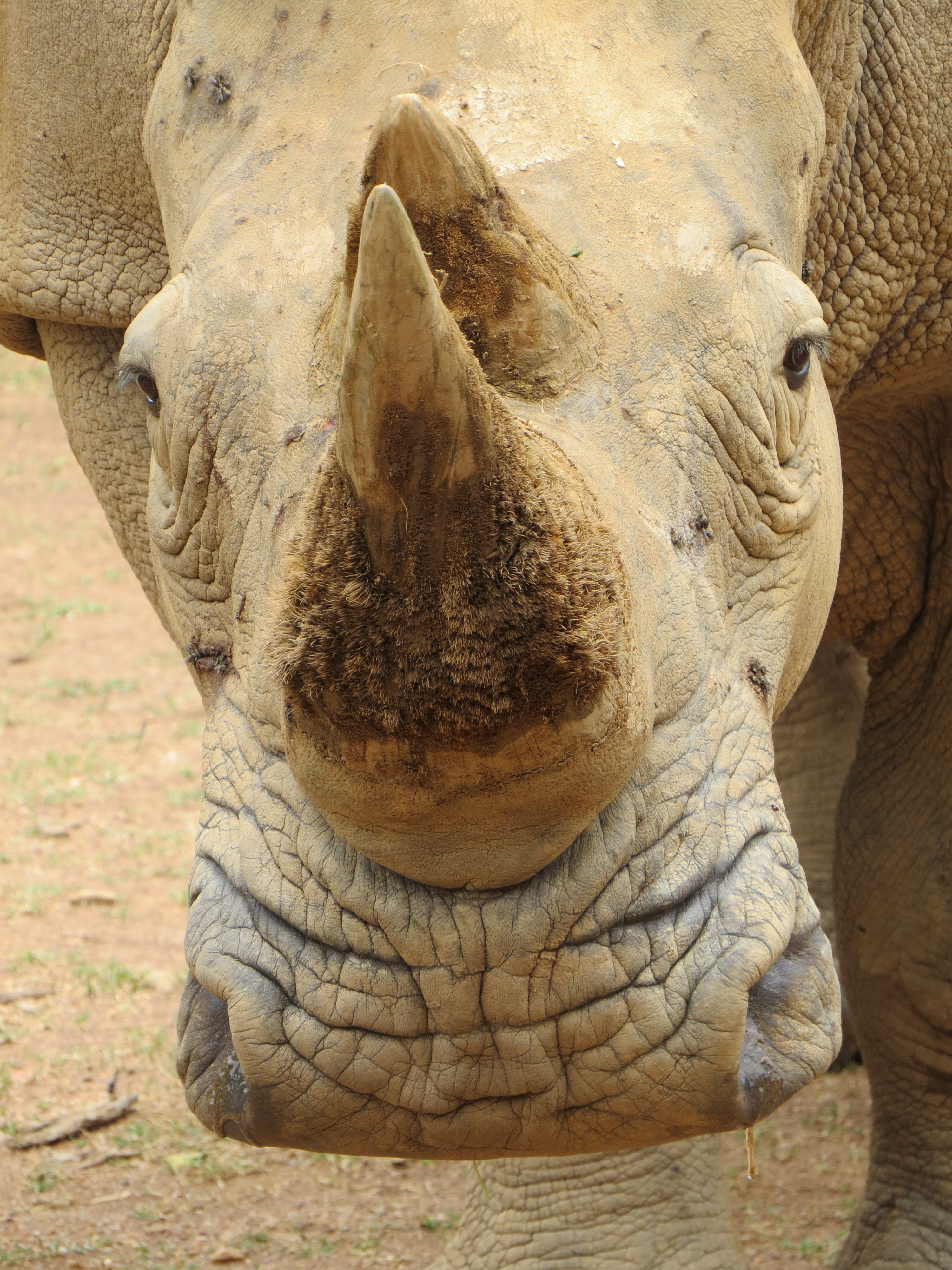
Uganda has got a lot to offer, including the big five safari animals which can be seen on a safari to Uganda in Murchison Falls National park , Kidepo Valley National Park, Ziwa Rhino sanctuary and Queen Elizabeth National Park.
Seeing the big five animals on a safari in Uganda is such a great experience. You will go rhino trekking at Ziwa Rhino sanctuary , watch elephants walk in front of your safari vehicle on a sunrise or sunset safari game drive in Murchison Falls National Park, Kidepo Valley National park and Queen Elizabeth National park. The elephant is one of the big five safari animals in Uganda and Africa in general and will be discussed below
What are the big five animals in Uganda?
The big five safari animals are the Cape Buffalo, African Elephant, African Leopard, African Lions and finally the Rhinoceros. They are referred to as the ‘Big five’ by the trophy hunters because they were the dangerous and hard to hunt animals.
However, the use of that term has changed now. On a safari to Uganda, it is more used as the 5 must see animals on safari. You come across this term many times while on safari game drives in national parks in Uganda.
Below is some information about each Big five safari animal
The African Lion
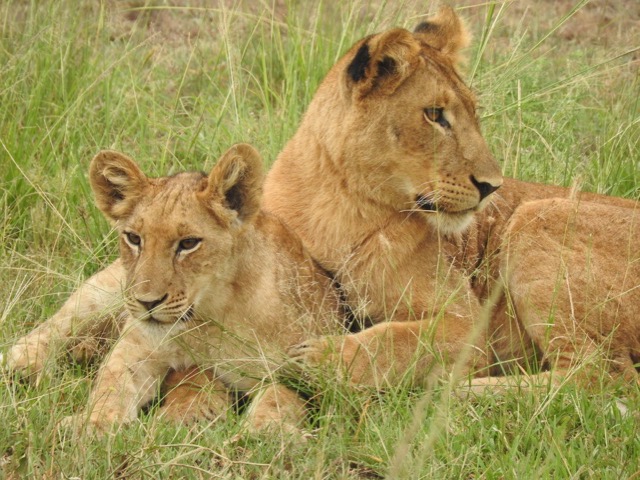
The African Lion, one of the big five safari animals in Uganda are the most sought after animal on safari and are synonymous with Africa. In Uganda, they be seen in Queen Elizabeth National park and Kidepo National park . These lions are big cats and live in prides led by the female. They have been nick named ‘The King of the Jungle’ although in Africa, their habitat is Savannah and not the jungle. To see them in Queen Elizabeth National, visitors go on a morning or night game drive, lion tracking and in Ishasha sector, the southern part of the park, lions are seen in trees. They climb comfortable trees to escape heat
The African Elephant
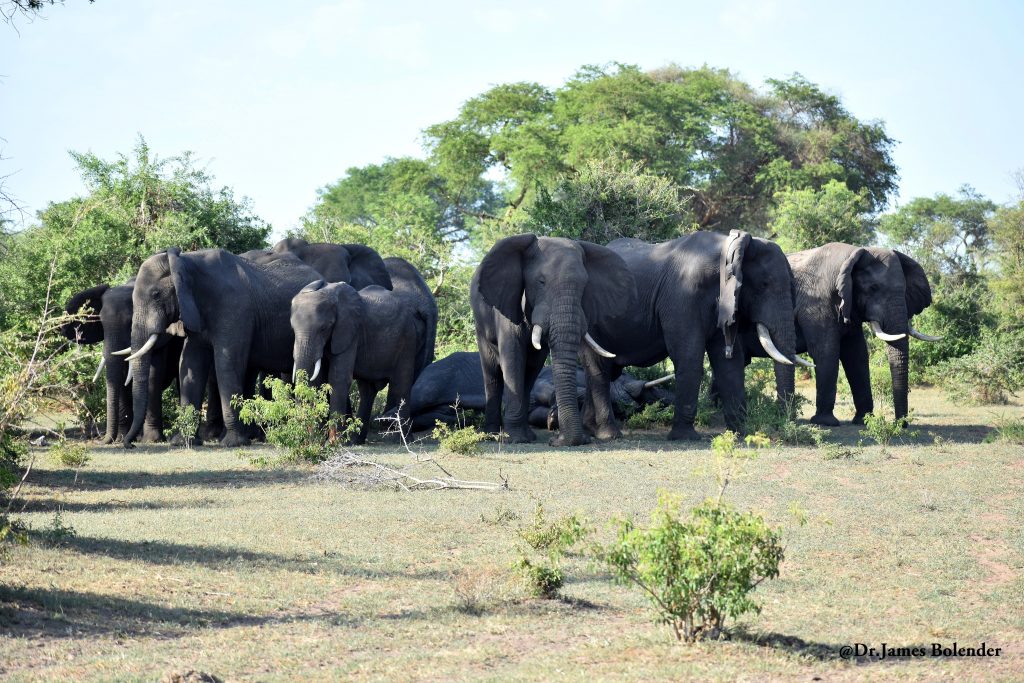
The African Elephant, the biggest land mammal is one of the most loved African animals. In Uganda, there are two types of African elephants; the Savannah African elephant which is common and is easily seen on safari game drives in Kidepo Valley National Park , Murchison Falls National park and Queen Elizabeth National park . The other type is the African forest elephant which is rarely seen in Uganda but lives in Kibale Forest National park and Bwindi Impenetrable National park .
African elephants are one of the big five safari animals because they are deadly and very dangerous.
They are very intelligent, have intense emotions and are great at solving problems. They display deep social bonds all the time. They are one of the highly sought after animals on a safari to Uganda .
The African Cape Buffalo
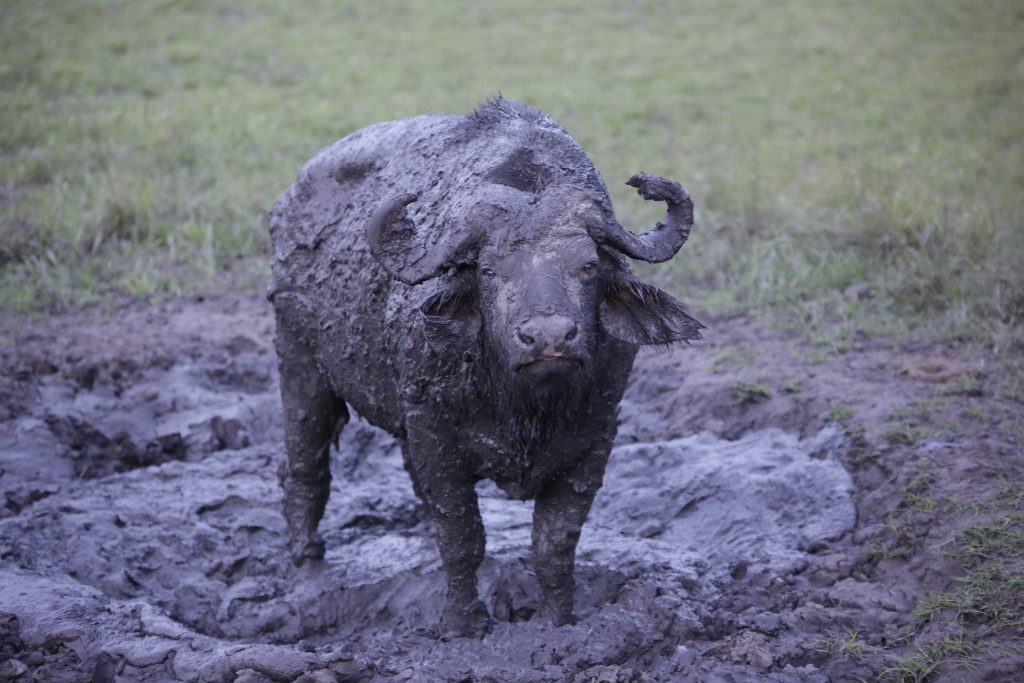
The African Cape Buffalo is one of the commonly seen safari animals in Uganda. It is also one of the most dangerous and animals to come across. They are seen during morning, evening and night game drives while on a safari to Uganda and other African countries.
They can charge at almost 35mph. The African Cape Buffalo almost has no predators apart from the real brave and hungry lions and sometimes the Nile Crocodiles.
Find the African Cape Buffalo in Kidepo Valley National park, Queen Elizabeth National park, Kibale National park, Lake Mburo National park among others
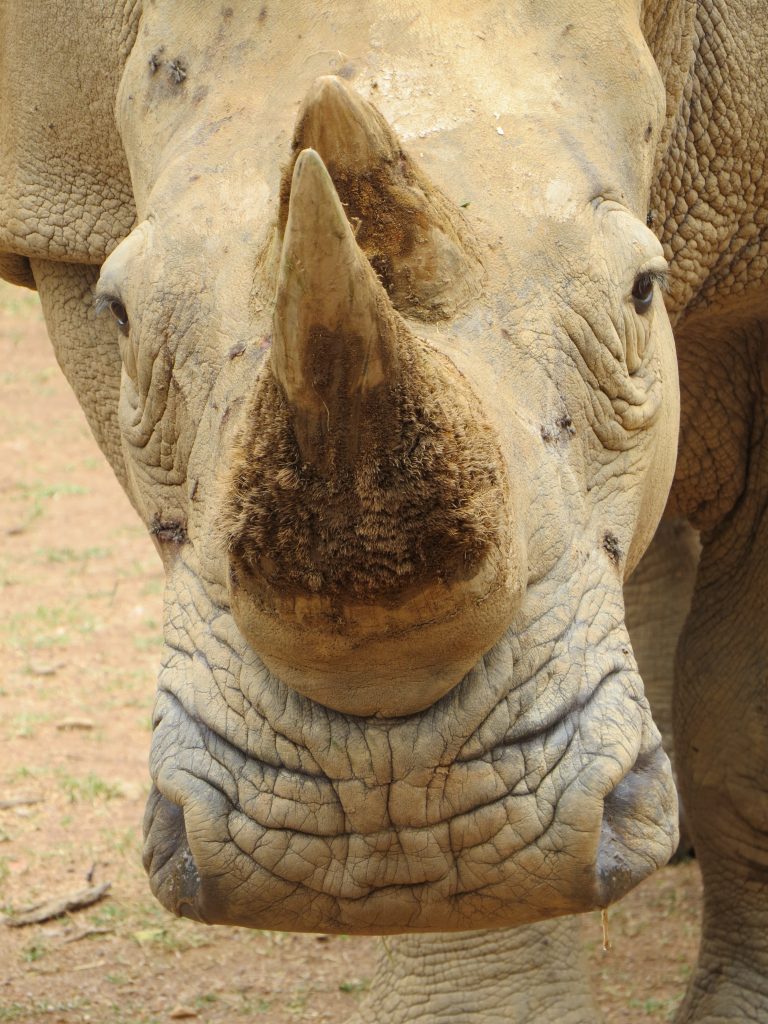
One cannot mention the big five safari animals and not talk about The Rhino. It is the 2 nd biggest large land animal. There are two types of rhinos, the black and white rhino. They have the same color but the white rhino has a wider mouth than the black rhino. The white rhino is also bigger than the black rhino. Uganda is home to only The White Rhino found only a Ziwa Rhino Sanctuary and Uganda Wildlife Education centre . A traveller on a safari to Uganda can see a rhinos on a walking rhino trekking safari en route to Murchison Falls National park. The rhinos at Ziwa rhino Sanctuary are protected by armed guards, 24/7
Unfortunately, the rhino is one of the most threatened animals of the big five safari animals. It is poached for its rhino horn which is sold in Vietnam and China. This is likely to make the rhino extinct.
5: The African Leopard
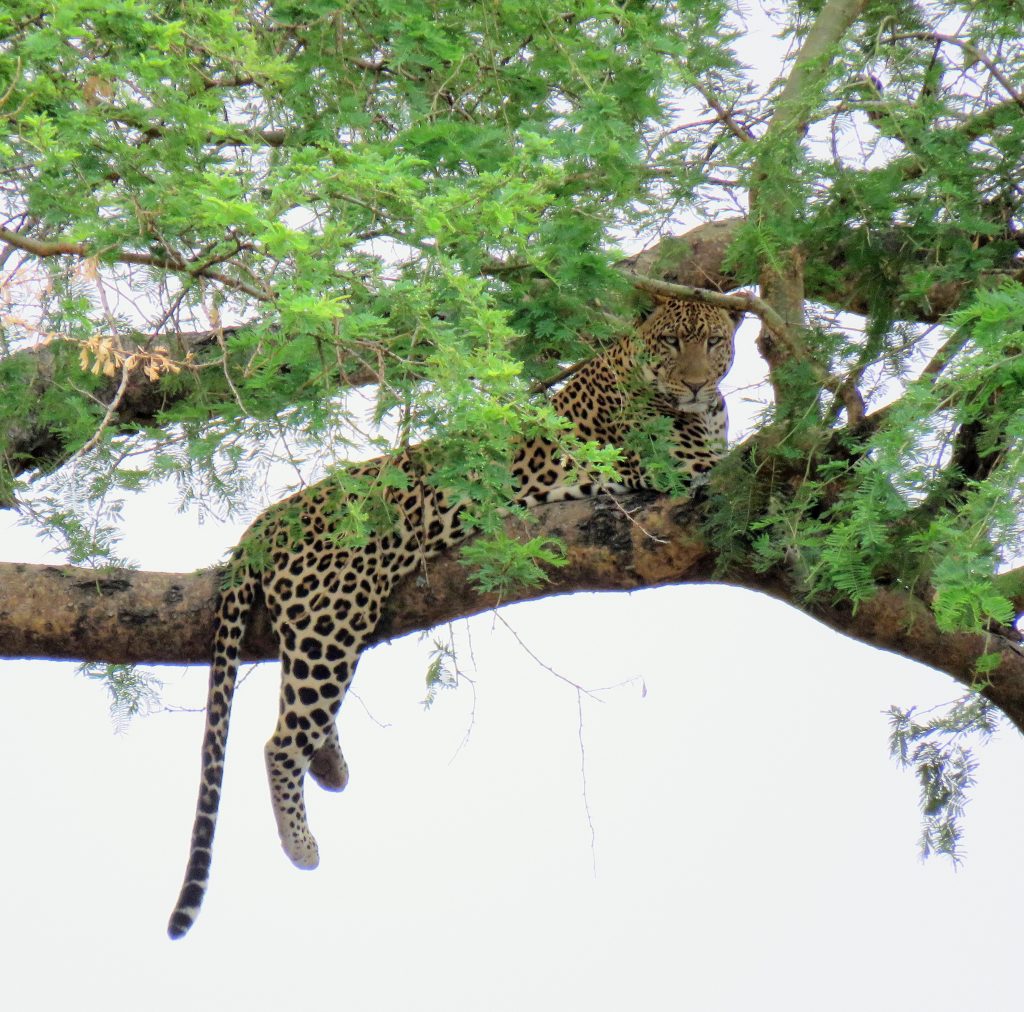
The Leopard is one of the big five safari animals because it is elusive and the hardest to see. They are widespread and are really good at camouflaging. They mastered the art of stalking their prey. They are so powerful that they can pull their prey/kill up into the tree.
It is the most widely spread big five safari animal but seeing one in the wild is rare and feels exciting seeing one. On lucky game drives in Murchison Falls National park and Queen Elizabeth National park, one can spot a leopard lazy-ing in a tree or walking in the savannah bushes. You can also see some leopards in Lake Mburo National Park , Uganda’s smallest savannah national park.
Best National parks to see The Big Five Safari Animals in Uganda
The best national parks to see the big five safari animals in Uganda are Murchison Falls National park which is the biggest conservation area in Uganda, Queen Elizabeth National Park, Lake Mburo National park, Kidepo Valley National park etc. Animals to see here are leopard, Cape buffalo, lions and elephants. You can see white rhinos on rhino walking safari at Ziwa Rhino Sanctuary.
Best time to see the big five safari animals in Uganda.
Travellers can visit Uganda throughout the year due to its beautiful tropical climate. On a safari in Uganda, you can see the big five safari animals anytime you are on safari game drives or boat safaris.
Suggested itineraries that include the Big Five safari animals
3 days luxury wildlife safari to murchison falls, 5 day uganda wildlife road trip to kidepo valley national park, 8 day exclusive wildlife safari uganda, 9 day uganda exclusive fly-in safari, 9 day uganda family safari, 10 day exclusive luxury safari uganda, 10 days gorillas, chimps & lions, 11 day uganda gorilla and wildlife safari, 14 days best of uganda wildlife, 18 days uganda gorillas and wildlife safari- budget safari, leave a reply cancel reply.
Save my name, email, and website in this browser for the next time I comment.
Text Widget
Recent comments.
- Call Us On:
- +256393242626
- +256708298351
- [email protected]

- Africa Big 5 Animals in Uganda
- Wildlife Safari

Africa Big 5 Animals in Uganda – Big five safaris in Uganda
Africa big 5 animals in Uganda – Uganda’s National Parks offers amazing wildlife, including the big five animals which can be seen on a game safari to Uganda in Murchison Falls National Park, Kidepo Valley National Park, Ziwa Rhino Sanctuary and Queen Elizabeth National Park. Seeing the big five animals on a safari in Uganda is such a great experience.
You will go Rhino tracking at Ziwa Rhino Sanctuary, watch elephants walk in front of your safari vehicle on a game drive in one of the mentioned National Parks.
Africa Big 5 is a term for some time back in the 1800s by trophy hunters referring to what they considered the most challenging and dangerous animals to hunt on foot and these include the African Elephant, Lion, Leopard, African Cape buffalo and the Rhinos. Today the term is mostly famous with Uganda safaris you who now shoot the big five with your camera rather than a killing weapon.
The Africa big 5 animals in Uganda are all present in Uganda and can easily be seen in all savannah National Parks. The phrase today is commonly used to market Uganda safaris, but back in the nineteenth and early twentieth centuries, everyone from European royalty to American presidents wanted to bag an African hunting trophy.
Where can you find the Big Five animals in Uganda?
Apart from the Northern White Rhino which can only be seen in Ziwa Rhino Sanctuary and Entebbe Uganda Wildlife Education Centre, tourists have a good chance of seeing the other members of the Africa Big 5 animals in any of the four Uganda savannah National Parks.
A game drive in Murchison Falls, Queen Elizabeth, Kidepo Valley and Lake Mburo National Parks will put you in the centre of nonchalant herds of Cape buffalo, African Elephant, a hunting pride of African Lions, and for the elusive Leopard, a relaxed and patient early or late evening savannah game drive may lead you to its hunting joints.
African Lion (Panthera leo)
The largest and most imposing African carnivore, and the most dangerous member of the Africa big 5 animals in Uganda, the African Lion, is the most sociable of the large cats, living in loosely structured feelings of pride of five to 15 animals. Lions have special cultural significance in most countries on the continent. In Uganda, they enjoy a reputation as ‘King of the jungle’ and are popular symbols of royalty, strength and bravery.
Uganda lions are mainly found in the three largest savannah National Parks which are Kidepo Valley, Murchison Falls, Queen Elizabeth, and Lake Mburo National Parks. In Queen Elizabeth National Park, the Ishasha sector lions are known for their unique behaviour of climbing trees and have been branded the “Ishasha tree-climbing lions” by tourists who flock this sector to have sight of this rare behaviour. But recently all other lions in other parts have been sighted up in the trees on some game drives in the National Parks.
The African Elephant (Loxodonta africana)
This is the biggest land mammal is one of the most loved African animals. In Uganda, there are two types of African elephants; the Savannah African elephant which is common and is easily seen on safari game drives in Kidepo Valley , Murchison Falls and Queen Elizabeth National Parks . The other type is the African forest Elephant which is rarely seen in Uganda but lives in Kibale Forest and Bwindi Impenetrable Forest National Parks.
African Elephants are one of the big five animals in Uganda and they are deadly and very dangerous. They are very intelligent, have intense emotions and are great at solving problems. They display deep social bonds all the time. They are believed to be having the biggest memory among the others
Leopard (Panthera pardus)
This is the most elusive, and also the smallest, of Africa big 5 animals. Leopards are sneaky and harder to spot. Naturally shy and exclusively nocturnal, Leopards spends many daylight hours hidden. The solitary big cats haul large kills, such as antelopes, into a tree to eat alone, in peace.
These impressively shy cats can be distinguished from Cheetahs by their rosette-shaped spots and more powerful build, as well as by their preference for wooded or rocky habitats. They are found in virtually all habitats which offer adequate cover and are present in most Ugandan National Parks and forest reserves.
On an Uganda safari in Africa, Leopards can be seen in Queen Elizabeth, Murchison Falls, Kidepo Valley, Lake Mburo, Mountain Elgon National Parks and Toro-Semliki Wildlife Reserve.
The African Cape buffalo
This is one of the commonly seen animals in Uganda. It is also one of the most dangerous animals to come across. They are seen during morning, evening and night game drives while on a game safari in Uganda National Parks. The African Cape Buffalo almost has no predators apart from the real brave and hungry Lions and sometimes the Nile Crocodiles. Find the African Cape Buffalo in Kidepo Valley, Queen Elizabeth, Kibale Forest and Lake Mburo National Parks among others
Rhinoceros, commonly known as, Rhino is a large, herbivorous mammal identified by its characteristic horned snouts. The word “Rhinoceros” comes from the Greek words “Rhino” (nose) and “ceros” (horn).
Rhinoceroses are universally recognized by their massive bodies, stumpy legs and either one or two dermal horns. In some species, the horns may be short or not obvious. They are renowned for having poor eyesight, but their senses of smell and hearing are highly developed.
The biggest of the five surviving species occurs in Uganda, the Northern White Rhino and can only be seen in the massively protected Ziwa Rhino Sanctuary and the Uganda Wildlife Education Centre in Entebbe commonly referred to as the Zoo.
- You are here:
- All Uganda Tours
- 7-Day Uganda Tours
Your Safari
Tour length, rates in usd $ – change currency, starting from.
- Entebbe (69)
- Kampala (18)
- Kigali (16)
- Nairobi (0)
- Johannesburg (0)
- Zanzibar (0)
- Dar es Salaam (0)
- Victoria Falls Town (0)
- Windhoek (0)
- Cape Town (0)
- Addis Ababa (0)
- Mombasa (0)
- Hoedspruit (0)
- Livingstone (0)
- Port Elizabeth (0)
- Antananarivo (0)
- Bujumbura (0)
- Pretoria (0)
- Nelspruit (0)
- Hazyview (0)
- Blantyre (0)
- Diani Beach (0)
- Lilongwe (0)
- Upington (0)
- Skukuza (0)
- Bulawayo (0)
Comfort Level
- Luxury+ (0)
- Mid-range (0)
Private or Shared Tour
- Private tour (0)
- Shared tour (0)
Safari Type
- Lodge, tented camp or hotel (0)
- Camping (0)
Operator Rating
- & up (0)
Specialized Tours
- Fly-in safaris (0)
- Beach time (0)
- Honeymoon (0)
- Gorilla trekking (0)
- Photographic safaris (0)
- Mountain climbing (0)
- Walking safaris (0)
- Self-drive (0)
- Guided self-drive (0)
- Chimp trekking (0)
- Overland tours (0)
- Cycling safaris (0)
- Canoe safaris (0)
- Horseback safaris (0)
- Birding tours (0)
- Accessible safaris (0)
- Golf & Wildlife (0)

Other Tour Features
- Airport transfer is included (0)
- Itinerary can be customized (0)
Filter by Operator
Filter by accommodation, operators from.
- South Africa (0)
- Tanzania (0)
- United Kingdom (0)
- United States (0)
- Australia (0)
- Belgium (0)
- Botswana (0)
- Comoros (0)
- Denmark (0)
- Ethiopia (0)
- Eswatini (0)
- Germany (0)
- Ireland (0)
- Lesotho (0)
- Madagascar (0)
- Mauritius (0)
- Mayotte (0)
- Mozambique (0)
- Namibia (0)
- Netherlands (0)
- New Zealand (0)
- Nigeria (0)
- Portugal (0)
- Reunion (0)
- Seychelles (0)
- Singapore (0)
- Switzerland (0)
- United Arab Emirates (0)
- Zimbabwe (0)
7-Day Uganda Gorilla Trekking & Safari Tours
Uganda is Africa's most varied safari destination. Here, in the space of a few days, you can track mountain gorillas in the misty highlands of Bwindi Impenetrable National Park, watch chimpanzees frolic in any of half a dozen different forests, track rhinos on foot at Ziwa Rhino and Wildlife Ranch, and embark on wildlife drives and boat trips into classic safari terrain inhabited by the rest of the Big Five (lion, leopard, elephant, buffalo and rhino). And when it comes to the visibility and variety of its monkeys and birds, no other country in eastern or southern Africa rivals Uganda. Best of all, since most of Uganda’s top wildlife attractions can be found in the compact southwest, a well-organized 7-day safari provides a superb introduction to the country’s rich variety of animals.

7-Day Tour to See Gorillas - Custom Vacation in Uganda
$2,739 pp (USD)
Uganda & Rwanda: Private tour Budget Lodge & Tented Camp
You Visit: Entebbe (Start) , Budongo Forest (Chimps) , Murchison Falls NP, Kibale NP (Chimps) , Bwindi NP (Gorillas) , Kigali Airport (End)
Home To Africa Tours and Travel Tour operator has an office in Uganda
5.0 /5 – 278 Reviews

7-Day Gorilla Chimpanzees and Wildlife Tour
$2,310 pp (USD)
Uganda: Private tour Mid-range Lodge & Guest House
You Visit: Entebbe (Start) , Lake Victoria, Kibale NP (Chimps) , Bigodi Wetland (Kibale NP) , Queen Elizabeth NP, Ishasha Sector (Queen Elizabeth NP) , Bwindi NP (Gorillas) , Lake Mburo NP, Entebbe (End)
Dav Safaris Tour operator has an office in Uganda
5.0 /5 – 84 Reviews

7-Day Best of Uganda Wildlife
$8,167 to $8,984 pp (USD)
Rwanda & Uganda: Private tour Mid-range Lodge
You Visit: Entebbe (Start) , Kibale NP (Chimps) , Queen Elizabeth NP, Kazinga Channel (Queen Elizabeth NP) , Bwindi NP (Gorillas) , Kigali (End)

4.9 /5 – 149 Reviews

7-Day Murchison Falls, Chimps & Gorilla Trekking
$2,572 pp (USD)
You Visit: Entebbe (Start) , Ziwa Rhino and Wildlife Ranch, Murchison Falls NP, Kibale NP (Chimps) , Queen Elizabeth NP, Bwindi NP (Gorillas) , Entebbe Airport (End)
Tubale Safaris Tour operator has an office in Uganda
5.0 /5 – 34 Reviews
7-Day Gorilla, Chimpanzee and Wildlife Safari
$2,580 to $2,748 pp (USD)
You Visit: Entebbe (Start) , Kampala (City) , Lake Mburo NP, Bwindi NP (Gorillas) , Kibale NP (Chimps) , Entebbe (End)
Naseeb Safaris Uganda Tour operator has an office in Uganda
5.0 /5 – 9 Reviews

7-Day Gorilla, Chimpanzee and Wildlife Tour in Uganda
$3,025 pp (USD)
Uganda: Private tour Mid-range Lodge & Tented Camp
You Visit: Entebbe (Start) , Kibale NP (Chimps) , Queen Elizabeth NP, Bwindi NP (Gorillas) , Entebbe (End)
Kajie Safaris Tour operator has an office in Uganda
5.0 /5 – 108 Reviews

7-Day Best of Uganda Gorilla, Chimp Tracking & Wildlife
Uganda: Private tour Budget Lodge & Hotel
You Visit: Entebbe (Start) , Murchison Falls NP, Hoima (Town) , Queen Elizabeth NP, Bwindi NP (Gorillas) , Lake Mburo NP, Entebbe (End)
Lulu Safaris Uganda Tour operator has an office in Uganda
4.9 /5 – 79 Reviews

7-Day Explore Fort Portal Tourism City
$2,514 pp (USD)
Uganda: Private tour Budget Lodge & Guest House
You Visit: Entebbe (Start) , Fort Portal (Town) , Semuliki NP, Rwenzori Mountains (Mountain Range) , Kibale NP (Chimps) , Queen Elizabeth NP, Entebbe (End)
Engozi Safaris Uganda Tour operator has an office in Uganda
5.0 /5 – 1 Reviews

7-Day Mid - Range Ultimate Primate Tour of Uganda
$5,634 to $6,181 pp (USD)
Legit Holidays and Travels Tour operator has an office in Uganda
5.0 /5 – 6 Reviews

7-Day Uganda Wildlife and Primate Encounter Safari
$3,355 pp (USD)
Uganda: Private tour Mid-range Lodge & Resort
You Visit: Entebbe (Start) , Ziwa Rhino and Wildlife Ranch, Murchison Falls NP, Kibale NP (Chimps) , Queen Elizabeth NP, Bwindi NP (Gorillas) , Lake Bunyonyi, Entebbe (End)
5.0 /5 – 91 Reviews
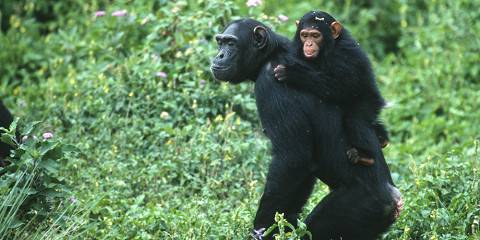
7-Day Netflix's Chimp Empire Safari, and Then Some
$2,888 pp (USD)
Uganda: Private tour Mid-range Lodge & Hotel
You Visit: Entebbe (Start) , Entebbe Airport (Entebbe) , Semuliki NP, Kibale NP (Chimps) , Lake Mburo NP, Entebbe (End)
Lush Africa Safaris Tour operator has an office in Uganda
4.8 /5 – 33 Reviews

7-Day Lake Bunyonyi, Wildlife, Chimps & Gorilla Safari
$3,003 pp (USD)
Rwanda & Uganda: Shared tour (max 7 people per group) Mid-range Lodge & Resort
You Visit: Kampala (Start) , Murchison Falls NP, Kibale NP (Chimps) , Queen Elizabeth NP, Bwindi NP (Gorillas) , Lake Bunyonyi, Kigali (End)
Safari 2 Gorilla Tours Tour operator has an office in Uganda
4.8 /5 – 49 Reviews

7-Day Gorilla, Chimpanzee Trekking and Wild Game Safari
$3,505 pp (USD)
You Visit: Entebbe (Start) , Kibale NP (Chimps) , Queen Elizabeth NP, Bwindi NP (Gorillas) , Lake Mburo NP, Entebbe (End)
Hail Tours Uganda Tour operator has an office in Uganda
4.9 /5 – 106 Reviews
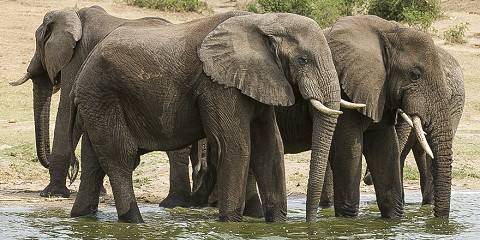
7-Day Wildlife, Gorillas and White Water Rafting Trip
$2,750 pp (USD)
You Visit: Entebbe (Start) , Queen Elizabeth NP, Bwindi NP (Gorillas) , Kampala (City) , Jinja (Town) , Entebbe (End)
Pamoja Tours and Travel (Entebbe, UG) Tour operator has an office in Uganda

7-Day Explore the Pearl of Africa Tour
$2,640 pp (USD)
Uganda: Private tour Budget Camping & Lodge
You Visit: Kampala (Start) , Kibale NP (Chimps) , Queen Elizabeth NP, Bwindi NP (Gorillas) , Entebbe Airport (Entebbe) , Kampala (End)
Bright Safaris Uganda Tour operator has an office in Uganda
5.0 /5 – 47 Reviews

7-Day Uganda Primate, Wildlife & Culture Adventure
$4,012 pp (USD)
Uganda: Shared tour (max 7 people per vehicle) Mid-range Lodge & Guest House
You Visit: Entebbe (Start) , Bwindi NP (Gorillas) , Queen Elizabeth NP, Kibale NP (Chimps) , Entebbe Airport (End)
Bujuku Eco Tours & Travel Tour operator has an office in Uganda
4.9 /5 – 10 Reviews

7-Day Murchison Falls, Queen Elizabeth & Gorillas Safari
$2,135 pp (USD)
Uganda: Private tour Budget Lodge & Tented Camp
You Visit: Entebbe (Start) , Murchison Falls NP, Queen Elizabeth NP, Bwindi NP (Gorillas) , Lake Bunyonyi, Entebbe Airport (End)
Ecovic Tours & Travel Uganda Tour operator has an office in Uganda
4.8 /5 – 44 Reviews
7-Day Your Gorilla Safari in the Pearl of Africa
$3,080 pp (USD)
Uganda: Private tour Budget Lodge & Resort
You Visit: Entebbe (Start) , Kampala (City) , Lake Bunyonyi, Bwindi NP (Gorillas) , Queen Elizabeth NP, Entebbe (End)
Mambo Gorilla Safaris Uganda Tour operator has an office in Uganda
4.8 /5 – 29 Reviews

7-Day Adventure Wildlife Safari in Uganda
$1,936 to $2,200 pp (USD)
Uganda: Private tour Budget Tented Camp & Guest House
You Visit: Kampala (Start) , Pian-Upe WR, Kidepo Valley NP, Murchison Falls NP, Ziwa Rhino and Wildlife Ranch, Entebbe (End)
Bushman Safaris Tour operator has an office in Uganda
5.0 /5 – 40 Reviews

7-Day Circuit of Primates and Wildlife
$2,912 pp (USD)
Uganda: Private tour Mid-range Camping & Lodge
You Visit: Entebbe (Start) , Bigodi Wetland (Kibale NP) , Kibale NP (Chimps) , Queen Elizabeth NP, Bwindi NP (Gorillas) , Lake Bunyonyi, Lake Mburo NP, Entebbe (End)
Hooves of Africa - Photo Safaris Tour operator has an office in Uganda
Related Searches
- 7-Day Safari Tours
- 2-Day Uganda Itineraries
- Tours from Entebbe
- Uganda Birding Tours
- 11-Day Uganda Safaris
- 7-Day Kenya Safaris
- 1-Week Uganda Gorilla Safaris
- 7-Day Tanzania Safaris
- 7-Day South Africa Itineraries
- 1-Week Kenya Tours
- 1-Week South Africa Safaris
- 1-Week Kenya & Tanzania Packages
7 Questions About 7-Day Uganda Tours

Answered by
Philip briggs.

Where should I go on a 1-week Uganda trip?
“By far the most popular 7-day itinerary focuses on Uganda’s southwestern cluster of national parks: Bwindi Impenetrable, Queen Elizabeth and Kibale. This southwestern loop is easily the recommended option if this is your first visit to Uganda and seeing gorillas and chimps is a priority. A variant itinerary that excludes gorilla trekking would focus on Ziwa Rhino and Wildlife Ranch, Murchison Falls National Park and Kibale National Park. For those who prefer to head seriously off the beaten track, a recommended alternative is an eastern loop that includes Ziwa, the fabulously remote but very rewarding Kidepo Valley National Park, a cultural tour in the remote Karamoja region, and a visit to lush Sipi Falls on the slopes of Mt Elgon.”
Is 7 days a good length for a tour in Uganda?
“One week is a good length for a Uganda safari and enough time to take in the main southwestern highlights. These include gorilla trekking in Bwindi, chimp trekking in Kibale, a boat trip on Queen Elizabeth NP’s Kazinga Channel, and a game drive in search of tree-climbing lions in the same park’s Ishasha sector. If possible, however, there’s a lot to be said for looking at a slightly longer safari. Many tours slot in an overnight stop at Lake Mburo National Park to break up the drive between Entebbe International Airport and the southwest, in which case we would recommend making it an 8-day safari. And if you want your itinerary to extend northwest to Murchison Falls and Ziwa Rhino and Wildlife Ranch without omitting any of the southwestern highlights, best pump up the total duration to 10 days.”
What animals can I expect to see?
“You’ll encounter a huge diversity of animals on a 7-day Uganda safari. If you follow the southwestern circuit incorporating Bwindi Impenetrable, Queen Elizabeth and Kibale National Parks, and do all the popular activities there, you’re all but certain to see mountain gorilla, elephant, buffalo, hippo and a bewildering variety of monkeys and birds. Less certain but also very likely are chimpanzee and lion, possibly even leopard and giant forest hog. Lake Mburo National Park is the only park in the southwest to support giraffe, zebra and impala. Elsewhere, for Big Five aficionados, Murchison Falls and Kidepo Valley National Parks both support lion, leopard, elephant and buffalo, as does Queen Elizabeth NP. Ziwa Rhino and Wildlife Ranch is the only place in Uganda where you can see rhinos.”
What kind of accommodation can I expect?
“Accommodation in Uganda caters to all tastes and budgets, and the kind of places you’ll stay on any given safari will depend on what you have paid. Most major attractions are serviced by at least one exclusive luxury lodge or camp comparable in quality to the finest elsewhere in Africa. There's also a good selection of mid-range and upmarket lodges, as well as budget-friendly guesthouses and simple but well-equipped campsites.”
What is the best time of the year for a 7-day Uganda safari?
“The best time for a Uganda safari is during the Dry seasons (June to August and December to February). These months offer the best climatic conditions for gorilla and chimp trekking and are also good for game drives in savannah reserves such as Queen Elizabeth and Murchison Falls. September and October are also quite good. March, May and November are rather less good, and we would urge against April, which is the wettest month in most of the country.”
How much will this safari cost?
“Budget to mid-range 7-day safaris that focus on the southwest and include gorilla trekking and chimp trekking typically cost US$2,300 to US$3,000 per person. This rate should include transport, accommodation, meals, park fees and permits relating to scheduled activities, as well as the services of a professional driver-guide. Cheaper camping tours are available, but if you book one of these, check carefully what is and isn't included in the price. Luxury tours using more exclusive accommodation generally cost upwards of US$4,000 per person.”
What beach extensions could be added to a 7-day Uganda safari?
“Uganda has no ocean frontage, so for a conventional post-safari beach experience, you’re best heading to the likes of Mombasa (Kenya) or Zanzibar (Tanzania). From Entebbe, there are no direct flights to either of these beach destinations, but it is straightforward enough to route through Nairobi for Mombasa, or through Nairobi or Kilimanjaro International Airport for Zanzibar. For a waterside experience within Uganda, bilharzia-free Lake Bunyonyi is a popular chill-out venue, thanks to its pretty highland setting, scattering of pleasant accommodation, and proximity to Bwindi Impenetrable and Mgahinga Gorilla National Parks (the country’s two gorilla-trekking destinations). Because Lake Bunyonyi lies in the far southwest, around nine to 10 hours’ drive from Kampala or Entebbe, it makes more sense to tag a visit directly onto a safari to Bwindi or Mgahinga than to make a separate trip there. For a more active experience about two hours’ drive east of Kampala or Entebbe, the Nile immediately downriver of its source near Jinja offers superb white-water rafting as well as kayaking, bungee jumping and quad biking.”
Uganda Reviews

Lizzie is a reputed guidebook writer and author of the Footprint guides to South Africa, Namibia, Kenya, Tanzania, Uganda and Zimbabwe.
Mountain Gorillas, Chimps and Birds in Lush, Well-Watered and Incredibly Green Hills and Valleys
Most of the superlative descriptions you read about Uganda are totally true: it really is a place of shimmering lakes, lofty mountains and mysterious forests. Uganda is best known as the place to see mountain gorillas, and no safari to the...
Full Review

Mark is a travel writer who grew up in Africa and has written over 700 titles for Condé Nast Traveller, Travel Africa, BBC Wildlife and others.
Fantastic Wildlife and Some of the Friendliest People in Africa Make Uganda Unbeatable
I spent a month travelling around Uganda with a self-drive, expedition-prepared Landcruiser and visited almost every national park in the country. Uganda was a revelation! I had not expected such a richness of wildlife nor such great...

Uganda is a true description nature and beauty thus the Pearl of Africa.
I truly recommend 👌 the adventure, it was really remarkable being one with nature an awesome feeling to cherish. The adventure indeed exceeded my expectations. Thanks team for your service to give us such unforgettable memories.

Unique experiance Uganda
After having been on Safari in Kenia and in South Afrika, we choose Uganda as a destination to experiance what we saw as the ultimate highlite in Safaris…… the chimpansee and Gorilla trekking in Uganda. We visited a week end of April,...

A Lush Oasis with So Much to See
My wife and I did a 5 day Uganda safari. Our guide, Francis, picked us up from our hotel in Entebbe and we drove several hours to start our trip at Queen Elizabeth National Park (QENP). Even though we visited during the rainy season, we...
Uganda is a perfect place to see the wild beauty of Africa, but also a very hospitable people!
We’ve been coming for years to Uganda to work among people in rural, impoverished villages. But this was the first time we had the opportunity to explore some of the natural beauty of Uganda. We’ve spent vacations in France, Hungary,...

- Uganda safaris
Uganda safaris – where & when to go, and what to do and see
Thinking of a Uganda safari? With the big five and some of the world’s best gorilla and chimpanzee trekking on offer Uganda is a safari destination that has it all. Now is a good time to go, as Uganda has yet to take off as a tourist destination in as large a way as many of it’s neighbours. This means safaris in Uganda can prove good value, with less crowds around when you get to the wildlife. It also has something of ‘the road less travelled’ feel about it.
Uganda is small by African standards at ‘just’ 236,000 km sq, around the same size as Great Britain. The country is lush and a verdant green, with one third of its borders made up of three of Africa’s Great Lakes, and the Victoria Nile running through the center. The East African tropical heat is tempered by an average altitude of 1,000 meters, with the east and west borders featuring significant mountains.
Self drive safaris are an option in some national parks in Uganda, though you will need access to a 4WD to get the most out the parks due to the clay tracks. ( Read some tips on driving in Uganda. ) If this sounds a little too much effort for you check out our guide to safari tour companies in Uganda to research a driver and guide or full-on tour.
The wildlife in Uganda doesn’t compare favourably in terms of density with it’s East African neighbours Kenya and Tanzania, but it is extremely diverse with over 500 mammal species alone. There are pockets with strong wildlife density – such as Murchison Falls National Park, which is relatively small with exceptional wildlife viewing – but the big safari draw in Uganda is the primate life. Uganda is probably the prime destination in the world for trekking opportunities to see habituated chimpanzee and gorilla families in the wild – a truly memorable experience, and one of the best walking safaris to be found anywhere.
Poaching and deforestation continue to be a problem in Uganda – as in much of the rest of Africa – and a recent oil discovery in Lake Albert has led to encroachment into a small area of Queen Elizabeth National Park. Despite this the general standard of national parks in Uganda is excellent, with good facilities, public transport access and range of lodgings, though infrastructure is not particularly developed. Tourist numbers in Uganda are much smaller than neighboring Kenya or Tanzania, meaning national parks are generally less crowded and offer a more enjoyable and intimate visiting experience.

Useful resources
Book a Uganda safari
Uganda Wildlife Authority
Official Uganda Tourism Office
Weather in Uganda
Uganda safari highlights
See gorillas in the wild.
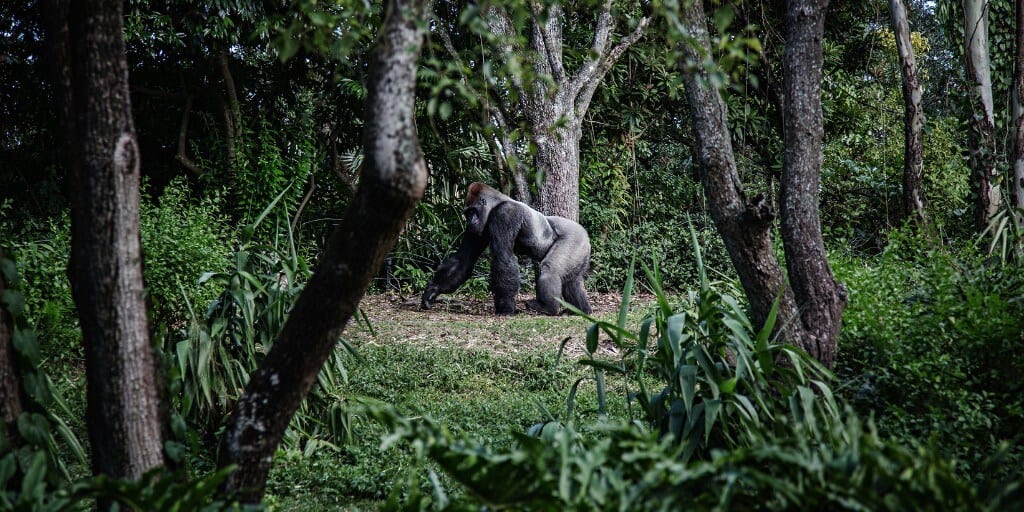
Trek through Uganda’s pristine, dense jungles in either the Bwindi Impenetrable Forest National Park or Mgahinga National Park to come face to face with a silverback mountain gorilla and his family. Possibly Africa’s #1 wildlife highlight.
Kick back lakeside
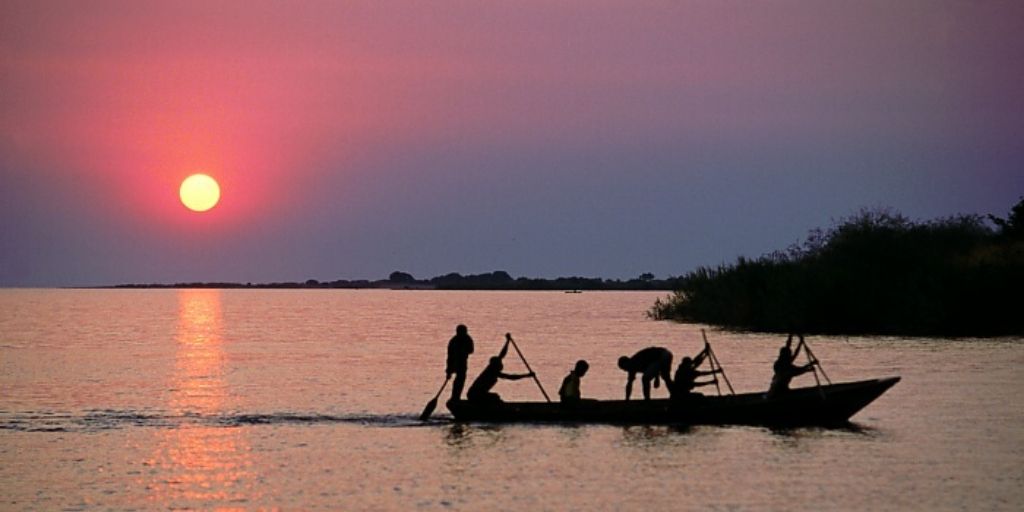
Take time out of your safari in Uganda to relax lakeside and soak up the ambiance on one of the many Great Lakes of Africa situated in Uganda – Lake Kyoga, Lake Victoria, Lake Edward or Lake Albert. Expect beaches, fresh fish and some local wildlfe appearances.
Big five spotting

Head up country to try and spot the big five animals , though you’ll need to mix your safari up and visit more than one national park. Rhinos are found only in Ziwa National Park, which is very close to the jewel of the Ugandan safari industry, Murchison Falls National Park, which is home to lion, leopard, buffalo and elephant.
See the power of the Nile
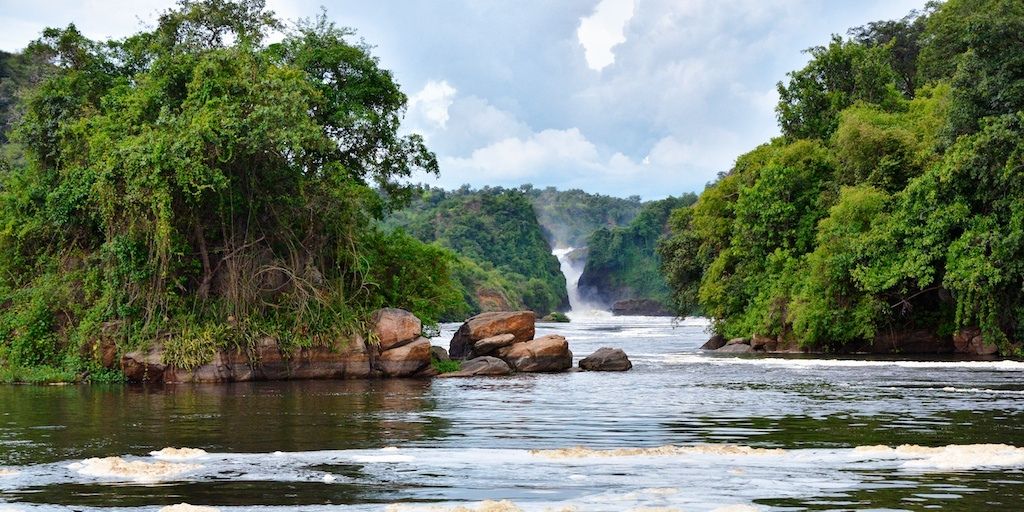
Murchison Falls is one of Uganda’s top tourist sites, where over 300 cubic meters of water each second passes through a narrow gap in the rocks to keep the Victoria Nile flowing between Lake Kyoga and Lake Albert. The park surrounding the falls and river is one of Uganda’s top wildlife destinations.
Best time to safari in Uganda
As a relatively small country with a consistent altitude, the majority of the country enjoys the same topical climate. In the higher mountainous areas to the east and west of the country it can get surprisingly cold at night times. If you’re planning a game drive.January and February are the hottest months when wildlife viewing is at it’s best.
As with the rest of East Africa there’s a ‘long rain’ and a ‘short rains’ season – March to May and October to November respectively. During the short rains it generally rains only for short periods at a time, meaning your wildlife viewing will not be too disrupted. Travel to most destinations during rainy season is possible, though you should leave yourself more time to get around.
Gorilla trekking is possible year-round, and you’re virtually guaranteed to see gorillas on any planned gorilla trek. However, bear in mind that the trekking terrain is tough going with dense forest and steep hills, so ensure you dress appropriately. See more hints and tips on gorilla trekking .
Flights To Uganda
Search, track and book flights to Uganda, from anywhere in the world.
Uganda Accommodation
Find safari accommodation in Uganda – from budget campsites to luxury lodges.
Uganda Car Hire
Considering a self-drive safari? Research and book car hire in Uganda.
Activities in Uganda
Search and book things to do in Uganda – tours, excursions and activities.
National parks in Uganda
Though Uganda doesn’t have as high a safari profile as neighbours Kenya or Tanzania, there’s still plenty to see and do… and often with far smaller crowds. As well as the big five, Uganda is home to more than half the world’s remaining mountain gorilla, and plenty of chimps. It’s also recognized as one of the best places for bird spotting in the world. Most national parks in Uganda have a good range of accommodation, and the parks are easily accessible, making Uganda a great place for a safari.
Top Uganda national park picks
Murchison falls national park.
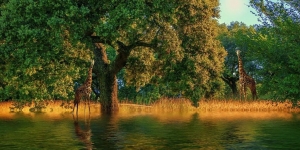
Uganda’s first national park, and it’s largest, Murchison Falls is home to 80 mammal species and over 450 bird species, and is the jewel in the crown of the country’s safari industry. The park is predominantly open savannah grasslands, which makes for top game viewing.
Kibale National Park
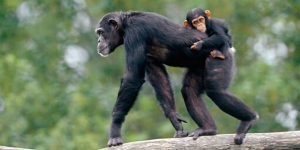
Kibale National Park’s evergreen forest in Western Uganda contains an array of landscapes and is home to 12 species of primates. Aside from the stunning vistas and virgin forest, the big draw here is the chance to see chimpanzees in their natural habitat, with both chimpanzee tacking and habituation experiences on offer year round.
Bwindi Impenetrable Forest National Park
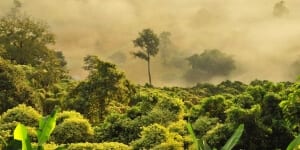
Meaning ‘darkness’, Bwindi’s magnificent forest is certainly dense, and has hundreds of diverse mammal species (and 200 hundred species of butterflies!) alongside the population of around 320 mountain gorillas. There are four different areas with accommodation in the park to track habituated gorillas – Buhoma, Ruhija, Rushaga and Nkuringo.
Mgahinga National Park
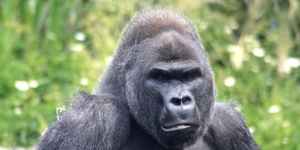
Uganda’s smallest national park – just 34 km sq – in the south west of the country is part of the larger Virunga Conservation area that also spreads across Rwanda and Democratic Republic of Congo. Gorilla trekking is the main activity here, though spending a few days in the park will also allow you to hike the Virunga Volcanoes for unparalleled views of central Africa, and track the endangered golden monkey.
All national parks in Uganda
Find all national parks in Uganda on the map below. Click the icons for more info.
Get Directions
Bwindi Impenatrable Forest National Park 331 km sq. Steep mountain rain forest with wide altitude span.
Kibale Forest National Park 795 km sq. Lush tropical rain forest.
Kidepo Valley National Park 1,442 km sq. Rolling savanna ringed by mountains.
Lake Mburo National Park 370 km sq. Savanna and wetlands surrounding Lake Mburo.
Mgahinga Gorilla National Park 34 km sq. Tropical rain forest covered extinct volcano.
Mount Elgon National Park Home to vast caves where elephants and buffaloes go by night to lick the natural salt found on the cave walls.
Murchison Falls National Park 3,893 km sq. The Murchison Falls and Nile river running through thick forest and savanna.
Queen Elizabeth National Park 1,978 km sq. Savanna and gorges bordering Lake Edward.
Rwenzori Mountains National Park Established in 1991 Rwenzori was designated a UNESCO World Heritage Site in 1994 due to its outstanding natural beauty.
Other Uganda safari resources
Uganda safari companies.

Uganda is still an up and coming safari destination for main-stream tourists. At the moment visitors tend to be either high end package tourists there to see the gorillas or overland backpackers. As such the types of safari your companies in Uganda reflects this. Read our reviews of safari tour companies in Uganda .
Uganda safari lodges
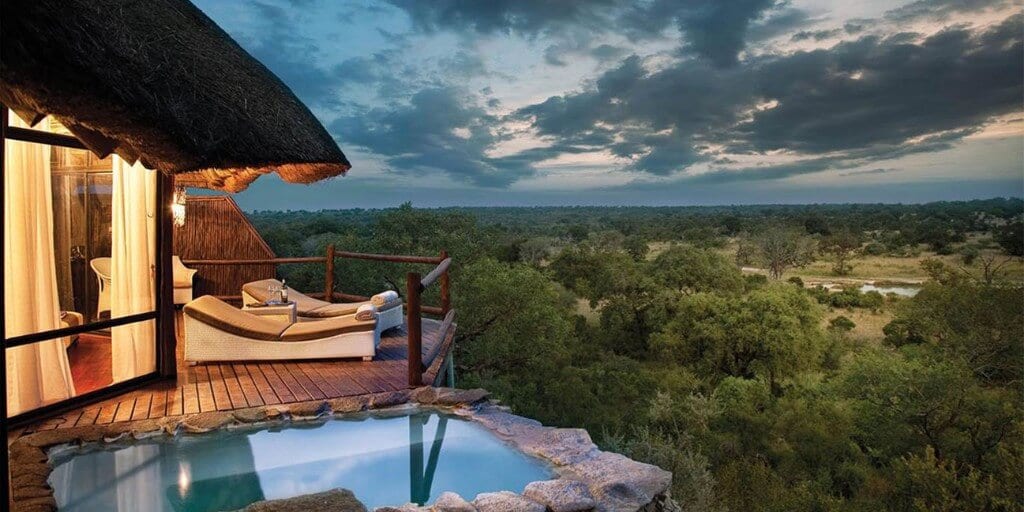
Budget safari accommodation in Uganda is centered around a few small towns and villages on the fringes of national parks. If you’re willing to splurge then Uganda does offer some truly luxurious safari in and around the parks. Mid-range safari accommodation is a little harder to find. Search and book accommodation in Uganda or use the map below.
Search all Uganda accommodation
Read safari guides to all countries.
Botswana safaris , Namibia safaris , Rwanda safaris , South Africa safaris , Tanzania safaris , Uganda safaris , Zimbabwe safaris
Do you have any experience of planning or going on safari in Uganda?
We’d love to hear any feedback or tips you may have – please get in touch , or add to the comments below.
Top countries for safaris
- Botswana safaris
- Kenya safaris
- Namibia safaris
- South Africa safaris
- Tanzania safaris
Safari basics
- Safari animals
- How to find the right safari company
- When to go on safari
- What to take on safari
- Safari clothing – what to wear
- Safari rules & etiquette
- Wildlife spotting tips
Most read articles
- All about the ‘big five’ animals
- Collective nouns for animals
- Safari movies to watch before you go
- The world’s fastest land animals
- Apex predators
- 10 Fascinating African tribes
- The biggest animals in the world
- 17 Epic hybrid animals
- The world’s ugliest animals
- Why are flamingos pink?
Africa’s best game reserves
- Chobe National Park, Botswana
- Etosha National Park, Namibia
- Kruger National Park, South Africa
- Masai Mara National Reserve, Kenya
- Moremi Game Reserve, Botswana
- Okavango Delta, Botswana
- Serengeti National Park, Tanzania
Session expired
Please log in again. The login page will open in a new tab. After logging in you can close it and return to this page.
- Central African Republic
- Democratic Republic Of Congo
- Indian Ocean
- Republic Of Congo
- South Africa
- Latin America
- Galapagos Islands
- North America
- Polar regions
- Arctic Canada
- Australasia
- Gorilla Tracking
- Grizzly Bears
- Polar Bears
- Puma Tracking
- Snow Leopards
- Blue Whales
- Bengal Tigers
- Siberian Tigers
- African Lions
- Spirit Bears
- Lowland Gorillas
- Experiences
- Jungle Holidays
- Bush and Beach Combinations
- Conservation Travel
- Natural World Heroes
- Work with Us
- Consumer Protection Overview
- Privacy Policy
- Press and Awards
- Client Reviews
- Expedition Leaders
- Specialist Leaders
- Expeditions for Change
- Journey to Natures Edge
- Country: Settings: Country:
- Currency: Currency:
- Call Us (619) 975-8082
- Destinations
- Gorilla Trekking
- EXPERIENCES
- In the Press
- Journey to Nature's Edge
Uganda Wildlife Safaris
Uganda is an incredible destination for all-round wildlife-watching. A plethora of experiences can be enjoyed, against a stunning backdrop of volcanoes, crater lakes, fog-filled forests, reed-lined channels and lush savannah.
A relatively small country, Uganda landscapes are intense – and this means its wildlife offering is unexpectedly huge. Mountain gorillas are its most famous inhabitant, of course, and they are what lures many safari-goers here. Chimpanzees, baboons, lions, hippos, elephants, eagles, buffalos, rhinos... keep flicking through your field guides, and there are few creatures you won’t find shuffling through Uganda’s rainforests, swamps and grasslands.
Mountain Gorilla Tracking
Uganda is widely known for its mountain gorilla population - a key draw to the country. With just over 1,000 of these gorillas left in the world, over half of these can be found on Uganda’s western edge, in the verdant Bwindi Impenetrable National Park.Working with our expert local guides, we take you on a journey through the bush for anything from 2 to 10 hours in Bwindi Impenetrable Forest (Buhoma, Mgahinga or Nkuringo) in search of this amiable primates. Permits are limited and you will only be able to spend up to an hour in the company of these majestic animals before heading back to your lodge with the tale of a lifetime.
Chimpanzees
These apes are our closest living relative (aside from bonobos) sharing approximately 98.8% of our DNA. Tracking the closest primate to mankind, the chimp, is a thrilling experience as they swing through the forest, drum on buttresses, and hoot to their fellow troop members. Despite their noise, they can be fairly elusive and hard to spot! To see them in slightly less strenuous circumstances, the Ngamba Island Chimpanzee Sanctuary offers an incredible opportunity in the near-wild circumstances and by visiting you will contribute to the conservation of their habitat and, indeed, the species survival.
Whilst out on safari in Uganda, any tourist will quickly learn to keep personal belongings out of the reach of nimble-fingered baboons. Highly intelligent, these primates can jump through open windows in safari vehicles and grab a packed lunch for a quick snack. Baboons however are not the only smaller primates seen in Uganda. Ververt monkeys, black and white colobus and golden monkeys can all be spotted in national parks.
Read about Encounters with Primates

Safaris & Planning

Classic Uganda Safari
Explore the awe-inspiring lands of Uganda in this small group itinerary; track the mountain gorillas, chimpanzees and the famous tree-climbing lions.

Luxury Uganda Safari
Spend your time in Uganda immersing yourself in a true primate focussed safari, staying in the best accommodations on offer. Begin with your chimpanzee tracking experience before heading to the famous Bwindi Impenetrable National Park.

Short Uganda Safari
With only a short time to get away, this is the perfect trip which you will always remember. Fly inyo Entebbe and straight onto Bwindi Impenetrable National Park so you can start tracking the gorillas the next day.

The Big Five
There is no need to leave Uganda if you fancy to add on a big game safari to your holiday. Queen Elizabeth, Murchison Falls and the remote Kidepo Valley National Parks are all home to four of the Big Five: lions, leopards, buffalo and elephants. The latter two are widely seen on river cruises and game drives.
Lions are rare to spot, naturally, and well camouflaged, but with an experienced guide there’s a decent chance of spotting them lounging in the sandy grass, or perhaps sprawled in the branches of a fig tree in Ishasha – one of only two places in Africa where these felines are known to climb trees.
Where To Go
Our top places to go in uganda.

What to Expect from Wildlife in Uganda?

Birds of Uganda
Uganda is a haven for a multitude of avian species. For a country the size of the United Kingdom, Uganda has over 1,000 species of bird! Twitchers flock to this country in search of the shoebill, a rather prehistoric-looking stork standing at over a metre tall with an enormous bill and steel-coloured feathers. Rarely seen, this incredible bird can be found in the wetlands of Murchison Falls National Park and is one of the best places on Earth to catch sight of it. Other iconic species include the grey-crowned crane, giant kingfishers, red-throated bee eaters, African fish eaters and goliath herons.

EAST AFRICA
Southern africa, wildlife safaris, unique experiences, featured destinations.
- 60+ Travelers

Uganda Safaris
Insight Safari Holidays takes you to Uganda to visit the mountain gorillas and lots of wildlife in the 10 National Parks. Our Uganda safaris include gorilla trekking to a game drive to see the big five or cultural experiences we got you covered.
Are you a solo traveller seeking fulfilling personal experiences or a couple on a safari to Uganda? How about a group of friends or a family affair , we tailor every safari to suit your needs and preferences.
28 Popular Uganda Safari Packages

12 Days Uganda Safari, Visit Bwindi, Murchison & Kibale

10 days Uganda Safari Wildlife, Gorillas & Chimps
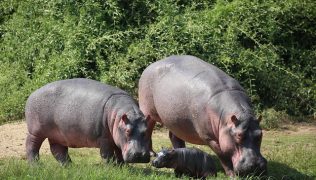
9 Days Uganda Safari Covering The Best Parks
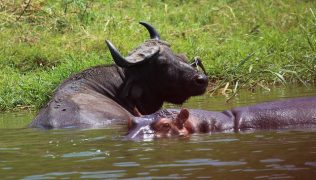
6 Days Uganda Gorilla Tour & Wildlife
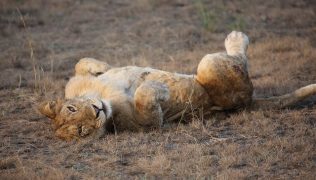
5 Days Bwindi, Lake Bunyonyi and Lake Mburo
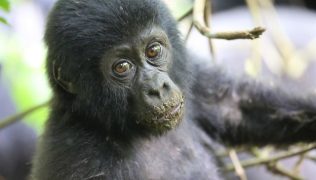
5 Days Uganda Safari, Gorillas & Chimpanzees
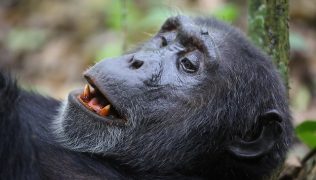
5 Day chimpanzee Wildlife safari in Uganda

4 Days Uganda Safari, Gorilla and Chimpanzee
4 Days Gorilla Tour, Double Visit

3 Day Trip Lake Bunyonyi Tour Uganda
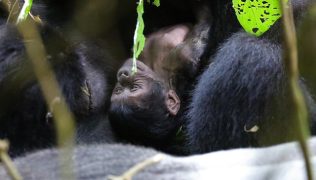
3 day Queen Elizabeth Uganda Safari
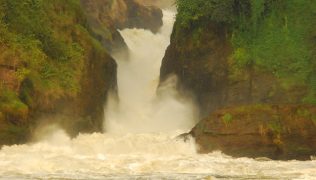
2. Witness the Big Five Animals on Thrilling Game Drives & Boat Cruise (Uganda Wildlife Safaris)
Queen Elizabeth National Park and Murchison Falls National Park is a paradise for wildlife enthusiasts filled with amazing and varied safari wildlife. National parks provide the chance to see the famous Big Five animals close-up, with an array of intriguing animals. On adrenaline-filled game drives across the vast savannah of Queen Elizabeth National Park , guests will encounter magnificent elephants, fierce lions the elusive leopards, majestic rhinoceroses, and elegant buffaloes.
Murchison Falls National Park named for the majestic falls, provides breathtaking cruises on boats which allow you to admire the magnificent Nile Crocodiles basking on the banks of the river, see hippos in groups splashing in the river and glimpses of the swift African water buffalo, and the massive Giraffes on the shoreline.
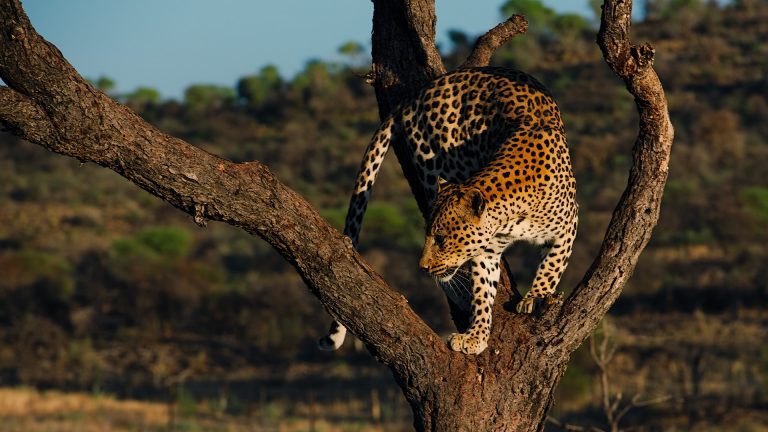
3. Authentic Local Cultural Experiences Await!
Find out about 60 different cultural traditions in Uganda, the native languages, local crafts as well as African music and dance! You will connect with the local people including Buganda which has a vibrant culture and rich history, to traditional pastoralist Karamojong people in northern Uganda, and their distinctive livestock herding culture. Every region in Uganda has a unique display of culture.
Enjoy Uganda’s colorful traditional rituals such as the entertaining Kiganda dance or Banyankore Cow milking ritual, in which rhythmic dance and music accompany the locals. Taste the delicious cuisine of Uganda, such as matooke (steamed green bananas) and oluwombo (traditional stew) as well as Rolex, a chapati wrap. Visit the local markets or craft centres to see Ugandan craftsmen weaving intricately-woven baskets, vibrant textiles and exquisitely carved wooden artefacts.
See Cultural Safaris in Uganda
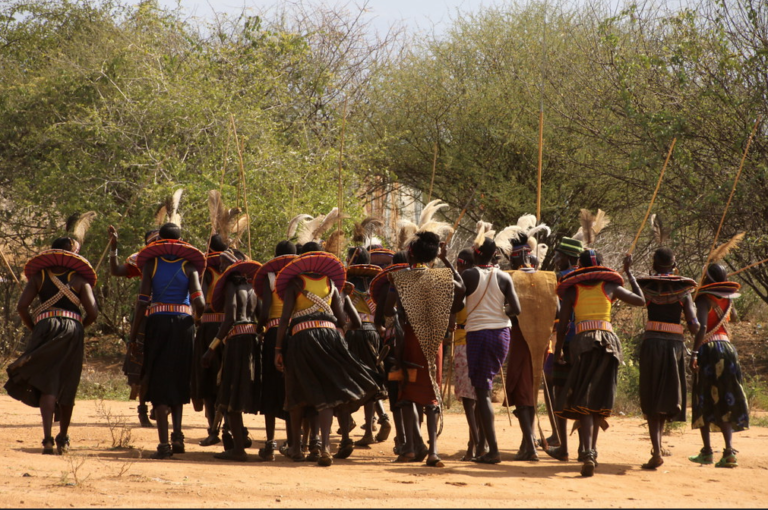
3. Uganda Safari Holidays: Sightseeing Lakes, Rivers, and Mountain Ranges
Lake Bunyonyi, the 2nd deepest lake in Africa is located in south-western Uganda between Kisoro and Kabale, near the border with Rwanda. Its name means “place of many little birds” Composed of 24 Islands, it has a historical and cultural heritage making it one of the holiday destinations in Southern Uganda.
Lake Victoria is the largest lake in Africa and the second largest freshwater lake in the world by surface area, after Lake Superior in North America. It covers an area of about 59,947 square kilometers. Fishing and other water activities can be enjoyed on the lake with over 200 species of fish.
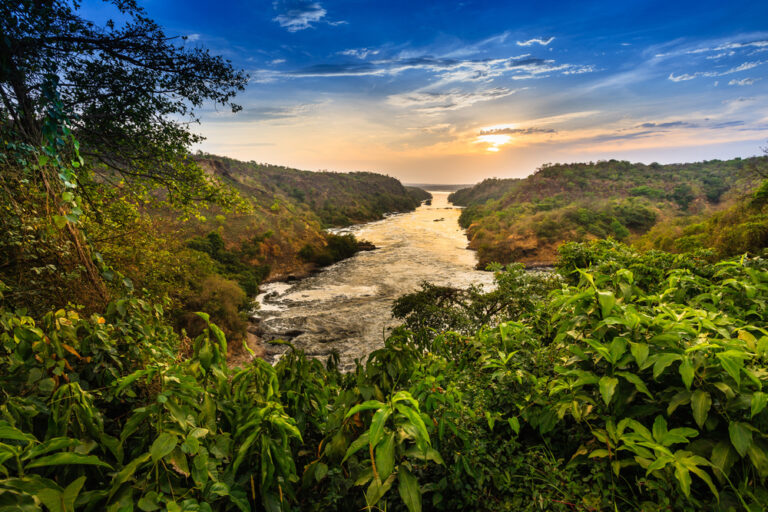
Tell us about your ideal trip *
Where to go in uganda, the best uganda safaris.
Find the best safari destinations in Uganda.
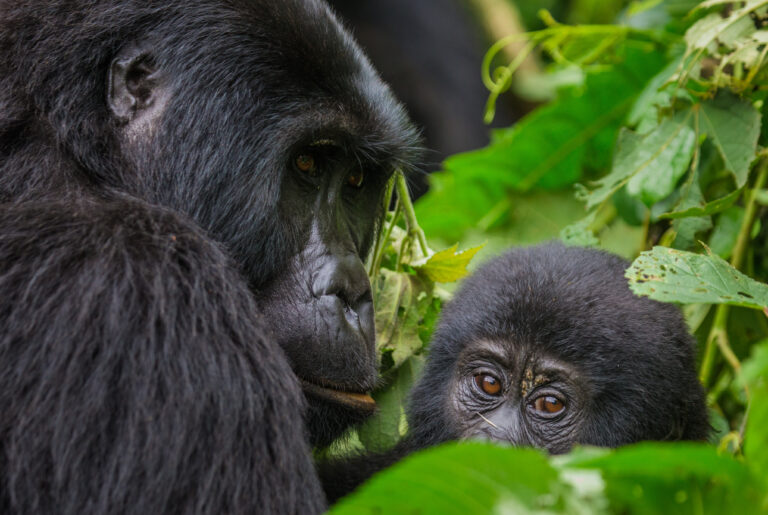
Mgahinga Gorilla National Park Safari Uganda
Mgahinga gorilla national park is the smallest wildlife park in Uganda. It is found in the south western corner of the country in the Virunga Mountains. It covers the northern slopes of three of three of the Virunga volcanoes namely; Mt Muhavura, Mt Sabinyo and Mt Gahinga. It is famous for the mountain gorillas that […]

Amabeere Ga Nyina Mwiru Caves Tour Safari Uganda
The Amabeere Ga Nyina Mwiru Caves are one of the most interesting sights in western Uganda.
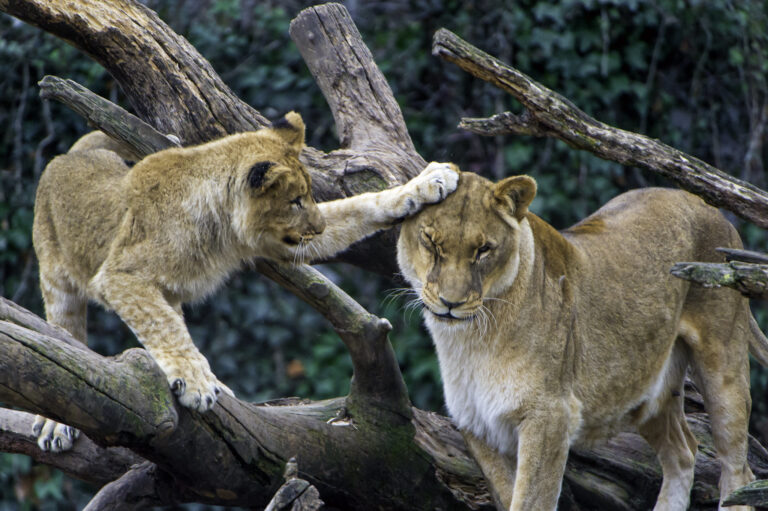
Queen Elizabeth National Park Uganda Safari Adventure
The most loved safari experience is the lion tracking in Queen Elizabeth National Park. -95 mammal species -Best for game drives in Kasenyi tracks, North Kazinga and Ishasha sector. -Lions, Buffalo, antelope, elephants, warthogs, baboons and more. -600 bird species.

Kibale Forest National Park Uganda Safari
-Famous for chimpanzee tracking. Covers 795sq kms, 1590m above sea level. -70 mammal species., elephants, red and blue duikers, giant forest hogs, buffalo, sitatunga and bushbucks. -13 primate varieties; chimps, baboons, white and black colobus. -325 species of birds., Green tinker bird, Africa and green breasted pitas, African grey parrot, Ground Thrush (Turdus Kibalensis) endemic to Kibale Forest National Park. -Over 250 tree species. -Areas of interest include Bigodi Wetlands, Kanyanchu and Sebitoli.
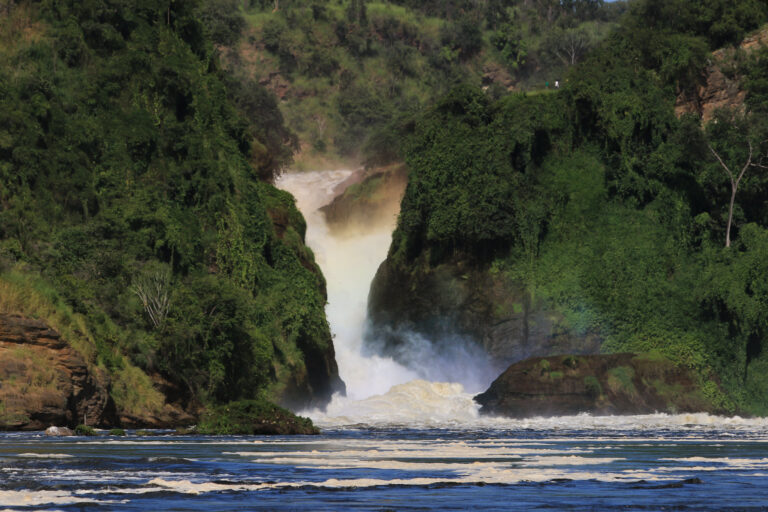
Murchison Falls National Park Uganda
Murchison Falls National park is one of the largest National parks in the country with 76 different animal species count and about 450 bird species that you will see on a wildlife safari in Uganda. -80 km stretch of rapids and falls. Nile squeezes through an 8m wide gorge. – 76 mammals, Four of the “big five animals” found here. Lion, Buffalo, elephants and leopards. Other animals include Uganda kob, waterbucks, warthogs, hippos, giraffe and Jackson’s hartebeest. -Primates include Olive baboons, 800 chimpanze in Budongo and Kaniyo Pabidi forests. The best uganda safaris are done here.
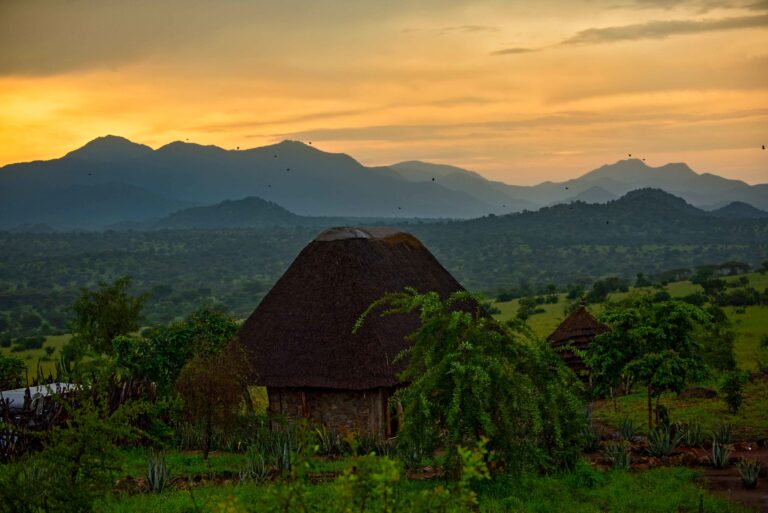
Kidepo Valley National Park Uganda Trips
Kidepo Valley National Parkboasts of 77 different species of mammals and about 463 bird species. The list of Uganda wildlife safari animals that live inside this park is quite exciting and different from other parks in Uganda.
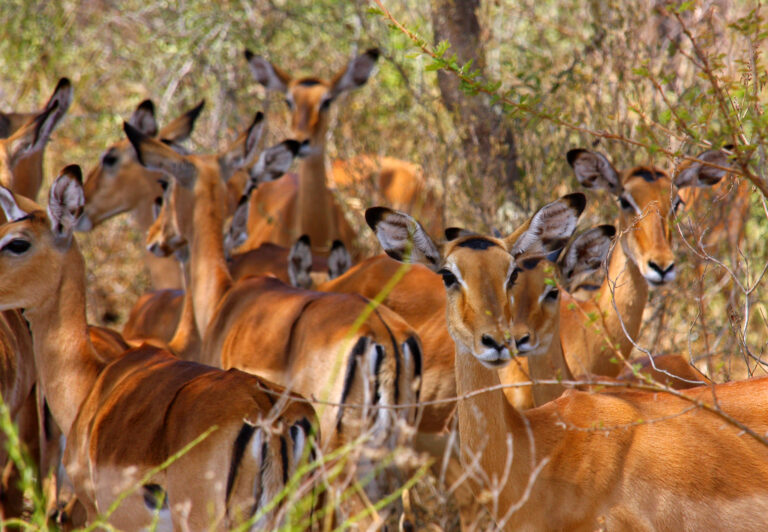
Lake Mburo National Park Uganda
68 various mammal species have been recorded within Lake Mburo National Park, approximately 313 different bird species among which is the crested crane found on the national emblem of Uganda found in this are covered with thick acacia woodland plus savannah 158 sq miles; this park generally has a varied fauna in comparison to other wildlife reserves.

Bwindi Forest National Park Safari Uganda
Bwindi impenetrable forest national park is famed for estimated 320 endangered mountain gorillas, ( Gorilla Berengei, Berengei) -120 mammals -Primate Species, baboons, chimps, -350 bird species, 23 belonging to Albertine Rift endemics. -Discover the Batwa Pygmy cultures.

10 Days Mount Rwenzori Climbing & Wildlife Adventure
Trekking the Rwenzori Mountains which involves hiking to the highest peak- Margherita which is at an altitude of 5,109m.
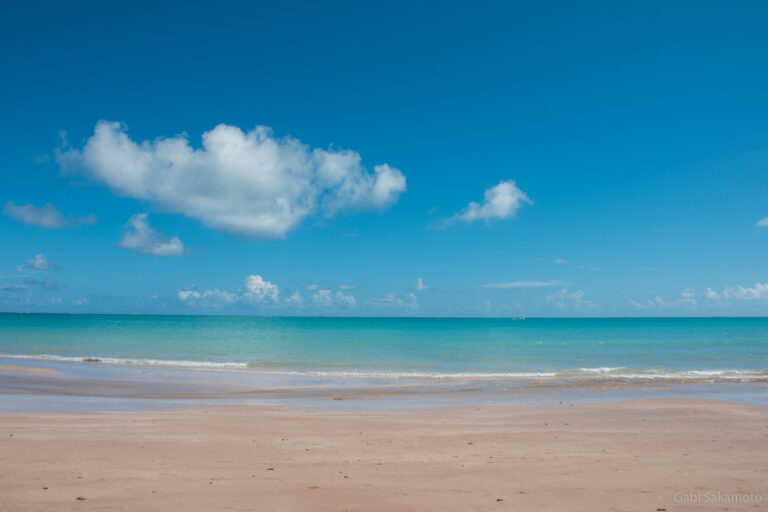
Ssese Islands Tour Uganda, Uganda Beach Holidays
Visit Ssese Islands in Kalangala, beach relaxation, boat trips, forest walks and sunbathing.
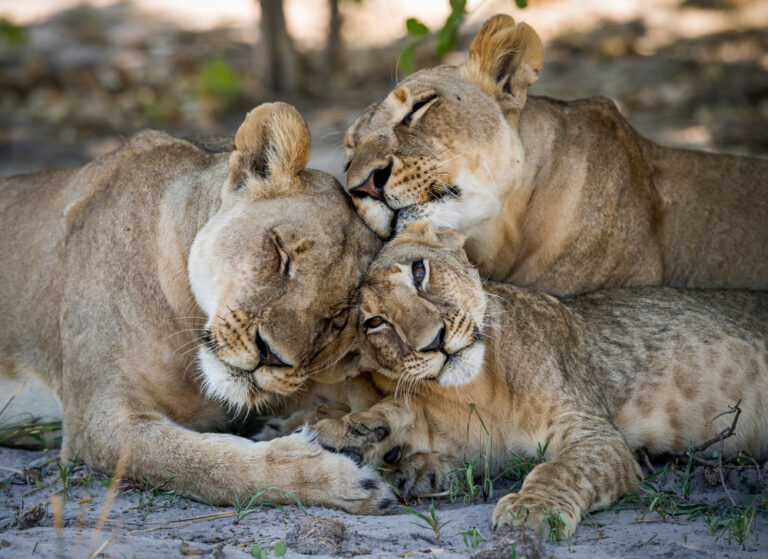
Pian Upe Wildlife Reserve Safari Uganda
Pian Upe Game Reserve is found in the North-eastern part of Uganda, North of Mountain Elgon and covers a series of districts like Amudat, Moroto, Katakwi, and Nakapiripiriti. It is the second-largest Game Reserve after the Murchison falls National Park covering over 2043 kilometers squared. The Reserve was first gazetted in 1985 at started as […]
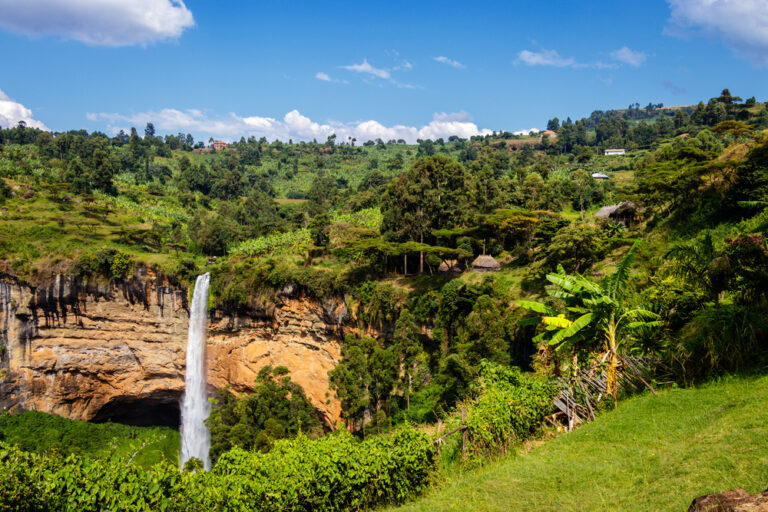
Sipi Falls Uganda Tour
Sipi falls is nestled in the Eastern part of Uganda in Kapchorwa district near Mbale district. It is located at least 277 kilometers away from Kampala and they are found at the edge of Mountain Elgon National Park. The word Sipi was derived from the ‘sep’ a wild banana that grows along the River Sipi. […]
Best Things To Do in Uganda
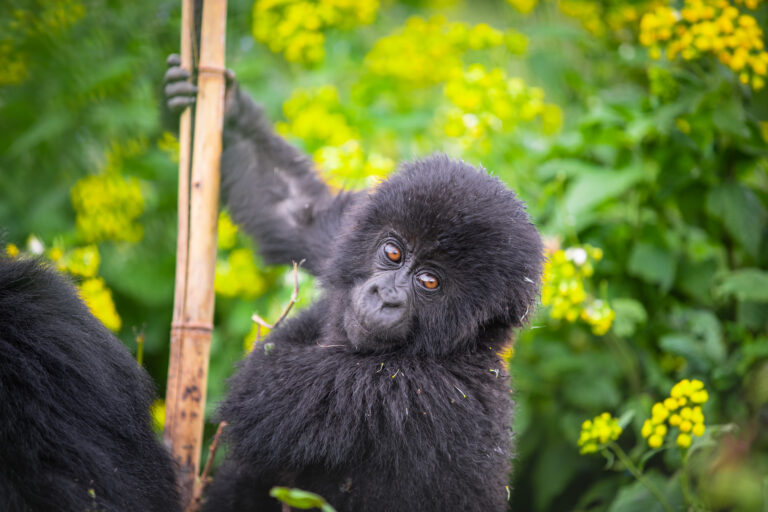
Gorilla Trekking in Uganda, Gorilla Safari Packages
Mountain gorilla trekking/ Gorilla tracking; this is the main highlight of Uganda trips. It’s also the main reason why people travel from their home countries to Uganda. Bwindi has the highest population of gorilla in the world. You engage in gorilla tracking for 60 minutes as you take pictures and observing their way of life within the forest, The mountain gorilla silver back taking care of its family. These endangered mountain gorillas share their 95% of their DNA with that of the humans, which makes them a must see attraction on any safari.You can see the gorillas of Africa,in Virunga
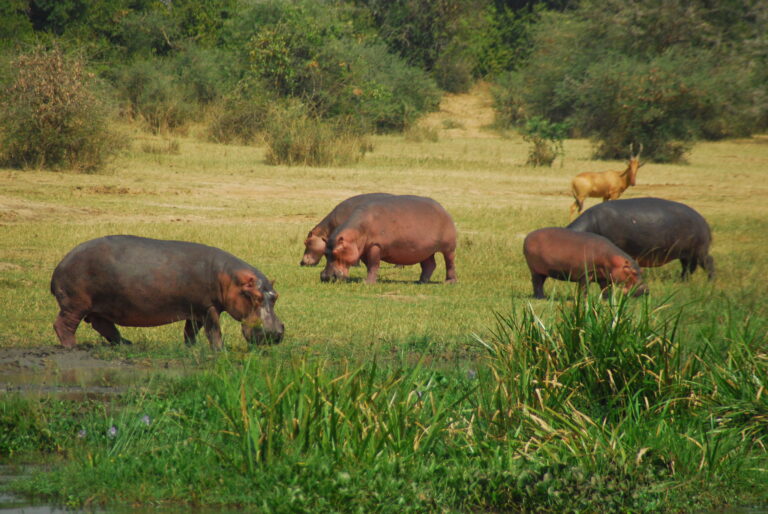
Uganda Budget Safaris
Budget Safaris Factors Determining the Budget Of Your Safari to Uganda The Duration Of Your Uganda Safari The duration of your Ugandan safari plays a role, in determining the budget needed. According to the Uganda Wildlife Authority, a short but fulfilling experience in Uganda usually requires around 4 5 days. However with this timeframe you […]
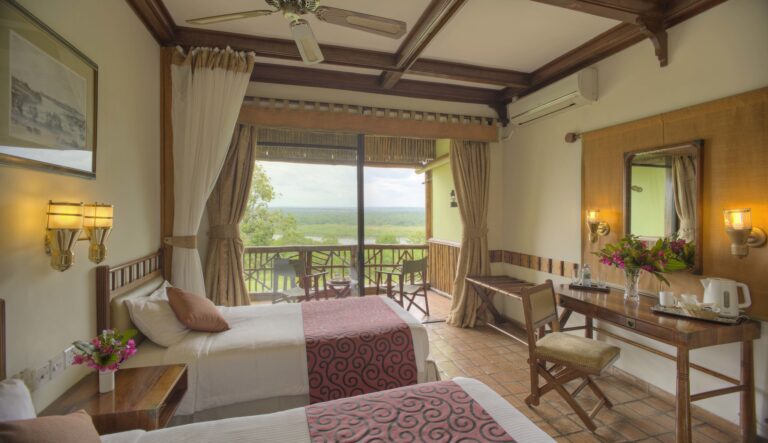
Uganda Luxury Safaris
Luxury Safaris Gorilla Trekking Luxury Lodges in Bwindi Impenetrable Forest National Park Bwindi Impenetrable National Park, located in the region of Uganda is a UNESCO World Heritage site renowned for being the sanctuary of more, than half of the worlds remaining mountain gorillas. Spanning across an area of 331 kilometers this ancient rainforest is characterized […]

Tree Climbing Lion Safari Uganda
It is much easier to catch sight of a tree climbing lion in Ishasha than any of the other places where the lions are found. In ishasha they can be seen in sycamore trees and can often be spotted on a game drive.
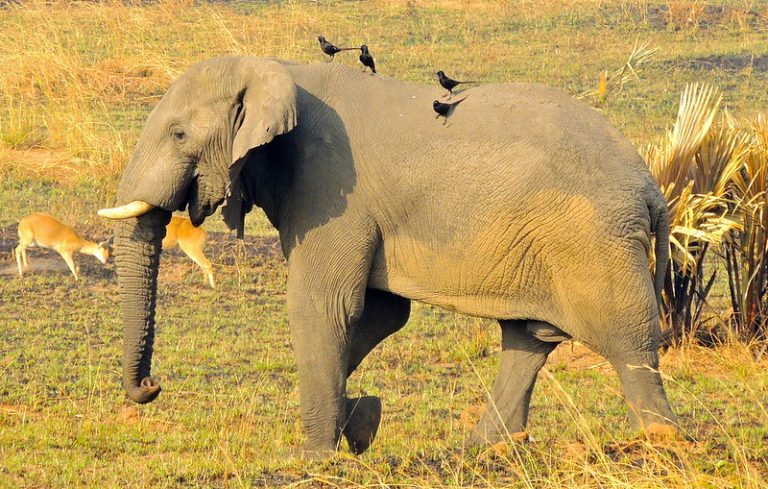
Uganda Photo Safari Tour
A Photographic safari in Uganda is a very unique experience. Abundant wildlife viewing, long days, different environments, changes of weather and variable Geography all offer special and excellent opportunities for a remarkable photography experience. Today many tourists engage in these safaris since it is one of the best ways to capture and at the same […]

Mount Rwenzori Climbing
The high Mountain Rwenzori comprises of six different mountains. Although it is located only a couple of miles north of the equator crossing, Mount Stanley is the highest of all standing at a height of 5,109 meters, Baker standing at a height of 4843 meters and then Speke towering at 4890 meters and fascinating about these is the fact that each f these peaks is entirely covered by non-seasonal glaciers. These peaks can be reached by hiking the Central Circuit trail or the Kilembe Trail.

Mount Elgon & Sipi Falls Safari To Uganda
Mount Elgon National park is situated close to Mbale in Eastern Uganda. It covers a total land expanse of 1145 sq km. the park was named after the most significant natural feature – Mount Elgon that stands at a height of 4321 meters; Mount Elgon is an extinct Volcanic Mountain found on Uganda’s border with Kenya.
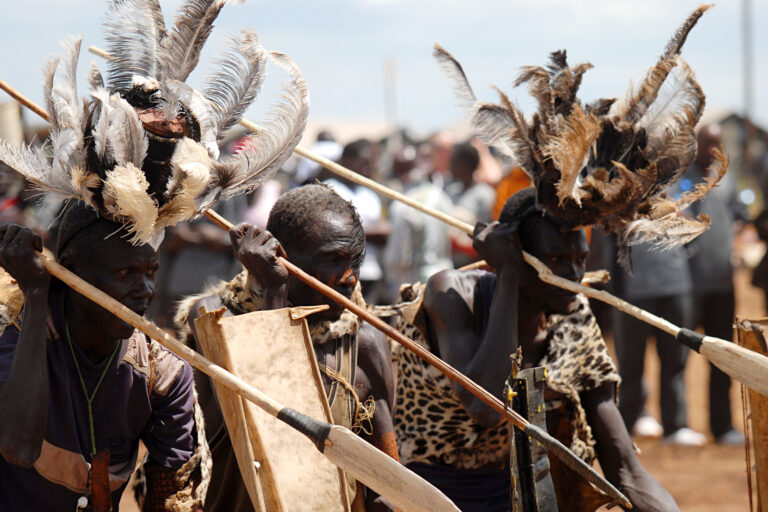
Uganda Cultural Tours
Uganda has a very rich and diverse cultural background with several cultural sites found in different parts of the country. There are very many different tribes in Uganda and almost each tribe has a chiefdom or kingdom and they all have rich cultural practices.
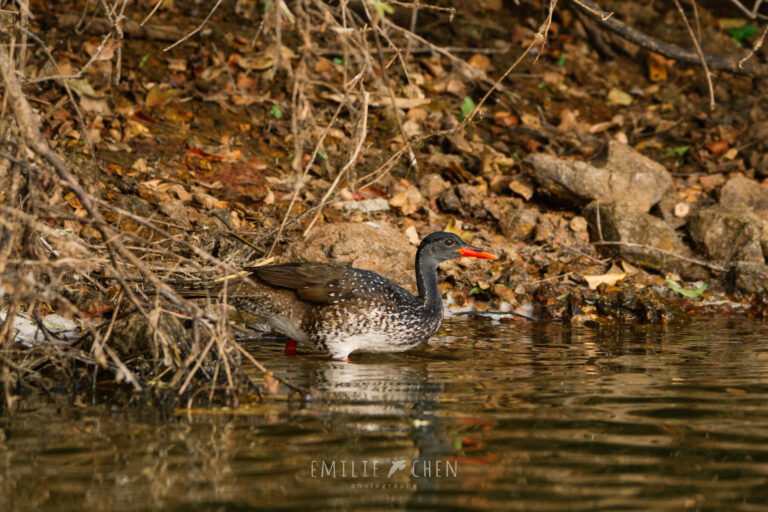
Birding in Uganda
There are over 1000 recorded bird species in the country and these are found in different parts of the country. The country has migratory birds that fly in during the wet season, endemic birds, Albertine rift valley endemic birds and near-endemic birds. Some of the top birding destinations include Bwindi Impenetrable National Park, Queen Elizabeth National Park, Semuliki National Park, Mabamba Bay, Murchison falls National Park and Lake Mburo National Park among others.

Honeymoon Holidays in Uganda
Visit Uganda's romantic destinations such as Murchison Falls, Lake Bunyonyi, Queen Elizabeth and more. See wildlife, trek the gorillas and relax at Ssese Islands.
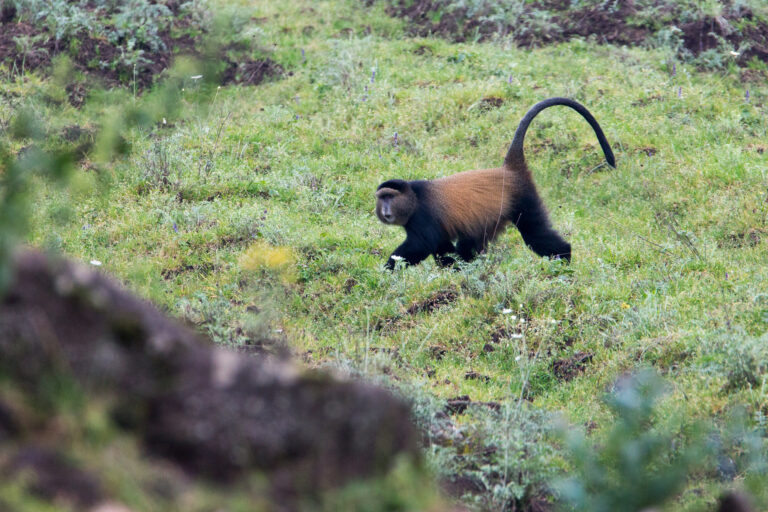
Golden Monkey Trekking in Uganda
A guide to golden monkeys in Uganda, how and when to visit Mgahinga gorilla park, trekking costs, how to book and general travel tips.
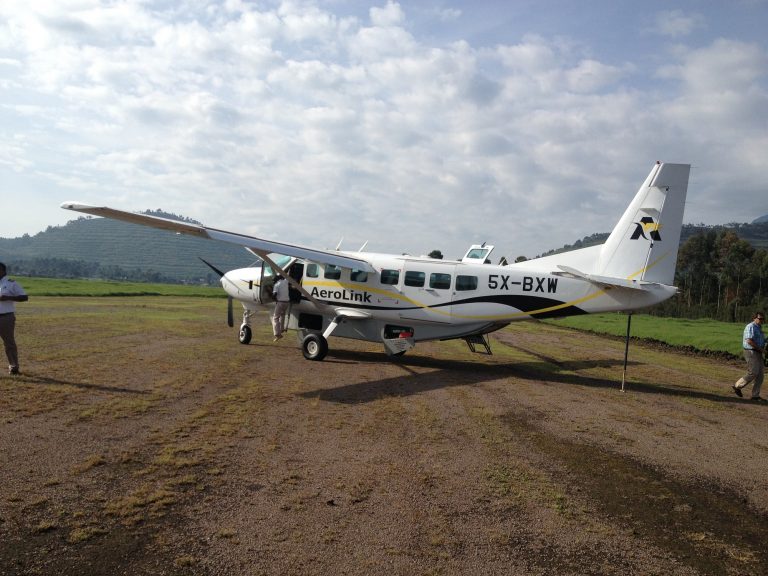
Fly In Safaris Uganda
The different parks and other safari destinations always receive direct flights mostly from Kajjansi air strip and these flights provide the tourists with the perfect view of Uganda from the skies and it also helps avoid the hustle of the daily jam that is constantly seen in the country and You are always escorted by a trained tour guide on the fly in safaris.
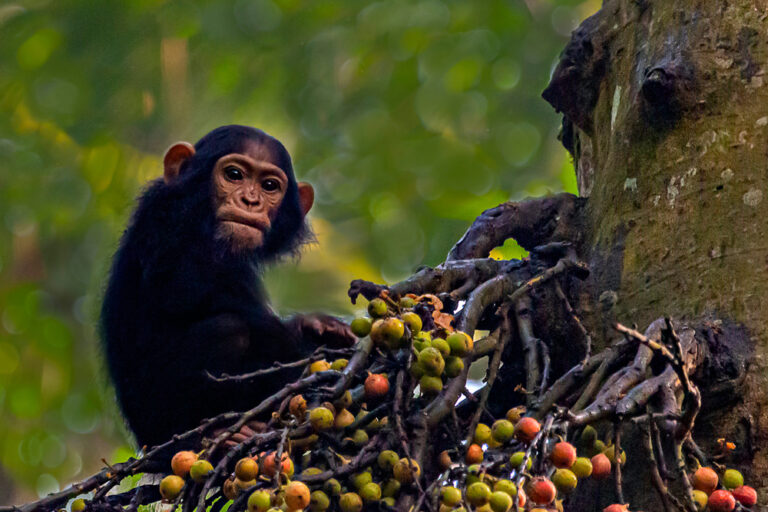
Chimpanzee Trekking in Uganda, Primate Safari
These can be trekked in Kibale National Park, Queen Elizabeth National Park in Kyambura Gorge in Maramagambo Forest and in Budongo Forest inMurchison falls national Park. Chimpanzee habituation can also be done from Ngamba Island Sanctuary on Lake Victoria. Kibale forest national park harbors the most number of Chimpanzees and it has over 13 different primate species including; chimpanzees, monkeys including; La Hoest’s monkeys, vervet monkeys, and red tailed Colobus monkeys. Chimpanzee habituation can also be done and sets out every morning to specifically observe and study the general behavior of chimps with the main aim of making them used
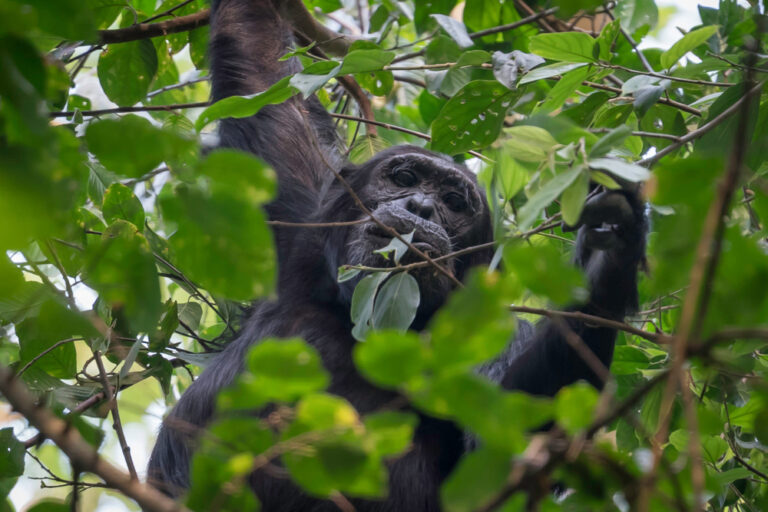
Uganda, Primate Watching in Africa
A guide to watching the primates of East Africa, Uganda, Kenya, Tanzania and Rwanda.
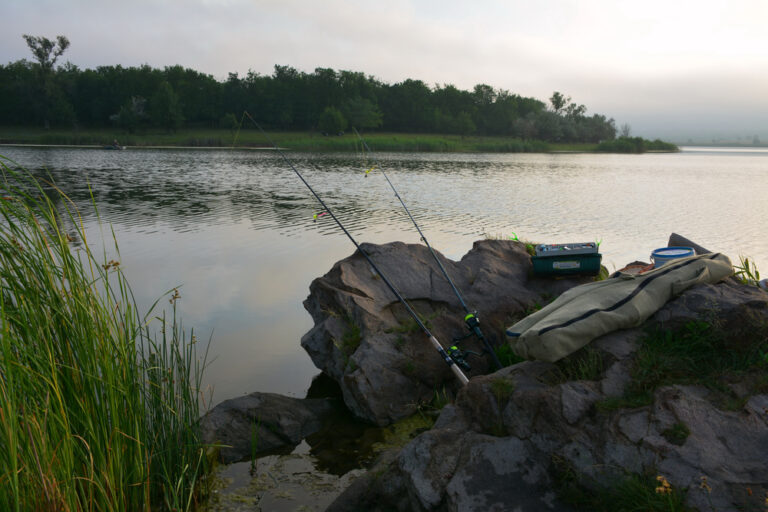
Fishing Trips
Lake Victoria is the world’s second largest fresh water lake and the largest in Africa, it is shared by Uganda, Kenya and Tanzania. Other lakes that are great sites for fishing safaris in Uganda include; Lake Edward, Lake George, Lake Albert, and the swampy Lake Kyoga among others. The River Nile also offers great opportunities for fishing, it is the second longest river in the world.

African Village Tours Uganda
Most villages in Uganda still hold their traditional way of life and many still follow the way their ancestors lived; it is evidenced by the traditional rituals, music, dance and drama, traditional way of harvesting, food preparation and cooking, among other things. Some of these villages have been mentioned below to guide you on which to visit. The most amazing thing about it, is that all these villages are located in the famous tourist sites such as National Parks, Forests, and Lakes among others.

Sightseeing Tours In Uganda
Uganda has 10 National Parks, a number of game reserves, wildlife sanctuaries among others where a number of wildlife have found habitation. So these places offer the best to sightseers. In Murchison falls, Queen Elizabeth, and Lake Mburo National Parks tourists can enjoy game drives, boat cruises, sport fishing, nature walks, birding, and in some of these parks you can spot the Big 4 if you are lucky. Queen Elizabeth National Park even offers an opportunity to spot the climbing lions in the Ishasha sector.

Uganda Food Tours
Compared to other foods, African cuisine is very unique both in the kinds of foods served and how it is all prepared. In Uganda, meat and fish and almost all the produce grown are organic. Uganda is a small country yet very big in terms of its culture. The country has over 45 tribes and most of these tribes have distinctive and unique foods. In order for you to have the best stay in Uganda, we have prepared information about the main foods grown, prepared, served and sold in Uganda.

Farm Tours Uganda, Agritourism
Agro tourism in Uganda is mainly carried out in the Country and it has started attracting many tourists who go on safaris to see the beautiful gardens that are always on display for both the locals and the tourists who visit to see the different techniques that are used in the farms.

Horse Back Safaris Uganda
The area around the River Nile is an exceptional area ideal for horseback riding, then also riding through the many other breathtaking landscapes all over the country, such as through pristine farmlands, tea and sugarcane plantations, the rain forests, and also through grasslands and plains among others. This gives you an unforgettable experience as you ride the horse accompanied by guided skilled horse guides.
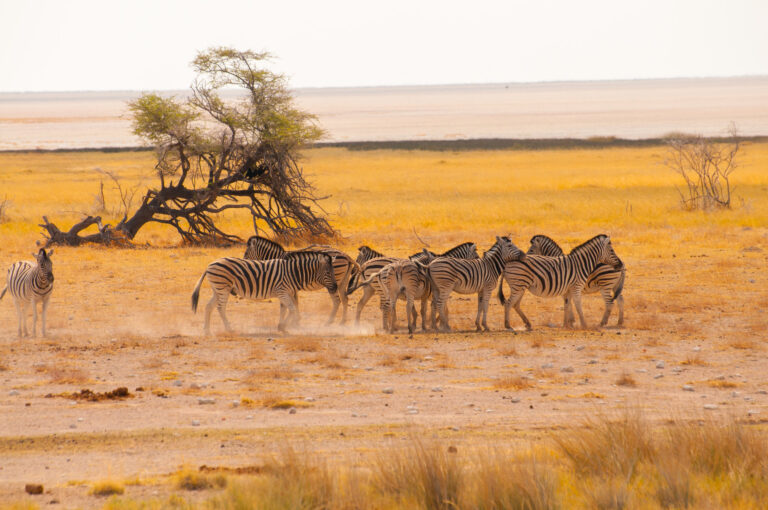
Game Viewing Safaris in Uganda
Uganda is a very attractive and exceptional safari destination filled with lots of wildlife. The country is located on the equator along the shores of Lake Victoria’s Northern Shore. This country has prolific wildlife which attracts many tourists that come to experience this wonderful gift of nature of the country. You can watch many animals in their habitats, a rewarding experience that can be enjoyed throughout the year. Wildlife can be seen in National parks and reserves, and these are perfect places for adventure seekers, eco- tourists and holiday makers. The many Uganda safari wildlife include; the elephants, kobs, zebras,
FAQs About Uganda Safari Tours
Why you should visit uganda.
Uganda is is located 1 00 N, 32 00 E, with a total of 241,038 sq km, land: 197,100 sq km water: Insight Safari Holidays takes you to Uganda to see the mountain gorillas and lots of wildlife . Gorilla treks of 400 mountain gorillas, viewing wild animals like elephants, antelopes, tree climbing lions, buffaloes and more in 10 parks. Boating safari and water sports on Lake Victoria, Kazinga Channel, River Nile and Lake Bunyonyi. Hiking and climbing is done in Rwenzori mountains range, Margherita peak (5109m), Mount Elgon and Gorilla National Park of Mt.Gahinga, Sabinyo and Muhavura. 1061 tupes of birds found in Uganda, 330 mammals and more that you can see on your travel to Uganda.

Uganda boasts of having the mountain gorillas together with other 10 parks and reserves providing wildlife experience makes it a competitive holiday destination in Africa and the world or region. 43,938 sq km with 26.4% protected areas for safari parks, reserves and specie management.
The country offers variety of wildlife types within its many fantastic safari parks. Some of these protected reserves include; Murchison falls National Park famous for its beautiful scenic water falls and boat cruises on Nile, 76 types of mammals and 451 birds, Bwindi impenetrable National Park , common for the mighty mountain gorillas, Queen Elizabeth National Park, the largest national park famous for variety of wildlife species and the fantastic Kazinga channel, Kibale National Park , home to over 13 primates, Rwenzori national park famous for mountain climbing and wildlife, Semliki National Park known mainly for birding, Mt Elgon National Park famous for mountain climbing and nature walks, Lake Mburo National park also famous for harboring Zebras and Impalas. Overall, the 10 parks make your Uganda tour worthwhile.
With 52 tribes in Uganda, the cultural experience in Uganda is very rewarding.
What to see while on Uganda safaris?
Beautiful Terrain; All safari tours offer such experience of beautiful country side as well as green undulating terrains filled with coffee and banana plantations. There are also traditional homesteads and cattle grazing. You will also enjoy many beautiful scenic drives, good to the eyes of any tourist on safaris to Uganda.
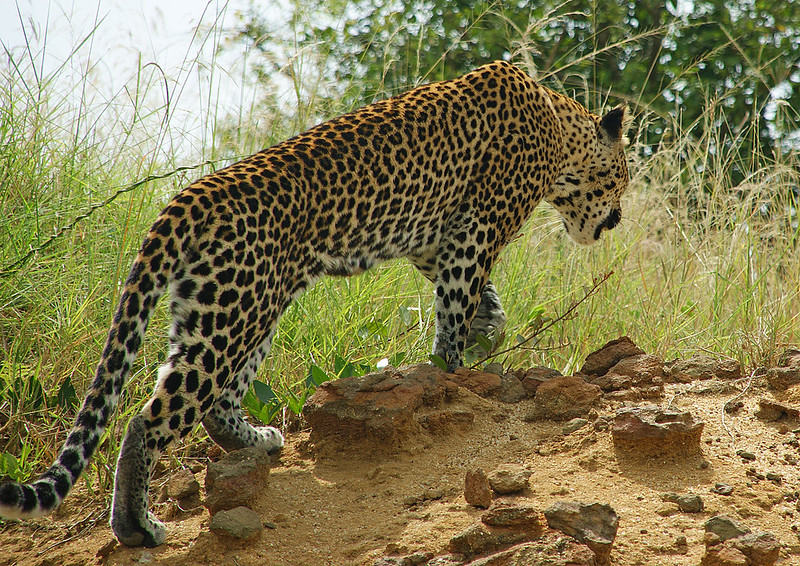
Wildlife; These can be viewed in all the parks of Uganda and tourists have a chance to enjoy the big five and the herbivores including the giraffes, zebras, antelopes, hippos, and Nile Crocodiles. Get to see the 400 population of mountain gorillas found in Bwindi Impenetrable National park as well as chimps and other monkey types you find in Kibale National Park and Queen Elizabeth National Park. Besides wildlife , you will also have chance to view the many birds including the rare shoebill stock while on a safari.
Mountain Rwenzori (Mountains of the Moon); this is a snow caped mountain and is the highest in East Africa. This mountain was also known as Ruwenzori Ranges and they are mountain ranges of the eastern equatorial Africa. These ranges are on border between Democratic Republic of Cong and Uganda. The mountain is 5,109km above sea level and is about 120km long and 65km wide. It’s filled with variety of flora including tropical rain forests, the giant groundsel and the giant lobelia. The fauna around this mountain include; primates like the monkeys, forest elephants and endemic birds.
Murchison falls; these falls are in north western Uganda and its among the most magnificent water falls in found in Uganda and its located on source of Nile. Other safari trips include a boat cruise on the Nile were you will enjoy an up close experience with many water animals including; the hippos, giant crocodiles as well birds.
Source of the Nile; this is found in Jinja town and it was discovered by John Speke, you can enjoy many different water activities on source of Nile, these include; white water rafting, swimming, bungee jumping, boat cruises, kayaking and many more.
Stay? Uganda Safari Accommodation - Hotels & Lodges
Many of destinations offer lodges and tented camps inside and outside the parks. The cost is between $ 150 to $ 900 for a double room per night. For gorilla trips in Bwindi Impenetrable National park, each of the sectors of this park has got variety of different lodges as well as camps which facilities those interested in tracking the endangered mountain gorillas.
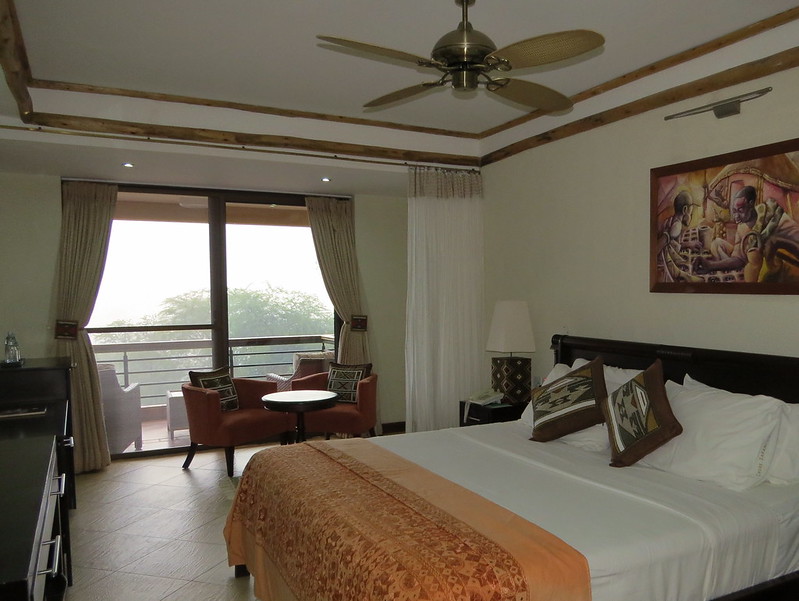
There are 41 lodges to choose from in Bwindi alone. These facilities can be booked directly or by Insight safari holidays. The most luxury lodges charge between $ 900 and $ 1200 per night.
When Is The Best Time To Visit Uganda?
This is one of many questions asked regarding any safari in Uganda, the common answer to this question is; you may visit Uganda at any time of the year! However the difference may vary in Price since there two different seasons; i.e. the peak season of June to September and December to February. With this season the price of both gorilla permits and lodges is high since it’s a high season. The low season is from March to May and September to November. The luxury safari lodges usually lower their rates during the low season.
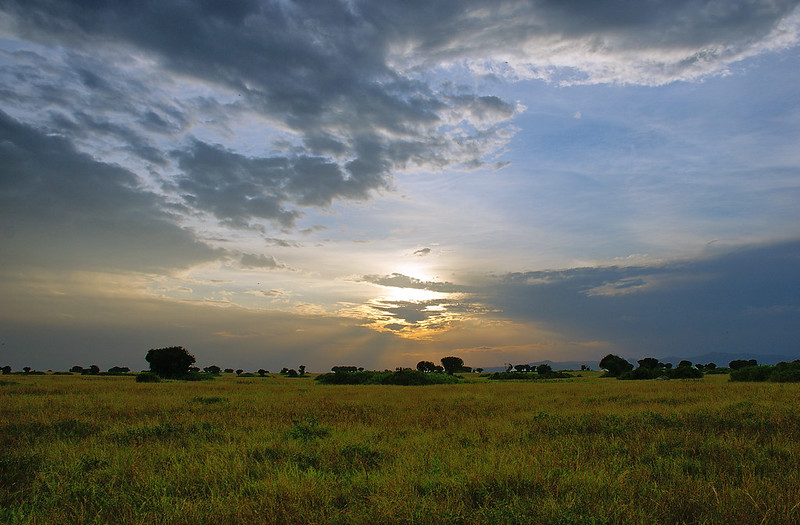
It’s also recommended that visitors should visit the country during the dry season which are from January to February and then June to September, this is because animal watching is best done during the dry season when many animals gather around the water holes. Bird watching can also be done throughout the year, but most preferably from November to April when there are many migrant species in the country.
What is the Cost of a Safari in Uganda?
Uganda Safari costing mainly depends on type of accommodation you chose and travel type. A gorilla permit costs $600 per person. The accommodation also costs between $150 to $900 and this depends in which facility you decide to sleep in. Cheapest gorilla tracking safari is approximately $ 1200 per person. And for the wildlife safaris to Murchison and Queen Elizabeth National Park, it can roughly cost $1000 for the budget travellers. Those willing to travel in groups, the safari price becomes low. A journey from Kampala to Bwindi is 527kilometres. Most destinations in Uganda will cost about $150 per day. A luxury safari to Uganda costs from $ 500 per day or more. A budget safari costs $ less than $ 100 per day.
When to go for a safari in Uganda?
You can visit Bwindi Impenetrable Forest National Park for gorilla tours, Murchison Falls National Park for falls viewing and wildlife drives and launch cruise. Other destinations include Kidepo Valley National Park recently ranked among the top parks of Africa, Queen Elizabeth National Park, Lake Mburo, and many others.
Is Uganda good for a safari?
Uganda makes an excellent safari destination, offering diverse wildlife, stunning landscapes, unique experiences. Let’s look at some factoids highlighting Uganda’s appeal:
- Biodiversity:
Uganda harbors over 10% avian species globally, over 1,070 recorded bird varieties because country features varied ecosystems – savannas, rainforests, wetlands, highlands – contributing rich biodiversity.
- Uganda Gorilla safaris
Uganda is one of just three countries worldwide enable see mountain gorillas in the wild. Bwindi Impenetrable National Park – UNESCO World Heritage area – hosts roughly half remaining mountain gorillas worldwide.
- Chimpanzee Safari Uganda
Kibale National Park contains over 1,500 chimpanzees, making prime spot for tracking, habituating chimps.
- Big Game: Wildlife Safari Uganda
Uganda has “Big Five” (lion, elephant, buffalo, leopard, rhino) plus other large mammals like giraffes, zebras, various antelopes. Queen Elizabeth, Murchison Falls National Parks offer traditional game drives spot these creatures.
- Landscapes:
Uganda boasts varied scenery including magnificent Murchison Falls, where Nile squeezes narrow gorge, forming powerful cascade. Rwenzori Mountains, “Mountains of Moon” provide unique trekking opportunities, are UNESCO World Heritage Site.
- Birding Safaris in Uganda
With diverse habitats, Uganda is birdwatcher’s paradise. Notable species include shoebill stork, fish eagle, Great Blue Turaco.
- Conservation:
Uganda made major efforts protect wildlife, ecosystems reflected in numerous parks, protected zones.
- Tourism Growth:
Uganda’s unique safari offerings attract more visitors yearly. Tourism revenue aids conservation, communities.
- Travel To Uganda
Uganda has good infrastructure, transportation making relatively accessible.
Beyond wildlife, Uganda offers cultural experiences with local communities – adding depth any safari.
What To Pack on a Safari in Uganda
Comprehensive packing list:
Neutral hues blend surroundings, brights startle wildlife. Lightweight long sleeves shield sun, bugs, plants. Hat shade, cooling. Fleece chilly nights, early mornings high altitude. Rain protection sudden showers. Sturdy shoes walking, hiking. Sandals relax. Swimsuit if pool. Enough socks, skivvies.
Accessories
Sunglasses UV protection. Binoculars see wildlife close. Camera, extra batteries capture sights. Power bank limited electricity. Bug spray deter mosquitoes. Sunscreen, lip balm prevent burns. Medications, first aid health needs. Hand sanitizer, wipes hygiene limited facilities. Toiletries.
Valid passport, necessary visas. Insurance cover medical, evacuation. Document photocopies. Vaccination certificates if required. Local shillings, small dollars emergencies. Credit cards not everywhere. Itinerary, contacts.
Other Essentials
Daypack drives, walks. Adapter, converter Type G sockets. Multitool, Swiss Army. Ziplocs keep dry, organized. Reusable bottle hydration, less waste. Non-perishable snacks – bars, nuts.
Optional Extras
Field guides learn wildlife, plants. Binocular harness easy carry, access. Travel pillow, eye mask restful sleep. Notebook, pen record observations.
Tailor specifics safari type, duration, time year. Confirm needs with tour operator. Thoughtful packing smooth enjoyable Uganda safari!
What Type of Accommodation Do You Expect on a Safari in Uganda?
In Uganda, range of lodgings suit various preferences, budgets – from luxe lodges in national park hearts to budget-friendly options. Overview of accommodation types and prominent safari lodges:
Luxury Lodges and Camps
Luxury lodges provide high-end safari experience with lavish amenities, personalized service, stunning landscape views. Often feature spacious suites or tents, gourmet dining, various activities.
Prominent Examples:
– Chobe Safari Lodge in Murchison Falls National Park
– Clouds Mountain Gorilla Lodge near Bwindi Impenetrable National Park
– Sanctuary Gorilla Forest Camp in Bwindi Impenetrable National Park
– Mweya Safari Lodge in Queen Elizabeth National Park
– Apoka Safari Lodge in Kidepo Valley National Park
Mid-Range Lodges and Camps
Mid-range lodgings offer comfortable, enjoyable stays with en-suite facilities, range of amenities – good comfort/affordability balance.
– Primate Lodge Kibale near Kibale National Park
– Simba Safari Camp in Queen Elizabeth National Park
– Mihingo Lodge in Lake Mburo National Park
– Kibale Forest Camp near Kibale National Park
– Ishasha Wilderness Camp in Queen Elizabeth National Park
Budget Lodges and Camps
Budget options provide basic facilities, more economical choice for travelers – may have fewer amenities but still convenient, cost-effective way to experience national parks.
– Rweteera Safari Park near Queen Elizabeth National Park
– Buhoma Community Rest Camp near Bwindi Impenetrable National Park
– UWA Bandas and Campsites in various national parks
– Red Chilli Hideaway in Murchison Falls National Park
Tented Camps
Tented camps offer unique, immersive safari experience – blend lodge comforts with close-to-nature feel.
– Elephant Plains Lodge in Queen Elizabeth National Park
– Buhoma Lodge near Bwindi Impenetrable National Park
– Nkuringo Bwindi Gorilla Lodge near Bwindi Impenetrable National Park
– Mburo Safari Lodge in Lake Mburo National Park
Community and Eco-Lodges
Some accommodations community-owned or eco-friendly, support local development, conservation.
– Ruboni Community Camp near Rwenzori Mountains National Park
– Nkima Forest Lodge near Kibale National Park
How Long Should a Uganda safari be?
Ideal Uganda safari length varies based interests, specific parks, desired activities. Typical duration ranges from a few days to around 2 weeks.
Gorilla Trekking
Gorilla trekking a major highlight – requires at least 2-3 days including trek itself and park travel. The hiking lasts hours, so account for this singular experience.
National Park Visits
Uganda boasts variety of parks, each offering divergent critters, landscapes. Well-liked include Queen Elizabeth, Murchison Falls, Kibale. Typical individual park visit 2-4 days – explore, game drives, boat safaris.
Birdwatching, Nature Walks
Additional days likely necessitated if keen on birdwatching, nature walks to fully appreciate avian diversity, natural magnificence.
Cultural Experiences
Calculate time for village visits, cultural performances if planning community interactions.
Travel Time
Time required between parks, destinations affects overall duration – road conditions capricious.
Sample Durations
– Gorilla focused: 3-5 days – Multiple parks: 7-10 days – Extended with more activities: 10-14+ days. Facts and Figures
– 2023 average international tourist stay: 10 nights
– Longer stays enable deeper exploration of terrain, critters, culture.
How To Book A Safari in Uganda
Research and Decide – Research different parks, happenings, and activities that you want to experience. – Decide duration, budget, preferred dates.
Choose Tour Operator – Select reputable, licensed operator like Insight Safari Holidays specializing in Uganda safaris. Seek rave reviews, seasoned guides, commitment to responsible tourism.
Customize Itinerary – Work with operator to customize itinerary based on druthers, interests, budget. Discuss desired parks, activities (e.g. gorilla trekking, wildlife drives), accommodations, experiences.
Purchase Gorilla Permits – If including gorilla trekking, operator should help snag limited permits from Uganda Wildlife Authority early.
Confirm Details – Confirm all itinerary details – digs, activities, transportation, special requirements. Verify alignment with expectations.
Payment and Booking – Cough up deposit or full amount to secure booking through bank transfer, card, or methods specified by operator.
Obtain Documents – Have valid passport with at least 6 months validity after travel. Scope and obtain necessary visas.
Health Preparations – Consult travel doc for advice on vaccinations, medications like malaria prevention.
Packing and Prep – Pack suitable garb, footwear, gear for happenings. Don’t forget essentials like sunscreen, bug spray, camera.
Travel Insurance – Purchase comprehensive insurance covering medical, cancellations, unforeseen events.
Departure – Arrive in Uganda on specified dates, convene with operator/guide at designated meeting point.
What are Some of the Top African Safari Parks?
Kruger National Park, South Africa
This iconic park is a true safari mecca, harboring the “Big Five” and over 140 mammal species including lions, elephants, leopards, and rhinos. It’s a birdwatcher’s paradise too, with over 500 feathered species. Accommodations run the gamut from budget-friendly rest camps to lavish lodges and private reserves.
Serengeti National Park, Tanzania
Famed for the Great Migration, the Serengeti brims with diverse wildlife like lions, cheetahs, giraffes, and wildebeest. An estimated 70 large mammals and 500+ birds inhabit the park. Luxury lodges, tented camps, and mobile camps cater to various budgets.
Masai Mara National Reserve, Kenya
This reserve is renowned for the Great Migration and abundant predators like lions, cheetahs, and hyenas. Over 450 bird species have been recorded here. Accommodations include luxury lodges and tented camps.
Chobe National Park, Botswana
Chobe boasts the world’s largest elephant population along with lions, leopards, buffalo, hippos, and 450+ bird species. The park offers luxury lodges, tented camps, and houseboats along the Chobe River.
South Luangwa National Park, Zambia
South Luangwa is celebrated for walking safaris and leopard sightings, plus elephants, buffalos, antelopes, and 400+ birds. Intimate lodges and tented camps provide an immersive wilderness experience.
Hwange National Park, Zimbabwe
Hwange is notable for its substantial elephant herds plus lions, giraffes, diverse mammals, and 400+ birds. Budget and luxury options allow varied safari experiences.
Lower Zambezi National Park, Zambia
The Lower Zambezi provides excellent elephant, hippo, crocodile and predator sightings. Over 400 bird species inhabit the park. Luxury lodges and tented camps line the Zambezi River.
How To Fly to Uganda
Getting to Uganda means booking a flight to Entebbe International Airport, the main entry point for visitors. Entebbe is located near the town of the same name, about 25 miles southwest of the capital Kampala. Let’s walk through planning your flight step-by-step.
First, pick which airport you’ll fly out of. Major hubs across different continents have flights to Entebbe.
Next up, search for flights using travel sites or apps. Enter where you’re coming from, your dates, any preferences – compare options across airlines, routes and layover times for the best combo of convenience and cost.
Once you’ve found a good flight, go ahead and book your tickets directly through the airline website or travel site. Follow the instructions to finish booking and enter your info.
Be sure your passport is valid for at least 6 months after your travel date. Check if you need a visa for Uganda and get one if required. Also organize any other must-have docs like insurance, health certificates, vaccination proof.
Consider when you’ll get to Entebbe – many international flights come in at night. If needed, arrange transportation from the airport to your hotel or lodge ahead of time.
When you arrive at the airport, go through immigration and customs – have your passport, visa, docs ready to show them.
Once you’re through, you’re all set for your Uganda adventure! Dive into the amazing landscapes, wildlife sightings, culture and more that the country offers.
Major airlines flying to Uganda include Emirates, Qatar Airways, Ethiopian Airlines, Kenya Airways, Turkish Airlines, KLM, and Brussels Airlines among others.
What is the best month to Visit Uganda
Our uganda safaris reviews.
Tel : Office +256392613687 Mobile / Whataspp: +256774382674 Box 8753, Plot, 19 Bukoto Road,Kampala, Uganda
Best African safari holidays. Visit Uganda, Rwanda, Kenya & Tanzania.
Useful Links
Subscribe now.
Don’t miss our future updates! Get Subscribed Today!
©2023. Insight Safari Holidays. All Rights Reserved.
Plan Your Safari Now, Whatsapp Us
- +256 392 176327
- +256 702 805580
- [email protected]
Uganda, What to Expect on a Wildlife Safari

- Travel Guides
If you are planning a wildlife tour in Uganda, here are some insights on what to expect.
Uganda is a unique wildlife safari destination compared to its East African counterparts. When you go on a safari in Uganda, expect a diverse landscape encompassing everything from sweeping savannah plains to rugged western regions teeming with wildlife, primates, and remarkable bird species. The country boasts excellent wildlife viewing safaris throughout the year, thanks to abundant animal concentrations, a temperate climate, and expansive protected animal sanctuaries. Safari drives typically occur in closed 4×4 vehicles with three rows of seating and a pop-top roof hatch, while accommodation options mainly consist of authentic traditional lodges and tented camps. Uganda tours are renowned for their combination of primate viewing, guided bush walks, cultural tours, game drives, and boat safaris, offering a well-rounded safari experience.
Most wildlife tours in Uganda begin in Entebbe, a peninsula on Lake Victoria’s northern shores, housing the country’s main international airport. From there, the expedition ventures westward, traversing a long safari belt along the western border, passing through most of the national parks.
As you venture west, you’ll encounter a stunning display of terraced, rugged landscapes blanketed in vibrant hues of emerald green. Uganda lies within a basin between the savannah plains in the east and the rainforest jungle ecosystem in the west, creating a magnificent terrain that sets the stage for a range of safari experiences .

A Typical Safari in Uganda
A typical wildlife safari in Uganda includes:
- Classic wildlife game drives.
- Immersive water safaris.
- Thrilling gorilla trekking or chimpanzee tracking adventures through pristine rainforest jungles to observe some of the world’s rarest primates.
The country offers exceptional birding opportunities, with over 1,050 bird species flocking to accessible birding habitats. A must-see for bird enthusiasts is the prehistoric-looking shoebill , which can be spotted in the swampy areas of Entebbe and Murchison Falls National Park.
Savannah Wildlife Adventures
While Uganda’s big game national parks may not boast the same wildlife densities as their eastern counterparts, game-viewing safaris are still immensely rewarding. The number of tourists visiting these reserves is significantly lower compared to more developed destinations, allowing for a more private and intimate safari experience. Encountering lions, elephants, or leopards becomes a cherished moment, with fewer vehicles crowding the scene.

Rainforest Adventures
Uganda’s rainforests offer unparalleled primate encounters , making them some of the best and most accessible in the world. With over 1,500 chimpanzees swinging through the forest canopies, expect extraordinary chimpanzee trekking adventures, particularly from the Kanyanchu trailhead in Kibale National Park. Other chimpanzee habitats like Maramagambo, Budongo, Semiliki, and Kyambura may offer a slightly different experience but are still worth exploring.
The pinnacle of any Uganda wildlife safari is the cherished opportunity to spend time with the majestic mountain gorillas in Bwindi Impenetrable Forest, located approximately 230 miles (480 km) from Entebbe. Bwindi and Mgahinga, situated along the southwestern border, provide exceptional gorilla trekking adventures, with various safari lodges scattered around the four visitor centers on the park’s periphery.
Travelers also have the option to fly in from Entebbe or Masai Mara in Kenya to a small airstrip and then embark on a three-hour drive to reach the gorilla park.

Who is the Uganda safari for?
The Uganda safari is suitable for a wide range of travelers who are seeking a unique and immersive wildlife experience. Here are some of the types of travelers who would find the Uganda safari appealing:
Wildlife Enthusiasts
If you have a deep appreciation for wildlife and want to witness diverse species in their natural habitats, the Uganda wildlife tour is perfect for you. From iconic animals like lions and elephants to rare primates like mountain gorillas and chimpanzees, Uganda offers an incredible array of wildlife encounters.
Nature Lovers
If you are captivated by the beauty of untouched landscapes and want to explore diverse ecosystems, Uganda’s natural wonders will leave you in awe. From the vast savannah plains to dense rainforests and serene lakes, Uganda’s diverse habitats provide a breathtaking backdrop for your safari adventure.
Adventure Seekers
If you crave excitement and want to engage in thrilling activities, Uganda offers a range of adventurous experiences. Trekking through the dense forests to encounter gorillas and chimpanzees, going on game drives in search of elusive wildlife, and embarking on boat safaris along scenic waterways are just a few of the thrilling adventures that await you.
Birdwatchers
If you are a birding enthusiast, Uganda is a paradise for birdwatching. With over 1,000 bird species, including the iconic Shoebill, Uganda offers abundant opportunities to spot and photograph a wide variety of avian species in diverse habitats.
Cultural Explorers
If you want to immerse yourself in local cultures and traditions, Uganda’s rich cultural heritage will fascinate you. Interacting with local communities, visiting traditional villages , and experiencing cultural performances will provide a deeper understanding of Uganda’s vibrant heritage.
Photographers
If you are passionate about photography, Uganda’s stunning landscapes, diverse wildlife, and vibrant cultures will provide endless opportunities to capture breathtaking images. Whether it’s a close-up of a gorilla, a dramatic sunset over the savannah, or a vibrant cultural ceremony, Uganda offers incredible subjects for photographers.
Responsible Travelers
If you prioritize responsible and sustainable travel, Uganda is an excellent choice. The country is committed to wildlife conservation and community development, providing opportunities for travelers to support local initiatives and positively impact the environment and local communities.
The Uganda safari caters to a wide range of travelers who love wildlife, nature, adventure, culture, and responsible travel. It offers a unique and enriching experience that will create lasting memories and a deep connection with Uganda’s remarkable natural and cultural heritage .
How long does a safari trip in Uganda usually last?
The duration of a safari in Uganda is highly flexible and can be tailored to suit the visitor’s preferences and budget. There is a variety of safari packages available, ranging from brief three-day safaris to more extensive 14-day safaris encompassing multiple parks and activities. Many visitors opt for a 7 to 10-day safari, which strikes a balance between exploration time and the opportunity to partake in activities like gorilla trekking, game drives, and birdwatching.
For those with limited time, a shorter safari may be ideal, while a longer safari allows for a deeper immersion into the country’s wildlife and cultural experiences.
It’s essential to consider that the safari’s duration impacts the overall cost, with longer safaris generally being more expensive due to additional activities and accommodation expenses . To find the most suitable option that aligns with their preferences and budget, visitors should research and compare various safari packages.

Describing A Typical Uganda Safari Itinerary
A typical Uganda safari itinerary begins in Entebbe, where visitors arrive by plane. After spending a night at the beautiful Lake Victoria peninsula, travelers fly to the southwestern mountain gorilla park the next day. Visitors can also explore introductory Uganda attractions like Nganba Island and Shoebill tracking before embarking on their journey into the countryside.
To reach the two gorilla destinations at the border with Rwanda and DRC, expect to drive southwest from Entebbe International Airport for almost 10 hours. However, two small airports are located outside Bwindi in the northern and southern sections. Travelers can take a one-hour scheduled flight from Entebbe to Kihihi or Kisoro airstrip and drive for about two hours to reach the mountain gorillas.
After visiting the gorillas
Our safari experts recommend trekking the mountain gorillas twice to maximize your experience. After the gorilla trekking adventure, the safari itinerary can fly visitors back into Entebbe or extend the trip to Queen Elizabeth National Park. Most safari packages include the western Uganda safari circuit, visiting Mgahinga in the bottom southwest, Bwindi, Queen Elizabeth NP, Kibale National Park, and Murchison Falls in the top southwest.
Expect game viewing drives in Queen Elizabeth National Park and a boat safari on Kazinga Channel. From Queen, you can visit Kibale National Park for the chimps trekking excursion before heading north to Murchison Falls National Park for another safari drive and boat trip on the Nile.
Travelers can explore the undiscovered open spaces of lesser-known but rewarding Kidepo Valley National and Pian Upe Game Reserve. Here, visitors can experience a Mara-like adventure with more privacy and varied wildlife but lower animal densities. Kidepo is excellent for watching lions, cheetahs, Rothschild’s giraffes, and hunting dogs.
Expect to spend about 14 days or more on a richly rewarding Uganda wildlife safari covering all the country’s major attractions.
Recommended Tailor-made Uganda Safari Vacation That Covers the Western Circuit

A Road Trip To See Uganda’s Primates
8 Days Road Trip Holiday
View Itinerary

Visit all Uganda’s top gems in 2 weeks
16 Days | Explore Uganda
When is the best time for a wildlife safari in Uganda?
The Uganda safari can be enjoyed year-round, but it’s important to consider the impact of rainy seasons (March to May and September to November) on travel conditions. During these periods, navigating the destination can be challenging due to the slippery and uneven terrain caused by the rain. Additionally, sudden downpours can disrupt primate trekking experiences .
The two dry seasons of December to January and June to August are generally recommended for an optimal safari vacation in Uganda. During these periods, forest floors are less damp, trails are more passable, and the chances of getting drenched in torrential downpours are reduced. However, it’s important to remember that rain can still occur in a rainforest environment, even during the dry season.
The dry season is also ideal for safari drives in Uganda’s wildlife savannah reserves, with clearer skies, less rain, more sunshine, and less vegetation making wildlife spotting easier. Gorilla trekking permits can become scarce during the peak season, so booking them well in advance is advisable.
How to plan.
Embark on a comfortable and rewarding safari adventure in Uganda by choosing Nkuringo Safaris for your travel planning needs. Our team of local experts will handle everything from selecting the best adventures to booking vacation rentals, arranging transportation, meals, and more. Experience a worry-free journey with Nkuringo Safaris.

Where to stay

What to pack

Everything about gorillas

Quick Facts about Uganda

Nkuringo Safari Experts

We are safari specialists
Dreaming of an East African safari but feeling overwhelmed by the details? Don't worry! We're here to take the planning stress off your shoulders. With our East Africa expertise, we'll handle the local logistics and craft the perfect Uganda, Rwanda, Kenya, or Tanzania safari for an unforgettable adventure!
Related stories

How Much is a Gorilla Permit in Uganda

50 Must-See African Safari Animals

Best Safari in Africa – Top Destinations For First-Timers
Are gorillas primates.

Best Time To See Gorillas in Rwanda and Uganda

7 Reasons To Visit Uganda in 2024

Uganda Safari’s New Big Five Animals You Must See

The “Big Five” are the animal kingdom’s famous celebrities on the African Savana; every tourist hopes to set eyes on these dramatic creatures. Uganda, like many other African safari destinations , hosts the big players and more. That is why we thought we should tell you more about Uganda’s new selection of the big 5 game aniamls.
The ‘Big 5’ was coined by hunting safari explorers, back in the 1800s, based on how challenging to hunt these animals were. But since the big five experience is now all about photographing, viewing, and meeting the wild creatures, Uganda’s new big five list includes the mountain gorilla , lion, chimpanzee, African elephant, and leopard. Our list is based on travelers most south after animals to see on a Uganda safari , challenging to reach and offer memorable photography moments.
In addition to experiencing Uganda’s exquisite cultures, and people, and viewing some of the most stunning landscapes , your trip to Uganda will not richly reward you until you meet these magnificent animals.
The New Big 5 You Must Watch on Safari in Uganda
- Mountain Gorilla
- African Elephant
1. Mountain Gorilla ( Gorilla beringei beringei )

Uganda is home to the mountain gorilla, which is one of the most popular primates in Africa . These gentle giants can be found in the country’s southwestern corner and attract hundreds of tourists who often wait months in advance for the opportunity to see them. In fact, Uganda has more than half of the world’s total population of over 1060 mountain gorillas. These magnificent creatures are the kings of the rainforest jungle and offer an unforgettable viewing experience in the east-central African mountain rainforests.
Standing upright at 4 to 6 feet, a fully grown mountain gorilla can weigh a whopping 300 to 485 pounds (135 to 220 kilograms). The mountain gorilla unsurprisingly makes the number one on the list of new BIG five animals in Uganda because of its mass, scarcity, and magical moments. Most of all, the gentle giant lives in one of the most biodiverse homes in the world.
To stay warm in the mountains, mountain gorillas have longer hair than their eastern lowland cousins, the Grauer’s gorillas (Gorilla beringei graueri). They also tend to be a bit larger than other gorillas and have shorter arms.
Gorillas can climb trees but are usually found on the ground in communities of up to 30 individuals. These troops are organized according to fascinating social structures.
One dominant, older adult male leads troops, often called a silverback because of the swath of silver hair that adorns his otherwise dark fur. Troops also include several other young males, some females, and their offspring.

The leader organizes troop activities like eating, nesting in leaves, and moving about in a home range of 0.75-to 16 square miles. Those who challenge this alpha male are apt to be cowed by impressive shows of physical power.
He may stand upright, throw things, make aggressive charges, and pound his huge chest while barking out powerful hoots or unleashing a frightening roar.
Despite these displays and the animals’ obvious physical power, gorillas are generally calm and nonaggressive unless they are disturbed .
In Uganda, you can do gorilla trekking in two destinations (unlike in Rwanda and DR Congo); Bwindi Impenetrable National Park (most famous) and Mgahinga National Park.
The 128 sq mi (331 sq km) Bwindi alone hosts more than 469 mountain gorillas , and about 200 individuals are habituated for tourism in four different sectors around the park’s boundaries. Mgahinga NP, on Virunga mountains’ slopes, shares the other gorilla habitat with Rwanda’s Volcanoes and DRC’s Virunga National Parks. Mgahinga has two habituated gorilla groups, offering 16 gorilla trekking permits per day.
Thousands of travelers flock to the impenetrable rainforests of Bwindi National Park to spend that precious moment with this magnificent gentle giant, and they’ll tell you that the experience is unmatched on any African safari encounter. So, in our books, the mountain gorilla qualifies for the BIG African wildlife list.
You can see the mountain gorillas on a guided gorilla trekking excursion for the price of a permit costing USD 700 ( or $400 at a discounted price ) per person. The permit issued by the Uganda Wildlife Authority (UWA ) at face value will allow you one unforgettable hour with the mountain giants.
Or, if you got the hearts for it, take a gorilla habituation experience safari and spend more than 4 hours foraging with a family of semi-habituated mountain gorillas for a permit fee of USD 1500 per person.
2. African Lion (Panthera leo)

The most imposing feline on the African savannah now attracts more protection than a pop culture celebrity. The lion is the most sought-after of the new big five animals in Uganda’s wild. It is also considered the most sociable of the large cats, living in loosely structured cat prides of typically five to 15 animals.
This ferocious cat has special cultural significance in Ugandan cultures and enjoys a reputation as the king of the beasts and a symbol of royalty, strength, and bravery.
In Uganda, you can find lions in mainly three of the largest savanna parks: Murchison Falls National Park (MFNP), Kidepo Valley National Park (KVNP), and Queen Elizabeth National Park (QENP).
In QENP’s southern section, the Ishasha lions show off their unique behavior of climbing trees, and travelers have branded them the “Ishasha tree-climbing lions .” Tourists flock to this sector to marvel at this rare behavior of wild cats.
Unfortunately for the lions in this section of Uganda have faced gruesome wildlife atrocities on two occasions in the last decade; once in April 2011 (poachers poisoned 11 lions) and recently in April 2021 (6 poisoned and dismembered). The worst threat still facing those magnificent lions in Uganda is poaching.

Head out early or take an evening drive on the game tracks to catch the hunting action on the plains. When the sun is high up, the lions are lazy and probably chilling in bushes where it’s a bit challenging to see them.
Due to a low number of lions in extensive plains, you may find it challenging to find the lions independently. We recommend you hire a tracking guide/ranger to help you easily track the lions.
UWA offers ranger/guide services for game drives for a cost of USD 20 per vehicle for day game drives and USD 30 per person for night drives. The rangers use walkie-talkies to communicate with an onsight ranger to locate lion prides and live cat actions on the plains, so using their services is quite rewarding.
Lion Tracking Research Experience
Lion tracking is one of one the most exciting experiences in spotting Uganda’s new BIG five animals on the savannah plains. Uganda Carnivore Project that runs the research offers this activity in Queen Elizabeth National Park to travelers that want to spend more time on the plains observing these fascinating cats.
The lions tracking experience team heads out every evening with a limited number of tourists and spend about one to three hours observing lion prides and learning their behaviors.
UWA issues lion tracking permits at USD 50 for Foreign Non-Residents and UGX 100,000 for East African Nationals, including the park entrance fee. Of the cost, $10 is donated to the Uganda carnivore Project responsible for conserving the lions. So the experience will be also for a good cause. It’s what leisure travel is about today!
3. Chimpanzee (Pan troglodytes)

7 out of 10 tourists visiting Uganda’s rainforest parks will say they had to come and see our playful primate cousins in their natural cradle. The chimpanzee’s celebrity status among travelers earns it a great position on Uganda’s new BIG five Animals lists.
The common Chimpanzee is a distinctive black-coated ape that’s more closely related to man than any other living creature. Along with bonobos, they are our closest living relatives, sharing 98.7 percent of our genetic blueprint. Science research has consistently shown that humans and chimps share a common ancestor who lived some seven to 13 million years ago.
The Chimpanzee lives in large, loosely bonded communities based around a core of related males with an internal hierarchy topped by an alpha male. Females are generally less strongly bonded to their core group than are males; emigration between communities is not unusual.
Mother—child bonds are strong. Daughters normally leave their mother only after they reach maturity, at which point they break their relations. Mother—son relations have been known to survive for over 40 years. A troop has a well-defined core territory which is fiercely defended by regular boundary patrols.
Chimpanzees are primarily frugivorous (fruit-eating), but they eat meat and even hunt on occasion — they’ve regularly hunted red colobus monkeys in Tanzania’s Gombe Stream and Mahale Mountains national parks. Simultaneously, researchers in Kalinzu Forest in Uganda have observed chimps eating blue and red-tailed monkeys, and unsuccessful attempts to hunt black-and-white colobus.
Chimpanzees are among the most intelligent of Uganda’s new BIG five animals. These guys have been observed regularly using tools like modified sticks to ‘fish’ in termite mounds. Scientists have also observed chimps cracking nuts open using a stone and anvil.
In language studies in the USA, researchers have taught chimps to communicate in American sign language . They have demonstrated their understanding, in some instances, by even creating compound words for new objects (such as rock-berry to describe a nut).
Uganda hosts more than 4900 chimps within its national park, making it a top destination for primate viewing . Kibale National Park, in western Uganda, offers the best chimpanzee viewing (in their natural habitat) opportunities in the world, with over 1500 chimps swinging the park’s tree-tops.
Kibale also has the highest density of primates on the continent, with researchers recording 13 primate species within the park. Much work has gone into habituating chimpanzee troops for tourism in Kibale Forest, so seeing our primate cousins in the park is highly guaranteed.
You can also see chimpanzees in Kyambura Gorge found in Queen Elizabeth National Park, Semliki Wildlife Reserve, and the Budongo and Kanyiyo Pabidi forests near Murchison Falls National Park.
A Chimp Trekking Experience
Non-residents, foreign residents, or east African citizens respectively pay USD 200/ $150/Ush150,000 for chimpanzee tracking in Kibale National Park.
Chimp trekking permit in Kyambura Gorge costs USD 50/ $50/Ush30,000 and USD 30/ $30/Ush20,000 in Semliki Wildlife Reserve.
The discounted Chimpanzee Tracking Permit price that runs from Dec 2020 to June 2021 costs USD 150/ $100/UGX100,000 for non-residents, foreign residents, or East African citizens.
For a much exciting and lengthy-time with the forest troops, UWA offers Chimpanzee Habituation Experience (CHEX). It is considerably a much entertaining excursion that costs USD 250/permit for foreign nonresidents and East African residents and Ush 250,000 for East African nationals.
Combine chimps trekking in Kibale with gorilla trekking in Bwindi Impenetrable forest for an ultimate experience of Uganda’s primates. Safari operators like Nkuringo Safaris offer customizable journeys between the two destinations at pretty impressive prices.
4. African Elephant (Loxodonta africana)

African Elephant is the world’s largest of all Uganda’s new BIG five animals and perhaps the most enduring symbol of nature’s grace and fragility. The elephant is also one of the most intelligent and entertaining to watch on a classic Uganda safari game drive .
A fully-grown male elephant can weigh a whopping 13,889 lbs (6300 kilos). Even the smallest adult male rarely dips below 4000 kilos, which is way more than twice the weight on an average family SUV. Females are usually just over half the weight of the male.
The size difference between the two is not as surprising as when it comes to height – the tallest males are 4 meters tall, the tallest female rises to 3.4 meters. Apart from overall size, unless the male is sexually aroused, the most obvious difference between males and females is that females have an angular forehead. In contrast, a bull’s forehead is more rounded.
There’s more: an African elephant has the giant brain of any mammal alive; it can weigh up to 6 kilos. Its trunk, which serves an elephant like a hand, can be 2 meters long and weigh over 130 kilos – a trunk has no bones but may have 60,000 muscles in it. An elephant uses its tusks as both tools and weapons. The longest recorded tusks were 3.17m long, while the heaviest reached 70kg.
There are two subspecies of the African elephant – the forest and the savannah elephant. You may be lucky to see the smaller and slightly hairier forest elephant in Kibale and Bwindi’s equatorial forests. The savannah elephant dwells throughout the grassy plains and bushlands of Uganda’s massive savannah parks. The two races are thought to interbreed in parts of western Uganda.

Elephants live in herds consisting of related females and their calves. The herds are matriarchal, meaning that they are led by one female, while the males (bulls) tend to roam alone. The family units of savannah elephants tend to be around 10 individuals, but these units can come together to form a ‘clan’ of up to 70 individuals led by one female. The forest elephants live in smaller family units.
Mother—daughter bonds are strong and may exist for up to 50 years. Males generally leave the family group at around 12 years, after which they either roam around on their own or form bachelor herds.
If you’re planning your Africa safari in Uganda and would like to meet one of Uganda’s BIG 5 animal giants, you must know that the African elephants occur in all Uganda National Parks except for Lake Mburo. You are most likely to easily seen them in Murchison Falls, Queen Elizabeth, and Kidepo National Parks.
The most exciting sighting is when you find them at the waterholes. Take a boat safari on the Victoria Nile in Murchison Falls NP or Kazinga Channel in QENP and catch a front row sight of the gentle giants gracefully flocking the water banks in massive herds.
UWA conducts boat launch trips on Kazinga Channel, and Victoria Nile at 10:00 am and 2:00 p.m. at the cost of USD 30 to foreign non-residents and foreign residents and UGX 30000 to East African Nationals.
5. Leopard (Panthera pardus)

This is the most elusive of Uganda’s BIG 5 animals. Leopards in Uganda are sneaky and harder to spot. Naturally shy and exclusively nocturnal, leopards spend the daylight hours hidden from view. These solitary felines are impressive to watch when hauling large kills, such as zebra or antelope, into a tree to eat alone, in peace.
Leopards can be distinguished from cheetahs by their rosette-shaped spots and more robust build and their preference for wooded or rocky habitats. They are found in virtually all habitats which offer adequate cover and are present in most Ugandan national parks and forest reserves.
Its capacity for adapting to changes in prey species, hunting conditions, carnivore competition, vegetation patterns, and human activities enables it to survive in developing Africa with more success than almost any other large wild animal. It can even persist in more or less advanced agricultural areas, though often in significantly reduced numbers.
A leopard differs from other new BIG five animals because of locals reporting them outside protected areas. They hunt using stealth and power, often getting to within 5 meters of their intended prey before pouncing, and they habitually store their kill in a tree to keep it from being poached by other large predators.
Meanwhile, together with the poaching, it has induced, the international fur trade has depressed leopard populations in several parts of Uganda. We do not have any reasonable measure of population numbers anywhere for this species. However, we do have sightings from rangers collected while they are on patrol in the protected areas managed by UWA.
Travelers can, on game drives, view leopards in Queen Elizabeth National Park, Murchison Falls National Park, Kidepo Valley National Park, Lake Mburo National Park, Mt Elgon National Park, and Toro-Semliki Wildlife Reserve.
Sightings in Queen Elizabeth National Park are relatively numerous in comparison with other sites in Uganda. This park likely is one of the last strongholds for this species in the country. Late Evening game drives are sure to bring you close to a live leopard action.

Leopards have mainly been sighted in the Buligi circuit area in northwest Murchison Falls Park , but this is likely to be due to higher patrol effort. Most of the sightings are concentrated around ranger patrol posts in the park. There are few patrols in the center of the park each year, and leopards are likely to be more abundant here than the figure below indicates. Only one sighting of a leopard has occurred in Ajai Wildlife Reserve from the ranger collected data.
Leopards have been seen throughout most of Kidepo Valley National Park but more commonly in the Narus valley. It’s likely because of patrol effort differences, although ungulate numbers are meager in the Kidepo Valley in the park. Hence, leopards are more numerous in the Narus valley.
One of the big cats on Uganda’s new big 5 animals list is also frequently sighted in the west of Lake Mburo National Park, with one sighting on the ranch lands to the north of the park. These ranchlands are seasonal grazing areas for many of the ungulates in the park, and they move here in the wet seasons. A pilot sport hunting project in this area is encouraging the conservation of wildlife on these ranchlands.
Mount Elgon National Park is a montane forest with alpine vegetation at high altitudes. Most of the leopards’ sightings are in the lower altitude montane forest or the degraded forest at the park’s edge.
Only two leopards have been sighted in the Toro-Semliki Wildlife Reserve since observations started to be recorded in 2007.
How to see them
Forget the Africa BIG 5 every safari newbie craves to tick off their bucket list, let’s leave that to the tickers in giant destinations . Our team thinks Uganda offers a more robust BIG five animals list. For a savvy traveler, this list covers some of the most interesting animals to watch while visiting this tiny East African destination.
Uganda is mostly underrated for rewarding safari expeditions. On the contrary, it offers more than the assumed punch. The most rewarding Uganda safari journeys are those that combine the rainforest primate experience with one of the big savannah game parks like Queen Elizabeth, Murchison Falls or the fur flung Kidepo Valley.
Considering the current COVID-19 situation, such a trip will assure you of not having to cross borders into Kenya or Tanzania and dealing with the annoying immigration bureaucracies.
The best safari operator that travelers have highly recommended since 2007 , to take you on a most rewarding Uganda safari to see Uganda’s latest Big five animals is NKuringo Safaris . Check them out, send them an email directly and I can assure you a quick reply with the most empathetic response to help you customize a memorable trip.
It is a good piece of information for us in the tours and travel industry. Thanks abunch!
Leave a Reply Cancel reply
You must be logged in to post a comment.

Predators That Rule Uganda’s Wilderness

Hyraxes, also called dassies, are small, thickset, herbivorous mammals found in Uganda. They are well-furred, rotund animals with short tails. Typically, they measure between 30 and 70 cm long and weigh between 2 and 5 kg.
The hyrax and other strange tiny animals in Uganda

Warthogs are members of the same family as domestic pigs, but present a much different appearance. These sturdy hogs are not among the world's most aesthetically pleasing animals—their large, flat heads are covered with "warts," which are actually protective bumps. Warthogs also sport four sharp tusks. They are mostly bald, but they do have some sparse hair and a thicker mane on their backs.
Uganda’s Wild Pigs: Warthog, Bush Pig, & Giant Forest Hog

The Zebra is an unmistakable striped horse widespread throughout east and southern Africa, but in Uganda can only be found in Lake Mburo and Kidepo National Parks.
Burchell’s zebra

Buffalo, Elephant, Leopard, Lion, & Rhino: These large, fierce and sneaky species were once targeted targeted by hunters, who gunned them down in droves for trophies and meat. Today they are “awe-inspiring” sights for safari travelers.
The big five and other big game animals in Uganda you must see

Rothschild's Giraffes in Murchison Falls National Park. A truly a unique species, Uganda's giraffes are found only in Murchison, Lake Mburo, Kidepo Valley, and Pian Up Game Reserve.
Rothschild’s Giraffe

African Buffalo

The best places to see the hippos in Uganda are Murchison Falls, Queen Elizabeth & Lake Mburo National Parks, where they're abundant in suitable habitants.
Hippopotamus

- Experiences
- People & Culture
Discover The Various Types of Travel in Uganda

Tourist Activities You Can Experience in Uganda on Safari

An Unforgettable Nature Escape at Mount Gahinga Lodge

Uganda Travel Restrictions & Country Declared Ebola Free

A Solo Safari In Uganda’s North Wilderness

Packing List, What To Pack for Uganda Safari

Lake Bunyonyi — An Adventurer’s Guide

Visit Entebbe, Uganda’s Charming Peninsula Town

Animals Around The Globe (US)
10 Best African Countries for Safari
Posted: April 30, 2024 | Last updated: April 30, 2024
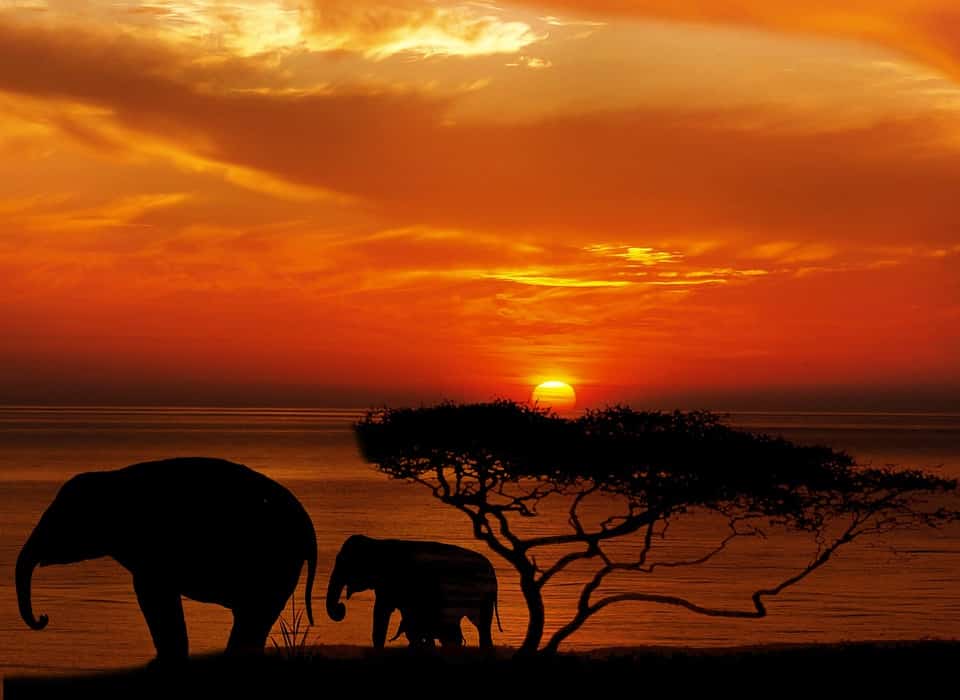
Unleash the explorer within and embark on a journey that echoes with the rhythmic heartbeat of the wild! If you’re craving the ultimate safari adventure, look no further. We’ve meticulously curated the ultimate guide to unveil the 10 Best African Countries for Safari, designed especially for intrepid travelers yearning to witness nature’s grandeur up close.
Investigate the 10 Best African Countries for Safari below:
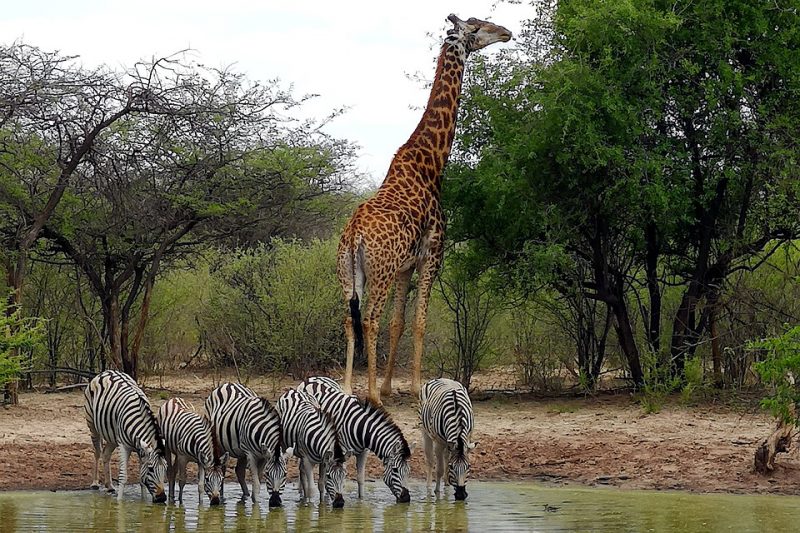
#1 Botswana
Recommended Tours:
Thus, poachers are seen as enemies of the people. As a result, Botswana has come into view as Africa's most sought-after ecotourism destination. Starting from the Chobe National Park to the Moremi Nature Reserve, you'll be able to witness numerous gems all around the country.
Back in 2014, Botswana widely banned the hunting of wild animals and implemented strict laws which are still in practice. The country resumes its zero-tolerance for poaching and their very own environmental minister, Tshekedi Khama, has even launched a shoot-to-kill policy for poachers.
Botswana, with its wildlife conservation and natural parks, is a haven for nature lovers. It is currently in the top 5, as its approach to the protection and conservation of wildlife is worth the praise. As a country, it is very forward-thinking, some may even call it aggressively forward-thinking when it comes to its preservation and anti-poaching laws.

Not only do they have some of the best conservations, but Kenya is also home to 1100 different species of birds, 115 amphibians, 280 reptile species and not to mention 390 species of mammals. It is without any doubt, one of the best places to go for a Safari and witness wildlife.
When it comes to parks and national reserves, Kenya houses 16 national reserves and 25 national parks. Along with that, the country also boasts numerous private conservations which are open for visitors.
Kenya, as a country for Safari, is a force to reckon with. Its stunning wildlife environment is too phenomenal to put into words. Most of the African countries will not be able to even compete with their national parks and wildlife conservations. If you don't visit there at least once in your life, you're missing out on a huge chunk of excitement.
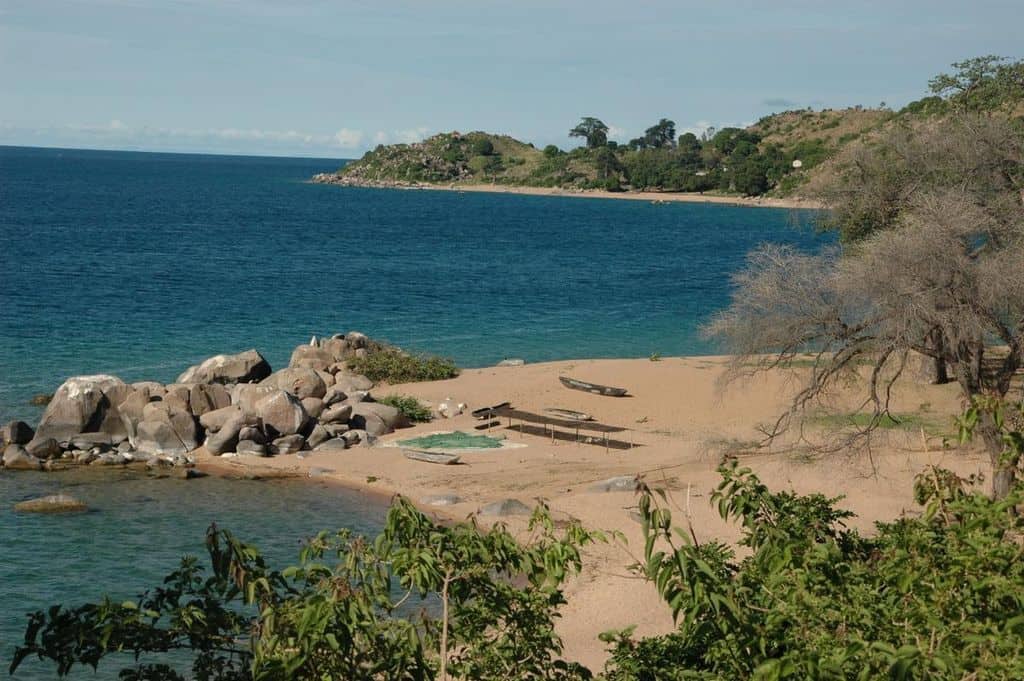
Its fertile land provides a safe and comforting home to around 200 mammal species. This includes elephants, hippos, monkeys and so much more. Along with 650 bird species and 5,500 plants. Even though the country is still underdeveloped and most of the population live in rural households, its national parks, and sight-seeing destinations are on the top 10 of our lists.
Even though many would face some difficulties in locating Malawi on a map, given how tiny it is, the country is home to the world-renowned Lake Malawi National Park. This is practically one-third of the country and is the most biodiverse lake in the world.
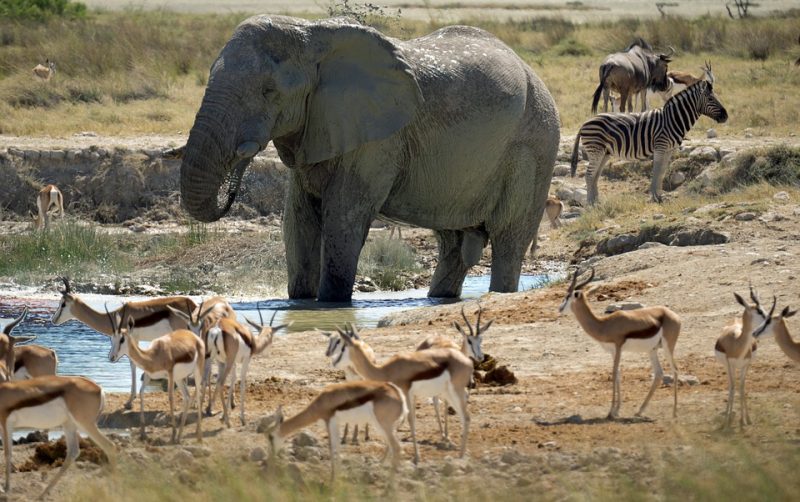
Most of the land in Namibia is occupied by the Kalahari and Namib Deserts. Along with that, the country also has 12 national parks and many other areas which are protected. So, if you go there for a safari, you'll have many rich areas to see and explore.
When it comes to countries with the least amount of population, Namibia is one of them. Which proves to be a good thing for nature. This is because most of the land in Namibia is still unspoiled by human filth or any sort of development, giving nature a chance to breathe.

In the country's Volcanoes National Park, you'll find 10 habituated gorilla families. Groups of 8 trekkers can visit them for one hour per day. But that's enough to get the best African safari experience. And as a nature lover, you'll enjoy the experience to the max.
If you've been around for some time, you'll be familiar with Rwanda's mountain gorillas. They were famously broadcasted and their fight for survival was shown on National Geographic . This was all thanks to the late Dian Fossey back in the 1970s who advocated for the rights of these mountain gorillas throughout her life.
Considering the tragic history surrounding the mass genocide of the people of Rwanda back in 1994, it's truly a blessing what the country has achieved in the past 25 years. There have been countless investments in infrastructure. This has resulted in the country being a very fast-growing destination for ecotourism.
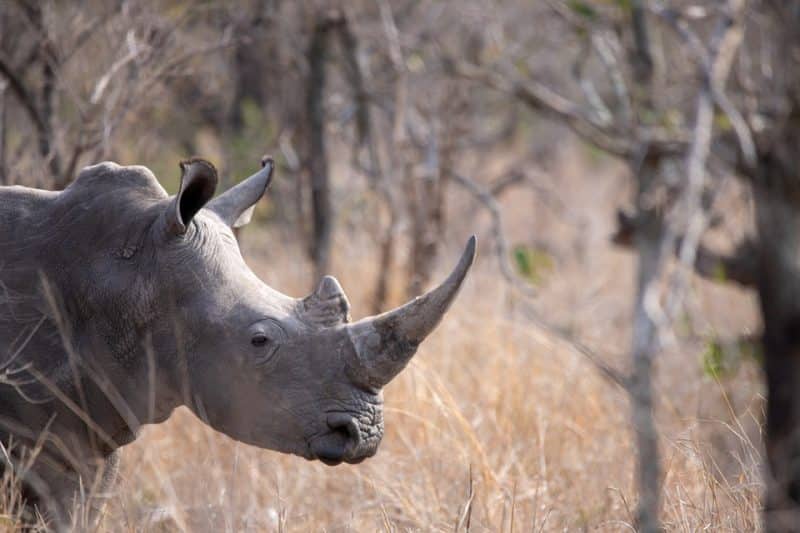
#6 South Africa
But given all the advantages, it's safe to conclude that South Africa also suffers from over-tourism. I mean, if you have so many great attractions, people will flock towards it. Chances are that you'll find yourself in the middle of dozens of unruly visitors who are not too keen on obeying the rules. This occurs mostly during the peak seasons.
Annually, the country has one million visitors. Its biggest attraction is the Kruger National Park with its enrichment in biodiversity. Visitors there also have the liberty to self-drive, thus, getting a first-person private but superb experience.
For some time now, South Africa has been climbing the charts to become one of the most popular destinations for African safaris. Given its location, South Africa is a very convenient and cheap destination for people from the United States. Besides that, the country also boasts a well-developed infrastructure which makes it perfect for luxury travelers as well.
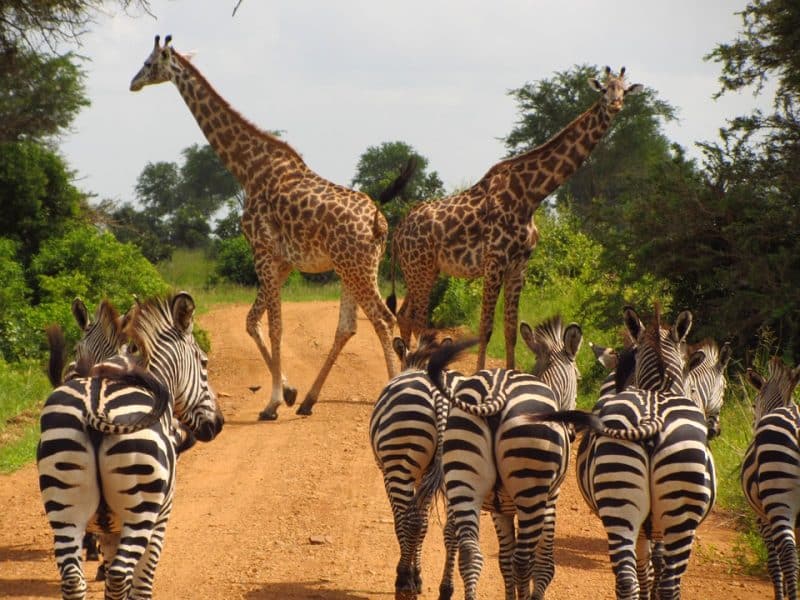
#7 Tanzania
One of the most popular locations would be the Ngorongoro Conservation Area. The country is also a haven for 1100 different bird species. It's no wonder that Tanzania gets this much rep. Especially when the country boasts so many wonders.
We talked about Kenya being the top destination for Safari. Now Tanzania here takes second place in being the continent's most popular safari destination. And why shouldn't it? The country has 16 national parks and an extraordinary amount of wealth and wildlife wonders for the people to witness.
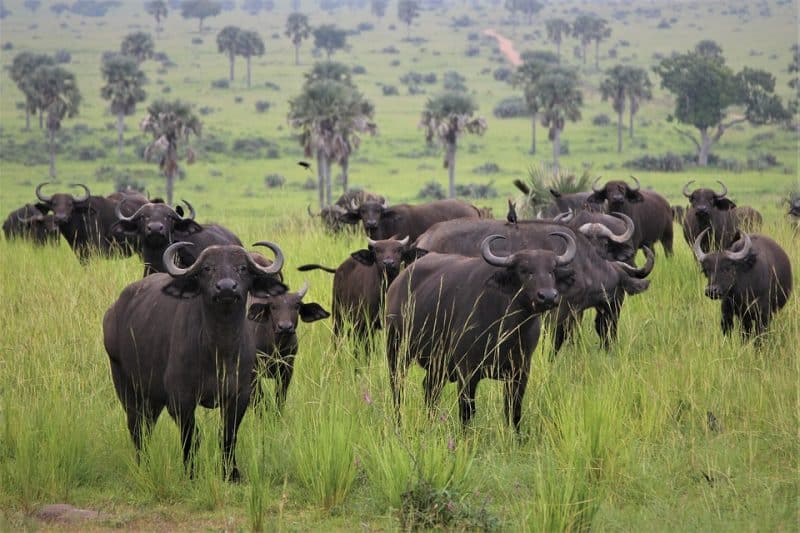
Some of its natural attractions include housing the highest mountain range in Africa. It also has the world's largest free-standing volcano and the second-largest freshwater lake. With its 30 national parks and other wildlife reserves, Uganda boasts many more sanctuaries which are worth the visit. Especially if you're a lover of nature and wildlife.
Often called "The Pearl of Africa", Uganda is certainly a great pick for an African safari. Its reputation as being one of the best ecotourism destinations comes from the country's natural attractions and wildlife.

Out of its 20 national parks, the Mosi-oa-Tunya National Park is home to many wildlife animals such as African elephants, Angolan giraffes, Cape buffalo, etc. Other than that, there are many private ownerships of National parks, notably the Kasanka National Park which is near the basin of Lake Bangweulu. It's a safe place where visitors can see 400 different avian species.
Zambia may be a bit far down the list of popular destinations for your African safari, but many consider it to be a destination for diversified and immersive safari experiences, and making a notable feature on our 10 Best African Countries for Safari guide. The country is steadily focusing on conservation as their president has shown a keen interest and is working on building the nation's economy as well as the infrastructure.
More for You
Americans are finally catching on to Costco's tricks — here are 15 to watch out for so you don't get fleeced on your next trip
Surprising Skills: 20 Celebrities with Hidden Talents
Does Trump Jury Need to Be Unanimous? Juan Merchan's Comment Goes Viral
Childhood Classics or Cringe-Worthy? 18 Movies You Adored as a Kid but Now Find Utterly Ridiculous as an Adult!
This Woman Withdrew From the Interview Process After Being Told She Was the Strongest Candidate. The Reasons Are Instructive for Any Hiring Manager
The Real Reason Your Home-Grown Cucumbers Taste So Bitter
‘The decision I needed to make’: Kevin Costner took out a mortgage on seaside Santa Barbara estate to fund epic western project, sending accountant into a ‘conniption fit’
Ageless Beauty: Old Hollywood’s Most Iconic Women
The Supreme Court Is About To Make Congress Reinvent Itself | Opinion
The Best .22 LR Rifles of 2024, Tested and Reviewed
3 Ways Claiming Social Security at 70 Could Come Back to Bite You
“That’s what appealed to me about that”: Carrie Fisher Only Agreed to Princess Leia Due to George Lucas’ 1 Star Wars Condition
The Forgotten '60s Sitcom That Kicked The Twilight Zone Off TV
Hillary Clinton calls out Comey in new interview. Hear his response
San Francisco quietly removes 'Appeal to Heaven' flag from outside City Hall after Alito flap
Electric Trucks Operating Expenses Are Worse Than Diesel Trucks
Supreme Court Justices Could Be Forced Off Trump Case: Congressman
Report: Bengals wide receiver Tee Higgins currently ineligible to be with team
I've been offered every job I've interviewed for. Here are 5 questions I ask interviewers.
“He never says action, and he never says cut”: Morgan Freeman Had to Beg Clint Eastwood to Direct 1 Movie Starring Matt Damon
- Search Please fill out this field.
- Manage Your Subscription
- Give a Gift Subscription
- Newsletters
- Sweepstakes
This Safari Company Has 9 All-inclusive Camps That Let You See the Best of Botswana by Foot, Boat, and Jeep
I visited three Desert & Delta lodges for one epic adventure. Here's how to craft your dream Botswana itinerary.
Nina Ruggiero is Travel + Leisure's senior editorial director and the co-founder of Be A Travel Writer , an online course for aspiring travel journalists. A New Yorker based in Los Angeles, she has a special interest in beach destinations, outdoor adventures, unique hotels, pet-friendly travel with her golden retriever, @travelswithcali, and all things Italy.
:max_bytes(150000):strip_icc():format(webp)/nina-ruggiero-bio-2000-0708c3762bb44df2951ea309e69217c7.jpg)
Camp Moremi
Camp okavango, chobe game lodge.
Nina Ruggiero / Travel + Leisure
It was day four of our trip to Botswana with Desert & Delta, and my fiancé and I were on our first safari by mokoro , a traditional dug-out canoe. Gliding quietly through the Okavango Delta in our sunken seats, it felt like we were the only people on the planet — until we turned the bend and caught a glimpse of our next surprise through the reeds.
The staff of Camp Okavango, already fast friends of ours, stood ankle-deep in the river, grinning and waving their arms in the air, excited to show us the full bar they’d set up for sundowners, right in the middle of the water. As the sun started to set and they handed us our gin and tonics, an elephant appeared, perfectly on cue.
Nina Ruggiero / Travel + Leisure
Most evenings, our guide, Isak, took a “wrong turn” that ended with a cheeky smile and stunning cocktail setup in an impossibly remote spot, yet somehow we found ourselves truly surprised each time. Add in the serendipitous cooperation of the local wildlife, and you have a recipe for pure magic that couldn’t be replicated in the world’s best bars.
That element of surprise kept us on a natural high all week long — with credit due to the human and non-human animals in almost equal measure. On day one, we laughed when Isak told us his favorite safari animal was the human. By the end, while I was personally still torn between lions and elephants, humans had moved far up my list.
At Camp Okavango, we crossed the path of a lion while touring the bush on foot, got an overview of Nxaragha Island from a doorless helicopter, and went fishing downstream from a herd of hippos. At Camp Moremi, we started our mornings with families of monkeys, caught a majestic elephant water crossing, and watched the circle of life unfold as lions and lionesses took turns ravaging their prey. At Chobe Game Lodge, we marveled at spirited elephant calves splashing around while their elders protected them from crocs, and excitedly tracked little roars to find lion cubs playing at dusk. Leading each experience was a guide with encyclopedia-like knowledge that wowed us and enthusiasm that fueled our childlike wonder.
A 40-year-old company with nine camps and lodges that touch Botswana’s Chobe National Park, Makgadikgadi Pans National Park, Moremi Game Reserve, Okavango Delta, Savuti Channel, and more, Desert & Delta offers safaris by jeep, foot, and boat. Guests have the chance to mix and match camps to form their dream Botswana itinerary, or they can choose from curated all-inclusive packages . With more than 40 percent of its land dedicated to conservation, it’s difficult to beat Botswana as a safari destination — it’s home to eight game reserves, four national parks, and the largest African elephant population in the world. And there may be no better way to see the best of the country on one trip than going with Desert & Delta.
Within minutes of our bush plane landing near Camp Moremi , we encountered a new type of traffic as a journey of giraffes crossed in front of us, swiftly reminding us we weren't in Los Angeles anymore. The camp's location inside Moremi Game Reserve means the safari starts before you even check in. We arrived on property — a few hours late after begging to continue the game drive — and found 12 thatched tents, rebuilt in 2018 with canopied beds, private decks, and rain showers made of stone and wood. Cozy common areas included a bush-side fire pit deck, a pool, a library lounge, and a bar built around an ebony tree. We had many group meals at the long, wooden tables in the thatch-roofed dining room, and one romantic, private candlelit dinner on the deck.
On our November trip, morning and afternoon game drives through Moremi Game Reserve were where we found the majority of our animal sightings in Botswana, including lions, zebra, hippos, elephants, giraffes, wildebeest, and more. It’s also possible to see leopards, cheetahs, and wild dogs. Steps from camp, we hopped on a motorized boat and explored the channels of the Xakanaxa Lagoon, where we spotted birds of all colors and sizes, an elephant taking a swim, and an unforgettable red sunset.
Located on a remote island in the Okavango Delta, a UNESCO World Heritage Site, Camp Okavango feels like a secret hideaway. It holds 12 suites connected by a wooden boardwalk and surrounded by lush vegetation. Views of the surrounding wilderness from the dining room and pool deck below are completely different and equally beautiful as the day shifts from morning to night. For adventurous guests, there’s also a sleep-out deck with an immaculate bedroom and bathroom on a raised platform under the stars.
At Camp Okavango, safaris are by boat (motorized and mokoro), on foot (with two protective guides), or by helicopter (for an additional fee). There are no vehicles there, but as we cruised the delta past hippos and elephants, made eye contact with a vigilant mother giraffe on foot, and paused to let a shy family of warthogs scurry by us, we didn’t miss the Jeep.
A true luxury lodge and the only permanent game lodge within Chobe National Park, it’s not hard to see why Chobe Game Lodge has attracted the likes of Prince Harry and Elizabeth Taylor, who wed Richard Burton there (for the second time) in 1975. The Lodge has 44 rooms, all looking out over the Chobe River, four of them with private plunge pools. With elegant dining areas and bars, a scenic boardwalk, and a billiard room, it’s easy to unwind between game drives and boat tours.
Here, all guides are female — a training program for women has been running since 2005 — and innovations in ecotourism have been recognized by the Botswana Tourism Organisation. Safaris are run via electric vehicles in the park and electric boats on the river, both gentle on the environment and offering a quiet approach that helps guests observe animals up close. Each day, we looked forward to boarding our boat with our guide, Miss B., and watching elephant families revel in their time at the watering hole, often coexisting with lions, hippos, and crocodiles on one incredibly lively riverbank.
A refurbished Nxamaseri Island Lodge reopened in May, and it now hosts Desert & Delta's first wellness spa. Guests are gifted a complimentary treatment and escorted to the spa by water in a mokoro. A new pool also looks over the Nxamaseri Channel.
Rebuilt and reopening in June for the 2024 safari season, Savute Safari Lodge now has 12 contemporary, temperature-controlled rooms with outdoor showers and Savute Channel views, plus indoor and outdoor dining, a pool, and a sunken wildlife viewing area that puts guests at eye level with the animals.
For a totally off-the-grid experience, guests of Desert & Delta's Leroo La Tau lodge between June and October can book a Makgadikgadi Salt Pan sleep-out to dine by an open fire immersed in nature and sleep on a rollout bed under the endless night sky. Leroo La Tau is also the best place to see a massive zebra migration — and it was refurbished with migration viewing in mind in 2023.
To browse all nine properties and the experiences Desert & Delta offers, visit desertdelta.com .
Related Articles

COMMENTS
Elephant at Murchison Falls National Park Safari Reserve, Uganda 4. Uganda Kob: Uganda's National Antelope. What animals live in Uganda? Antelopes make up a goodly portion of the Uganda wildlife; there are 29 species, including the Uganda kob (Kobus kob thomasi), which is a subspecies of the kob.It is a medium-sized antelope that is depicted on Uganda's coat of arms.
The best safari animals found in Uganda are categorized under primates - Gorilla, Chimpanzee, Golden monkey, Red tailed monkey, black and white colobus monkey and many others. Carnivores - Lion, Leopard, Jackel, Hyena and sarval cat. Herbivores - Elephants, buffaloes, Rhinos, Uganda Kob, Elends, Warthog, Hippopotamus, waterbuck and more.
All the safari BIG Five (lion, elephant, buffalo, hippo, and leopard). You can easily spot lions in all the big savannah parks. The official checklist of animals found in Uganda includes 342 species, representing both west and east African mammals. 132 of the species occurring in Uganda are large mammals and the other small mammals.
The big Six Animals. Uganda is home to the big five and these are found in the different National Parks around the country like Murchison Falls National Park Queen Elizabeth National Park and Kidepo National Park. ... Bird species that you should look out for while on a safari in Uganda include African shoebill, ostriches, African crowned crane ...
3. Leopard. The leopard is one of the "big five" animals every safari-goer wants to see. While they are notoriously elusive, if you put in the time and effort, your chances of seeing a leopard are pretty good in Uganda. The best place to see leopards is in Queen Elizabeth National Park, where they can often be seen lounging in trees or stalking their prey.
Wild Animals Found in Uganda: What you should expect to see on your Africa safari. Uganda, the Pearl of Africa, is a place where every nature lover can have a once-in-a-lifetime glimpse of the Africa safari big five wild animals: Lion, Leopard, Elephant, Giraffe, Rhinoceros and the great apes, the mountain gorilla, and chimpanzee.
Uganda Safari Animals: In the Realm of the Big Game Deep into the heart of the awe-inspiring African savannah lies a wonderland of untamed beauty and biodiversity, a place where nature's spectacle uniquely unfolds with each sunrise - Uganda, a wildlife haven like no other. Trekking deep into this wonderland's untamed savannah, you are immersed […]
Uganda safari tours/ Uganda wildlife safaris offer some of the best animal encounters in the world. Some of the iconic African safari wildlife or animals of Uganda include Mountain gorillas, Chimpanzees, African bush elephants, African lions, African buffalos, African Leopards, Cheetahs, Sothern white rhinoceros, Rothschild's giraffes, Plains Zebras, Hippotamus, Nile Crocodiles, Shoebills ...
There is a lot of wildlife to see in Uganda. From the big five animals that travelers seek for on African safaris to the rare and endangered mountain gorillas, there is an impressive array of animals to see on a Uganda safari through the wilderness parks. Here are the top 10 animals that tourists seek for from Uganda. Listings of Uganda's ...
Uganda Safari Animals; Uganda boosts with diversity of wild animals that attracts many travelers to flock into this tiny East African country, once referred to as the Pearl of Africa. It was named the Pearl of Africa because it's rich green nature, various tree species, plant life, scenic landscapes and diverse wildlife including the great ...
All wild animals on a Ugandan safari- Uganda has been blessed with various species notably plant life, tree species, plenty of wildlife including primates. Search for: Short Rwanda Gorilla Safaris. 4 days Gorilla Trekking and Lake Mburo Safari. 4 Days Gorilla Safari And Kampala City Tour.
Uganda is a unique destination offering a wonderful mix of savannah and forest parks. Gorilla and chimp trekking are highlights, but many smaller primates can be seen as well. Uganda also offers great savannah safaris, and all of the Big Five are present. Lion is quite common in Queen Elizabeth, Murchison Falls and Kidepo National Parks, where they can often be found hunting Uganda kob.
An impressive number of tourists come to Africa on safari to see the elephant, buffalo, rhino, leopard, and lion, and Uganda shares a good piece of the big game action. Africa Big 5 animals is a term coined in the 1800s by trophy hunters, referring to what they considered the most challenging and dangerous animals to hunt on foot.
Best time for wildlife Safaris in Uganda - complete guide for Wildlife Safaris in Uganda. The best time for wildlife safaris in Uganda is generally during the two dry seasons, from December to February and from June to October. During this time, wildlife viewing is much easier and guaranteed since most animals congregate near the water holes.
The best national parks to see the big five safari animals in Uganda are Murchison Falls National park which is the biggest conservation area in Uganda, Queen Elizabeth National Park, Lake Mburo National park, Kidepo Valley National park etc. Animals to see here are leopard, Cape buffalo, lions and elephants. ...
It's safe to say Uganda is one of the best African countries for seeing natural African landscapes and plenty of animals on a safari. While Uganda is one of the fastest-growing countries in Africa, it's still a developing country, which makes some travelers nervous about planning a Uganda safari tour. Well, that's where we here at Road ...
The Africa big 5 animals in Uganda are all present in Uganda and can easily be seen in all savannah National Parks. The phrase today is commonly used to market Uganda safaris, but back in the nineteenth and early twentieth centuries, everyone from European royalty to American presidents wanted to bag an African hunting trophy.
Compare 7-day gorilla trekking and safari tours to Uganda offered by 61 specialized tour operators. Find the best deals using the largest marketplace for African safaris. ... "You'll encounter a huge diversity of animals on a 7-day Uganda safari. If you follow the southwestern circuit incorporating Bwindi Impenetrable, Queen Elizabeth and ...
The East African tropical heat is tempered by an average altitude of 1,000 meters, with the east and west borders featuring significant mountains. Self drive safaris are an option in some national parks in Uganda, though you will need access to a 4WD to get the most out the parks due to the clay tracks. ( Read some tips on driving in Uganda.)
Uganda Wildlife Safaris. Uganda is an incredible destination for all-round wildlife-watching. A plethora of experiences can be enjoyed, against a stunning backdrop of volcanoes, crater lakes, fog-filled forests, reed-lined channels and lush savannah.
The list of Uganda wildlife safari animals that live inside this park is quite exciting and different from other parks in Uganda. Lake Mburo National Park Uganda . 68 various mammal species have been recorded within Lake Mburo National Park, approximately 313 different bird species among which is the crested crane found on the national emblem ...
When you go on a safari in Uganda, expect a diverse landscape encompassing everything from sweeping savannah plains to rugged western regions teeming with wildlife, primates, and remarkable bird species. The country boasts excellent wildlife viewing safaris throughout the year, thanks to abundant animal concentrations, a temperate climate, and ...
The best safari operator that travelers have highly recommended since 2007, to take you on a most rewarding Uganda safari to see Uganda's latest Big five animals is NKuringo Safaris. Check them out, send them an email directly and I can assure you a quick reply with the most empathetic response to help you customize a memorable trip.
Often called "The Pearl of Africa", Uganda is certainly a great pick for an African safari. Its reputation as being one of the best ecotourism destinations comes from the country's natural ...
This Safari Company Has 9 All-inclusive Camps That Let You See the Best of Botswana by Foot, Boat, and Jeep. I visited three Desert & Delta lodges for one epic adventure.